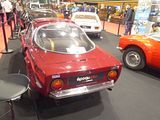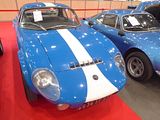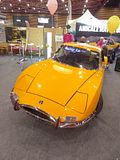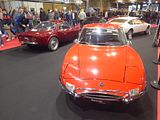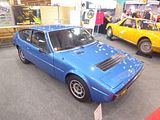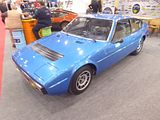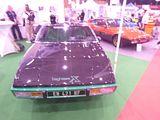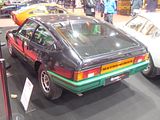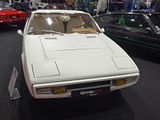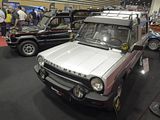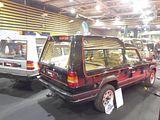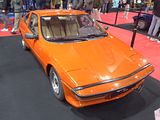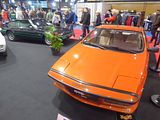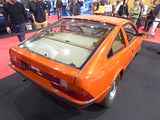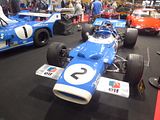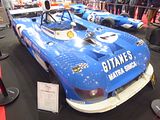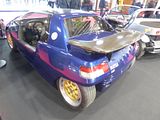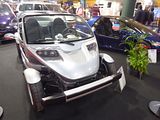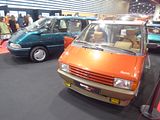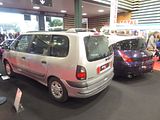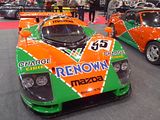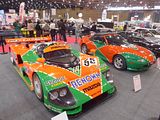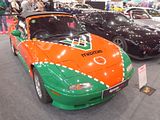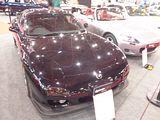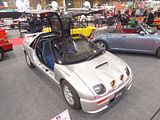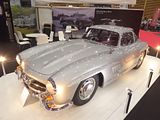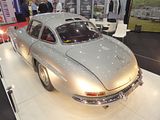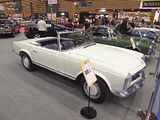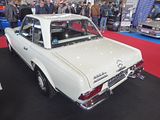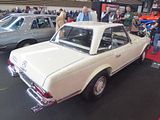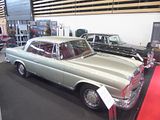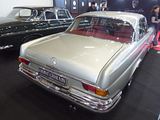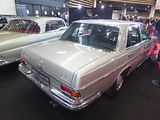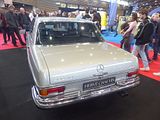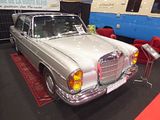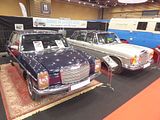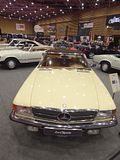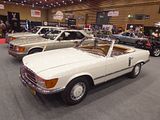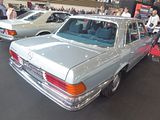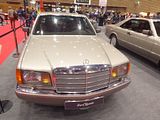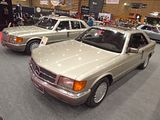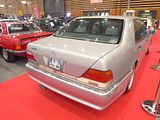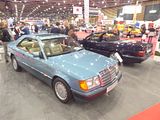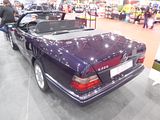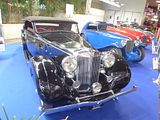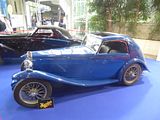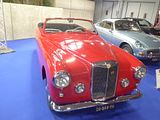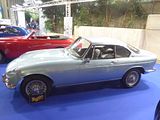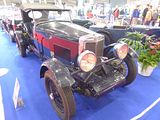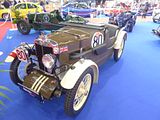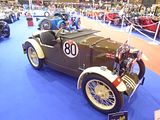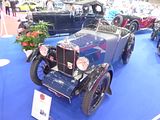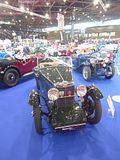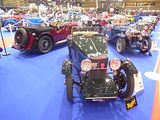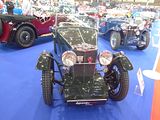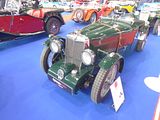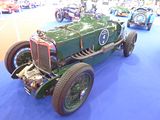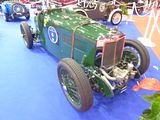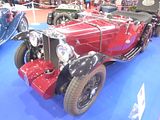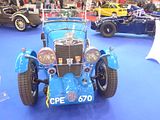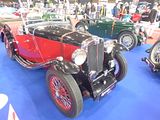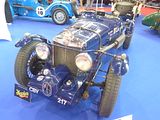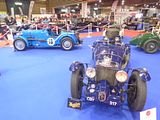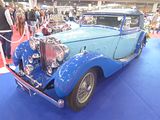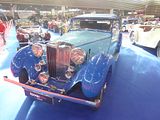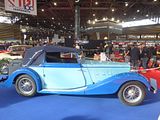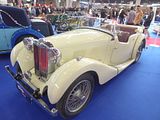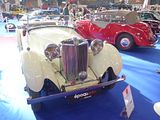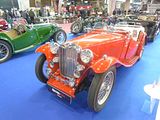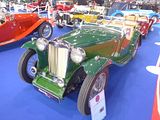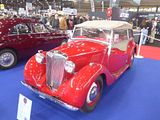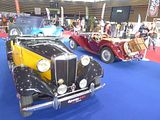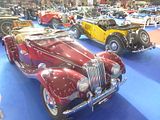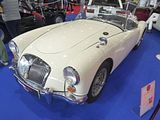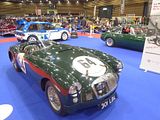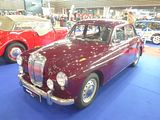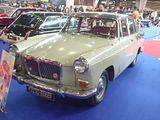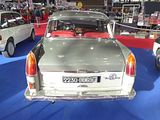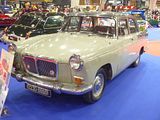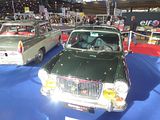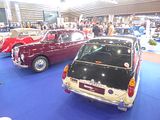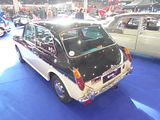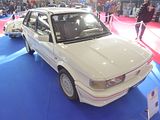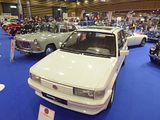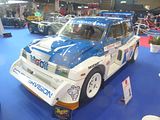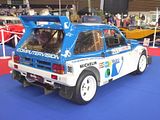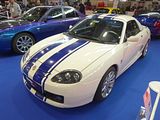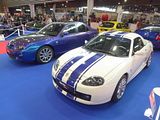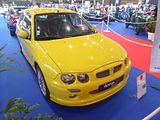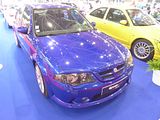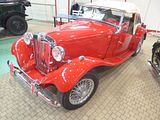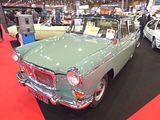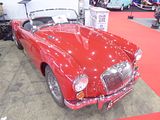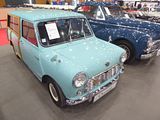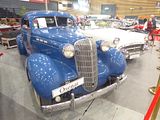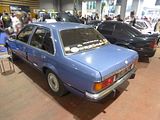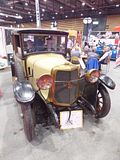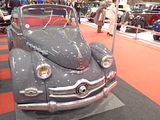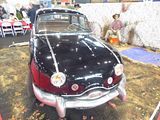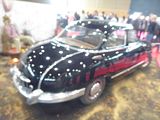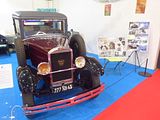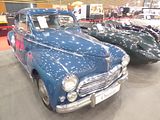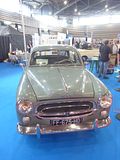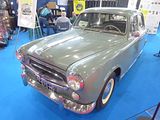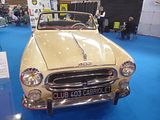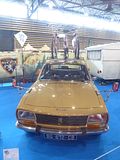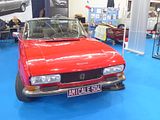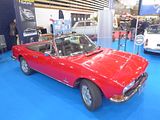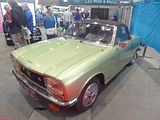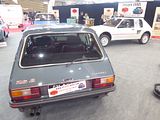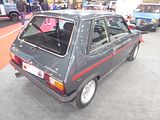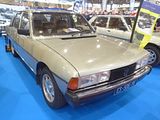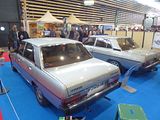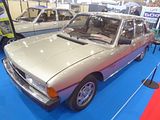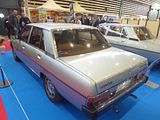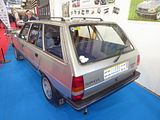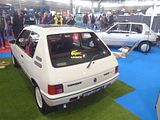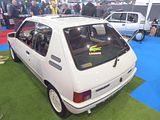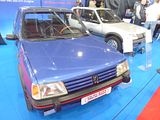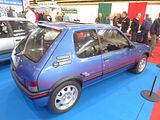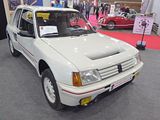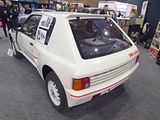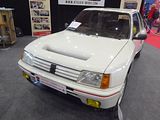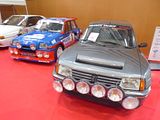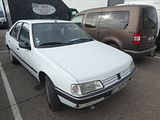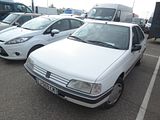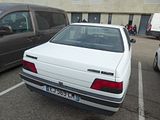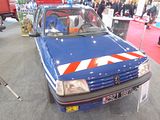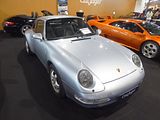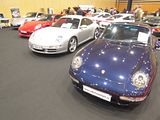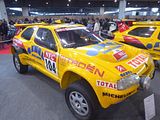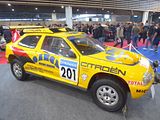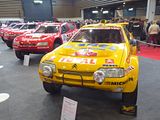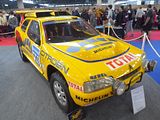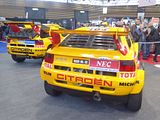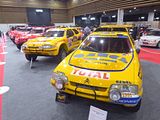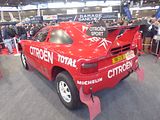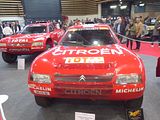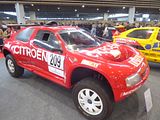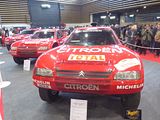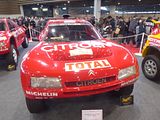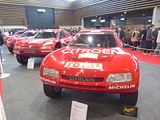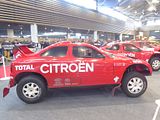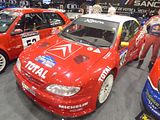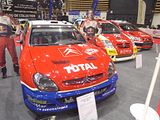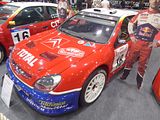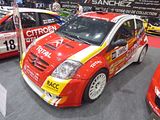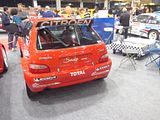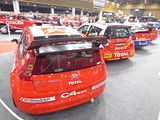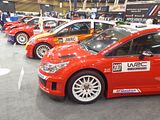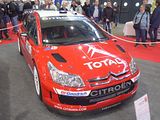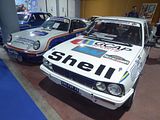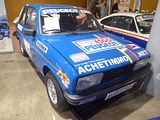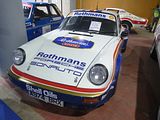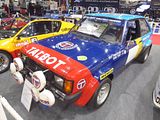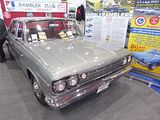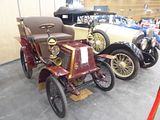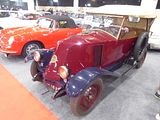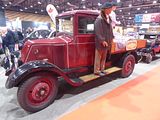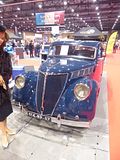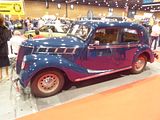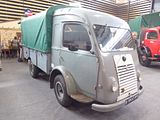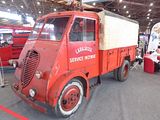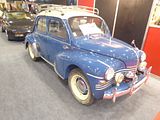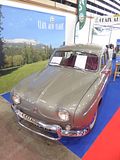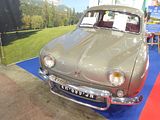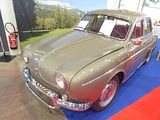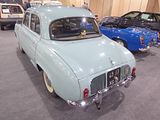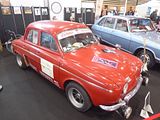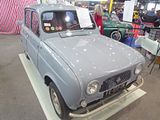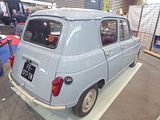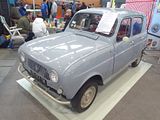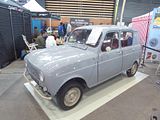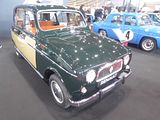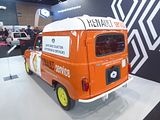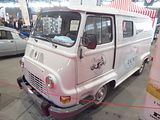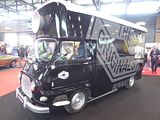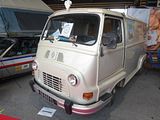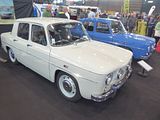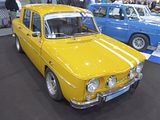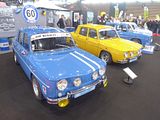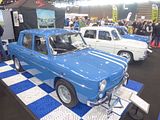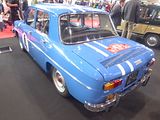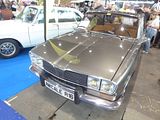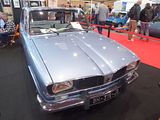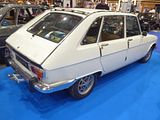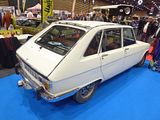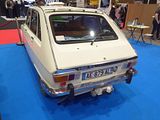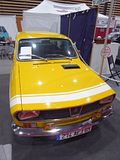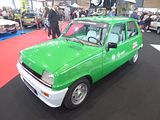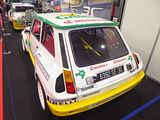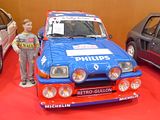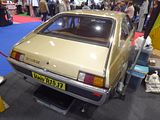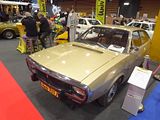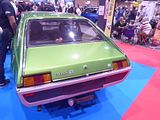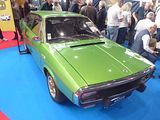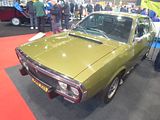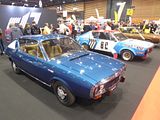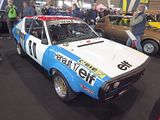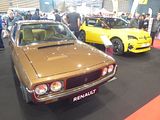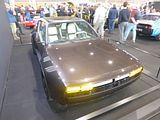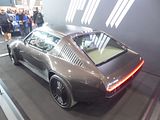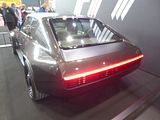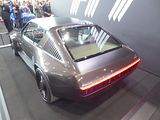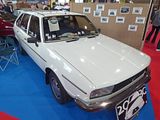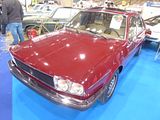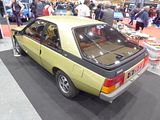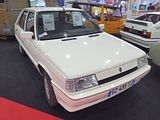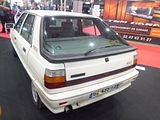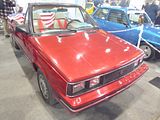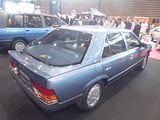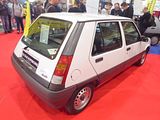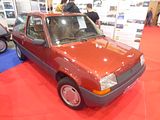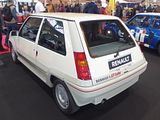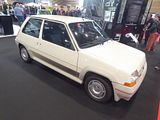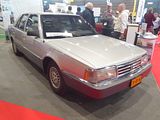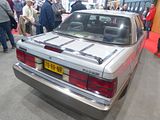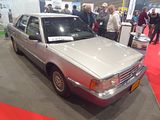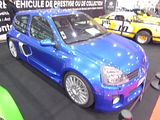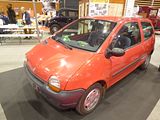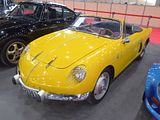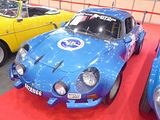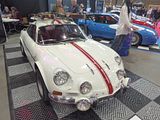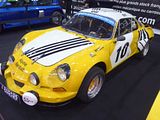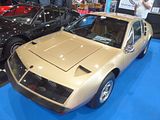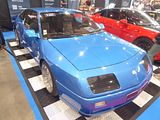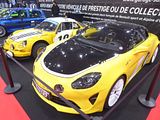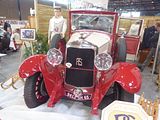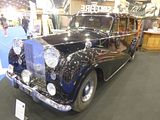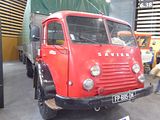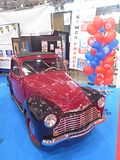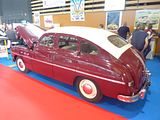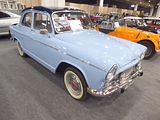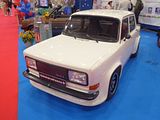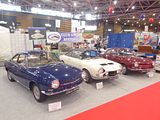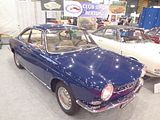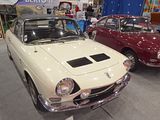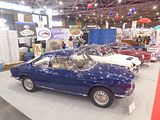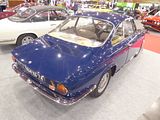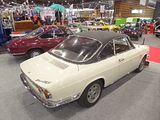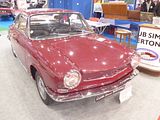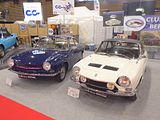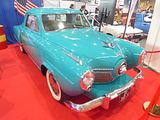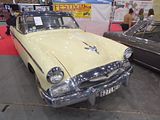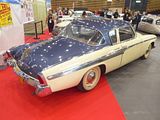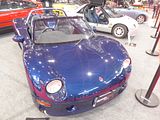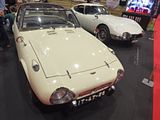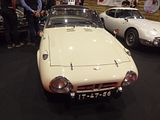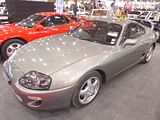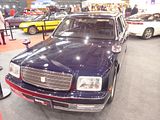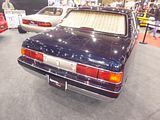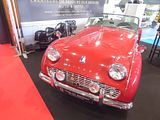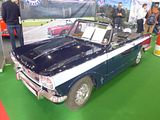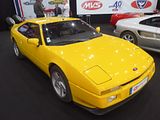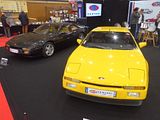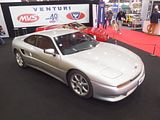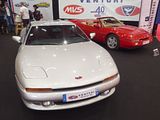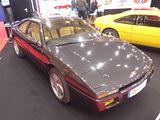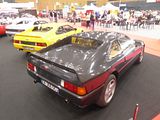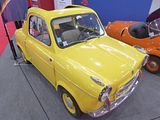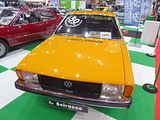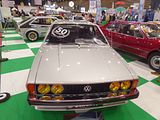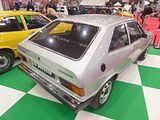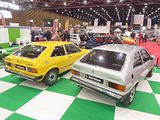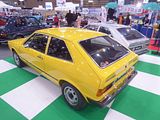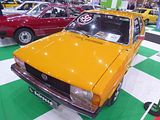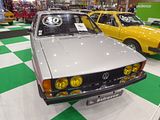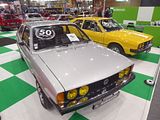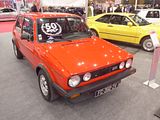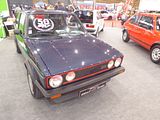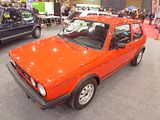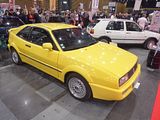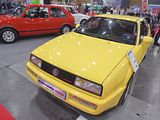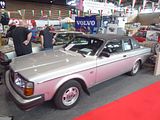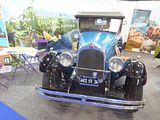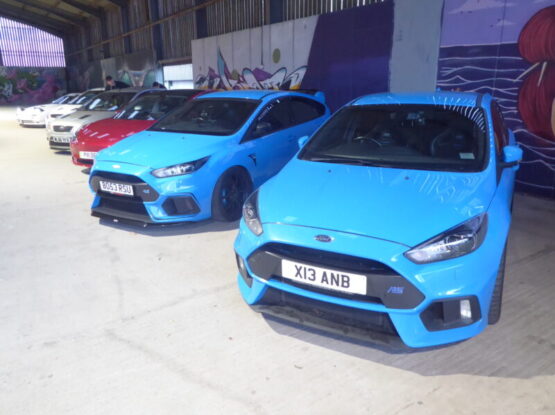This report, covering alphaebtically from Matra to WIllys-Overland is Part II of my coverage of the indoor displays from Epoqu’Auto 2024.
MATRA
A special display of 17 Matra models featured in the concourse area leading to Halls 6 and 7, with cars supplied from the collection usually on show at Romorantin was there to celebrate the 60th anniversary of this French marque. There were some additional Matra cars courtesy of the Owners Club.
This car started out as the René Bonnet Djet in June 1962 and became known in retrospect as the Djet I. The car was named “Djet” because Bonnet thought the French would not pronounce the word “jet” correctly. The Bonnet Djet was the world’s first mid-engined production road car, beating the De Tomaso Vallelunga which was introduced in 1963, even though the first production Djets did not leave the factory until July 1963. It was powered by a 65 PS 1,108 cc engine from a Renault 8 in a mid-engine location mated to a gearbox from the Renault Estafette van. This power-train gave the car a top speed of 165 km/h (103 mph), or 190 km/h (118 mph) in the later Djet III with a Gordini engine. The fibreglass body was bonded directly to a steel chassis. The Djets were built in a factory in Romorantin owned by Matra. The competition Aérodjet of 1963 came with special long-tailed bodywork and bigger fenders to accommodate wider wheels. The Djet’s suspension was quite advanced for the time, being a fully independent system having upper and lower A-arms with coil springs and disc brakes at all four wheels. The car accommodated just two people, as the engine took the space where a rear seat would otherwise be. The Djet I was 3,800 mm (149.6 in) long by 1,400 mm (55.1 in) wide by 1,150 mm (45.3 in) high and weighed only 600 kg (1,323 lb). The Djet was priced at 20,000 French francs at launch, the same as its much larger and more luxurious contemporary, the Facel-Vega Facellia. Bonnet believed that the competition record of the Djet and his company would be enough to convince the public to purchase the Djet, but this would not prove to be the case. When Bonnet got into financial troubles, Matra, who already supplied both the bodyshells and the factory for the Djet, took over René Bonnet Automobiles and its debts in October 1964. Production of the original Djet was stopped in December 1964. Matra’s CEO Jean-Luc Lagardère considered this a great opportunity for Matra to expand into the automobile market. Former Simca designer Philippe Guédon was hired to modify the original Bonnet Djet. The car became slightly bigger, measuring 4,220 mm (166.1 in) long by 1,500 mm (59.1 in) wide by 1,200 mm (47.2 in) high and weighing 660 kg (1,455 lb). Production resumed in April 1965 with two new versions; the Matra Bonnet Djet V and the Djet V S, the latter having a Gordini-tuned engine. After the Paris Motor Show in 1965, the Roman numerals and the Bonnet name were dropped. The car was now called the Matra Sports Djet 5. In 1966, a version with a bigger Gordini engine became available and the Djet name was dropped in favour of its original meaning: Jet. The model range now consisted of the Jet 5 (1,108 cc Renault 8 Major engine), Jet 5 S (1,108 cc Renault 8 Gordini engine) and Jet 6 (1,255 cc Renault Gordini engine). During the two years before Matra took over, 198 Bonnet Djets were produced, with all but 19 being built to the lower-powered Djet I specification. After becoming the Matra Djet in 1964 a further 1,491 cars were produced before production ended in 1968.
In 1965 Matra’s CEO Jean-Luc Lagardère decided to develop a sports car that would be more accessible to the ordinary, non-racing public, a voiture des copains (car for chums), as its successor, and the result was the first “true” Matra sports car, (the Djet had been a René Bonnet design) the Matra M530. The car was named after Matra’s R.530 missile, and designed by a former Simca designer called Philippe Guédon. Like its predecessor, the M530 was built on a steel frame with polyester body and had a mid-engine. To accommodate a 2+2, mid-engine layout and a reasonable boot, various engine options were considered. In the end, the running gear came from Ford in Germany: the “high compression” 1699 cc Ford Taunus V4 engine and gearbox from the Taunus 15M TS were chosen. This combination was compact enough to fit between the rear seats and the boot. Other unusual features of the M530 were its targa top roof, pop-up headlights and, most notably, the outstanding avant-garde design. The first 530 (badged Matra Sports M530A) was shown to the public on March 7, 1967 at the Geneva Motor Show. It had a 70 DIN hp Ford 1700 cc V4 engine, which gave the car a top speed of 175 km/h (109 mph). It entered production a month later, incorporating modifications that included the addition of a chrome bumper bar to provide for the front grill much needed protection from parking shunts, a modest reshaping of the dashboard to give the passenger a little more knee room, and the repositioning of the ignition key to facilitate access. In its first two production years, the chassis was built by Carrier in Alençon and assembly was undertaken by French coachbuilder Brissonneau et Lotz at Creil. The engine bay of the early model 530 was accessible by removing the acrylic glass rear window. 1969 saw many changes to the 530. First, the running gear followed the same evolution as the Ford model it was taken from and power increased to 75 DIN hp by using a different carburettor. Secondly, Matra closed a deal with Chrysler Europe, to sell their cars through the Simca dealer network from 1970 onwards and jointly develop the M530’s successor. Finally, the cars were now constructed completely at the Matra Automobiles factory in Romorantin. Introduced at the 1970 Geneva Motor Show was the Matra Simca M530LX, which was a minor redesign of the 530A by Michelotti. The most notable changes were the rear hatch (now made of glass and opens with struts like a hatchback) and the front bumper. A budget version of the 530, the Matra Simca 530SX, was introduced in October 1971. The SX lacked the targa top roof and pop-up headlights; instead, there were four fixed headlights mounted on top of the front. The only available colours were orange and white, and the SX featured black bumpers instead of the LX’s chrome bumpers. M530’s production ceased in 1973, after a total of 9,609 cars (2,062 530A, 4,731 530LX and 1,146 530SX) were built.
To replace the M530, Matra worked in cooperation with the automaker Simca. Designed by the Greek, Antonis Volanis, the new car was marketed as Matra-Simca Bagheera to highlight the link, except for the final production year 1980, when it was re-badged Talbot-Matra Bagheera after Chrysler Europe’s demise and subsequent takeover by PSA. Named after the panther from The Jungle Book, the Bagheera was created using stock Simca components, including the engines, gearbox and suspension elements, but unlike the front wheel drive Simca 1100 and 1307 cars it shared them with, it was a mid-engined car. The Bagheera’s body was made of polyester, mounted on a steel structure. It was formed in the shape of a sleek hatchback, with a rear hatch that allowed access to the engine mounted behind the passenger compartment. There was only one row of seats, but it featured an unusual combination of three abreast, one of the few three-passenger sports cars ever made. When launched in 1973, the Bagheera was only available with a 4 cylinder 1294cc engine. In 1975, the range grew to include a 1442cc version of the same engine. The Bagheera is also notable as one of the few manufacturers in the world to have developed a “U engine” for this vehicle. As Matra engineers believed the Bagheera could use a more powerful unit, they created a unique construction out of two 1.3 litre Simca engines, joined side-by-side by a common pan unit, the two crankshafts being linked by chain. This resulted in a 2.6 litre 8-cylinder unit, producing 168 bhp. However, Chrysler Europe was unwilling to pursue the project due to the developing fuel crises as well as its own financial problems. Thus, the U8-powered Bagheera remained as a prototype and only three units were ever built. In 1976, the Bagheera underwent a major restyling, with basically only the rear hatch unchanged, producing the Bagheera type II. Another change took place in 1978, when the dashboard was replaced again, and in 1979 the Bagheera was given conventional door handles in lieu of the previous “hidden” ones. Production of the Bagheera ended in 1980, when it was replaced by Matra Murena, with 47,802 Bagheeras built in total. Very few Bagheeras remain in existence today, as they suffered badly from quality issues (the Bagheera won the ADAC Silberne Zitrone = “Silver Lemon” award in 1975 for the poorest quality car of that moment) and extensive body rot. Though the polyester panels couldn’t rust, the underlying steel chassis had almost no protection. Matra learned from this and fully galvanised the Bagheera’s successor.
Thought of as a leisure activity vehicle, the Rancho was created by the French engineering group Matra, in cooperation with the automaker Simca, to capitalise on the off-road trend started by the Range Rover, with an “off-road look” offered at a much lower price than the British car. The Rancho was launched in 1977. Designed by Antonis Volanis, the Rancho was based on the pick-up version of Simca’s popular 1100, using its front structure and a stretched chassis. The rest of the body was made by Matra from fibreglass and polyester, including the mouldings adorning the body, which made it look more “sturdy”. This technology would later be used on the Renault Espace, as well. The ground clearance was also increased. Unlike most off-roaders, it was not fitted with all-wheel drive, retaining the 1100s front-wheel drive layout. Other elements retained from the 1100 included the dashboard and front seats which were identical with the ones found in the Simca 1100 GLS. The Rancho was powered by the 1442 cc, 80 bhp version of the “Poissy engine” straight-4 engine. The Rancho’s optional third row of seats (making it an early MPV) shared head restraints with the normal rear seats. Sales of the model were quite respectable, but they could do nothing to alleviate the larger problems at Chrysler Europe (Simca’s parent company). Chrysler finally sold its European arm to PSA in 1978, which was then rebranded as Talbot in 1979. The Matra-Simca Rancho became the Talbot Matra Rancho. Production continued until 1984, and 57,792 were made. During its life, the Rancho was offered in several versions. Apart from the basic Rancho, there was the Grand Raid, around 2000 of which were built, fitted with such “off-road” extras as an electric winch on the front bumper and the spare wheel mounted on the roof – as well as a limited-slip differential. The Rancho X was the upscale model, with additional standard items such as alloy wheels and metallic paint. The Découvrable model’s rear cabin consisted of an open frame with roll-down fabric covers, which could serve as an “open” car during good weather. Finally, the Rancho AS was the commercial version, with no rear seat, making it exempt from the French tax on passenger cars. Rarest of the lot was the Midnight, only 100 of which were made. Although the bodies do not rust, the mechanicals are less durable, so there are not that many survivors, down to just single figures in the UK, sadly.
The Matra Murena was a 3-seat single row sports car with mid-engined rear wheel drive, produced from 1980 through 1983. Replacing the Bagheera, a similar vehicle resulting from the first fruits of the Matra-Simca cooperation, the Murena employed the base Bagheera structure, but substantial changes were made to address some of the concerns regarding the previous model. The car still had a steel spaceframe with body panels made of fibreglass-polyester, but to counter the rust issues plaguing the Bagheeras, the spaceframe was galvanized, the first production car to use galvanized steel for all chassis parts. This, coupled with the composite panels, made the car essentially immune to rust, except for the rear trailing arms of the suspension. The Murena also inherited the Bagheera’s mid-engined layout together with the sleek hatchback body shape, with the rear hatch allowing access to the engine mounted behind the passenger compartment, and a luggage area. The styling was all-new, though, and the body very aerodynamic for its time. A unique feature carried over from the previous model was the seating arrangement – all three seats were placed in one row, with the middle seat folding down to become an armrest when not in use by a passenger. The engine selection was different, however. The base model had a 1.6 engine, while the more powerful version employed the 2.2 engine that was also the base engine for the top of the range Talbot Tagora saloon. This engine was also available with the so-called “S-kit” that upgraded its output to 142bhp. At first, this was a dealer-fitted option, but later it could be ordered straight from the factory. The standard carburation was via a single Solex downdraft carburettor, but S models had twin side draft carburettors. The car had good performance and handling. It was only available in left hand drive specification, although a very small number of right hand drive conversions were made. Production ceased when the Matra factory in Romorantin switched to production of the Renault Espace multi-people carrier.
The Matra MS80 was the fourth Formula One car produced by Matra (following the MS9, MS10 and MS11). The Ford Cosworth DFV-powered car (engine 3000 cc, estimated at around 420 bhp took Jackie Stewart to the Formula One World Championship title in 1969. The car, designed under the direction of Gérard Ducarouge and Bernard Boyer, was built at Matra’s Formula One base at Vélizy-Villacoublay in the southwestern suburbs of Paris, though the final completion with the Cosworth engine was done in the Tyrrell workshop of East Horsley near Ripley, UK. A major change from the MS10 was the location of the fuel cell, which was moved from behind the driver and placed in sidepods by the driver’s hips, giving the car a slight ‘Coke bottle’ appearance. The rocker-arm front suspension was replaced by outboard springs, with a parallel link set up on the rear suspension. Apart from Ferrari cars, the Matra MS80 is the only non-British built car to win the Formula One World Constructors’ Championship (the French-licensed constructor Renault, the Austrian-licensed constructor Red Bull and the German-licensed constructor Mercedes built their winning cars in the UK) as well as the only car built in France to help a driver win the World Drivers’ Championship. Although built by the French constructor Matra, the car was run by the British Matra International privateer team of Ken Tyrrell and, as such, remains the only car not entered by a works team to win the Formula One World Constructors’ Championship as well as to help a driver win the World Drivers’ Championship. The MS80 was one of the first F1 racing cars to be designed with “wings” for downforce to increase high-speed tyre grip. These were originally introduced into F1 in 1968. Due to some serious racing accidents with the flimsy 1969-type high wing constructions early in the racing season, like all 1969 F1 cars the MS80 was altered to use more sturdy lowered wings, directly attached to the car’s body, later on. Only two MS80s were assembled in 1969, a third monocoque was built but remained un-assembled until the EPAF company made it a complete car in 2006.
The Matra-Simca MS670 was a Group 5 prototype race car introduced in 1972 for the World Championship for Makes. The MS670 replaced the previous Matra-Simca MS660C. The MS670 only made one appearance in 1972, the 24 Hours of Le Mans. Matra entered four cars, Jean-Pierre Beltoise/Chris Amon in the older Matra-Simca MS660C, François Cevert/Howden Ganley, Henri Pescarolo/Graham Hill and Jean-Pierre Jabouille/David Hobbs. Hill/Pescarolo won the race by a lap from Cevert/Ganley. Beltoise/Amon retired with engine failure and Jabouille/Hobbs retired with a broken gearbox. In the World Championship for Makes, Matra had scored twenty points, earning it seventh in the championship. The first race of the season was the 1973 24 Hours of Daytona and Matra entered one car using the MS670 driven by Cevert/Beltoise/Pescarolo and retired from the race with engine failure. The driver line ups for the 1973 Vallelunga 6 Hours were Cevert/Beltoise and Cevert/Pescarolo/Gérard Larrousse, all drivers using the new Matra-Simca MS670B, Cevert/Pescarolo/Larrousse won and Cevert/Beltoise retired with engine failure. The driver line ups for the next two races, starting with the 1973 1000km of Dijon were Cevert/Beltoise and Pescarolo/Larrousse. Pescarolo/Larrousse won the race and Cevert/Beltoise finished third. The 1000km of Monza saw Pescarolo/Larrousse third and Cevert/Beltoise eleventh. The driver line ups for the 1000 km of Spa were Pescarolo/Amon/Hill and Pescarolo/Larrousse/Amon, Pescarolo/Larrousse/Amon finished third and Pescarolo/Amon/Hill retired with engine failure. The team skipped the Targa Florio but entered the 1000km of Nürburgring with Cevert/Beltoise and Pescarolo/Larrousse driving but both cars retired with engine failure. Matra entered four cars for the 24 Hours of Le Mans, Pescarolo/Larrousse, Cevert/Beltoise, Jabouille/Jean-Pierre Jaussaud and Patrick Depailler/Bob Wollek. Pescarolo/Larrousse won the race, Jabouille/Jaussaud finished third, Cevert/Beltoise retired with an accident caused by a puncture and Depailler/Wollek also retired with a broken oil pump and engine failure. The 1000km of Zeltweg returned to two cars with Pescarolo/Larrousse winning the race from Cevert/Beltoise. In the final race of the 1973 season, the Watkins Glen 6 Hours, Pescarolo/Larrousse won but Cevert/Beltoise retired with broken ignition. In the World Championship for Makes, Matra had scored one hundred and twenty four points, earning it first-place in the standings. The first race of the season was the 1000km of Monza and the driver line ups were Pescarolo/Larrousse and Beltoise/Jean-Pierre Jarier but both cars retired with engine failure using the new Matra-Simca MS670C. The driver line ups for the 1000 km of Spa were Jarier/Jacky Ickx and Pescarolo/Larrousse, Jarier/Ickx won the race and Pescarolo/Larrousse retired with a broken head gasket. The 1000km of Nürburgring saw Beltoise/Jarier and Pescarolo/Larrousse driving. Beltoise/Jarier won the race and Pescarolo/Larrousse finished fifth. Pescarolo/Larrousse won the 1000km of Imola and Beltoise/Jarier finished fourth. Matra entered four cars for the 24 Hours of Le Mans, Pescarolo/Larrousse, Jabouille/François Migault, Jaussaud/Wollek/José Dolhem and Beltoise/Jarier in the new Matra-Simca MS680. Pescarolo/Larrousse won the race, Jabouille/Migault finished third, both Jaussaud/Wollek/Dolhem and Beltoise/Jarier retired with engine failure. The 1000km of Zeltweg returned to two cars with Pescarolo/Larrousse winning the race and Beltoise/Jarier finishing third. The team returned to the MS670C for the remainder of the season. Beltoise/Jarier won the Watkins Glen 6 Hours and Pescarolo/Larrousse retired with a broken gear shift lever. In both the 1000km of Le Castellet and 1000km of Brands Hatch Beltoise/Jarier won from Pescarolo/Larrousse. For the final race of the 1974 season, the Kyalami 6 Hours, Pescarolo/Larrousse won from Beltoise/Jarier. In the World Championship for Makes, Matra had scored one hundred and forty points, earning it first in the championship for the second consecutive season but at the end of the year Matra pulled out of motor racing. Seen here is the car which won Le Mans in 1973 and 1974.
There were two prototypes here
The Matra M25 was a 1989 concept sports car created to celebrate Matra’s 25th anniversary. It was a lightweight, two-seater vehicle featuring a mid-mounted, 1.8L turbocharged engine producing around 200 horsepower, which gave it a 0-100 km/h time of about 4.3 seconds. Its chassis was aluminium, and the body was made of carbon-epoxy laminate. It was nicknamed the “Little Dragster” due to its rapid acceleration. It could go from 0 to 100 km/h in approximately 4.3 seconds thanks to a 1.8-litre, 4-cylinder, turbocharged injection engine, mounted centrally. The car featured an aluminium chassis and a lightweight body made from a carbon-epoxy sandwich laminate. It weighed about 650 kg (1,550 lbs). Notable features included disc brakes on all wheels, two bucket seats with four-point seat belts, a large spoiler, and a removable glass roof.
Presented at the 2000 Paris Motor Show, the Matra M72 was a radically simple vehicle aimed at urban mobility and fun. It was designed as a lightweight two-seater with a tubular steel frame, blurring the lines between car and motorcycle. Planned for market release by the end of 2003, the M72 was to be sold through traditional dealer networks, new partners, and direct online sales—a pioneering sales strategy at the time. It would come in two versions: a 20 hp model with a top speed of 110 km/h, and a 50 hp version reaching 130 km/h. Pricing was expected to be around €8,000 for the 20 hp and €8,500 for the 50 hp model. Although the M72 never reached full production, it showcased Matra’s continued commitment to innovation and alternative transportation ideas.
Completing the display, we were reminded that the Renault Espace is also a product from Matra.
The Espace concept was originally conceived in the 1970s by the British designer Fergus Pollock, who was working for Chrysler UK, at its design centre at Whitley in Coventry. Matra, spearheaded by Greek designer Antonis Volanis, developed the design for Simca, the then French subsidiary of Chrysler, with the intent of marketing the vehicle as a Talbot. It would replace the Matra Rancho leisure activity vehicle on the Matra production lines. Early prototypes used Simca parts, and hence featured a grille reminiscent of the Simca 1307 (Chrysler Alpine). In 1978, six years before the Espace went into production, Chrysler UK and Simca were sold to the French company PSA Peugeot Citroën, which phased out Simca within a decade because of falling sales. PSA decided the Espace was too expensive and too risky a design to put into production, preferring to focus on nursing Talbot back to financial health. The design was returned to Matra, who called it the Matra P23 and took the idea to Renault. Renault adopted the Matra concept as project J11, which was then given the name “Espace.” One restraint was that Renault used longitudinally mounted engines whereas the P23 had been designed with the more efficient transverse layout in mind. The design ended up using the longitudinal layout, which allowed for more flexibility in engine fitment and also made developing a four-wheel-drive version easier. Installing the PRV V6 had been considered from early on but ended up having to wait until the introduction of the second generation. To make the engine installation as short as possible, the radiator was placed to the left in the engine compartment, with the engine reaching the grille. The compact installation necessitated an extended front end for turbodiesel models as this engine was longer; these have a protruding grille and a correspondingly larger front bumper. Renault improved on Matra’s original design by insisting on an entirely flat floor in the entire area behind the front seats. The design featured a body of fibreglass, mounted on a warm-galvanised steel monocoque spaceframe, using the same technique and assembly line at the factory as the Talbot Matra Murena. The galvanization process increased torsional rigidity by 60 per cent and bending resistance by 20 per cent, at a cost of a 30 kg (66 lb) weight gain. Weight distribution was rather front heavy, with 62.9 per cent of the weight being over the front wheels (original petrol version). The Espace was eventually launched by Renault in July 1984. After a slow start, a mere nine Espaces were sold in the first month, consumers realised the benefits of the MPV concept and the Espace became popular. The introduction of the Espace required the relatively small Matra factory to cease production of the Murena to make room for the Espace. It was sold in the United Kingdom from August 1985. In October 1984 the turbodiesel versions Turbo D and Turbo DX arrived. In 1984, American Motors Corporation (AMC) announced it would begin to market the front wheel drive Espace in the United States. The minivan was exhibited to consumers at the 1985 Chicago Auto Show, but AMC’s negotiations with Matra continued over the vehicle’s import pricing. Plans for the Espace to be launched in the United States ended with the purchase of AMC by Chrysler. In 2004, BBC’s motoring show Top Gear set up a race between two Espaces, a Toyota Previa, a Toyota MasterAce, a Mitsubishi Space Wagon, and a Nissan Serena. The Espaces came first and second – although as Jeremy Clarkson pointed out, Richard Hammond was driving a V6 Espace, giving him a performance advantage over the other vehicles. Building upon its success, the Espace was revamped in 1988, with most of the remaining Talbot/Simca content being replaced by equivalent Renault parts. The chassis and mechanical components of the car remained largely unchanged. The most obvious cosmetic exterior difference, between the very first Espaces and the revamped post 1988 models, were the changed headlights: the forward-slanting lights with orange indicator casing of the original Espace were replaced with backward-slanting lights, with a clear indicator casing. Along with the changes in design, a four-wheel-drive version called Quadra was also introduced.
There were also examples of the next three generations of Espace here, too.
MAZDA
The Mazda 787 and its derivative 787B are Group C sports prototype racing cars that were developed by Japanese automobile manufacturer Mazda for use in the World Sportscar Championship, All Japan Sports Prototype Championship, and the 24 Hours of Le Mans from 1990 to 1991. Designed to combine a mixture of the Fédération Internationale du Sport Automobile (FISA) Group C regulations with the International Motor Sports Association (IMSA) GTP regulations, the 787s were the last Wankel rotary-powered racing cars to compete in the World and Japanese championships, using Mazda’s R26B engine. Although the 787 and 787B lacked the single lap pace of World Championship competitors such as Mercedes-Benz, Jaguar, and Porsche, as well as Japanese Championship competitors Nissan and Toyota, the 787s had reliability that allowed them to contend for their respective championships. The reliability of the cars eventually paid off in 1991 when a 787B driven by Johnny Herbert, Volker Weidler, and Bertrand Gachot went on to victory in the 1991 24 Hours of Le Mans. As of 2025, this remains the only victory by a car not using a reciprocating engine design. It was the first victory by a Japanese manufacturer, and the only such victory until Toyota won the 2018 24 Hours of Le Mans. A total of two 787s were built in 1990, while three newer specification 787Bs were built in 1991. The initial design of the 787 was an evolution of the 767 and 767B designs that had been used by Mazda in 1988 and 1989. The 787 name was used instead of 777 to indicate a two-step improvement over the 767, and possibly over pronunciation difficulties of 777 in Japanese. Many mechanical elements of the 767 were carried over by Nigel Stroud when he designed the 787, but with some notable exceptions. Foremost was the replacement of the 767’s 13J Wankel rotary engine. In its place, the brand new R26B was installed. The custom-built R26B featured a nearly identical layout and displacement, but included new design elements such as more granular variable intakes and three spark plugs per rotor instead of the 13J’s two along with ceramic apex seals and variable length trumpets, among other modifications for increased efficiency. This allowed for a maximum power output of 900 hp at a redline of 10000 RPM, which was reportedly limited to 700 hp at 9000 RPM during the 1991 race at Le Mans for longevity. The five-speed gearbox manufactured by Porsche, also mounted on the 767 and 787 was retained. ther modifications made to the 787’s design included a relocation of the radiators. Initially placed beside the cockpit on the 767, a new single radiator was integrated into the nose of the 787. Air moved from the blunt nose of the car underneath the bodywork and through the radiator before exiting in front of the windshield. A Gurney flap was located at the radiator exit to increase front-end downforce. This new radiator location also meant a redesign of the doors of the car, where the old radiator design had been located. The intake in front of the door and exit behind were no longer necessary and were thus not included, giving the 787 a smoother bodywork design on top. To aid in rear engine and brake cooling, intakes were placed on the side bodywork, immediately above the exhaust cooling vents. As before, Stroud’s monocoque design was built from carbon and kevlar by Advanced Composite Technology in the United Kingdom. Carbon fiber body panels were affixed to the two initial chassis that were built in 1990. Following the 1990 season, Mazda continued development of the 787 chassis in order to make improvements on its pace and reliability. One major development was the intake system for the rotary engine. In the past, Mazda had developed variable-length telescopic intake runners to optimize engine power and torque for varying RPM levels. For 1991, the system became continuously variable, rather than previous versions that had steps for different engine ranges. This resulted in an increased torque of 608 N⋅m (448 lb⋅ft) at 6,500 rpm. The 787B’s onboard ECU controlled the action of the telescopic intake. Another main improvement was the change in suspension geometry which allowed for larger wheels to be fitted along with carbon ceramic brakes, a first for a Mazda racing car. The engineers at Mazdaspeed determined that fuel efficiency was crucial for achieving victory so they restricted the redline of the engine to 8,500 rpm thus reducing the power output to 650 hp. Emphasis was put on high cornering speeds rather than attaining high top speeds at the straight sections of the track. Jacky Ickx was appointed as an advisor to guide the team in preparing the car. Three new 787Bs were built for 1991, while the two existing 787s were also upgraded with the new intakes. For Le Mans, two 787Bs were entered along with a 787 in the C2 class which were subject to greater restrictions than the newly introduced C1 class in which the cars were fitted with 3.5-litre Formula One-inspired naturally aspirated engines. The third car was built primarily to replace the Le Mans winning car in competition but it retired in 1992 with no notable success
Released to commemorate Mazda’s incredible win at the Le Mans 24hr race with its rotary-powered 787B, the 24-model MX-5 Le Mans wore the same colour scheme as the race-winning Le Mans car, meticulously painted on the car. Other upgrades included a BBR turbo conversion, uprated suspension and OZ alloy wheels, and each of the 24 cars came with a certificate of authenticity signed by Mazda’s Le Mans race winner Johnny Herbert. As of summer 2021, there are still 18 examples remaining in the UK.
The third-generation RX‑7, FD (chassis code FD3S for Japan and JM1FD for the North America), featured an updated body design. The 13B-REW was the first-ever mass-produced sequential twin-turbocharger system to be exported from Japan, boosting power to 255 PS (252 bhp) in 1992 and finally to 280 PS (276 bhp) by the time production ended in Japan in 2002. The RX-7 FD’s chief designer was Yoichi Sato (佐藤 洋一, Satō Yōichi). Another key designer was Wu-huang Chin (秦無荒), a Taiwanese automotive artist who also worked on the Mazda MX-5 Miata. In Japan, sales were affected by this series’ non-compliance with Japanese dimension regulations and Japanese buyers paid annual taxes for the car’s non-compliant width. As the RX‑7 was now considered an upper-level luxury sports car due to the increased width dimensions, Mazda also offered two smaller offerings, the Eunos Roadster, and the Eunos Presso hatchback. The sequential twin turbocharging system, introduced in 1992, was extremely complex and was developed with the aid of Hitachi. It was previously used on the exclusive-to-Japan Cosmo JC Series. The system used two turbochargers, one to provide 10 psi (0.69 bar) of boost from 1,800 rpm. The second turbocharger activated in the upper half of the rpm range, during full-throttle acceleration – at 4,000 rpm to maintain 10 psi (0.69 bar) until redline. The changeover process occurred at 4,500 rpm, with a momentary dip in pressure to 8 psi (0.55 bar), and provided semi-linear acceleration from a wide torque curve throughout the entire rev range under normal operation. Under high-speed-driving conditions, the changeover process produced a significant increase in power output and forced technical drivers to adjust their driving style to anticipate and mitigate any over-steer during cornering. The standard turbo control system used 4 control solenoids, 4 actuators, both a vacuum and pressure chamber, and several feet of preformed vacuum/pressure hoses, all of which were prone to failure in part due to complexity and the inherent high temperatures of the rotary engine. The initial Series 6 was produced from 1992-1995, and was exported throughout the world and had the highest sales. In Japan, Mazda sold the RX-7 through its ɛ̃fini brand as the ɛ̃fini RX-7. Models in Japan included the Type S, the base model, Type R, the lightweight sports model, Type RZ, Type RB, A-spec and the Touring X, which came with a four-speed automatic transmission. The RX-7 was sold in 1993–1995 in the U.S. and Canada. The Series 6 was rated at 255 PS (252 hp) and 294 Nm (217 lb/ft). In the United Kingdom, for 1992, customers were offered only one version of the FD, which was based on a combination of the US touring and the base model. For the following year, in a bid to speed up sales, Mazda reduced the price of the RX-7 to £25,000, down from £32,000, and refunded the difference to those who bought the car before that was announced. From 1992 to 1995, only 210 FD RX-7s were officially sold in the UK. The FD continued to be imported to the UK until 1996. In 1998, for a car that had suffered from slow sales when it was officially sold, with a surge of interest and the benefit of a newly introduced SVA scheme, the FD would become so popular that there were more parallel and grey imported models brought into the country than Mazda UK had ever imported. The Series 7 ran from 1996-1998 and included minor changes to the car. Updates included a simplified vacuum routing manifold and a 16-bit ECU which combined with an improved intake system netted an extra 10 PS. This additional horsepower was only available on manual transmission cars as the increase in power was only seen above 7,000 rpm, which was the redline for automatic transmission equipped cars. The rear spoiler and tail lights were also redesigned. The Type RZ model was now equipped with larger brake rotors as well as 17-inch BBS wheels. In Japan, the Series 7 RX-7 was marketed under the Mazda and ɛ̃fini brand name. Series 7 RX-7s were also sold in Australia, New Zealand and the UK. Series 7 models were produced only with right-hand drive (RHD), which likely explains why they were only exported to these RHD markets. Sold from 1998-2002, the series 8 was the final series, and was only available in the Japanese market. More efficient turbochargers were available on certain models, while improved intercooling and radiator cooling was made possible by a redesigned front fascia with larger openings. The seats, steering wheel, and instrument cluster were all changed. The rear spoiler was modified and gained adjustability on certain models. Three horsepower levels are available: 255 PS (252 bhp) for automatic transmission equipped cars, 265 PS (261 bhp) for the Type RB, and 280 PS (276 bhp) available on the top-of-the-line sporting models. The high-end “Type RS” came equipped with Bilstein suspension and 17-inch wheels as standard equipment, and reduced weight to 1,280 kg (2,822 lb). Power was increased with the addition of a less restrictive muffler and more efficient turbochargers which featured abradable compressor seals, 280 PS (276 bhp) at 6,500 rpm and 314 Nm (232 lb/ft) of torque at 5000 rpm as per the maximum Japanese limit. The Type RS had a brake upgrade by increasing rotor diameter front and rear to 314 mm (12.4 in) and front rotor thickness from 22 mm (0.9 in) to 32 mm (1.3 in). The Type RS version also sported a 4.30 final drive ratio, providing a significant reduction in its 0–100 km/h (62 mph) time. The gearbox was also modified, 5th gear was made longer to reduce cruising rpm and improve fuel efficiency. The very limited edition Type RZ version included all the features of the Type RS, but at a lighter weight, at 1,270 kg (2,800 lb). It also featured gun-metal coloured BBS wheels and a red racing themed interior. An improved ABS system worked by braking differently on each wheel, allowing the car better turning during braking. The effective result made for safer driving for the average buyer. Easily the most collectible of all the RX-7s was the last model limited to 1,500 units. Dubbed the “Spirit R”, they combined all the extra features Mazda had used on previous limited-run specials with new exclusive features like cross-drilled brake rotors. Sticker prices when new were 3,998,000 yen for Type-A and B and 3,398,000 yen for Type-C. Mazda’s press release said “The Type-A Spirit R model is the ultimate RX-7, boasting the most outstanding driving performance in its history.” There are three models of “Spirit R”: the “Type A”, “Type B”, and “Type C”. The “Type A” is a two-seater with a 5-speed manual transmission. It features lightweight red trim Recaro front seats as seen in the earlier RZ models. The “Type B” shares all features of the “Type A” but with a 2+2 seat configuration. The “Type C” is also a 2+2, but has a four-speed automatic transmission. Of the 1504 Spirit R’s made, 1044 were Type A, 420 Type B and 40 Type C. An exclusive Spirit R paint colour, Titanium Grey, adorned 719 of the 1504 cars produced.
During Japan’s “Bubble Economy” (1986-1991), the nation’s car manufacturers enjoyed a bit of freedom in their car designs. Cars designed for smaller and smaller niche markets were financially feasible during this period. Nowhere was this more evident than in the kei class, or “light car”, segment. Suzuki Motor Corporation began designing a mid-engine sports coupe in 1985, displaying the concept at the 1987 Tokyo Motor Show as the RS-3. Design work was stopped soon after so that Suzuki could concentrate on the front-engine/rear-drive concept which would become the Cappuccino. The RS-3 concept caught Mazda’s interest, and Suzuki agreed to let them develop the car for production under Mazda’s Autozam sub-brand. Toshiko Horai’s design team (which also created the Miata/MX-5/Eunos) took over and created three separate concepts for the 1989 Tokyo Motor Show to measure public reaction. Only one of the three had gull-wing doors and while it was not the best received, Mazda’s top brass chose it for production, with Suzuki handling the production for Mazda. Developing the AZ-1 for production was challenging, however, and took three years with the car debuting in September 1992. During the development period, Japan’s economy crashed and a recession began. As a result, less than 4,400 AZ-1s were built before production ended. Suzuki built an additional 531 cars for their brand, badged as the Cera.
MERCEDES-BENZ
Known under development as the W198, the first iteration of the SL-Class grand tourer was the fastest production car of its day. Introduced in 1954 as a two-seat coupé with distinctive gull-wing doors, it was later offered as an open roadster. Built by Daimler-Benz AG, the direct fuel injected production model was based on the company’s highly successful yet somewhat less powerful carburettor overhead cam straight 6 1952 racer, the W194. The idea of a toned-down Grand Prix car tailored to affluent performance enthusiasts in the booming post-war American market was suggested by Max Hoffman. Mercedes accepted the gamble and the new 300 SL – 300 for its 3.0 litre engine displacement and SL for Sport Leicht (Sport Light) – was introduced at the 1954 New York Auto Show rather than the Frankfurt or Geneva gatherings company models made their usual debuts. Immediately successful and today iconic, the 300 SL stood alone with its distinctive doors, first-ever production fuel injection, and world’s fastest top speed. Even with the upward opening doors, the 300 SL had an unusually high sill, making entry and exit from the car’s cockpit problematic. A steering wheel with a tilt-away column was added to improve driver access. The 300 SL’s main body was steel, with aluminium bonnet, doors and boot lid. It could also be ordered with an 80 kg (180 lb) saving all-aluminium outer skin at tremendous added cost; just 29 were made. Like the W194, the 300 SL borrowed its 3.0 litre overhead cam straight-6 from the regular four-door 300 (W186 “Adenauer”) luxury tourer introduced in 1951. Featuring an innovative diagonal aluminium head that allowed for larger intake and exhaust valves, it was canted to the right at forty-five-degrees to fit under the SL’s considerably lower bonnet line. In place of the W194’s triple two-barrel Solex carburettors, a groundbreaking Bosch mechanical direct fuel injection was installed, boosting power almost 25% over the Grand Prix car’s. Derived from the DB 601 V12 used on the Messerschmitt Bf 109E fighter of World War II, it raised output from 175 hp to 215 hp, almost double that of the original Type 300 sedan’s 115 hp. An optional, even more powerful version, with radical camshaft developed 240 hp @ 6100 rpm and a maximum torque of 217 lb⋅ft @ 4800 rpm, but was rough for city use. The result was a top speed of up to 260 km/h (160 mph) depending on gear ratio and drag, making the 300 SL the fastest production car of its time. However, unlike today’s electrically powered fuel injection systems, the 300 SL’s mechanical fuel pump would continue to inject gasoline into the engine during the interval between shutting off the ignition and the engine’s coming to a stop; this unburned gasoline washed lubricating oil from the cylinder walls, which not only left them unprotected in affected areas during start-up but would dilute the engine’s entire oil supply if the car was not driven hard or long enough to reach a sufficient temperature to evaporate the fuel out of the oil. Exacerbating the problem was the engine’s large racing-oriented oil cooler and enormous 10 litre oil capacity, which virtually guaranteed the oil would not get hot enough. In practice, many owners would block off airflow through the oil cooler and stick rigidly to the appropriately low 1,000 mile recommended oil change interval. An auxiliary fuel pump provided additional fuel for extended high speed operation or cold starts; overuse would also lead to dilution of the oil., Clutch operation was initially very heavy, remedied by an improved clutch arm helper spring which reduced pedal force. From March 1963 to the end of production later that year, a light alloy crankcase was used on a total of 209 vehicles. Aerodynamics played an important role in the car’s speed, with Mercedes-Benz engineers placing horizontal “eyebrows” over the wheel openings to reduce drag. Unlike many cars of the 1950s, steering was relatively precise and the four-wheel independent suspension allowed for a reasonably comfortable ride and markedly better overall handling. However, the rear swing axle, jointed only at the differential, not at the wheels themselves, could be treacherous at high speeds or on imperfect roads due to extreme changes in camber. The enormous fuel tank capacity also caused a considerable difference in handling depending on the quantity of fuel on board. More than 80% of the vehicle’s total production of approximately 1400 units were sold in the US, making the Gullwing the first Mercedes-Benz widely successful outside its home market and thoroughly validating Hoffman’s prediction. The 300 SL is credited with changing the company’s image in America from a manufacturer of solid but staid luxury automobiles to one capable of rendering high-performance sports cars. It should be noted initial sales were sluggish due to many things, of which the price was one. Initial prices were about $6,400, a new Chevrolet Bel-Air could be purchased for $1,700 in the same year. Then there were few mechanics, even at the dealers, who understood the fuel injection system enough to do repairs. Nonetheless, 1400 were built by 1957, at which point Mercedes introduced a roadster version which was broadly similar, but with conventional doors. It was produced until 1963, and achieved sales of 1858 units.
By 1955, Mercedes-Benz Technical Director Prof. Fritz Nallinger and his team held no illusions regarding the 190 SL’s lack of performance, while the high price tag of the legendary 300 SL supercar kept it elusive for all but the most affluent buyers. Thus Mercedes-Benz started evolving the 190 SL on a new platform, model code W127, with a fuel-injected 2.2 litre M127 inline-six engine, internally denoted as 220SL. Encouraged by positive test results, Nallinger proposed that the 220SL be placed in the Mercedes-Benz program, with production commencing in July 1957. However, while technical difficulties kept postponing the production start of the W127, the emerging new S-Class W112 platform introduced novel body manufacturing technology altogether. So in 1960, Nallinger eventually proposed to develop a completely new 220SL design, based on the “fintail” W 111 sedan platform with its chassis shortened by 11.8 in, and technology from the W112. This led to the W113 platform, with an improved fuel-injected 2.3 litre M127 inline-six engine and the distinctive “pagoda” hardtop roof, designated as 230 SL. The 230 SL made its debut at the prestigious Geneva Motor Show in March 1963, where Nallinger introduced it as follows: “It was our aim to create a very safe and fast sports car with high performance, which despite its sports characteristics, provides a very high degree of travelling comfort”. The W113 was the first sports car with a “safety body,” based on Bela Barényi’s extensive work on vehicle safety: It had a rigid passenger cell and designated crumple zones with impact-absorbing front and rear sections built into the vehicle structure. The interior was “rounded,” with all hard corners and edges removed, as in the W111 sedan. Production of the 230 SL commenced in June 1963 and ended on 5 January 1967. Its chassis was based on the W 111 sedan platform, with a reduced wheelbase by 11.8 in, recirculating ball steering (with optional power steering), double wishbone front suspension and an independent single-joint, low-pivot swing rear-axle with transverse compensator spring. The dual-circuit brake system had front disc brakes and power-assisted rear drum brakes. The 230 SL was offered with a 4-speed manual transmission, or an optional, very responsive fluid coupled (no torque converter) 4-speed automatic transmission, which was popular for US models. From May 1966, the ZF S5-20 5-speed manual transmission was available as an additional option, which was particularly popular in Italy. The 2,308 cc M127.II inline-six engine with 150 hp and 145 lb/ft torque was based on Mercedes-Benz’ venerable M180 inline-six with four main bearings and mechanical Bosch multi-port fuel injection. Mercedes-Benz made a number of modifications to boost its power, including increasing displacement from 2,197 cc, and using a completely new cylinder head with a higher compression ratio (9.3 vs. 8.7), enlarged valves and a modified camshaft. A fuel injection pump with six plungers instead of two was fitted, which allowed placing the nozzles in the cylinder head and “shooting” the fuel through the intake manifold and open valves directly into the combustion chambers. An optional oil-water heat exchanger was also available. Of the 19,831 230 SLs produced, less than a quarter were sold in the US. Looking identical, the 250 SL was introduced at the 1967 Geneva Motor Show. Production had already commenced in December 1966 and ended in January 1968. The short one-year production run makes the 250 SL the rarest of the W113 series cars. The 250 SL retained the stiffer suspension and sportier feel of the early SLs, but provided improved agility with a new engine and rear disc brakes. Range also improved with increased fuel tank capacity from 65 litres to 82. Like its predecessor, the 250 SL was offered with a 4-speed automatic transmission, and 4-speed or ZF 5-speed manual transmissions. For the first time, an optional limited slip differential was also available. The main change was the use of the 2,496 cc M129.II engine with a larger stroke, increased valve ports, and seven main bearings instead of four. The nominal maximum power remained unchanged at 150 hp, but torque improved from 145 lb/ft to 159 lb/ft. Resiliency also improved with a new cooling water tank (“round top”) with increased capacity and a standard oil-water heat exchanger. The 250 SL also marked the introduction of a 2+2 body style, the so-called “California Coupé”, which had only the removable hardtop and no soft-top: a small fold-down rear bench seat replaced the soft-top well between passenger compartment and boot. It is estimated that only 10% of the 250SLs that were brought into America were California Coupes. Of the 5,196 250 SLs produced, more than a third were sold in the US.The 280 SL was introduced in December 1967 and continued in production through 23 February 1971, when the W 113 was replaced by its successor, the entirely new and substantially heavier R107 350 SL. The main change was an upgrade to the 2,778 cc M130 engine with 170 hp and 180 lb/ft, which finally gave the W 113 adequate power. The performance improvement was achieved by increasing bore by 4.5 mm (0.2 in), which stretched the limits of the M180 block, and required pairwise cylinder casts without cooling water passages. This mandated an oil-cooler, which was fitted vertically next to the radiator. Each engine was now bench-tested for two hours prior to being fitted, so their power specification was guaranteed at last. The M130 marked the final evolution of Mercedes-Benz’ venerable SOHC M180 inline-six, before it was superseded by the entirely new DOHC M110 inline-six introduced with R107 1974 European 280 SL models. For some time, it was also used in the W 109 300 S-Class, where it retired the expensive 3 liter M189 alloy inline-six. Over the years, the W 113 evolved from a sports car into a comfortable grand tourer, and US models were by then usually equipped with the 4-speed automatic transmission and air conditioning. Manual transmission models came with the standard 4-speed or the optional ZF 5-speed, which was ordered only 882 times and thus is a highly sought-after original option today. In Europe, manual transmissions without air conditioning were still the predominant choice. Of the 23,885 280 SLs produced, more than half were sold in the US.
The Mercedes range of the 1960s was quite complex, with body styles and mechanical updates proceeding at a different rate, and even by referring to the cars by their internal development codes (the “W” number), they are still quite hard to define unambiguously. In the W111 family, the Coupe was the first to appear, a replacement for the two-door W120 “Ponton” models, and work on it began in 1957. Since most of the chassis and drivetrain were to be unified with the sedan, the scope was focused on the exterior styling. Some of the mockups and prototypes show that Mercedes-Benz attempted to give the two-door car a front styling almost identical to what would be realised in the Pagoda (W113), but ultimately favoured the work of engineer Paul Bracq. The rear featured small tailfins, subtle compared to the fintails’ and evocative of the later squarish styling of the W108/W109. Production began in late 1960, with the coupe making its debut at the 75th anniversary of the opening of Mercedes-Benz Museum in Stuttgart in February of the next year. The convertible followed at the Frankfurt Auto Show a few months later. Almost identical to the coupe, its soft-top roof folded into a recess behind the rear seat and was covered by a tightly fitting leather “boot” in the same colour as the seats. Unlike the previous generation of two-door ponton series, the 220SE designation was used for both the coupe and convertible; both received the same version of the 2195 cc M127 engine. Options included a sliding sunroof for the coupe, automatic transmission, power steering, and individual rear seats. In March 1962, Mercedes-Benz released the exclusive two-door M189-powered 300SE. Like the 300 sedan, it was based on the W111 chasis but shared both Daimler’s top-range 2996 cc fuel-injected engine and the unique W112 chassis designation, efforts on Mercedes’ part to distance it from the maker’s modest W110 and W111 lineups and link it to the prestigious W188 300S two-door luxury sports tourer. It was distinguished by a chrome strip, and featured air suspension and a higher level of interior trim and finish. In summer of 1965, Mercedes-Benz launched replacements for both W111 and W112 sedans, the W108 and W109 respectively. With the tailfin fashion well eroded by the mid 1960s, the new design was based on the restrained W111 coupe, widened and squared off. Work on a future new chassis that would fully replace the Ponton-derived W111/W112 and W108/W109 was well under way. With a concept car of the first S-Class shown in 1967, Daimler declined to develop a two-door W108/W109 vehicle, instead continuing production of the aging W111/W112 with modest changes. The 220SE was superseded in early autumn 1965 by the 250SE, which featured the new 2496cc M129 engine. Producing 150 hp. it gave the vehicle a significant improvement in top speed, to 120 mph. Visibly the only changes affected the new 14-inch rims, which came with new hub cabs and beauty rings accommodating the larger disk brakes and new rear axle from the W108 family. In November 1967 the 250 SE was superseded by the 280 SE. It was powered by the new 2778 cc M130 engine, which produced 160 hp. The top speed was hardly affected, but acceleration improved to 10.5 seconds. Inside the car received a wood veneer option on the dashboard and other minor changes, including door lock buttons and different heater levers. The hubcaps were changed yet again to a new one piece wheelcover, and the exterior mirror was changed. Despite its smaller engine, the 280 SE could outperform the early 1950s M189 powered 300 SE, resulting in the more expensive model’s retirement. The coupe and cabriolet retained their shared model model designation until replaced by a new-generation chassis in 1968. A final model was added in August 1969, the 280 SE 3.5. The car was fitted with the brand-new M116 3499 cc V8. It produced 200 hp, and had a top speed of 130 mph and a 0-100 km/h at 9.5 seconds. To accommodate the large engine, the car’s front grille was widened; front and rear bumpers were also modified with the addition of rubber strips. The rear lenses changed to a flatter cleaner design. This change was carried across the standard 280 SE. As the top of its range, the 280 SE 3.5 is seen as an ideological successor to the W112 300 SE, though it lacked the W112’s air suspension. The last 280 SE was produced in January 1971, with the 280 SE 3.5 ending in July. The total production over the decade was: 220 SEb – 16,902, 250 SE – 6,213, 280 SE – 5,187, and 280 SE 3.5 – 4,502 units. Not including 3,127 W112 300 SE models, the grand total of 2-door W111 models was 32,804 of which 7,456 were convertibles. These days the cars are much sought after and prices, especially for the convertible, are high and still rising.
This one comes from the W108 family. The car’s predecessor, the Mercedes-Benz W111 (produced 1959–1971) helped Daimler develop greater sales and achieve economy of scale production. Whereas in the 1950s, Mercedes-Benz was producing the coachwork 300 S and 300 SLs and all but hand-built 300 Adenauers alongside conveyor assembled Pontons (190, 190SL and 220) etc., the fintail (German: Heckflosse) family united the entire Mercedes-Benz range of vehicles onto one automobile platform, reducing production time and costs. However, the design fashion of the early 1960s changed. For example, the tail fins, originally intended to improve aerodynamic stability, died out within a few years as a fashion accessory. By the time the 2-door coupé and cabriolet W111s were launched, the fins lost their chrome trim and sharp appearance, the arrival of the W113 Pagoda in 1963 saw them further buried into the boot’s contour, and finally disappeared on the W100 600 in 1964. The upgrade of the W111 began under the leadership of designer Paul Bracq in 1961 and ended in 1963. Although the fins’ departure was the most visible change, the W108 compared to the W111 had a lower body waist line that increased the window area, (the windscreen was 17 percent larger than W111). The cars had a lower ride (a decrease by 60 mm) and wider doors (+15 mm). The result was a visibly new car with a more sleek appearance and an open and spacious interior. The suspension system featured a reinforced rear axle with hydropneumatic compensating spring. The car sat on larger wheels (14”) and had disc brakes on front and rear. The W109 was identical to the W108, but featured an extended wheelbase of 115 mm (4.5 in) and self-levelling air suspension. This was seen as a successor to the W112 300SEL that was originally intended as an interim car between the 300 “Adenauer” (W189) and the 600 (W100) limousines. However, its success as “premium flagship” convinced Daimler to add an LWB car to the model range. From that moment on, all future S-Class models would feature a LWB line. Although the W108 succeeded the W111 as a premium range full-size car, it did not replace it. Production of the W111 continued, however the 230S was now downgraded to the mid-range series, the Mercedes-Benz W110, and marketed as a flagship of that family until their production ceased in 1968. The W108 is popular with collectors and the most desirable models to collect are the early floor shift models with the classic round gear knob and the 300 SEL’s. The car was premièred at the Frankfurt Auto Show in 1965. The initial model lineup consisted of three W108s: 250S, 250SE, and 300SE, as well as a sole W109, the 300SEL. Engines for the new car were carried over from the previous generation, but enlarged and refined. The 250S was the entry-level vehicle fitted with a 2496 cm³ Straight-six M108 engine, with two dual downdraft carburettors, delivering 130 bhp at 5400 rpm which accelerated the car to 100 km/h (62 mph) in 13 seconds (14 on automatic transmission) and gave a top speed of 182 km/h (177 on auto). The 250SE featured an identical straight-six, but with a six-plunger fuel injection (designated M129) with performance improved to 150 bhp at 5500 rpm, which decreased 0-100 acceleration by one second and increased top speed by 11 km/h (7 mph) for both manual and automatic versions. Both the 300SE and 300SEL came with the M189 2996 cm³ engine, originally developed for the Adenauers. It had a modern six-plunger pump that adjusted automatically to accelerator pedal pressure, engine speed, atmospheric pressure, and cooling water temperature, to deliver the proper mixture depending on driving conditions. Producing 170 bhp at 5,400 rpm the cars could accelerate to 200 km/h (195 km/h with automatic transmission) and reach 100 km/h (62 mph) in 12 seconds. The cylinder capacity of the three litre Mercedes engine was unchanged since 1951. From 1965 to 1967, fewer than 3,000 W109s were produced. However, approximately 130,000 of the less powerful 250 S/SE models were built during the first two years of the W108/109’s existence. By 1967 the fuel consumption of the 3 litre unit in this application was becoming increasingly uncompetitive.
The Mercedes-Benz L 319 is a light commercial vehicle built by Mercedes-Benz between 1955 and 1968. Larger than a standard delivery van, but smaller than a conventional light truck of the period, it was the manufacturer’s first model in this class. The vehicle was offered with a range of van and truck bodies. Special application and minibus (O 319) variants were also available. By 1955, Daimler-Benz was well represented in the passenger car market, and also offered commercial operators an extensive range of conventional trucks. The smallest of the trucks, offered in its then current form since 1945, was the Mercedes-Benz L 3500 range. As regards smaller commercial vehicles, during the war, Mercedes was compelled by government imposed rationalisation to manufacture the Opel Blitz truck of its leading competitor, but the company had featured no commercial vehicle of its own below the 3 tonne level since before the war. However, during the early 1950s the success of the Volkswagen panel van and rejuvenated Opel Blitz persuaded Mercedes-Benz that the category was too important to be ignored. The van that premiered at the Frankfurt Motor Show in September 1955 had a gross weight of 3.6 tonnes and a maximum load capacity of 1.6 or 1.8 tonnes according to version. A wide range of body permutations included a panel van, a standard level light truck, a low level light flat-bed truck and various increasingly diverse and elaborate types of minibus. Fire truck variants are particularly well represented among the surviving L319 to be seen in motor museums. Mercedes did not follow the Volkswagen rear-engined configuration, but the van nevertheless featured a modern “cab over cabin”, without the sort of protruding front bonnet/hood characteristic of the Opel Blitz and larger Mercedes commercial vehicles of the time. Placing the driver at the front of the vehicle ensured a good view out and gave the vehicle a contemporary look as well as maximising load space. But the retention of the forward mounted engine left the driver sharing his cabin with the engine which occupied the floor space between the driver and his passenger, and the body designers also had to take account of a drive-shaft which connected to the rear wheels. The vehicle has a turning radius of 11.5 Meters. Leaf springing and rigid axles had the merit of simplicity and development costs were also kept down by using engines directly from the company’s passenger car range. The original L319s shared the 43 hp engine of the Mercedes-Benz 180D. Subsequently, slightly more powerful diesel alternatives were offered along with petrol engined variants. Initially the vans were assembled at the company’s Sindelfingen plant, not far from the Mercedes head office at Untertürkheim. However, in 1958 the company acquired Auto Union in a package of assets that included the Düsseldorf plant where that company had built cars following the loss of its original Zwickau plant to the Soviet occupation zone of Germany in 1945. Mercedes progressively transferred Auto Union car production to a new plant at Ingolstadt and the Düsseldorf facility became (and remains) a plant for Mercedes-Benz commercial vehicle production. Production of the L319 transferred to Düsseldorf in 1961. The van was also assembled at Vitoria in Spain and in Port Melbourne Australia from CKD kits.
Sometimes known as the “New Generation”, to distinguish it from its predecessor with the same model names, this is an example of the W114/115 range of cars that Mercedes introduced in 1968, which were produced until 1976 when they were replaced by the W123 range. W114 models featured six-cylinder engines and were marketed as the 230, 250, and 280, while W115 models featured four-cylinder engines and were marketed as the 200, 220, 230, and 240. All were styled by Paul Bracq, featuring a three-box design. At the time, Mercedes marketed saloons in two size classes, with the W114/W115, positioned below the Mercedes-Benz S-Class. The W114/W115 models were the first post-war Mercedes-Benz production car to use a newly engineered chassis, not derived from preceding models. The new chassis format of semi-trailing rear arms and ball-joint front end first displayed in the W114/W115 chassis would be used in all new Mercedes passenger car models until the development of the multi-link rear suspensions of the 1980s. The W108/109 S-Class chassis of the 280S/8, 280SE/8 and 300SEL/8 (and W113 280SL Pagoda) would be the last of the low-pivot swing axle and king pin/double wishbone front ends. The next S-Class -the W116 chassis- having the same engineering of the W114/115. Mercedes introduced a coupé variant of the W114 in 1969, featuring a longer boot and available with either a 2.5 or 2.8 litre six-cylinder engine. While a classic and understated design these generally cost less than the W113-based 280 SL model that ran through 1971, and its successor, the 3.5 or 4.5 litre V8 Mercedes SL R107/C107 (1971–1989) roadster and coupé. While a ‘hard-top’ unlike the fully convertible SL, the pillarless design allowed all the windows to be lowered completely for open air motoring. Only 67,048 coupés were manufactured from 1969 to 1976 (vs. 1.852,008 saloons). Of these 24,669 were 280C and 280CE (top of the range), and 42,379 were the lesser 250C and 250CE (A Mercedes-Benz 220D pickup on the W115 chassis was produced briefly in Argentina in the 1970s.) The W114 received a facelift in 1973 – with a lower bonnet-line, lower and broader grill, a single front bumper to replace the double bumpers, lower placement of the headlamps, A-pillar treatment for keeping the side windows clear, removal of the quarter-windows in the front doors, ribbed tail lights to minimise occlusion of the tail lights with road dirt, and larger side mirrors. The interior received inertia reel belts and a new padded steering wheel with a four-hole design. These cars were known to be extremely durable and tough, so the survival rate is quite great, especially in Germany, where they are popular classics.
With prices of the classic Pagoda model having risen to unaffordable for most people attention has started to switch to it successor, the R107 SL range, which had a long production life, being the second longest single series ever produced by the automaker, after the G-Class. The R107 and C107 took the chassis components of the mid-size Mercedes-Benz W114 model and mated them initially to the M116 and M117 V8 engines used in the W108, W109 and W111 series. The SL variant was a 2-seat convertible/roadster with standard soft top and optional hardtop and optional folding seats for the rear bench. The SLC (C107) derivative was a 2-door hardtop coupe with normal rear seats. The SLC is commonly referred to as an ‘SL coupe’, and this was the first time that Mercedes-Benz had based a coupe on an SL roadster platform rather than on a saloon, replacing the former saloon-based 280/300 SE coupé in Mercedes lineup. The SLC was replaced earlier than the SL, with the model run ending in 1981, with a much larger model, the 380 SEC and 500SEC based on the new S class. Volume production of the first R107 car, the 350 SL, started in April 1971 alongside the last of the W113 cars; the 350 SLC followed in October. The early 1971 350SL are very rare and were available with an optional 4 speed fluid coupling automatic gearbox. In addition, the rare 1971 cars were fitted with Bosch electronic fuel injection. Sales in North America began in 1972, and cars wore the name 350 SL, but had a larger 4.5L V8 with 3 speed auto (and were renamed 450 SL for model year 1973); the big V8 became available on other markets with the official introduction of the 450 SL/SLC on non-North American markets in March 1973. US cars sold from 1972 through 1975 used the Bosch D Jetronic fuel injection system, an early electronic engine management system. From July 1974 both SL and SLC could also be ordered with a fuel-injected 2.8L straight-6 as 280 SL and SLC. US models sold from 1976 through 1979 used the Bosch K Jetronic system, an entirely mechanical fuel injection system. All US models used the 4.5 litre engine, and were called 450 SL/SLC. In September 1977 the 450 SLC 5.0 joined the line. This was a homologation version of the big coupé, featuring a new all-aluminium five-litre V8, aluminium alloy bonnet and boot-lid, and a black rubber rear spoiler, along with a small front-lip spoiler. The 450SLC 5.0 was produced in order to homologate the SLC for the 1978 World Rally Championship. Starting in 1980, the 350, 450 and 450 SLC 5.0 models (like the 350 and 450 SL) were discontinued in 1980 with the introduction of the 380 and 500 SLC in March 1980. At the same time, the cars received a very mild makeover; the 3-speed automatic was replaced by a four-speed unit, returning to where the R107 started in 1971 with the optional 4 speed automatic 350SL. The 280, 380 and 500 SLC were discontinued in 1981 with the introduction of the W126 series 380 and 500 SEC coupes. A total of 62,888 SLCs had been manufactured over a ten-year period of which just 1,636 were the 450 SLC-5.0 and 1,133 were the 500 SLC. Both these models are sought by collectors today. With the exception of the SL65 AMG Black Series, the SLC remains the only fixed roof Mercedes-Benz coupe based on a roadster rather than a sedan. Following the discontinuation of the SLC in September 1981, the 107 series continued initially as the 280, 380 and 500 SL. At this time, the V8 engines were re-tuned for greater efficiency, lost a few hp and consumed less fuel- this largely due to substantially higher (numerically lower) axle ratios that went from 3.27:1 to 2.47:1 for the 380 SL and from 2.72:1 to 2.27:1 for the 500 SL. From September 1985 the 280 SL was replaced by a new 300 SL, and the 380 SL by a 420 SL; the 500 SL continued and a 560 SL was introduced for certain extra-European markets, notably the USA, Australia and Japan. Also in 1985, the Bosch KE Jetronic was fitted. The KE Jetronic system varied from the earlier, all mechanical system by the introduction of a more modern engine management “computer”, which controlled idle speed, fuel rate, and air/fuel mixture. The final car of the 18 years running 107 series was a 500 SL painted Signal red, built on August 4, 1989; it currently resides in the Mercedes-Benz museum in Stuttgart.
First Mercedes that we think of as the S Class was the W116, which was launched in 1972. Development began in 1966, which was only a year after the launch of the W108/09. This was the first Mercedes saloon to feature the brand new corporate styling theme which was to be continued until 1993 when the 190 was discontinued. The design, finalised in December 1969 was a dramatic leap forward, with more masculine lines that combined to create an elegant and sporty character. The basic design concept carried through the themes originally introduced on the R107 SL-Class roadster, especially the front and rear lights. As for the SL, the W116 received the ridged lamp covers which kept dirt accumulation at bay; this was to remain a Mercedes-Benz design theme into the 21st century. The W116 was Friedrich Geiger’s last design for Mercedes-Benz; his career had started with the Mercedes-Benz 500K in 1933. The car was presented in September 1972. The model range initially included two versions of the M110 straight-six with 2746 cc — the 280 S (using a Solex carburetor) and the 280 SE (using Bosch D-Jetronic injection), plus the 350 SE, powered by the M116 engine (V8 with 3499). After the 1973 Fuel Crisis, a long-wheelbase version of the 280 was added to the lineup. Six month later, two new models powered by the M117 engine (V8 with 4520 cc) were added to the range—the 450 SE and the 450 SEL (with a 100 mm longer body). The 450 had 225 PS in most markets, federalised cars offered 190 hp while Swedish market cars had an EGR-valve and 200 PS until 1976. The 450s received a plusher interior as well, with velour or leather seats rather than the checkered cloth of the lesser models. The door insides were also of a different design, being pulled up around the windows. The most notable W116 was the high-performance, limited-production 450 SEL 6.9, which was introduced in 1975. This model boasted by far the largest engine installed in a post-war Mercedes-Benz (and any non-American production automobile) up to that time, and also featured self-levelling hydropneumatic suspension. The 450 SE was named the European Car of the Year in 1974, even though the W116 range was first introduced at the Paris Motor Show in the autumn 1972.. The W116 range became the first production car to use an electronic four-wheel multi-channel anti-lock braking system (ABS) from Bosch as an option from 1978 on. Production reached 473,035 units. The W116 was succeeded by the W126 S-Class in 1979.
Also here was a W126-generation S Class. This premiered in September 1979 at the Frankfurt IAA Show, with sales starting in Europe in March 1980 and October 1980 for the UK. Following the debut of the 1970s generation W116 (which also included the limited-production Mercedes-Benz 450 SEL 6.9), Mercedes-Benz began plans for the next-generation S-Class model in October 1973. Codenamed “project W126,” the project aimed to provide an improved ride, better handling, and improved fuel efficiency, to help retain the model’s marketing position. Mercedes-Benz made fuel efficiency a goal (named “Energy Program”), in the large V8 engined versions of the S-Class. The W126 design team, led by Mercedes-Benz’s Bruno Sacco, sought to produce a car that was more aerodynamic than the previous model. The application of lighter materials and alloys combined with thorough wind tunnel testing to reduce overall drag meant the car consumed about 10% less fuel than its predecessor. The W126 featured the first seatbelt pretensioners. After six years of development, the W126 was introduced at the Internationale Automobil-Ausstellung (International Motor Show, or IAA) in Frankfurt on September 1979. The initial rsnge featured seven models in standard (S S-KLasse-Vergaser, SE S-Klasse-Einspritzmotor, SD S-Klasse-Diesel) and long (SEL, SDL) wheelbase sedan body styles: the 280 S/SE/SEL, 380 SE/SEL, 500 SE/SEL and 300 SD. The long-wheelbase (SEL) variants were internally codenamed V126. In 1981, the coupé version C126 (SEC, acronym for S-Klasse-Einspritzmotor-Coupé) of the W126 S-Class premiered at the IAA with the 500 SEC model. In 1981, Wheels Magazine selected the W126 model 380 SE as its Car of the Year. Although the top of range Mercedes-Benz 450 SEL 6.9 of the previous generation was not directly replaced, the W126 carried forward the hydropneumatic suspension of the 6.9 as an option on the 500 SEL and later on 420 SEL and 560 SEL models. Four years after the introduction of the fuel-efficiency “Energieskonzept” (Energy Concept) in 1981, the model range was extensively revised. In September 1985, again at the IAA in Frankfurt, the revised model range was introduced. Apart from visual changes to the bumpers, side covers and larger 15-inch wheels with a new design on the hubcaps and alloys (optional), there where technical upgrades as well as revised engines available. A new generation of inline-six petrol and diesel engines and new 4.2- and 5.5-litre V8s were added, and other engines were revised. The W126 generation was replaced by the W140 in 1991. Over the twelve years,1979-1991, W126 S-Class production reached 892,123 — including 818,063 sedans and 74,060 coupés.
In 1991, the W140 series replaced the W126 line with the first production model assembled in April of that year. The W140 grew in proportions and featured two wheelbase lengths and a shorter-wheelbase W140 coupé. Production totalled 432,732 units. The W140 cost 25% more than the W126 that it replaced and featured double-pane window glazing, self-closing boot lid and doors, electric windows with a jam-protection feature (lowering when encountering an obstruction), rear-parking markers in the US (which appeared on the rear wings when in reverse), and a heating system which emitted warm air while residual energy was available after the engine was turned off. In 1993, Mercedes-Benz model nomenclature was rationalized, with the SE/SEL/SEC cars becoming the S-Class and alphanumerical designations inverted (e.g. both the 500SE and 500SEL became S500 regardless of wheelbase length). In 1995, the W140 received a minor face lift featuring clear turn signal indicator lenses on the front and rear as well as headlamps fitted with separate low- and high-beam reflectors for the US market. Following the mid-year face lift, the W140 coupe and sedan (Saloon) featured Electronic Stability Control. The W140 is heavily referred to or nicknamed as the Mercedes “Shabah/شبح” (Meaning “ghost” when translated) in many Middle Eastern countries.
The Mercedes-Benz W124 is a range of executive cars made by Daimler-Benz from 1984 to 1997. The range included numerous body configurations, and though collectively referred to as the W-124, official internal chassis designations varied by body style: saloon (W 124); estate (S 124); coupé (C 124); cabriolet (A 124); limousine (V 124); rolling chassis (F 124); and long-wheelbase rolling chassis (VF 124). From 1993, the 124 series was officially marketed as the E-Class. The W 124 followed the 123 series from 1984 and was succeeded by the W 210 E-Class (saloons, estates, rolling chassis) after 1995, and the C 208 CLK-Class (coupés, and cabriolets) in 1997. In North America, the W124 was launched in early November 1985 as a 1986 model and marketed through the 1995 model year. Series production began at the beginning of November 1984, with press presentation on Monday, 26 November 1984 in Seville, Spain, and customer deliveries and European market launch starting in January 1985. The W124 was a mid-sized vehicle platform, which entered planning in the autumn of 1976 under development Hans Scherenberg. In July 1977, the W124 program officially began, with R&D commencing work under newly appointed Werner Breitschwerdt. In April 1978, decisions were made to base it on the Mercedes-Benz W201 model program. By April 1979, a package plan was completed for the program, laying out the guidelines of the project. During the winter of 1980–1981, the final exterior for the W124 program was completed, chosen as the leading proposal by design director Bruno Sacco, and approved by the board of management in early 1981. By mid-1982, the first prototypes reflective of the production design, were assembled and sent to testing. In March 1984, pilot production commenced and development of the sedan concluded with engineering sign-off. Front suspension used a separate spring and damper with a rubber top mount. The rear suspension of the W124 featured the Mercedes multi-link axle introduced in 1982 with the Mercedes W201 and which is now standard on many modern cars. Estate cars (and optionally, saloons and coupés) had Citroën-like rear self-levelling suspension with suspension struts rather than shock absorbers, gas-filled suspension spheres to provide damping and an under bonnet pressurizing pump. Unlike the traditional Citroën application, the Mercedes suspension system had a fixed ride height and employed rear coil springs to maintain the static ride height when parked. The W124 was the first Mercedes series to be fitted with the iconic 15-hole, flat-faced alloy wheels characteristic of Mercedes-Benz cars of the 1980s and 1990s. The alloy wheels were nicknamed ‘Gullideckel’ or manhole covers, because they resemble manhole or drainage covers in Germany, which are consistently round in shape with a series of 15- or 16-holes around the outer edge, often within a concentric ring. Gullideckel wheels in a variety of diameter and offset specifications were later incorporated into the facelift versions of the W126 S-Class, R107 SL and W201 190E series, and were also the ‘non-option’ wheel on the R129 SL-Class roadster. Much of the 124’s engineering and many of its features were advanced automotive technology at its introduction, incorporating innovations that have been adopted throughout the industry. It had one of the lowest coefficient of drag (Cd) of any vehicle of the time (0.28 for the 200/200D model for the European market with 185/65 R15 tyres) due to its aerodynamic body, that included plastic molding for the undercarriage to streamline airflow beneath the car, reducing fuel consumption and wind noise. It had a single windscreen wiper that had an eccentric mechanism at its base that extended the wiper’s reach to the top corners of the windscreen (more than if it had travelled in a simple arc). The saloon/sedan, coupés and convertibles had optional rear headrests that would fold down remotely to improve rearward visibility when required. This feature was not available for the T-model because of its specific layout (no space to store the retractable headrests), but the estate serially came with a “neighbour-friendly” rear door that was pulled in the shut-position silently and automatically by a sensor-controlled servomotor. This allowed the use of a tighter fitting rear gate, minimizing the cabin noise in the T-model – sometimes an area of concern for station wagons. The estate cars (chassis designation S124) came in 5 or 7-seat models, the 7-seater having a rear-facing bench seat that folded flush luggage compartment cover and an optional (in the US until 1994) retractable cargo net. To provide a flat loading floor with the seat folded down, the T-model’s rear seat squab was mounted about 10 cm (3.9 in) higher than in saloons, robbing rear seat passengers of some head room. The S124 estate continued in production alongside the new W210 until the S210 estate launched more than a year later. A two-door coupé version was also built, with the chassis designation C124. The E 320, E 220, and E 200 cabriolets ceased production in 1997. Indian assembly (in a joint-venture with Telco called Mercedes-Benz India) began in March 1995. Offered with five-cylinder diesel engines built by Mercedes’ Indian partner Bajaj Tempo, the W124 was replaced there in December 1997. The pre-facelift models from 1985 to 1993 used the model designations: 200/200 T (carburettor), 200 E/200 TE (originally intended for Italian market due to Italy’s tax rates on cars larger than 2 liters; available in Germany since September 1988),[ 200 CE, 230 E/230 TE, 230 CE, 260 E (saloon only), 300 E/TE, 300 CE, 300 E-24/300 CE-24/300 TE-24 valve, 400 E (not in the UK), & 500 E (LHD only in the UK). Diesel models consisted of the following designations; the 200 D/200 TD (not in the UK), 250 D/250 TD and the 300 D/300 TD. Facelift models produced from 1993 to 1996 used the following model designations: E 200, E 220, E 280, E 320, E 420 (not in the UK) & E 500 (LHD only in the UK). Both saloon and estate versions of the facelifted model carried the same model designation on their boot lid, i.e. the T was no longer used for estate versions. In the UK post-facelift diesels were E 250 Diesel (saloon only) and E 300 Diesel (saloon & estate) models. The W124 was also offered as a long wheelbase saloon targeted for taxi companies, but the more luxury equipped version was also used as a limousine .Daimler lists November 1984 as the start of production for the series but also lists 1985 as part of preproduction for any specific early model. No regular deliveries occurred in 1984.
The SLS was the first Mercedes-Benz designed and built from scratch entirely by AMG. Upon its introduction at the 2009 Frankfurt Motor Show, the SLS AMG’s 571 PS (563 bhp) M159 engine was according to AMG “the world’s most powerful naturally aspirated production series engine” ever produced. The SLS AMG was designed by Mark Fetherston to be a modern 300SL Gullwing, adopting the feature of the gull-wing doors that swing open upwards on gas struts, and must be closed manually as AMG engineers decided against the 41 kg (90 lb) of additional weight that auto-closing systems would have added to the car. In case of a roll-over, the doors can be fully detached to allow the occupants to leave the vehicle. The SLS AMG Roadster was unveiled at the 2011 Frankfurt International Motor Show, as convertible variant, with conventional doors and three-layered fabric soft top (having a magnesium, steel and aluminium construction) which opens and closes in 11 seconds, and can be operated on the move at up to 50 km/h (31 mph). The roadster’s DIN kerb weight is 40 kg (88 lb) more than the SLS AMG Coupé. Certain reinforcements were made to the roadster in order to compensate for the loss of roof which includes side skirts with greater wall thicknesses and more chambers, a dashboard cross-member is supported against the windscreen frame and centre tunnel by additional struts, a curved strut between the soft top and the tank reinforces the rear axle, a reinforcing cross-member behind the seats to support the fixed roll-over protection system. An electric version of the car, the SLS AMG Electric Drive, was presented at the 2012 Paris Motor Show, but never entered production. The more focused Black Series, with more power and reduced weight did, though, following a presentation at the 2012 Los Angeles Show. Plenty of special editions of the car did, though, culminating in the 2014 SLS AMG GT Final Edition. The SLS was replaced by the somewhat cheaper (to build and hence to buy) AMG GT which remains in production.
MG
There was a most impressive collection of 42 MG Models here. It’s a bit late for the 100 years of MG, as most people seemed to think that the centenary was last year, but who’s going to complain with quite so many models on show? There were a quintet of models in the foyer area and then there was a much larger display in Hall 5.
Considered by many marque experts to be the most luxurious MG ever constructed, the WA series succeeded the SA series in the summer of 1938 and ceased production the following year at the outbreak of World War II. While having superficial similarities to its predecessor, the WA’s cabin was more spacious, thanks to a wider rear track. It was also far better appointed, luxuriously trimmed with leather bucket seats and leather door panels sporting beautiful, inlaid wood. The broad, wooden dashboard carried four octagonal gauges led by a 100-mph speedometer, all incorporated into a polished surround. Power to the live rear axle came from a tuned version of a Morris inline, six-cylinder engine enlarged to 2.6 liters and controlled by a four-speed, manual transmission with synchromesh on the top three ratios. Wire wheels concealed 14-inch, hydraulic drum brakes. MG made a saloon body in-house and provided chassis to coachbuilders for other variants, including a Tickford drophead coupe by Salmon and Sons. Fewer than 400 examples are believed to have been built, with less than 10 of those purported to be dropheads.
This one is an NA Airline. The MG N-type (also known as the MG Magnette) is a sports car that was produced by MG from October 1934 to 1936. The car was developed from the K-Type and L-Type but had a new chassis that broke away in design from the simple ladder type used on the earlier cars of the 1930s being wider at the rear than the front and with the body fitted to outriggers off the main frame. The engine was a further development of the 1271 cc 6-cylinder KD series overhead camshaft engine used in the K-type and originally used in the 1930 Wolseley Hornet. Modifications were made to the cylinder block and head and fitted with twin SU carburettor. It produced 56 bhp at 5500 rpm, a near 25% improvement. Drive was to the rear wheels through a four-speed non-synchromesh gearbox. The car had a wheelbase of 96 inches (2439 mm) and a track of 45 inches (1143 mm). Semi elliptic leaf springs, wider and longer than those used on previous cars, were fitted all round and the body was mounted to the chassis using rubber pads. The factory-supplied body was new and taller than on earlier cars, the doors were rear hinged and featured cut-away tops. The slab type fuel tank at the rear which had featured on earlier models was no longer seen on the N-Type, being hidden in the tail. In addition to the solid colour factory options, also offered were two tone combinations. The darker colour was applied to the upper surfaces (bonnet, scuttle, rear deck and guards). As well as the open cars, an Airline Coupé model was also available but few were sold. Some cars were supplied in chassis form to outside coachbuilders including Allingham, (actually made by Carbodies) who made a 2/4-seater where the rear seats could be closed off by a removable deck to appear like a 2-seater, and Abbey. The NB, announced in 1935, had an updated body with lower lines and vertical slats on the radiator grille. The doors were now front hinged, better seats were fitted and the instruments re-arranged with the speedometer and tachometer now having separate dials. The factory supplied two tone color options were reversed, that is, the lighter color was on the upper surfaces. The Airline Coupé body was still available. The ND was a special model using unsold MG K2 bodies fitted to the N-Type chassis probably only available in 1934. The number made is uncertain as the model does not seem to have been officially listed. The NE was the competition variant built for the 1934 Tourist Trophy race. Lightweight 2-seat bodies were fitted and the engine was further tuned to give 68 bhp at 6500 rpm. In 1935 three of the cars were fitted with P-Type style bodies and formed the Musketeer racing team which with factory support gained considerable success in various trials.
In the automotive industry, S.H. Arnolt Inc. of Chicago and Warsaw, Indiana, sold four different manufacturer’s cars with Bertone bodies during the period 1953 to 1968. Stanley H. “Wacky” Arnolt was a Chicago industrialist, who began importing foreign cars in the 1950s to the United States. Though sold as American cars, the cars were true hybrids, with British mechanicals, Italian bodywork, and U.S. sales and distribution, as well as in some cases final assembly and body work. S.H. Arnolt Inc. was a licensed automobile manufacturer in the State of Illinois. A fortuitous meeting with Bertone at the Turin Auto Show in 1952 resulted in four collaborative efforts between Arnolt and Bertone, involving running gear and engines from the British car manufacturers MG, Aston Martin, Bentley, and Bristol. The first car produced by Arnolt was the Arnolt-MG, a four-seater Bertone-bodied car based on the MG TD chassis and XPAG 54hp engine that was built between 1953 and 1954. The Arnolt MG was designed by Giovanni Bertone, his son Nuccio, and Giovanni Michelotti. Of a planned production of 200 cars, 103 have been documented as built between 1953 and 1954 (67 coupes and 36 convertibles). Out of this total, the whereabouts of 36 are unknown and three are known to have been scrapped (as of 1993). The initial price was $3145. In 1954, MG informed Arnolt that it could no longer supply chassis and engines due to demand for its own complete cars (as well as the replacement of the TD by the TF), so Arnolt began looking for a larger-engined car.
In 1963 – one year before the prototype and two years before the official launch of the BGT, Brussels based coachbuilder Jacques Coune built this “MGB Berlinette”. This car was produced over three years, with a total production of no more than 56 cars. Jacques Coune met Sir Alec Issigonis to discuss the potentiality of collaborating with The British Motor Corporation to explore the possibility of using the design concept of his MGB Berlinette Coupe, for production at Abingdon. The final decision was not to adopt the design in favour of MG’s own GT Coupe introduced in 1965. Issigonis’s recorded comments to Coune when advising him of his ruling was: “It looks too Italian!” A true statement as most of the craftsmen were from Turin. Without the backing of BMC, and their mass production advantages, Coune’s manufacturing methods, although skillfully hand built, were not really a commercially viable proposition. The retail cost was £1,300 against £690 for the equivalent MGB. Ultimately therefore a total of only fifty six Berlinettes were produced, all of which were left hand drive models for the European Market. Today, just about 12 MGB Berlinettes survived.
Unless you go back to the 1930s. when MG made a few high performance cars which had racing more in mind than road use, the only model to get anywhere supercar status that bears the famous roundel is the SV, and this was also represented here. This car came about after MG-Rover acquired Qvale of Italy. Taking the Qvale Mangusta as a base, a car which had been designed, but not quite made production, MG Rover allocated the project code X80 and set up a subsidiary company, MG X80 Ltd., to produce their new model. A big factor behind the project was that was seen as having the potential sales in the United States, as the Mangusta had already been homologated for the American market. The MG X80 was originally revealed as a concept car in 2001. However, the styling was considered too sedate, so when the production model, now renamed MG XPower SV, was eventually launched the following year, designer Peter Stevens had made the car’s styling more aggressive. The conversion from a clay model to a production car, including all requirements, was done in just 300 days by the Swedish company Caran. The production process was complex, partly caused by the use of carbon fibre to make the body panels. The basic body parts were made in the UK by SP Systems and then shipped to Belco Avia near Turin for assembly into body panels. These were then assembled into a complete body shell and fitted onto the box frame chassis and running gear and shipped to MG Rover’s Longbridge factory to be trimmed and finished. Several of the cars’ exterior and interior parts were borrowed from current and past Fiat models. The headlights, for example, were taken from a Punto Mk.2 and the rear lights borrowed from a Fiat Coupe. The goal had been to get a street price of under £100,000, and on launch, the base model came in well under that at £65,000, and even the uprated XPower SV-R model was priced at £83,000. Those were ambitious prices for a car bearing MG badges, though, so not surprisingly, sales were slow. It is understood that just 82 cars were produced excluding the 4 ‘XP’ pre-production prototypes. This included a few pre-production and show cars which were later dismantled, before production was stopped due to lack of sales. Most were sold to private owners, with the final ones being sold to customers in early 2008.
These were the cars in the larger tribute to the centenary of this much-loved British sports car:
The MG 18/80 is a car which was produced by MG Cars from 1928 to 1931 as a successor to the types 14/28 and 14/40. While its predecessors were very closely based on the “Bullnose” Morris Oxford, the MG 18/80 was the first model in which the factory had designed the chassis itself, and was the first car to have the typical MG grille with vertical standing slats and vertical centre bar and higher set headlights. It was initially known as the ‘MG Six’. The MG 18/80 derived from the Morris Light Six/ Morris Six, for which Cecil Kimber had MG build a stronger chassis. The Mark I and Mark II were available in a variety of body styles, two- and four-door, two- and four-seater and both closed and touring cars. The Mark I was built from 1928 to 1931, to a total of 501 examples. From 1929 onwards, the Mark II was offered in parallel, with 236 built. The cars were equipped with six-cylinder inline engines with chain-driven overhead camshafts. They were of 2468 cc displacement and had a double carburettor with only one float chamber. The power was about 60 bhp, giving a top speed of 80 mph (130 km/h), as indicated by the ’80’ in the product designation 18/80. The Mark III was referred to variously as ’18/80 Tigress’ and the ’18/100′ and was a racing version launched in 1930. Only five vehicles were produced. This version had dry sump lubrication and its engine was rated at 80 hp. There was no direct successor. Only in 1936 would the MG SA, the next large MG, come on the market.
The diminutive M Type Midget is a tiny sports car produced from April 1929 to 1932. It was sometimes referred to as the 8/33. Launched at the 1928 London Motor Show when the sales of the larger MG saloons was faltering because of the economic climate, the small car brought MG ownership to a new sector of the market and probably saved the company. Early cars were made in the Cowley factory, but from 1930 production had transferred to Abingdon. The M-Type was one of the first genuinely affordable sports cars to be offered by an established manufacturer, as opposed to modified versions of factory-built saloon cars and tourers. By offering a car with excellent road manners and an entertaining driving experience at a low price (the new MG cost less than double the cheapest version of the Morris Minor on which it was based) despite relatively low overall performance the M-type set the template for many of the MG products that were to follow, as well as many of the other famous British sports cars of the 20th century. The M-type was also the first MG to wear the Midget name that would be used on a succession of small sports cars until 1980. This 2-door sports car used an updated version of the four-cylinder bevel-gear driven overhead camshaft engine used in the 1928 Morris Minor and Wolseley 10 with a single SU carburettor giving 20 bhp at 4000 rpm. Drive was to the rear wheels through a three-speed non-synchromesh gearbox. The chassis was based on the one used in the 1928 Morris Minor with lowered suspension using half-elliptic springs and Hartford friction disk shock absorbers with rigid front and rear axles and bolt on wire wheels. The car had a wheelbase of 78 inches and a track of 42 inches. 1930 brought a series of improvements to the car. The Morris rod brake system, with the handbrake working on the transmission, was replaced a cable system with cross shaft coupled to the handbrake and the transmission brake deleted. Engine output was increased to 27 bhp by improving the camshaft and a four-speed gearbox was offered as an option. The doors became front-hinged. A supercharged version could be ordered from 1932, raising the top speed to 80 mph. Early bodies were fabric-covered using a wood frame; this changed to all-metal in 1931. Most cars had bodies made by Carbodies of Coventry and fitted by MG in either open two-seat or closed two-door “Sportsmans” coupé versions, but some chassis were supplied to external coachbuilders such as Jarvis. The factory even made a van version as a service vehicle. The car could reach 65 mph and return 40 miles per gallon. The open version cost £175 at launch, soon rising to £185, and the coupé cost £245. The 1932 supercharged car cost £250. The M-type had considerable sporting success, both privately and with official teams winning gold medals in the 1929 Land’s End Trial and class wins in the 1930 “Double Twelve” race at Brooklands. An entry was also made in the 1930 Le Mans 24 hour, but neither of the two cars finished. It was replaced by the J Type, and then the P Series in 1934.
By the early 1930s, new models came at an impressive rate, which meant that most were only in production for a couple of years. A case in point is this J2, which was produced from 1932 to 1934. This 2-door sports car used an updated version of the overhead camshaft, crossflow engine, used in the 1928 Morris Minor and Wolseley 10 and previously fitted in the MG M-type Midget of 1929 to 1932, driving the rear wheels through a four-speed non-synchromesh gearbox. The chassis was from the D-Type with suspension by half-elliptic springs and Hartford friction shock absorbers all round with rigid front and rear axles. The car had a wheelbase of 86″ and a track of 42″. Most cars were open two-seaters, but a closed salonette version of the J1 was also made, and some chassis were supplied to external coachbuilders. The open cars can be distinguished from the M type by having cut-away tops to the doors. Small numbers of J3 and J4 models, designed for racing, were made and te J1 was the four seater model in the range, but by far the most common were the J2 models, such as this one. The 847cc engine gave the car a top speed of 65 mph, although The Autocar managed to get nearly 20 mph more than that from a specially prepared one that they tested in 1933. The most serious of the J2’s technical failings is that has only a two-bearing crankshaft, which could break if over-revved. The overhead camshaft is driven by a vertical shaft through bevel gears, which also forms the armature of the dynamo. Thus any oil leak from the cambox seal goes into the dynamo brushgear, presenting a fire hazard. Rather than hydraulic brakes the car has Bowden cables to each drum. Although requiring no more pedal force than any other non-power-assisted drum brake if they are well maintained, the drums themselves are small, and even in period it was a common modification to replace them with larger drums from later models. Nonetheless, the car was quite popular, and at £199, was relatively affordable.
Replacing the J series cars was the 1934 PA. The PA and later PB replaced the J Type Midget. These 2-door sports cars used an updated version of the overhead camshaft, crossflow engine that was also used in the 1928 Morris Minor and Wolseley 10 as well as the J-type Midget of 1932 to 1934. It drove the rear wheels through a four-speed non-synchromesh gearbox. The chassis was a strengthened and slightly longer version of that used in the J-type with suspension by half-elliptic springs all round with rigid front and rear axles. Steering was initially by a Marles Weller and later a Bishop Cam system. The two-seat car had a wheelbase of 87″ and a track of 42″. Most cars were open two seaters, but streamlined Airline coupé bodies were also made. The P-type was also available as a four-seater, a car that suffered from a lack of power and poor rear ground clearance. Whereas J, K and L-type MGs differentiated between versions with the use of numbers, with 1 indicating a four-seater (the J1) and 2 a two-seater (the J2), this was not the case with the P-type (or its six-cylinder sister, the N-type Magnette), and there is no clue to the type in the name. The first version, the PA used an 847 cc engine similar to the one on the J-Type, but now with a 3-bearing crankshaft, larger camshaft and twin SU carburettors. It produced 36 bhp at 5,500 rpm. In 1935, a PA open two-seater cost £222. Around 2,000 PAs were made. In late 1936 the PA was replaced by the PB, which had a larger 939cc 43bhp engine and which is distinguished by a grille of vertical slats as opposed to the honeycomb pattern of the PA. 526 examples of the PB were made.
Launched at the 1932 London Motor Show, the K-Type replaced the F-Type Magna but having at first a slightly smaller capacity engine it took the name Magnette. The chassis was similar to the Magna but strengthened and had the track increased by 6 inches (150 mm) to 48 inches (1,200 mm) and was available in two lengths with a wheelbase of either 94 inches (2,400 mm) or 108 inches (2,700 mm). The steering was modified with a patented divided track rod which was claimed to reduce kick back at the steering wheel. The brakes were cable operated with 13-inch (330 mm) drums made of “Elektron”, a light magnesium alloy, with shrunk in steel liners. Suspension by half-elliptic springs and Hartford friction shock absorbers all round with rigid front and rear axles. Wire wheels with 4.75 x 19 tyres and centre lock fixing were used. The engines were based on a Wolseley overhead camshaft design used first in the 1930 Wolseley Hornet and subsequently used by MG in the F-Type but subject to a major re-design. The stroke was reduced from 83 mm to 71 mm to reduce the capacity from 1272 cc to 1087 cc and a cross flow cylinder head fitted. Fitted at first with triple SU carburetors it produced 39 bhp at 5500 rpm. In early 1933 a modified version of the engine was announced that had improved valve timing and only two carburettors but the output was up at 41 bhp. This engine was called the KB and the previous version, which continued in use, the KA. In late 1933 they were joined by the KD with a larger 1271 cc capacity by returning to the F-Type stroke of 83 mm but with the improved cylinder head and timing power was up to 48.5 bhp. (The F-Type had only been rated at 37 bhp.) In addition there was the KC engine for the racing cars. This retained the 1087 cc capacity but with the aid of a supercharger power was up at 120 bhp at 6500 rpm. Drive was to the rear wheels through either a four-speed non-synchromesh gearbox or ENV made pre-selector type. All the road cars were capable of reaching 75 mph (121 km/h). The K1 was the original K having the long chassis and was first shown with the saloon body, KA engine and pre-selector gearbox all costing £445, quite expensive at the time. It was soon joined by a tourer with KB engine and manual gearbox. Later the saloon could also be had with KD engine and pre-selector. 54 K1s with KA engines, 74 with KB engines and 53 with KDs were made. Not many of the saloons were sold and surplus bodies/chassis were later fitted with MG “N” type engines and sold as the MG KN Magnette. The K2 was the open 2-seater and so had the shorter chassis. It had at first the KB engine and manual box but later cars could have the larger KD with preselector gearbox. 16 were made with KB engines and a further 4 with KD engines. The K3 was the racing variant and used the short chassis. The KC engine at first used a Powerplus supercharger replaced later by a Marshall-made one. They were prominently mounted in front of the engine below the radiator. Preselector gearboxes were used. They were successfully raced in 1933, winning the 1100 cc class in the Mille Miglia driven by Capt. George Eyston and Count Lurani and scoring an outright victory (on handicap) in the Ulster RAC Tourist Trophy (TT) race where the car was driven by Tazio Nuvolari at an average speed of 78.65 m.p.h. The K3’s greatest international success came in the 1934 24 Hours of Le Mans, when chassis # K3027 finished 4th overall and won the Index of Performance, as driven by Roy Eccles and C.E.C. “Charlie” Martin. This car is on display at the Simeone Foundation Automotive Museum in Philadelphia, Pennsylvania. The K3 attracted the great names of the racing world – Sir Tim Birkin of Bentley fame, Whitney Straight and ‘Hammy’ Hamilton. Only 33 were made and as well as the works cars they could be bought for £795 but subsequently quite a few replicas have been made often from the K1 and K2 models. The K3 raced well into the post-war period, and many of the cars did not survive intact. A car-by-car analysis shows that most of them had new bodies, engine changes, or were destroyed.
The MG KN Magnette is a coupé that was produced by MG between 1933 and 1934 and was designed to use up surplus bodies made for the unsold MG K-type saloons. These bodies were fitted to the K1 chassis but had the more powerful MG N-type 1271 cc engine. The body had no pillar between the front and rear doors. The front doors were hinged at the windscreen end and closed against the rear doors. To give the impression of being a two-door coupé the rear doors had no external handles. The absence of the central pillar affected the structure of the body and often caused problems. A sunshine roof was fitted. The 56 bhp engine would take the car to 78 mph. A variation was sold by University Motors, the London MG dealer using the four-seat K1 body and called the “University Motors Speed Model”. The KN was priced at £399 when new.
There were two more examples of the N Type, including an NA with the standard body and a “Bellevue”.
The MG Q-type (sometimes referred to as the MG QA) is a racing car that was produced by MG in 1934. The chassis was based on the one used on the MG K3 but was narrower and used N-type axles. The engine used the cylinder block from the P-type but with a special crankshaft to bring the capacity down to 746 cc by reducing the stroke from 83 mm to 71 mm. A high-pressure Zoller supercharger was fitted giving a boost to 2.5 atmospheres (1.8 kg/cc) and allowing the engine to produce 113 bhp at 7200 rpm. A sprint version was also made with output increased to 146 bhp which at nearly 200 bhp per litre was the highest specific output of any engine in the world at the time Probably only eight were made (Michael Sedgwick states nine) as the car was expensive at £550–£650, and the rigid-axle chassis had difficulty in dealing with the power of the engine. The single-seat version achieved a lap speed of 122 mph (196 km/h) at Brooklands race track driven by George Harvey-Noble, and the two-seater was capable of 120 mph (190 km/h). Many “specials” have been built on T-type chassis to mimic the style of the Q-type body.
The MG SA or MG 2-litre is a sporting saloon that was produced from 1936 to 1939. Launched as the 2-litre, it only later became known as the SA, the car had been originally planned as an advanced performance saloon to rival the likes of SS Cars (later to be known as Jaguar) and even Bentley with all independent suspension and was given the factory code of EX150 and designated the S-type. A prototype was made but with the amalgamation of MG with Morris Motors in 1935, development stopped. The Cowley drawing office picked up the project again but a much more conservative car appeared with conventional live rear and beam front axles. The car used a tuned version of the six-cylinder 2,062 cc Morris QPHG engine which it shared with the Wolseley Super Six but enlarged to 2,288 cc. The capacity was increased again to 2,322 cc in 1937 bringing it into line with the Wolseley 18. This was a tall engine and to allow the bonnet line to be as low as possible the twin SU carburettors had their dashpots mounted horizontally. Drive was to the live rear axle via a four-speed manual gearbox with synchromesh on the top two ratios (on all but a few early models). Wire wheels were fitted and the drum brakes were hydraulically operated using a Lockheed system. A built in Jackall jacking system was fitted to the chassis. The saloon body, the only option available at the time of the car’s launch, was made in-house by Morris and was a spacious four door with traditional MG grille flanked by two large chrome plated headlights. The spare wheel was carried on the boot lid. Inside there were individual seats in front and a bench seat at the rear, all with leather covering. Much use was made of walnut for the dashboard and other trim items. A Philco radio was offered as an optional extra for 18 Guineas (GBP18.90). From April 1936, a Tickford drophead coupé by Salmons joined the range priced at GBP398, the saloon was GBP375, and in July, coachbuilders Charlesworth offered a four-door tourer at GBP375. The tourer originally had straight topped doors but these were replaced with front ones with cutaway tops from 1938 and at the same time the spare wheel moved to the front wing. O the 2739 cars made, 350 were exported with Germany proving the best market. At the 1938 London Motor show, alongside an SA there was a new 2.6-litre car, the WA. This was probably designed to be a replacement but both cars ran in parallel until the outbreak of war in 1939 caused production of both to cease. Neither was re-introduced in 1945.
The MG VA, or MG 1½-litre as it was originally marketed, is a motor car that was produced by MG between February 1937 and September 1939 and was the smallest of the three sports saloons they produced in the late 1930s, the others being the SA and WA. The car used a tuned version of the push-rod, overhead valve four-cylinder Morris TPBG type engine that was also fitted to the Wolseley 12/48 and Morris Twelve series III. The MG version had twin SU carburettors and developed 54 bhp (40 kW) at 4500 rpm. Drive was to the live rear axle via a four-speed manual gearbox with synchromesh on the top three ratios, though on some early cars it was only on the top two speeds. 19-inch wire wheels were fitted, and the 10-inch (250 mm) drum brakes were hydraulically operated using a Lockheed system. In-built hydraulic jacks were standard. Suspension was by half-elliptic springs all round with a live rear axle and beam front axle. Luvax shock absorbers were fitted, the rear ones adjustable from the dashboard. The four-door saloon body was made in-house by Morris and had the traditional MG grille flanked by two large chromium-plated headlights. Unlike the SA the front doors did not have separate quarter light windows. The spare wheel was carried on the left front wing, with a second spare on the other side as an option. Inside there were individual seats in front and a bench seat at the rear, all with leather covering. A fitted radio was an option. A special version of the car was made for police use and had a 1707 cc engine and calibrated speedometer. The factory could also supply the car as a Tickford drophead coupé or as a 2-door open four-seater tourer. The saloon was priced at around GBP325, the four-seater tourer GBP280 and the Tickford coupé GBP351 all prices depending on exact specification. 564 tourers and 591 coupés were made. A very few chassis, probably only two, went to external coachbuilders. Production stopped with the outbreak of World War II in 1939. After the war, MG launched the Y-Type to fill the small saloon slot.
The TA Midget replaced the PB in 1936. It was an evolution of the previous car and was 3 inches (76 mm) wider in its track at 45 inches (1,100 mm) and 7 inches (180 mm) longer in its wheelbase at 94 inches (2,400 mm). The previous advanced overhead-cam inline-four engine was by then not in use by any other production car so it was replaced by the MPJG OHV unit from the Wolseley 10, but with twin SU carburettors, modified camshaft and manifolding. The engine displaced just 1292 cc, with a stroke of 102 mm and a bore of 63.5 mm and power output was 50 hp at 4,500 rpm. The four-speed manual gearbox now had synchromesh on the two top ratios and was connected to the engine by a cork-faced clutch running in oil. Unlike the PB, hydraulic brakes were fitted with 9-inch drums. Like the PB, most were two-seat open cars with a steel body on an ash frame. A bench-type seat was fitted with storage space behind. The T-type was capable of reaching almost 80 mph (130 km/h) in standard tune with a 0–60 mph time of 23.1 seconds. Allan Tomlinson won the 1939 Australian Grand Prix handicap driving an MG TA. 3,003 were made and in 1936 it cost £222 on the home market, the same as the PB. When first introduced the model was known as the T Type and only after the advent of the TB did the TA designation come into use.
Whilst the TC, the first postwar MG and launched in 1945, was quite similar to the pre-war TB, sharing the same 1,250 cc pushrod-OHV engine, it had a slightly higher compression ratio of 7.4:1 giving 54.5 bhp at 5200 rpm. The makers also provided several alternative stages of tuning for “specific purposes”. It was exported to the United States, even though only ever built in right-hand drive. The export version had slightly smaller US specification sealed-beam headlights and larger twin rear lights, as well as turn signals and chrome-plated front and rear bumpers. The body of the TC was approximately 4 inches wider than the TB measured at the rear of the doors to give more cockpit space. The overall car width remained the same resulting in narrower running boards with two tread strips as opposed to the previous three. The tachometer was directly in front of the driver, while the speedometer was on the other side of the dash in front of the passenger. 10,001 TCs were produced, from September 1945 to Nov. 1949, more than any previous MG model. It cost £527 on the home market in 1947.
The Y Series was conceived before the war. when MG had sought to supplement its popular range of ‘Midget’ sports cars with three saloons of various sizes and engine capacities. These were the “S”, “V” and “W” models, seen above and introduced in the mid 1930s. But these were large and costly machines with the SA and WA aimed at the Jaguar Saloons of the era and even the VA having an engine of 1,548 cc, so the next development was to produce another saloon, of smaller engine capacity than the “VA”. To keep costs down, the Cowley design office turned to Morris’s Ten-Four Series M saloon, which was introduced during 1938, and the smaller Eight Series E which was launched at the Earls Court Motor show the same year for componentry. The prototype “Y” Type was constructed in 1939 with an intended launch at the Earls Court Motor show, the following year. However, as a result of the hostilities the public had to wait a further eight years before production commenced. All prototypes originating from the MG Factory at Abingdon were allocated numbers prefixed by the letters EX; this practice continued until the mid-fifties. Although the prototype of the MG “Y” Type was primarily a Morris concept from Cowley, much of the ‘fleshing out’ was completed at Abingdon. As a result it was allocated the prototype number EX.166. When the car was launched, the MG Sales Literature stated “A brilliant new Member of the famous MG breed. This new One and a Quarter Litre car perpetuates the outstanding characteristics of its successful predecessors – virile acceleration, remarkable ‘road manner,’ instant response to controls, and superb braking. A ‘lively’ car, the new One and a Quarter Litre provides higher standards of performance.” The UK price of the car was £525.0.0 ex works plus purchase tax of £146.11.8d. Gerald Palmer was responsible for body styling and, in essence he took a Morris Eight Series E four-door bodyshell in pressed steel, added a swept tail and rear wings, and also a front-end MG identity in the shape of their well-known upright grille. The MG 1 1/4 Litre Saloon would retain the traditional feature of separately mounted headlights at a time when Morris was integrating headlamps into the front wing and it was also to have a separate chassis under this pressed-steel bodywork, even though the trend in the industry was towards ‘unitary construction’. The car featured an independent front suspension layout designed by Gerald Palmer and Jack Daniels (an MG draughtsman). Independent front suspension was very much the latest technology at the time and the “Y” Type became the first Nuffield product and one of the first British production cars with this feature. The separate chassis facilitated the ‘Jackall System’, which consisted of four hydraulically activated rams that were bolted to the chassis, two at the front and two at the rear. The jacks were connected to a Jackall Pump on the bulkhead that enabled the front, the back, or the entire car to be raised to facilitate a wheel change. The power unit was a single carburettor version of the 1,250 cc engine used in the latest MG-TB. This engine, the XPAG, went on to power both the MG-TC and MG-TD series. The MG Y Type saloon developed 46 bhp at 4,800 rpm, with 58.5 lb ft of torque at 2,400 rpm, the YT Tourer (with the higher lift camshaft and twin carburettors) develop 54 bhp. With the exception of only the Rover Ten, which managed 2 additional bhp, the “Y” Type had more power than other British saloons of similar size. Indeed at the time many manufacturers were still producing side valve engines. The MG “Y” Type had an extremely high standard of interior furnishing and finish, in accordance with the best British traditions. The facing surfaces of all seats were leather, as were the door pockets. The rear of the front seats were made from Rexine, a form of leathercloth, which matched the leather fronts, as were the door panels themselves. A roller blind was fitted to the rear window as an anti-glare mechanism (not a privacy screen as many think). Considerable use of wood was made in the internal trim of the “Y” Type. Door windows, front and rear screens were framed in burr walnut, the instrument panel set in bookmatched veneer offsetting the passenger side glove box. The speedometer, clock, and three-gauge cluster of oil pressure, fuel and ammeter, were set behind octagonal chrome frames, a subtle iteration of the MG badge theme later replicated in the MG TF. An open topped YT Tourer was produced but fewer than 1000 of these were made. Production of the Y Type ended in 1953, when the car was replaced by the ZA Magnette. Just 8336 were made over its 6 year life.
The post-war TC was replaced in 1950 by the TD, which combined the TC’s drivetrain, a modified hypoid-geared rear axle, the MG Y-type chassis, a familiar T-type style body and independent suspension using coil springs from the MG Y-type saloon. A 1950 road-test report described as “most striking” the resulting “transformation … in the comfort of riding”. Also lifted from the company’s successful 1¼-litre YA saloon for the TD was the (still highly geared) rack and pinion steering. In addition the TD featured smaller 15-inch disc type road wheels, a left-hand drive option and standard equipment bumpers and over-riders. The car was also 5 inches wider with a track of 50 inches. For the driver the “all-weather protection” was good by the standards of the time. For night driving, instrument illumination was “effective but not dazzling, by a pale green lighting effect”. There was still no fuel gauge, but the 12 gallon tank capacity gave a range between refuelling stops of about 300 miles and a green light on the facia flashed a “warning” when the fuel level was down to about 2½ gallons. In 1950 the TD MkII Competition Model was introduced, produced alongside the standard car, with a more highly tuned engine using an 8.1:1 compression ratio giving 57 bhp at 5,500 rpm. The higher compression ratio engine was offered with export markets in mind, and would not have been suitable for the UK, where thanks to the continued operation of wartime fuel restrictions, buyers were still limited to 72 octane “Pool petrol”. The TD MkII also featured twin fuel pumps, additional Andrex dampers, and a higher ratio rear-axle. Nearly 30,000 TDs had been produced, including about 1700 Mk II models, when the series ended in 1953 with all but 1656 exported, 23,488 of them to the US alone.
Final version of the popular T Series sports car was the TF, launched on the 15 October 1953. Although it looked quite a bit different, this was really just a facelifted TD, fitted with the TD Mark II engine, headlights faired into the wings, a sloping radiator grille concealing a separate radiator, and a new pressurised cooling system along with a simulated external radiator cap. This XPAG engine’s compression ratio had been increased to 8.1:1 and extra-large valves with stronger valve springs and larger carburettors increased output to 57.5 bhp at 5,500 rpm. In mid-1954 the engine capacity was increased by 17 per cent to 1466 cc and designated XPEG. The bore was increased to 72 mm and compression raised to 8.3:1 giving 63 bhp at 5,000 rpm and a 17 per cent increase in torque. The car was now designated TF1500, and externally distinguished by a cream background enamel nameplate on both sides of the bonnet, placed just to the rear of the forward bonnet-release buttons. Production ended at chassis number TF10100 on 4 April 1955 after 9,602 TFs had been manufactured, including two prototypes and 3,400 TF1500s. A number of replica models have been built in more recent years, with the Naylor of the mid 1980s being perhaps the best known.
The MGA replaced the long running T Series sports cars and presented a complete styling break from MG’s earlier sports cars. Announced on 26 September 1955, the car was officially launched at the Frankfurt Motor Show. A total of 101,081 units were sold through the end of production in July 1962, the vast majority of the 58.750 cars made were exported. Only 5869 cars were sold on the home market, the lowest percentage of any British car. It was replaced by the MGB. The MGA design dates back to 1951, when MG designer Syd Enever created a streamlined body for George Philips’ TD Le Mans car. The problem with this car was the high seating position of the driver because of the limitations of using the TD chassis. A new chassis was designed with the side members further apart and the floor attached to the bottom rather than the top of the frame sections. A prototype was built and shown to the BMC chairman Leonard Lord. He turned down the idea of producing the new car as he had just signed a deal with Donald Healey to produce Austin-Healey cars two weeks before. Falling sales of the traditional MG models caused a change of heart, and the car, initially to be called the UA-series, was brought back. As it was so different from the older MG models it was called the MGA, the “first of a new line” to quote the contemporary advertising. There was also a new engine available, therefore the car did not have the originally intended XPAG unit but was fitted with the BMC corporate B-Series type allowing a lower bonnet line. The MGA convertible had no exterior door handles, however the coupe did. It was a body-on-frame design and used the straight-4 1489cc “B series” engine from the MG Magnette saloon driving the rear wheels through a 4-speed gearbox. Suspension was independent with coil springs and wishbones at the front and a rigid axle with semi-elliptic springs at the rear. Steering was by rack and pinion. The car was available with either wire-spoked or steel-disc road wheels. The 1489 cc engine fitted with twin H4 type SU Carburettors produced 68 hp at first, but was soon uprated to 72 hp. Lockheed hydraulic drum brakes were used on all wheels. A high-performance Twin-Cam model was added for 1958. It used a high-compression (9.9:1 later 8.3:1) DOHC aluminium cylinder head version of the B-Series engine producing 108 hp. Due to detonation problems, a 100 bhp low-compression version was introduced later. Four-wheel disc brakes by Dunlop were fitted, along with Dunlop peg drive knock-off steel wheels similar to wheels used on racing Jaguars, unique to the Twin-Cam and “DeLuxe” MGA 1600 and 1600 MkII roadsters. These wheels and chassis upgrades were used on a small number of the “DeLuxe” models built after Twin-Cam production came to a halt. Aside from the wheels, the only outside identifier was a “Twin-Cam” logo near the vent aside the bonnet. A careful look at the rear wheel vents would also reveal another feature unique to Twin-Cam and DeLuxe: those 4 wheel Dunlop disc brakes . The temperamental engine was notorious for warranty problems during the course of production, and sales dropped quickly. The engine suffered from detonation and burnt oil. Most of the problems with the Twin-Cam engine were rectified with the low-compression version, but by then the damage had been done. Many restored Twin-Cams are running more reliably today than they ever did during production. The Twin-Cam was dropped in 1960 after 2,111 had been produced. Production ended in April 1960, but had slowed to a trickle long before. In May 1959 the standard cars also received an updated engine, now at 1588 cc producing 79.5 bhp . At the front disc brakes were fitted, but drums remained in the rear. Externally the car was very similar to the 1500 with differences including: amber or white (depending on market) front turn indicators shared with white parking lamps, separate stop/tail and turn lamps in the rear, and 1600 badging on the boot and the cowl. 31,501 of these were produced in less than three years. A number of 1600 De Luxe versions were produced with leftover special wheels and four-wheel disc brakes of the departed Twin-Cam, or using complete modified Twincam chassis left redundant by the discontinuance of that model. Seventy roadsters and 12 coupés were built. The engine size was increased again to 1622 cc by increasing the bore from 75.4 mm to 76.2 mm for the 1961 Mark II MGA. The cylinder head was also revised with larger valves and re-engineered combustion chambers. Horsepower increased to 90 bhp. It also had a higher ratio 4:1 rear axle, which made for more relaxed high-speed driving. An inset grille and Morris Mini tail lamps appearing horizontally below the deck lid were the most obvious visual changes. 8,198 Mark II roadsters and 521 coupés were built. As with the 1600 De Luxe, there were also some Mark II De Luxe versions; 290 roadsters and 23 coupés were produced.
Successor to the Y Series was the Magnette ZA, announced on 15 October 1953 and debuted at the 1953 London Motor Show. Deliveries started in March 1954. Production continued until 1956, when 18,076 had been built. It was the first monocoque car to bear the MG badge. The Magnette was designed by Gerald Palmer, designer of the Jowett Javelin. It was the first appearance of the new four cylinder 1489 cc B-Series engine with twin 1¼ inch SU carburettors delivering 60 bhp driving the rear wheels through BMC’s new four speed manual gearbox with synchromesh on the top three ratios. Suspension was independent at the front using coil springs and had a live axle with half elliptic leaf springs at the rear. The steering was by rack and pinion. Hydraulically operated Lockheed 10 in (254 mm) drum brakes were fitted to front and rear wheels. When leaving the factory the Magnette ZA originally fitted the recently developed belted textile-braced, radial-ply Pirelli Cinturato 165HR14 tyres (CA67). The car had leather trimmed individual front seats and rear bench seat. The dashboard and door cappings were in polished wood. Although the heater was standard, the radio was still an optional extra. Standard body colours were black, maroon, green, and grey. The ZA was replaced by the Magnette ZB that was on announced 12 October 1956. Power was increased to 64 hp by fitting 1½ inch carburettors, increasing the compression ratio from 7.5 to 8.3, and modifying the manifold. The extra power increased the top speed to 86 mph and reduced the 0-60 mph time to 18.5 seconds. A semi-automatic transmission, marketed as Manumatic was fitted as an option on 496 1957 Magnettes. A Varitone model featured larger rear window and optional two tone paintwork, using a standard Pressed Steel body shell, the rear window opening enlarged in the Morris Motors body shop, Cowley, before painting 18,524 ZBs were built.
The Magnette Mark III announced 2 February 1959 was nearly identical to the Riley version (the 4/68) of the new Pinin Farina-designed midsize BMC saloon line. They both had truncated tail fins. All versions (including the Austin A55 Cambridge Mark II, Morris Oxford V and Wolseley 15/60) were produced by the British Motor Corporation (BMC). The car featured BMC’s 1489 cc B type engine but, in the MG Magnette III (and its Riley sibling), performance was enhanced by fitting twin S.U. H.D.4 carburettors. The interior featured a walnut veneer facia panel, door cappings and leather upholstery as well as safety glass windows. A Mark III was tested by The Motor magazine in 1959. They recorded a top speed of 85.5 mph (137.6 km/h), acceleration from 0-60 mph in 19.7 seconds and a fuel consumption of 31.4 miles per imperial gallon (9.0 L/100 km; 26.1 mpg‑US). The test car cost £1012 including taxes. 16,676 Mark IIIs were built. The Mark III was updated in 1961 as the Mark IV. A larger 1.6 L (1622 cc) B-Series engine, with capacity increased by increasing the bore to 76.2 mm, was fitted, and the car had a longer wheelbase and wider track. To improve handling anti-roll bars were fitted front and rear. From the outside, the Mark IV was almost identical to the Mark III, apart from the remodelled and slightly less sharply pointed tailfins, a modification shared with its Riley sibling. Automatic transmission was offered as an option. The model continued to be listed through till May 1968 when the manufacturers announced that production had ceased with “no immediate replacement … contemplated”. 14,320 Mark IVs were built.
The 1961 Midget resurrected the name that was used by MG for their smallest car, the M Type, in the late 20s, was the Midget announced in 1961, and was essentially a slightly more expensive badge-engineered version of the MkII Austin-Healey Sprite. The original ‘Frogeye’ Sprite had been introduced specifically to fill the gap in the market left by the end of production of the MG T-type Midget as its replacement, the MGA had been a significantly larger and more expensive car with greater performance. Many existing MG enthusiast and buyers turned to the Sprite to provide a modern low-cost sports car and so a badge-engineered MG version reusing the Midget name made sense. The new Midget differed from the Sprite only in its grille design, badging, colour options and having both leather seats and more external chrome trim as standard to justify its higher purchase price. Mechanically the car was identical to its Austin-Healey counterpart, retaining the rear suspension using quarter-elliptic leaf springs and trailing arms from the ‘Frogeye’. The engine was initially a 948 cc A-Series with twin SU carburettors producing 46 hp at 5500 rpm and 53 lb/ft at 3000 rpm. Brakes were 7″ drums all round. A hard top, heater, radio and luggage rack were available as factory-fitted extras. In October 1962 the engine was increased to 1098 cc, raising the output to 56 hp at 5500 rpm and 62 lb/ft at 3250 rpm, and disc brakes replaced the drums at the front. Wire spoked wheels became available. The doors had no external handles or locks and the windows were sliding Perspex side-screens. A heater was still an optional extra. The car sold well, with 16,080 of the small-engined version and 9601 of the 1098 being made before the arrival in 1964 of the Mark II. Externally the main changes were to the doors, which gained wind-up windows, swivelling quarter lights, external handles and separate locks. The windscreen also gained a slight curvature and was retained in a more substantial frame. The hood, though modified, continued to have a removable frame that had to be erected before the cover was put on. The rear springs were replaced by more conventional semi-elliptic types which gave a better ride. The engine block was strengthened and larger main bearings were fitted, increasing the power to 59 hp at 5750 rpm and torque to 65 lbf·ft at 3500 rpm. A total of 26,601 were made. 1967 saw the arrival of the Mark III. The engine now grew to 1275 cc using the development seen on the Mini-Cooper ‘S’. Enthusiasts were disappointed that this was a detuned version of the 76-bhp Cooper ‘S’ engine, giving only 65 hp at 6000 rpm and 72 lbf·ft at 3000 rpm. A reduced compression ratio of 8.8:1 was used instead of the 9.75:1 employed on the Cooper S engine. The Midget used the 12G940 cylinder head casting that was common to other BMC 1300 cars, whereas the Cooper ‘S’ had a special head with not only larger inlet, but also larger exhaust valves; however, these exhaust valves caused many ‘S’ heads to fail through cracking between the valve seats. The detuned engine was used for reasons of model range placement – with the Cooper ‘S’ spec engine, the Midget would have been faster than the more expensive MGB. The hydraulic system gained a separate master cylinder for the clutch. The hood was now permanently attached to the car, with an improved mechanism making it much easier to use. Minor facelift changes were made to the body trim in late 1969 with the sills painted black, a revised recessed black grille, and squared off taillights as on the MGB. The 13″ “Rostyle” wheels were standardised, but wire-spoked ones remained an option. The square-shaped rear wheel arches became rounded in January 1972 and later that year a Triumph steering rack was fitted, giving a gearing that was somewhat lower than earlier Midgets. A second exhaust silencer was also added in 1972. Alternators were fitted instead of dynamos from 1973 onwards. Many consider the round-arch Midgets with chrome bumpers produced for model years 1972 and 1974 to be the most desirable. These round-arch cars started leaving the Abingdon factory in late 1971. Between 1966 and the 1969 face lift, 22,415 were made, and a further 77,831 up to 1974. In late 1974, to meet US federal regulations, large black plastic bumpers (usually called rubber bumpers, despite not actually being rubber) were added to the front and rear and the ride height was increased. The increased ride height affected handling, and an anti-roll bar was added to help with higher centre of gravity. The A-Series engine was replaced by the 1493 cc unit from the Triumph Spitfire with a modified Morris Marina gearbox with synchromesh on all four gears. The increased displacement of the new engine was better able to cope with the increasing emission regulations. Although the horsepower ratings were similar, at 65 bhp, the 1493 cc engine produced more torque. The increased output combined with taller gear ratios resulted in faster acceleration and a top speed of just over 100 mph. In the US market British Leyland struggled to keep engine power at acceptable levels, as the engines were loaded with air pumps, EGR valves and catalytic converters to keep up with new US and California exhaust emission control regulations. The home market’s dual SU HS4 carbs were swapped for a single Zenith-Stromberg 150 CD4 unit, and the power fell to 50 bhp at 5000 rpm and 67 lb-ft of torque at 2500 rpm. The round rear-wheel arches were now square again, to increase the body strength. The last car was made on 7 December 1979, after 73,899 of the 1500 model had been made, with the last 500 home-market cars painted black.
This is a MG1100, one of the second of the Issigonis trio of space efficient front wheel drive ADO16 family of cars, which was first seen in August 1962 as the Morris 1100. A four door saloon, with styling that had been influenced by Pininfarina, this car applied the same principles as had been seen in the Mini of three years earlier, but in a larger package, creating plenty of space for 4 or even 5 adults and with more luggage room. Power came from a 1098cc version of the proven A Series engine, which gave it a lively (for the time!) performance and the combination of a long wheelbase and innovative hydrolastic suspension gave it a particularly comfortable ride. A sporting MG model, with twin carburettors was added to the range before the year was out. In 1963 an Austin model appeared, identical to the Morris in all but grille and tail end treatment, and then Wolseley, Riley and even Vanden Plas models were added to the range in 1965 and 1966, as well as Countryman and Traveller estate versions of the Austin and Morris. The Vanden Plas Princess model came out in the autumn of 1965, applying the sort of levels of equipment and luxury finish that were usually found on large cars to something much smaller. Despite the lofty price tag, there was a definite market for these cars, many of which had relatively gentle use when new, so there are a few survivors, including this later 1300 model. Mark 2 models were launched in 1967 with the option of a 1300 engine, and a slightly less spartan interior. The car became Britain’s best seller, a position it held until 1972, The MG models received the 1275cc engine in 1967 and with twin carburettors were quite brisk for their day. Combine that with good handling (this was an era when front wheel drive was good and rear wheel drive was not!), and the cars were popular with enthusiasts, though you do not see many these days. The MG and Riley versions were replaced by the 1300GT. Sold in Austin and Morris versions, these cars had a vinyl roof and rostyle wheels to give them the looks to match the performance delivered by the twin carburettor A Series 1275cc engine, and they were popular for a little while, with few direct rivals in the market.
This is an MGC GTS Sebring race car, a special series of MGCs built for the 12 Hours of Sebring endurance races in 1968 and 1969. These cars featured a specially fabricated aluminum body with aggressive wing flares to accommodate oversized tires and were equipped with modified C-Series engines. While no official “Sebring” version was sold to the public, the term is also used in racing simulations for the MGC race car.
Rushed into production against engineers’ advice at the launch in March 1983, the original MG Maestro was under-developed. Its 1.6-litre R-series engine ran roughly, was difficult to start when warm, and its Weber twin carburettors could not be tuned by dealership workshops, who were used to SU carburettors. The R-series model was replaced in July 1984 with the short-lived S-series model which was built until October 1984 when the EFi was launched. Despite the reliability issues, more than 15,000 MG Maestro 1600s were built. After a brief interval, the MG Maestro was relaunched in October 1984 with a fuel-injected 2.0-litre O-series engine that gave considerably better performance than its predecessor. Handling and performance were both improved and gave Austin Rover its first serious rival for the Golf GTI and Escort XR3i. It had a claimed output of 115 bhp, a top speed of 115 mph (185 km/h) and a 0-60 mph time of 8.5 seconds. It was also mated with a Honda PG1 gearbox for improved gearchange, in preference to the Volkswagen box as supplied to the rest of the range. With the Rover Group only a few months away, the limited edition (500 + 5 press cars) MG Maestro Turbo (displayed at Birmingham in October 1988 and launched in early 1989) was the final car from ARG. It made use of the 2.0’s already impressive engine, but the combination of carburetor and turbocharger gave it a top speed of 128 mph (206 km/h) and a 0–60 mph time of 6.7 seconds. It was faster than the majority of its competitors, but the high performance, Tickford designed bodykit and alloys did little to disguise the fact that it was very much still a Maestro. Sales were slow, as it appeared six years after the Maestro’s launch. Production of the MG Maestro finished in 1991, as Rover had launched GTi versions of the new 200 and 400 models, though the standard Maestro remained in production until 1994.
The MG Metro 6R4, a Group B rally car, was designed and built under contract by Williams Grand Prix (Formula 1) Engineering. Unlike other top rally cars at the time, it was naturally aspirated rather than turbocharged. Acceleration is zero to sixty in 2.5 seconds. The 6R4 is designed with a normally aspirated V6 engine. It is basically a Rover V8 engine with 2 cylinders removed, along with some elements of the Cosworth DFV. The fuel injected engine, as well as the radiators, are mounted at the rear of the car where the back seats would be in a standard MG Metro. In this configuration, power was rated at 400 – 410 BHP from the factory, although this updated spec is closer to 450. The Clubman spec, a “homologation special” run of 200 cars with a single throttle body, was rated at 250 BHP. The 6R4 won one major rally, the 1986 Circuit of Ireland Rally. Just as developments were beginning to make the car successful, Group B rally cars were banned from competition in 1987 due to safety concerns. The 6R4 continues as a major force in rallycross and hill-climbing where its sheer brute force, light weight, and aerodynamics continue to make it a very competitive car.
MG re-entered the sports car market in 1995 with the launch of the MGF Two versions of this mid-engined and affordable rival to the Mazda MX5 were offered: both of which used the 1.8 litre K-Series 16-valve engine. The cheaper of the two put out 118 hp and the more costly VVC model (by dint of its variable valve control) had 143 hp. Rover Special Projects had overseen the development of the F’s design and before finalising the styling bought-in outside contractors to determine the most appropriate mechanical configuration for the new car. Steve Harper of MGA Developments produced the initial design concept in January 1991 (inspired by the Jaguar XJR-15 and the Ferrari 250LM), before Rover’s in house design team refined the concept under the leadership of Gerry McGovern. The MGF used the Hydragas suspension, a system employing interconnected fluid and gas displacers, which gave the car a surprisingly compliant ride and which could be tuned to provide excellent handling characteristics. The MG F quickly shot to the top of the affordable sports car charts in Britain and remained there until the introduction of the MG TF in 2002. The MG F underwent a facelift in Autumn of 1999 which gave the car a revised interior as well as styling tweaks and fresh alloy wheels designs. There was also the introduction of a base 1.6 version and a more powerful 160 hp variant called the Trophy 160, which had a 0-60 mph time of 6.9 seconds. It was only produced for a limited time. An automatic version with a CVT called the Steptronic was also introduced. A comprehensive update in 2002 resulted in the MG TF, named after the MG TF Midget of the 1950s. Based upon the MG F platform but heavily redesigned and re-engineered, the most significant mechanical changes were the abandonment of Hydragas suspension in favour of conventional coil springs, the new design of the air-induction system that along with new camshafts produces more power than in MG F engines, and the torsional stiffness of the body increased by 20%. Various cosmetic changes included a revised grille, redesigned front headlights, bumpers, side air-intake grills and changes to the rear boot,. The car continued to sell well. Production was suspended when MG-Rover went out of business, but resumed again in 2007 when Nanjing built a number more.
Less than a year after the Rover 25 was launched, BMW sold the Rover Group to the Phoenix consortium for a token £10. By the summer of 2001, the newly named MG Rover Group introduced a sporty version of the Rover 25: the MG ZR. It had modified interior and exterior styling, as well as sports suspension, to give the car the look of a “hot” hatchback. The largest engine in the range was the 1.8 VVC 160 PS unit, which had a top speed of 130 mph . It was frequently Britain’s best-selling “hot hatch”. By 2004, the age of the Rover 25 / MG ZR’s interior design in particular was showing, so MG Rover gave the cars an exterior restyle to make them look more modern. The majority of changes however were focussed on the interior, which featured a completely new layout and fascia design. Production of both cars was suspended in April 2005 when the company went into administration. In March 2005 the 25 won the “Bargain of the Year Award” at the prestigious Auto Express Used Car Honours: “The compact hatchback was recognised by the judges for the availability and affordability that help make five-year old examples an attractive purchase proposition.”
In mid 2001, an MG version of the 45 had been launched, called the ZS, which gave MG a range of 3 different models as well as the TF sports car. The view of the press was that the suspension and steering alterations completely transformed the car, but this model was in a difficult part of the market, compared to the smaller ZR and is found fewer buyers. Those who did sample the ZS, especially in ZS 180 guise with the 2.5 litre KV6 got an absolutely cracking car though. It sported a V6 with all the aural benefits when all its rivals had 4 cylinder turbo engines. Later cars were facelifted to distinguish them more clearly from the Rover 45, with elements of the X Power bodykit being made standard.
The MG ZT and ZT-T were introduced three years after the Rover 75 and less than a year after the de-merger of MG Rover from BMW, along with the cheaper 25-based ZR and 45-based ZS models. The basic shape and styling of the MG ZT remained the same as for the Rover 75 but with changes to the front bumper, now with an integrated grille, and detail alterations including colour coding of the chromed waistline, a new bootlid plinth and different alloy wheels and tyres sizes. The interior featured revised seats and dashboard treatment with new instrument faces. Engineering changes ranged from uprated suspension and brakes to revised engine tuning for the petrol and diesel models. Development of the MG ZT was headed by Rob Oldaker, Product Development Director, with styling changes undertaken by Peter Stevens, who was previously responsible for the styling of the McLaren F1 and X180 version of the Lotus Esprit. At launch, the most potent ZT was the 190bhp petrol powered model, but in 2003, the 260 version of the car was launched, which utilised a 4.6 litre V8 from the Ford Mustang range. The model was converted from front-wheel drive to rear-wheel drive and was largely engineered by motorsport and engineering company Prodrive before being completed by MG. Apart from the badges, the only visual difference externally between the 260 and other ZTs are the quad exhausts. The 4.6 version is regarded as a true Q-car. and it has its own every enthusiastic and active Owners Club.
There were a few further examples of MG models elsewhere in the Show, too.
MINI
Along with the Morris Mini Traveller. the Austin Mini Countryman was a two-door estate car with double “barn”-style rear doors. Both were built on a slightly longer chassis of 84 inches (2.1 m) compared to 80.25 inches (2.038 m) for the saloon. The early Morris Mini Traveller and Austin Mini Countryman cars had an internal fuel tank located on the left hand side of the rear load area. This is identifiable by the fuel filler cap being on the left hand side of the car just below the rear window. In October 1961 the fuel tank was relocated to the underneath of the car and the filler cap was moved to low down on the right hand side of the car – the same configuration that was already in use on the Mini Van. From the start of production both models had a decorative, non-structural, ash wood trim on the rear body, in the style of a pre-war shooting-brake. This gave the car a similar appearance to the larger Morris Minor Traveller and gave rise to these cars simply being called a woodie. It is a popular misconception that the difference between the Traveller and the Countryman is the wood trim. An all steel version of both the Traveller and the Countryman without the wood trim was launched for export markets in April 1961 and for the home market in October 1962, but the woodie version remained more popular. In October 1967 the Mk2 version was launched with the same changes as the saloon. Approximately 108,000 Austin Mini Countrymen and 99,000 Morris Mini Travellers were built. Variations of this model were also built in South Africa, by Innocenti in Italy and by Industria de Montagem de Automoveis in Portugal. The models were replaced by the Clubman Estate in the autumn of 1969.
NISSAN
The C110 generation Skyline was produced from September 1972 through August 1977. For export in the 1970s, the C110 and GC110 Skyline was sold as the Datsun K-series, with models such as the Datsun 160K, 180K and Datsun 240K. The body styles were, once again, four-door sedan, two-door hardtop coupé, and five-door station wagon. The C110 was more fussy in its styling than its predecessor, particularly so in wagon form, where unusually for a wagon design, no windows were fitted between the C and D pillars. The rear tail and brake lights were reverted back to round circular units in the C110, similar to those introduced in 1963, albeit with dual units from the previous generation; this appearance has since become a traditional Skyline feature. The styling also influenced a smaller, more affordable two-door coupe, called the Silvia, introduced in 1975. Nissan introduced its emission control technology, primarily consisting of fuel injection on trim packages ending with an “E”, using the moniker Nissan NAPS also in 1975. In February 1976, the model was facelifted and became C111 model. The C110 Skyline was better known as the “Ken & Mary” or “Kenmeri” (ケンメリ) Skyline, stemming from the advertisement campaign in Japan at the time which featured a young couple (Ken and Mary) who relaxed and enjoyed the countryside in Ken and Mary’s Skyline (ケンとメリーのスカイライン). The ads were highly successful and perhaps as a result the C110 was sold in very large numbers in Japan. Kenmeri was also a play on the term “Meriken” (メリケン) an old Japanese slang term for “American” due to the new Skyline’s resemblance of American muscle cars of the time. It sold just as well in Australia (in a 2.4L 6-cylinder form, badged as “Datsun 240K”). There, the 240K was about the same price as a Ford Falcon GT or BMW 5 Series, around AUD$5000.
NSU
The Sport Prinz was a 2-seater sports coupe variant. It was designed by Franco Scaglione at Bertone studios in Turin. 20,831 were manufactured between 1958 and 1968. The first 250 bodies were built by Bertone in Turin. The rest were built in Neckarsulm at a company called Drautz which was later bought by NSU. The Sport Prinz initially was powered by the 583 cc Prinz 50 straight-2 engine but a maximum speed of 160 km/h.
OLDSMOBILE
The Oldsmobile F-Series was a pre-WWII passenger car built from the 1928 through 1938 model years. The first generation continued the tradition of adding a series number for each model year; F-28, F-29, F-30 and F-31. The second generation, signified by a completely new bodystyle appearance was built from 1932 through 1938, all having been manufactured in Lansing, Michigan. 1926 saw the introduction of GM’s most recognized business model, the use of common platforms shared amongst the brands, and Oldsmobile and Buick shared the GM B platform. The F-Series was shared with the Buick Master Six and was also known as the Oldsmobile Six which was introduced as a name earlier in 1913. The F-Series was Oldsmobile’s entry-level product using the Oldsmobile straight-6 engine, and was GM’s mid-priced volume leader, offered in several body styles on a common wheelbase, while the Oldsmobile L-Series, with an Oldsmobile Straight-8 engine, was the top level vehicle with a longer wheelbase. It replaced the Oldsmobile Model 30 introduced in 1923, and was replaced by the Oldsmobile Series 60 and Oldsmobile Series 70 introduced in 1938. It was exported to Japan as a knock down kit and assembled at Osaka Assembly in Osaka, Japan. The Oldsmobile F-36 is a model from the F-Series lineup produced for the 1936 model year, which featured a streamlined design and a straight-6 engine. It was part of the second generation of the F-Type, which was a successful line of well-finished cars from General Motors. Available body styles included sedans, coupes, and other configurations, with some versions featuring specific adaptations for international markets.
OPEL
The Commodore C was first shown in late 1977, at the same time as the Rekord E. It only entered series production in October the following year, however. The South African version of this car, the Chevrolet Commodore, was actually ahead of the European original model to enter production, in September 1978. The Commodore continued to be a larger and more luxurious version of the Rekord. There was no coupé version of the Commodore C, as it was replaced by the Opel Monza, the coupé version of the Opel Senator, but a two-door notchback saloon was available until June 1981. The single engine used by the Commodore in Europe was the well-known straight-six 2.5-litre unit with 115 PS or 130 PS when fitted with fuel injection. The Commodore C was never a success, occupying an uncomfortably narrow niche between the Rekord and Senator. Another concern was the fuel mileage, with a fuel injected Commodore taking considerably more fuel than the larger three-liter Senator. The outdated engine also had little torque available at lower engine speeds, and was noisy. The new model featured a similar front end to the larger Senator. It was sold in the UK under the name Vauxhall Viceroy, with the Viceroy being a slightly more luxurious version of the Carlton. There was an estate version (dubbed the “Voyage” in Germany) offered in the Opel range from April 1981 until the end of production in 1982, which became a mainstay in the Holden range in Australia and was also available in the Chevrolet range in South Africa. It was never offered by Vauxhall in the UK as a Viceroy, although a one-off estate car was built in 1981 for Queen Elizabeth II, for her to carry her Corgi dogs. The car still survives today, one of only 15 Vauxhall Viceroys left registered in the UK, as of 2006. The Commodore was dropped by Opel in Europe in 1982. It was this model which the early Holden Commodore models were based on, introduced in late 1978, and eventually replaced (after several facelifts) in 1988, with the VN Commodore, a model based on the then-current Senator and Omega models.
The Lotus Carlton (other names include Vauxhall Lotus Carlton, Lotus Omega and Opel Lotus Omega) is a Vauxhall Carlton/Opel Omega A saloon upgraded by Lotus to be a 177 mph sports saloon with acceleration to equal contemporary supercars. Like all Lotus vehicles, it was given a type designation—Type 104 in this case. The external differences were minimal with the addition of a rear spoiler, vents on the bonnet, Lotus badges on the front wings and bootlid, a bodykit and considerably wider wheel arches distinguishing it from a standard Carlton/Omega. The car was only sold in one colour, a shade called Imperial Green, a very dark green that in anything but direct light appears black. Performance modifications started with an upgraded engine, which was enhanced by Lotus from the standard Opel 2,969 cc 24v straight six unit (used in the GSi). The engine was enlarged to a capacity of 3,615 cc Lotus then added Garrett AiResearch T25 twin-turbochargers, which provide up to 0.7 bar (10 psi) of boost from about 1500 rpm. The original distributor ignition system of the engine was replaced with a three-coil wasted spark system. The distributor drive was re-purposed as a water pump drive for the water-air intercooler circuit. The intercooler itself is manufactured by Behr and is capable of reducing the temperature of the compressed charge from 120 °C to 60 °C. In addition to fitting two turbochargers and an intercooler system, Lotus directed a number of engineering changes to the engine so that it would perform reliably with the higher power output. To cope with the higher cylinder pressures (about 95 bar (9,500 kPa)), the external webbing on the engine block was reinforced. The crankshaft was replaced as well; early development crankshafts were machined from billet steel in Italy, but the production units were forged by Opel and sent to Maschinenfabrik Alfing Kessler for machining. The cylinder head was left mostly the same as the 4 valves per cylinder from the Opel Omega, although the combustion chamber was milled to reduce the static compression ratio to 8.2:1 (from 10.0:1). The engine was fitted with forged slipper pistons produced by Mahle. Piston connecting rods were replaced with new units made to an original Lotus design. The same ZF 6-speed manual transmission as fitted to a contemporary Chevrolet Corvette ZR-1 was used to transfer this power to the rear wheels via a rear limited-slip differential from the V8 Holden Commodore. The multi-link suspension of the Omega, already praised by the automotive press, was modified by Lotus for better high-speed stability and improved handling dynamics. To combat the problem of significant camber change (seen with the car at high speed and when fully laden), the self-levelling suspension from the Opel Senator was fitted. Also borrowed from the Senator was the Servotronic power steering system, which provides full power assist at parking speeds, and reduces the power assist as the road speed increases. The Lotus engineers would have preferred using a rack and pinion steering arrangement, but cost and space constraints limited them to the worm-and-roller arrangement. The Lotus Carlton produced 377 bhp at 5,200 rpm and 419 lb⋅ft (568 N⋅m) at 4,200 rpm of torque, of which 350 lb⋅ft (470 N⋅m) was available from 2000 rpm. The car is capable of 0–60 mph in 5.2 seconds and achieve 0–100-0 mph in less than 17 seconds. Tall gearing allows it to achieve approximately 55 mph in first gear. The Lotus Carlton/Omega held the title of the second fastest four-door saloon car for some years, after Alpina B10 Bi-Turbo. The Carltons/Omegas were a favourite target of joyriders and other thieves. This posed a problem for the police, who had nothing quicker than the 24V Senator Bs. Because the Carlton/Omega could equal or exceed the performance of many contemporary sports cars while also carrying four passengers, it generated some controversy among the automotive and general press. Bob Murray, then editor of Autocar magazine, wrote: “Nobody buying this car could possibly argue he either needs or will be able to use a top whack which is claimed to be around 180 mph.” Murray went on to suggest that Vauxhall should follow the example set by German automakers (who had begun electronically limiting the top speed of their high-performance cars to 155 mph.) This sentiment was picked up by newspapers and talk radio stations, who would interview people calling for the car’s ban. Ultimately, the Opel executives associated with the project voted unanimously to not restrict the car’s top speed, and it was released to acclaim from the motoring press. Production of the Lotus Carlton/Omega began in 1990, four years after the original Omega went on sale. Opel had hoped to build 1,100 cars in total, but owing to the recession of the early 1990s, the £48,000 cars were not selling as well as anticipated and production at Lotus was halted in December 1992. Only 950 cars were completed: 320 Carltons and 630 Omegas, 150 short of the original target. The cars are now starting to become modern classics as low-mileage, well-looked-after examples become rare.
PANHARD
This is a 1922 Panhard et Levassor X39 by Janssen. The Type X39 models were produced between 1922 and 1930. They featured a 2.3-litre (2,297cc) four-cylinder sleeve-valve engine, a technology Panhard licensed from Knight for silent running, which was typically rated at 13 horsepower (hp). Panhard et Levassor produced chassis for external coachbuilders during this period, and many X39s carried various body styles. The Janssen version specifically mentions a “Conduite Intérieure” body.
Mindful of the precarious economic situation in France in the aftermath of war, and aware of government enthusiasm for expanding the strategically important aluminium industry, the Panhard company, which had been known in the 1930s as a manufacturer of expensive six- and eight-cylinder sedans, purchased the rights to build a lightweight compact saloon car designed by the visionary engineer Jean Albert Grégoire and first exhibited as the AFG (Aluminium Français Grégoire) Dyna at the Paris Motor Show in 1946. They called it the Dyna X. The dramatic change of direction was not well received by everyone at Panhard, but it did usher in a period during which Panhard was one of the most loyal followers of the Pons Plan. In view of the fates of France’s luxury auto-makers in the next ten years, and the huge development potential that Panhard extracted from the Dyna X, this adherence to the Pons Plan was probably good for Panhard, at least until the early 1960s. The Dyna was made production ready and was emerging in commercial quantities from Panhard’s Ivry plant by 1948: it set the pattern for Panhard passenger cars until the firm abandoned automobile production in 1967. Grégoire had during the 1920s and 1930s become known for his expertise in two particular areas of automobile construction, these being lightweight bodies and front wheel drive. The AFG Dyna, planned under difficult circumstances in occupied France, had an all-steel tubular frame chassis, to which was attached a lightweight aluminium four-door superstructure. The style of the saloon was modern and aerodynamic. The compact engine and the lack of a radiator permitted a wind-cheating front design on which the headlights perched like frogs’ eyes, between the wings and bonnet line. The shape of the car changed little during its model life. The Dyna X’s low profile engine was characteristically idiosyncratic. The two cylinder front mounted boxer unit was air-cooled. At launch in 1946 the 610 cc unit delivered a claimed maximum output of 24 hp at 4000 rpm, which by 1949 had increased to 28 hp at 5000 rpm. The car’s aluminium body gave it an excellent power-to-weight ratio and in this form a maximum speed of 110 km/h (68 mph). The Dyna X made a considerable impression in the touring car championships of the late 1940s. The car was also noted for its frugal fuel consumption. Engine displacement was increased in 1950 to 745 cc, and to 851 cc in 1952, by which time claimed output had increased to 40 hp in the Dyna 130. The gearbox was a four speed manual unit controlled using a column mounted lever, featuring synchromesh on the top three ratios. Power was transmitted to the front wheels, front wheel drive having been a specialty and an enthusiasm of Grégoire for many years. As well as the four door saloon, alternative bodies included the two-door cabriolet and a 3-door estate version. A ‘Fourgonette’ light van version was also offered. The chassis and engine of the Dyna turned up in the Panhard Dyna Junior sports car of 1951 and were also a popular basis for low-volume lightweight sports cars produced by specialist manufacturers.
There were a number of examples of the PL17 here. Believe it or not, under that huge bonnet, powering a rather sizeable family saloon is a 2 cylinder engine with a capacity of a mere 851cc, which put out just 42 bhp. First presented in 1959, the model’s name was derived from “PL” for “Panhard et Levassor” (the original full name of the company), with the “17” coming from the sum of 5+6+6, being 5 CV (fiscal horses, in the French power rating system) plus 6 for the car’s six seats, plus 6 for the car’s economy of 6 L/100 km (47 mpg). The car was relatively expensive, though, costing more than a 1300cc Simca Aronde, and although it had roominess on its side, the lack of syncromesh in the gearbox made it hard to drive. Production ceased in 1965.
PEUGEOT
There were around 20 different Peugeot Clubs here, each of them representing a specific model from the last 90 years. Most of the Clubs had relatively small stands so thee was only space for two or three models each, but combine them all and this amounted to an impressive presentation of the history of Peugeot.
The Peugeot 201 is a car produced by Peugeot between 1929 and 1937. The car was manufactured at the company’s Sochaux plant near the Swiss frontier, and is today celebrated in the adjacent Peugeot museum. Although Peugeot had produced a petrol/gasoline-powered motor vehicle as early as 1886, the Peugeot 201 may reasonably be seen as the company’s first mass-produced model. The Peugeot 201 was presented at the 1929 Paris Motor Show with the backdrop of the Wall Street crash. While many European manufacturers did not survive the ensuing depression, the 201’s image as an inexpensive car helped Peugeot to survive the economic crisis with its finances intact and its status as a major auto producer confirmed. During the 1930s Peugeot offered several variants of the 201, mostly with increasing engine capacity. The exception is the 1085 cc engine in the competition-oriented 201 S and CS. Presented in March 1932, 403 examples were built until July of the same year. The engine’s stroke was shortened from 90 to 87 mm (3.54 to 3.43 in), with the 63 mm (2.48 in) bore remaining unchanged; power increased to 30 hp. Initially, the 201 range was powered by a 1122 cc engine developing 23 hp at 3500 rpm (top speed: 80 km/h / 50 mph). This was followed by a 28 hp engine of 1307 cc in September 1934, when the revised 201 D (and the longe wheelbase DL light truck derivative) were introduced. The D models also benefitted from a fully synchronized transmission. The final development was when the 201 M was presented in August 1936. This model was not a 201 per se, it was a decontented version of the recently discontinued 301. At the same time, that model was replaced by the new 302. The 201 M kept the 301’s 1465 cc unit of 35 hp and could reach a claimed top speed of 100 km/h (62 mph). The Peugeot 201 C, launched in 1931, is claimed to be the first mass-produced car equipped with independent front suspension, a concept rapidly adopted by the competition. The simpler beam front axle version remained available, but the optional independent suspension system reportedly improved road holding and reduced steering column vibration. In the early twentieth century, car manufacturers paid little attention to the naming of their vehicles. The 201’s predecessor, the Type 190, is so named because it was the 190th distinct design developed by Peugeot. However, at the time few customers would have been aware of the name “Type 190”. Even in the company’s own brochures, the car now known as the Type 190 was simply called “La 5CV Peugeot” (The Peugeot 5 hp). For Peugeot, a new naming scheme was introduced when the Type 190 was replaced by Peugeot 201. The 201 was the first Peugeot to carry a name comprising three numerals with a central zero, a naming scheme continued with the 301 and 401.
The Peugeot 301 is a four-cylinder large family car produced by Peugeot between 1932 and 1936. The original 301 can be seen either as a belated replacement for the Type 177, which had not been on sale since 1928, or as a return by Peugeot to that market segment after having left it for four years. It was replaced in 1936 by the Peugeot 302. The 301C saloon produced in 1932 and 1933 featured a six-light (three windows on each side with a rear quarter window) four-door boxy body, with space at the back for a separate boot. Slightly longer-bodied versions without the separate luggage box were also available. The 301 CR introduced to the Sochaux lines after the summer break of 1933 was less angular, and the word “aérodynamique” featured prominently in Peugeot’s publicity for the restyled car. Another, bolder change to the look of the saloon came with the introduction of the 301D in 1934. The 301D was no longer a six-light saloon, and it featured a longer sloping tail which suggested the streamlining of the Peugeot 402 and 302 which would appear during the following two years. A variety of four-door 301s constructed on the same 2,720 mm (107.1 in) chassis were produced, although a longer 2,940 mm (115.7 in) wheelbase was also available for use, among other applications, as a taxicab with a middle set of seats that could be folded away (“strapontins”). There were also various 2-door versions which could be bodied as coupés or cabriolets. A commercial version, the 301T, had a tall van body replacing the usual passenger cabin section directly behind the B pillar. Despite the changes in body design over the lifetime of the Peugeot 301, the configuration of the engine remained the same: a four-cylinder water-cooled unit of 1465 cc. A maximum output of 35 bhp at 4000 rpm was stated for the 301D, with passenger car maximum speeds of between 80 km/h (50 mph) and 100 km/h (62 mph) according to body type. For the much taller 301 van the maximum speed did not exceed 70 km/h (44 mph). An electric starter motor was included, although, as was normal at the time, provision for manual cranking remained. The 301 was based on the underpinnings of the commercially more successful Peugeot 201, originally introduced in 1929. The rear wheels were driven via a three-speed manual transmission. There was no synchromesh. The drum brakes were cable operated. The lights, controlled from a knob in the middle of the steering column, operated on a twelve-volt electrical system. The 301 was fitted with independent front suspension: it was one of the first volume produced cars to be thus equipped from launch, and benefited from exceptionally good road holding as well as greatly reduced vibration from the steering column by the standards of the time. Leaf springs at the rear were in line with contemporary practice. The 301 competed in the 8 CV class in terms of fiscal horsepower, and sold approximately 70,000 units during its four-year model run.
The Peugeot 203 was the first new design that Peugeot produced after WW2. The car was exhibited at the Paris Motor Show in 1947, but by then had already been under development for more than five years. Volume manufacturing was initially hampered by strikes and shortages of materials, but production got under way late in 1948, with buyers taking delivery of 203s from early 1949. During its twelve-year production run nearly 700,000 203s of all variants rolled off the assembly line in Sochaux, France. Between the demise of the 202 in 1949 and the launch of the 403 in 1955, the 203 was the only model produced by Peugeot. The majority of the 203s were saloon bodied, but Estate Coupe and Cabrio versions were offered as well.
The Peugeot 403, introduced in 1955, approximately thirteen years after the demise of the 402, can be seen as the older car’s natural heir. Immediately after World War II the market demanded smaller cars, and Peugeot acknowledged this by concentrating during the late 1940s and early 1950s on their 202 and 203 models. The 403 made its debut in saloon body style on 20 April 1955 at the Trocadéro Palace in Paris. For several months before it was launched numerous 403s, their badges removed, were circulating on the local roads near the manufacturer’s PSA Sochaux factory, becoming so familiar that the locals no longer noticed them, but still attracting from Paris motoring journalists and photographers to a town that usually was of little interest to the national media. Styled by Pininfarina, the 403 featured ponton, three-box styling incorporating, except on the most basic models, an opening roof panel. The collaboration with Pininfarina marked the start of a partnership which would see the Italian designer producing designs for Peugeot, including those many mainstream volume models, for more than fifty years. Regarding the 403 itself there were persistent rumours that the design was one originally intended for a replacement Fiat 1900 which had been rejected when Turin had decided to defer replacement of the Fiat for another four years. Unusual in Europe at the time, but appreciated by customers, was the way that the rear doors opened wide – to a full 90 degrees. Also unusual were the windows in the rear doors that opened fully into the door frame to the point where they disappeared, despite the intrusion into the door frame of a wheel arch which must have made the fit of the window when opened very marginal. The 403 came with an enlarged version of the Peugeot 203’s 1290 cc petrol engine. Displacing 1468 cc, the straight-four unit employed pushrod-actuated valves and hemispherical combustion chambers and a crossflow cylinder head to produce 65 hp at about 5,000 rpm and 75 lb·ft of torque at 2,500 rpm. An unusual feature at the time was the thermostatically controlled engine fan which cut out when the engine temperature fell to 75°C and re-engaged when the engine temperature increased to 84°C. Claimed advantages included an improvement in fuel consumption of between 5% and 10% according to average speed and the avoidance, under many conditions, of fan noise. Another little noticed but ingenious feature involved a small hot water based heating device for the carburettor linked to the heater for the passenger cabin in such a manner that it operated only when the driver turned on the heater and not when the ambient temperature was high enough for the heater to be left off. The TN3 engine size gave the car a “tax horsepower” of 8 CV (8 hp), which placed it a class below the soon-to-be-replaced 11 CV Citroën Traction, but at least one class above the small cars produced by the principal competitor manufacturers. The 403 came with a manual 4-speed all-synchromesh transmission driving the rear wheels. The gear change lever stuck out from the right side of the steering column. For the Paris Motor Show in October 1957 the manufacture offered, at extra cost, an electro-magnetic Jaeger automatic clutch, activated when changing gear, but this was too costly to find many buyers. The wheelbase was lengthened by 10 inches to create the five door Peugeot 403 “Familiale” and “Commerciale” estate versions. The Familiale provided a third row of seats and was described as a 7/8 seater while the Commerciale offered a more conventional seat configuration for an estate car. The lengthened 403 estate had a solid rear axle fitted to an aluminium differential case. It came with a manual column change gearbox and, in its “Familiale” guise, fully reclinable front seats. Sunroof and steel belted radial tyres were standard. A diesel powered Peugeot 403 estate was introduced in the Autumn of 1958, the first of a long line, followed by a diesel saloon a year later. Although the car was subject to various improvements during the production run, these were mostly very minor in nature. Improvements for 1959 included moving the nozzles for the windscreen washer from the strip of metal between the base of the windscreen and the bonnet/hood a short distance to the rear edge of the bonnet/hood itself, thus presumably improving the angles at which the washer water hit the screen. This was also the year that the semi-circular ring inside the lower half of the diameter of the steering wheel used to operate the horn was replaced by a full circular horn-ring, so that drivers accustomed to holding the upper half of the steering wheel did not need to loosen their grip in order to sound the horn. Upon the 203’s discontinuation in 1960, a 47 hp version of its 1290 cc powerplant became available as an option on a reduced specification version of the 403, branded initially as the “403 Sept” (“7”) and soon afterwards as the “403 Berline Luxe”. Car tax in France was based on engine size, and the smaller engined 403 fell within the 7CV taxation class rather than the 8CV of the bigger version. . A two-door cabriolet version of the car was also offered, with a luxurious interior featuring high quality leather upholstery. In 1958 the 403 cabriolet cost 80% more than the entry level “berline grand luxe” 403 sedan, and presumably for this reason the convertible 403 was produced and sold only in very modest numbers. In the spring of 1961 production of the 403 cabriolet came to an end, in anticipation of the launch later that year of the manufacturer’s 404 Cabriolet. 2-door pickup and 3-door van commercial variants of the 403 were also produced.
The replacement for the 403 was the 404 Berline, which was built from 1960 to 1975, though the commercial pick-up versions continued until 1988, and under licence, it was manufactured in various African countries until 1991. Styled by Pininfarina, the 404 was offered initially as a saloon, estate, and pickup. A convertible was added in 1962, and a coupé in 1963. The 404 was fitted with a 1.6 litre petrol engine, with either a Solex carburetor or Kugelfischer mechanical fuel injection or a 1.9 litre diesel engine available as options. Introduced at the Paris Motor Show as an option was the inclusion of a 3-speed ZF automatic transmission, similar to the unit already offered on certain BMW models, as an alternative to the standard column-mounted manual unit. Popular as a taxicab, the 404 enjoyed a reputation for durability and value. Peugeot’s French production run of 1,847,568 404s ended in 1975. A total of 2,885,374 units had been produced worldwide at the end of production. All bodystyles were in evidence here.
There were plenty of examples of the 204, not perhaps a surprise this was France’s best seller for a part of its 11 year production life. The Peugeot 204, a small family car, was produced between 1965 and 1976. It was launched in Paris on 23 April 1965 and was Peugeot’s first venture into the world of front wheel drive. The car came with a single overhead cam aluminium alloy transversely-mounted 1130 cc petrol engine (the maximum allowed for the 6CV ‘car tax’ class in France at the time), a format which would become the sine qua non of small cars over the next few years, but which was relatively unusual in the mid 60s. The gearbox and differential were located directly below the engine block, and the 204 was also the first Peugeot to be equipped with disc brakes, albeit only on the front wheels. It was praised for its excellent handling, decent performance and good fuel economy. The compact engine and the transverse engine combined with a body wider than the class average to provide a level of interior space comparable to larger cars such as Peugeot’s own 404: both cars were Pininfarina designs. The 204 featured neither the fins of the 404 nor the sharp corners characteristic of the other major French launch of 1965. The resulting less aggressive look has been seen as a ‘more European’ moving away from a tendency to follow US styling trends that had been apparent in new car launches during the preceding two decades. The Peugeot 204’s frontal styling owed much to the 1961 Cadillac Jacqueline by Pininfarina, whilst its rear and that of the prototype Pininfarina styled Mini-based MG ADO 34 of 1964 are strikingly similar. The rear end of the 1970 Lancia Flavia Pininfarina Coupe of 1969–74 also displays the same influence. The options list was not extensive but, as with the larger Peugeot sedans, it was possible to specify a sliding steel panel sunroof. At launch only the four-door saloon version was offered, but the five-door ‘break’ estate came along less than six months later in the Autumn of 1965. 1966 saw the arrival of a two-door cabriolet and a three-door hatchback, marketed as a coupé. Both employed a shortened chassis and were priced only 20% above the level of the (admittedly not particularly aggressively priced) saloon. The range was completed in 1966 with the arrival of the ‘fourgonette’ van version which in most respects followed the design of the estate, but with only one door on each side and a steel panel in place of the side windows behind the B pillar. Towards the end of 1968, a 1255 cc diesel engine option became available for the 204 Estate and Fourgonette (van) versions. At the time, this is thought to have been the smallest diesel engine fitted in a commercially available car anywhere in the world. In April 1973 the diesel unit was increased in size to 1357 cc, and in September 1975 this diesel unit finally became an option on the 204 saloon. Fuel economy on the 204 Diesel was startlingly good, with overall fuel consumption at 5.7 litres per 100 km, but performance was correspondingly underwhelming with a claimed top speed of 130 km/h (81 mph). Out of the approximately 150,000 diesel 204s produced, fewer than 30,000 were saloons. When the Peugeot 204 was launched in 1965, obvious domestic market competitors were the Renault 10 and the Simca 1300. Both were rear-wheel-drive, and the Renault was rear-engined. Of the traditionally more avant garde competitors, Citroën produced, till 1970, only cars that were substantially smaller or substantially larger while Panhard, starved of product investment, had retreated into a low volume niche, offering a model which would soon be withdrawn in order to free up production capacity for small Citroën vans. For Peugeot, a traditional manufacturer of conventional bourgeois sedans, to launch a transverse-engined front-wheel-drive saloon, was startling: no secret was made of the extent to which the 204 had been inspired by British developments from BMC. The Peugeot was the same length as the Renault 10 and over 20 cm shorter than the Simca 1300, but its configuration conferred a clear space advantage, as subsequent model introductions from Simca in 1967 and Renault in 1970 appeared to acknowledge. Sales of the 204 got off to a cautious start, with no need to compete solely on price: the car was heavily trailed by press leaks so that by the time of its formal announcement over 5,000 had already been ordered unseen. By 1969 the 204 had nonetheless climbed to the top of the French sales charts and, together with the newly introduced 204 based 304, redefined the domestic market for small sedans in the process. The sales success of the 204 also moved Peugeot from fourth to second place in the French sales charts, overtaking Simca and Citroen in the process. In this case market share seems to have been increased without excessively compromising corporate profitability: the commercial rivals would each suffer a financial collapse, the businesses both coming under the control of Peugeot, within the next ten years. In the 1960s Europe was still for most purposes divided into national markets and 72% of the 204s produced were sold in France. Principal export markets within Europe were West Germany and Benelux. However, most western European markets took some 204s. In Africa the 204 never achieved the popularity of its larger siblings. Nevertheless, the 204 was not entirely unknown outside Europe. In the UK, the car was expensive. Launch cars listed at £903 when you could buy a much more plush Triumph 1300 for £835, so whilst the car was praised by the press for its dynamic attributes, its meagre levels of equipment were also an impediment to sales. 1969 had seen the launch of the Peugeot 304 which was essentially a 204 with a slightly larger engine, a restyled front end and, in the case of the saloon version, a substantially increased rear overhang giving rise to more luggage space. The 204 range was correspondingly pruned: the 204 coupé and cabriolet received the dashboard of the new 304 in 1969 only to be withdrawn in 1970, replaced by similarly bodied 304 equivalents. The estate and fourgonette continued to be offered, along with the saloon, until the 204 range was withdrawn in 1976. Although the model run lasted more than a decade, the Peugeot 204 changed very little during that time: very early saloons/berlines had a split rear bumper with numberplate set between the two halves, a flat rear panel and small oval tail lights. For 1975, the stainless steel front grill was replaced by a black plastic grill of the same overall shape. The gearshift for RHD UK cars was moved from the steering column to the floor and then in September 1975, less than a year before production ceased, it received a more modern petrol engine, now of 1127 cc. Claimed maximum output, which at launch had been 53 bhp, increased to 59 bhp, though there was a marginal reduction in maximum torque. Following the demise of the 204 the new 1127 cc engine found its way into a version of the Peugeot 304 estate: the smaller engine enjoyed in France tax benefits when compared to the 1290 cc engines fitted to most 304s. In 1976, when the 204 was withdrawn, it had been joined in the Peugeot range by the ‘supermini’ class Peugeot 104. Like the 203 before it, the 204 had no immediate replacement. Ultimately the hatchback Peugeot 205 introduced late in 1982 occupied a market position comparable to that occupied till 1976 by the 204. In the meantime the Peugeot 304 soldiered on until 1980, complemented since late 1977 by its 305 replacement. Once the 304 was being produced in tandem with its successor it could be priced more aggressively, so that customers who till 1976 would have chosen a 204 were able to afford what was virtually the same car with a larger engine and a larger boot. On display here were examples of the 204 Saloon, Estate, Cabrio and Coupe.
The 504 was noted for its robust body structure, long suspension travel, and torque tube drive shaft – enclosed in a rigid tube attached at each end to the gearbox housing and differential casing, relieving drive train torque reactions. The 504 ultimately achieved widespread popularity in far-flung rough-terrain countries – including Brazil, Argentina, Australia, Ivory Coast, Ghana, Cameroon, Benin, Kenya and Nigeria. More than three million 504s were manufactured in its European production, with production continuing globally under various licensing arrangements – including 27,000 assembled in Kenya and 425,000 assembled in Nigeria, using knock-down kits – with production extending into 2006. Marketed as Peugeot’s flagship saloon car, the 504 made its public debut on 12 September 1968 at the Paris Salon. The press launch which had been scheduled for June 1968 was at the last minute deferred by three months, and production got off to a similarly delayed start because of the political and industrial disruption which exploded across France in May 1968. The 504 was a sunroof-equipped four-door saloon, introduced with a carbureted 1,796 cc four-cylinder petrol engine 79 bhp with optional fuel injection. A column-mounted four-speed manual transmission was standard; a three-speed ZF 3HP12 automatic available as an upgrade. The 504 was European Car of the Year in 1969, praised for its styling, quality, chassis, ride, visibility, strong engine and refinement. 1969 was also when the 504 reached the Australian market. The 504 Injection two-door coupé and two-door cabriolet were introduced at the Salon de Geneva in March 1969. The engine produced the same 79 bhp as in the fuel-injected saloon, but the final drive ratio was slightly revised to give a slightly higher road speed of 20.6 mph (33.2 km/h) at 1,000 rpm. The 504 received a new four-cylinder 1971 cc engine, rated at 96 bhp (carburated) and 104 bhp (fuel-injected), and a four-cylinder 2112 cc diesel engine rated at 65 bhp. The 1796 cc engine remained available. In September 1970 an estate (“Break”) was added, featuring a higher rear roof, lengthened wheel base, and solid rear axle with four coil springs. It was joined by the 7-seat “Familiale”, which had all its occupants facing forward in three rows of seats. In April 1973, because of the oil crisis Peugeot presented the 504 L. It featured a coil sprung live rear axle and a smaller 1796 cc engine rated at 79 bhp (81 bhp for Automatic). The different rear axle required somewhat more space; this required some alterations to the floor pan which meant marginally less boot space and rear headroom. At the 1974 October Motor Show Peugeot presented a more powerful engine for the 504 coupé and cabriolet, now fitted with a 2664 cc V6 unit developed in collaboration with Volvo and Renault. This was the same engine that would be used for the 604 berline, to be introduced at Geneva five months later, in March 1975. The engine incorporated various innovative features such as an aluminium cylinder block, and a fuel-feed system that employed carburettors of differing type, one (type 34 TBIA) featuring a single chamber controlled directly according to the movement of the accelerator pedal, and the second being a twin chamber carburettor (type 35 CEEI) designed to operate simultaneously with the first, using a pneumatic linkage. Maximum output for the 504 coupé and cabriolet fitted with this new V6 engine was given as 136 bhp, supporting a top speed of 186 km/h (116 mph). During 1975, the first full year of production, 2643 of these six-cylinder 504 coupés and cabriolet were produced, which was considered a respectable number, although dwarfed by the 236,733 four-cylinder 504 “berlines” (saloons/sedans) and “breaks” (estates/station wagons) produced by Peugeot in France in the same year. Following the launch of the six-cylinder cars, the four-cylinder versions of the coupé and cabriolet 504s were delisted: they returned to the showrooms in 1978 in response, it was reported, to customer demand. At the Paris Motor Show of October 1976 the option of an enlarged diesel engine was introduced. The stroke of 83 mm remained the same as that of the existing 2112 cc diesel motor, but for the larger engine the bore was increased to 94 mm, giving an overall 2304 cc along with an increase in claimed power output from 65 to 70 bhp. The 2112 cc diesel engine would also find its way into the Ford Granada since Ford did not at the time produce a sufficient volume of diesel sedans in this class to justify the development of their own diesel engine. Peugeot 504 production in Europe was pruned back in 1979 with the launch of the Peugeot 505, although the 504 Pickup was introduced as a replacement for the 404 Pickup for the 1980 model year. The last European-made example rolled off the production line in 1983, although the pick-up version continued in production, and was available in Europe until 1993. More than three million 504 passenger cars were produced in Europe. The 505 shared most of the Peugeot 504 mechanical parts, similarly to the Peugeot 604 and Talbot Tagora. As of December 2015, 197 examples of the Peugeot 504 are still in use in Britain.
Looking very different to the saloon models, the 504 Injection two-door coupé and two-door cabriolet were introduced at the Salon de Geneva in March 1969. The engine produced the same 96 bhp of output as in the fuel-injected saloon, but the final drive ratio was slightly revised to give a slightly higher road speed of 20.6 mph (33.2 km/h) at 1,000 rpm. Unlike the saloons, the coupé and cabriolet received a floor shifter. At the 1974 October Motor Show Peugeot presented a more powerful engine for the 504 coupé and cabriolet, now fitted with a “PRV” 2664 cc V6 unit developed in collaboration with Renault and Volvo. This was the same engine that would be used for the 604 berline, to be introduced at Geneva five months later, in March 1975. The engine incorporated various innovative features such as an aluminium cylinder block, and a fuel-feed system that employed carburettors of differing type, one (type 34 TBIA) featuring a single chamber controlled directly according to the movement of the accelerator pedal, and the second being a twin chamber carburettor (type 35 CEEI) designed to operate simultaneously with the first, using a pneumatic linkage. Maximum output for the 504 coupé and cabriolet fitted with this new V6 engine was given as 136 PS/134 bhp), supporting a top speed of 186 km/h (116 mph). During 1975, the first full year of production, 2643 of these six-cylinder 504 coupés and cabriolet were produced, which was considered a respectable number although dwarfed by the 236,733 four-cylinder 504 berlines (saloons/sedans) and breaks (estates/station wagons) produced by Peugeot in France in the same year. Following the launch of the six-cylinder cars, the four-cylinder versions of the coupé and cabriolet 504s were delisted: they returned to the showrooms in 1978 in response, it was reported, to customer demand, a response to slow sales of the thirsty V6. The V6 coupé gained a five-speed manual transmission and fuel injection for 144 PS/142 bhp, while the V6 cabriolet was discontinued after only 970 examples had been built in three years.
The 304 was introduced to the public at the Paris Motor Show in September 1969. Peugeot, which had always been a financially prudent company, saw a gap in the mid-size car market in France, Italy and the rest of Western Europe. By using the smaller 204’s midsection, development costs were minimized resulting in a higher profit margin because of the higher pricing structure in the larger, better equipped market. The 304’s main competitors on its home market came from Renault and Simca, with Citroen noticeably absent from this sector at the launch. The 304 was a success for Peugeot and was noted for several advanced features under its Pininfarina styled exterior. With its independent suspended front-wheel-drive drivetrain and disc brakes, it rode and handled better than most of its contemporaries, including some cars in higher price brackets.The chassis served Peugeot well and lasted for approximately 24 years adapted to derivative models. There was a distinct upmarket feel to the 304, its handsome lines were well suited to postwar Europe’s newly affluent middle classes who desired roomy, advanced and stylish cars to park in their driveways. At about this time the Autoroutes were opening up France and car manufacturers around Europe knew that any car launched hence, would need to add an ability to travel at high speeds, in relative comfort with sure-footed handling to its lineup in order to compete. The 304 fulfilled this brief and became one of the best-selling cars in its market segment., with 1, 178.423 produced. Coupe and Convertible models were part of the range, but these constituted a relatively small percentage of total sales. The saloon model was deleted in the summer of 1979, but the estate remained until spring 1980, both cars replaced by the Peugeot 305.
On its launch in 1972, the Peugeot 104 was offered as a compact four-door saloon. Although it had a short, sloping rear end that suggested a hatchback, there was originally a separate boot/trunk, as on a conventional saloon. Power was provided from a 954 cc Douvrin engine called the PSA X engine, an all-aluminium alloy, chain driven overhead cam, with gearbox in the sump, sharing engine oil, which was jointly developed with Renault. This transmission-in-sump arrangement was similar to that pioneered by the Mini. It gave good levels of economy and refinement as well as having an impressive chassis which made ride and handling excellent. The engine was mounted leaning backwards, at a 72 degree angle. A three-door coupé was launched on a shortened chassis, with the same 954 cc engine as the saloon. Headlights were larger and rectangular in shape, rather than square. Originally sold as the “104 Coupé”, shorter wheelbase models later received names beginning with a “Z” (e.g. ZL, ZA, ZS2). Equipment levels which begin with a “G” or an “S” were used for the longer four/five-door variants. A facelift in July 1976 saw the four-door saloon replaced with a five-door hatchback. Peugeot had been afraid that a five-door 104 would steal sales from the old-fashioned 204 Break, but with production of the 204 coming to an end in July 1976 this was no longer a concern. Rear light clusters were modified slightly with indicators that wrapped around to the sides of the car, and a 1.1-litre engine was also made available. The coupé was made available in two versions, the ZL and also the more powerful ZS with 66 PS. A modified camshaft on the 954 cc engines also retarded the valve timing in order to favour fuel economy at the price of a slight power reduction. The revised models only appeared in right-hand drive form at the end of the year. 1977 proved to be the most successful year for the 104, with 190,000 being built. For the 1978 facelift, the coupé gained a third (cheaper) commercial variant with only two seats, the ZA, and all coupé variants were given larger rear light clusters with integral reversing lights. Higher specification five-door models gained the larger headlights and grille introduced for the coupé. The more powerful engine from the ZS was briefly available in the five-door hatchback “Sundgau” special edition, of which 1,200 examples were built in March and April 1978. For 1979 the ZL Coupé was upgraded to a 57 PS version of the 1,124 cc engine. The 1980 facelift was minor, with model designations changing in line with other vehicles in the Peugeot line-up. However, a 1.2-litre engine was now also offered (in the SR), with the same power as the lesser 1.1 The 1982 facelift incorporated smaller headlights, a new grille and rear light clusters that included reversing lights. The amount of chrome trim was reduced and generally replaced by black plastic. At the end of summer, the ZS coupé variant was given an 80 PS (79 hp) 1,360 cc engine to improve its performance. The existing 72 PS version remained on sale at a lower price until the 1984 model year was introduced. The power gain was achieved by using two carburettors rather than one double-barrel unit. In 1983, the number of models offered was reduced to make way for the new 205 and exports to most foreign markets gradually came to an end. It remained on sale in France until the end of production in 1988. The sporting ZS remained on sale until late 1985; for the 1986 model year only the 50 PS 1,124 cc engine remained. There was a minor facelift in 1987, introducing a new grille with three body-coloured horizontal bars and anthracite bumpers – now without a chrome band. The Z, Style Z, and five-door GLS continued to be available with this engine in the home market until 1988.
Designed by Pininfarina, the 604 was unveiled at the Geneva Motor Show in March 1975, and it immediately drew praise for its formal, handsome styling. Sales began in September 1975. The car was based on the established 504 model, using its bulkhead, doors, and part of the floorpan, but under the bonnet was the new 144 PS 2.7-litre V6 Douvrin PRV engine, developed in conjunction with Renault and Volvo, It was Peugeot’s first entry into the large luxury saloon market for 40 years, the last having been the short-lived Peugeot 601 of 1934. France’s car manufacturers had had not much success internationally in the executive segment since then, but it was felt that building a car that was bigger and more costly than the 504 was viable owing to the increased affluence of the French market which Peugeot felt could accommodate a car more expensive than the 504. Price at launch was in the UK was sold ₤4,785, which compared to ₤4,399 for a BMW 520, ₤4,361 for a Citroën CX Pallas, and ₤3,485 for a Ford Granada 3000 GL. The 604 was introduced during the recession caused by the 1973 energy crisis, which created a marketplace that was even more unfriendly to large-engined cars in France, but even so over 36,000 cars were built in the first full year of production, and the car was praised for its many strengths which included a well damped and supple ride, equal to a contemporary Jaguar XJ6, its “good handling”, its spacious passenger compartment and highly rated steering described as “a model of its kind”, “highly accurate” and “one of the finest yet produced”. The 604 had unusually wide opening doors which made entry and egress very easy for users. This was especially appropriate for the car in its role as a limousine. Originally available in a single specification, as the 604 SL, there was a choice of a four speed manual or a three speed automatic gearbox and a small list of optional equipment items. The 604 was launched in the US in 1977, with twin rectangular headlights and larger bumpers, but few were sold and the car did not last long in that market, fading away by about 1980, though the car was available for some time after that. In September 1978, the somewhat quicker 604 TI model with Bosch K-Jetronic fuel injection and a five-speed manual transmission was added to the range. The initial sales momentum was not maintained, though, and with he launch of the similarly sized but cheaper Peugeot 505 in 1979 along with another oil crisis, sales of the V6-engined 604 halved. Peugeot did launch some detuned economy versions of the 604, but they did not do much to increase the car’s overall sales. Most surprisingly, an 80hp four cylinder turbodiesel version, with four or five speed manual or three speed automatic transmission had been introduced at the 1978 Geneva Motor Show, alongside the expected 305 D. The 604 D Turbo was the first production turbodiesel car to be sold in Europe, the Mercedes-Benz 300 SD having been marketed in North America since 1977. The model used the 80 PS 2,304 cc Indénor Diesel engine familiar from the popular 504 GLD, but with a turbo fitted. This was a reliable engine, overshadowed by one major problem. Like many diesel engines of the time they were hard to start in the cold weather, the 604 was one of the worst with this problem, it was a very difficult car to start and some owners ensured it was parked on a hill to get around this. However, some minor tweaks to the glow plugs and compression made the car easier to start. Peugeot initially tried to convince buyers of the upper-middle class that the 604 had “the engineering of the Mercedes-Benz 280E, the handling of the BMW 5 Series and the elegance of the Jaguar XJ6” but this assertion did not convince enough buyers of this proposition. By 1981, only 7,000 examples were produced during the year which was when the 604 STi, with Michelin TRX tyres and alloy wheels, was introduced. From January 1981, the automatic gearboxes used in the 604 were no longer sourced from General Motors’ factory in Alsace, but rather from ZF in Germany. The existing diesel model was replaced with two different specifications, GRDT and SRDT. Total body immersion anti-corrosion treatment was also introduced across the entire range. The diesel engine was enlarged in 1983 to a 2.5 litre unit which generated an additional 10 PS, giving it much improved performance. In 1984, the 604 GTi with a 2.8-litre engine was introduced, replacing the 2.7-litre STi and a new GTDT diesel model was introduced. Production continued until 1985, when a mere 581 examples were produced, with sales continuing into 1986. Peugeot’s next major executive car, the 605, was not launched until 1989 although a V6-engined 505 served as an interim flagship model.. Despite critical acclaim early on, the 604 was a commercial failure. Over a 10 year life, the production of 153,252 units was half that of the V8 engine Rover 3500 and an eighth of its stablemate, the CX. Peugeot made a profit on each car made, primarily because of the shared tooling and engineering with the 504, but the car ceased production without an immediate successor.
First of the 05 generation cars was the 305, and a few of these were here. During the mid 1970s, the motoring press speculated that a new Peugeot would soon arrive, in order to update the company’s model lineup, in an attempt to make the Peugeot more internationally appealing. Since Peugeot had only recently discontinued their long-running 404 model, many people thought that the purpose of the new car would to fill the gap, previously occupied by the 404, between the 304 and 504 models, to compete against cars like the Ford Cortina/Taunus and Renault 12. It therefore would have been natural for the new car to be called the 405, commencing a new “05” generation of Peugeot models. The car was to be developed from and use the running gear from the smaller 304, but in terms of size and price, it was to succeed the already-defunct 404, especially considering that the top model in the new range would cost more than the entry-level 504, and that the 304 would remain in production some time after the new car was introduced. Instead of being called the 405, the new car was called the 305. When it made its press début in November 1977, the motoring press were initially confused as to why it was called a 305 rather than a 405, but it sold well anyway. It was similar in size to its French competitor the Renault 18, which was launched around the same time. Across Europe it competed with cars like the Ford Cortina/Taunus, Vauxhall Cavalier/Opel Ascona and Simca 1307/Chrysler Alpine. The Peugeot 305 was unveiled in November 1977, and was initially available as a four-door saloon with a choice of two petrol engines: a 1,290 cc, 65 PS (64 hp) unit for the GL and GR models or a 1,472 cc, 74 PS (73 hp) for the top-specification SR model. Four months later Peugeot announced the 305 GRD, discreetly identified from the outside by the letters “GRD” on the left side of the boot lid, and powered by a 1,548 cc diesel unit incorporating an aluminium engine block with an overhead camshaft along with a Bosch injector pump, and offering up to 50 PS (49 hp). At Paris 1980, the sportier 305 S with twin carburettors and 89 PS (88 hp) was introduced. After the 1982 facelift, the top model became the GTX, with 105 PS). The 305 was the first of the “05” generation of Peugeots, a generation which survived until the end of 605 production in 1999. Despite the performance limitations of the smaller engine, the gearbox in all 305s was excellent, with extremely precise and light gear changes. The 305 combined a front-wheel-drive car with an excellent and durable gearbox. On the downside, there was no fifth gear provided but, especially at motorway speeds, the four gears gave the 305 the maximum power it needed in fourth. Peugeot was reported to have said that the car had no difficulty reaching 95 mph (153 km/h) if pushed to the limit. Its key competitors were the Ford Escort, Volkswagen Golf & Opel Kadett/Vauxhall Astra, but it was actually considerably larger than most other cars in its class. In fact, it was almost as large as the Ford Cortina, Opel Ascona/Vauxhall Cavalier & Fiat 132. Power came from 1.3 litre or 1.5 litre petrol and 1.55 litre diesel engines and later, after the facelift, the 1.5 litre was replaced by a 1.6 litre and a Peugeot 1.9 petrol and XUD diesel engine were added. These were the same as used in the Talbot Horizon, a model acquired in 1979 when Peugeot took over Chrysler’s European division and rebranded it as Talbot. The facelifted ‘series 2’ models arrived at the Paris Salon in late 1982, to keep the 305 competitive with newer designs like the Ford Sierra and the new version of the Vauxhall Cavalier/Opel Ascona. They had revised frontal styling, new improved front suspension and steering, a new dashboard and a modified under bonnet and subframe layout to allow the new generation of XU series engines with 5-speed gearbox to be fitted. Thus switching from the Mini type in-sump gearbox arrangement used also in the 204 and 304 to the now-universal end-on gearbox configuration (pioneered by Fiat in the 1960s Autobianchi Primula), of front-wheel drive with a transverse engine and a gearbox on the end of the engine and unequal-length drive shafts. However, the GL / GR and van models continued to use the earlier XL/XR series engines with four-speed gearbox for a few more years. Sales of the 305 were strong in France and most other countries where the car was sold, In Britain, its original competitors were the Ford Cortina MK4, Vauxhall Cavalier MK1 and Morris Marina. It was launched around the same time as its key French rival, the Renault 18. Later in its production life, it was competing with newer rivals including the Ford Sierra, MK2 Vauxhall Cavalier, Austin Montego, Renault 21 and the British-built Nissan Bluebird. In 1979, the 305 won 1979 the What Car? Car of the Year in the United Kingdom, although it was largely overlooked by the motoring press for that year’s European Car of the Year award, who voted the Chrysler/Simca Horizon as the winner, the Fiat Ritmo/Strada in second place and the Audi 80 in third place. The body was done by Italian stylist Pininfarina and was completely new. It was all-steel monocoque which strongly resembled the BMW 3 Series of the time. The design is based on Peugeot’s ‘VSS’ prototype safety vehicle, which Peugeot created to improve car safety. This meant that the car had front and rear crumple zones, side impact protection, a protected fuel tank and bolt-on front wings. Three bodystyles were available, consisting of a conventional three-box four-door sedan, a five-door station wagon, and a three-door panel van. A series of aerodynamic research studies called VERA (Véhicule Économe de Recherche Appliquée, “applied research in economical vehicles”) was also begun in 1981. The diesel VERA was significantly lightened (from 925 to 750 kg or 2,040 to 1,650 lb) and made more aerodynamic. A large rear wing, skirts covering parts of the rear wheels, and deeply scalloped sections behind the front wheels were all noticeable. The Cx was reduced from 0.44 to 0.319, helping lower fuel consumption between 33 and 38 percent. At the 1982 Geneva Salon the VERA 02, with a 1,362 cc turbodiesel, was shown, and the more radical VERA Plus followed later in 1982 – this was no more than a thinly veiled Peugeot 309 prototype. The 305 estate marked the debut of the now standard PSA Peugeot Citroën rear suspension layout. This is fully independent using trailing arms. It is very compact and was designed to minimise suspension intrusion into the wide flat loadspace, while providing excellent ride and handling. This was later developed (in other Peugeots) to use torsion bars instead of the 305’s horizontal coil springs, and it was a key ingredient of the success of the Peugeot 205. The torsion bars system was very similar to those used by Renault and Simca for many years previously. Production of saloons ceased in 1988, following the launch of the slightly larger and more powerful Peugeot 405, which was a much stronger seller in the United Kingdom. Production of 305 estates and vans ceased in 1989. The diesel engine fitted to the phase 2 305 was capable of over 50 mpg (Imp). The engine at the time was regarded as the best diesel around where most other engines notably those from Volkswagen and British Leyland sounded agricultural in comparison.
Before the 205, Peugeot was considered the most conservative of France’s “big three” car manufacturers, producing large saloons such as the 504 and 505, although it had entered the modern supermini market in 1973 with the Peugeot 104. The genesis of the 205 lay within Peugeot’s takeover in 1978 of Chrysler’s European divisions Simca and the former Rootes Group, which had the necessary expertise in making small cars including the Simca 1100 in France and Hillman Imp in Britain. It was around this time that Peugeot began to work on the development of a new supermini for the 1980s. It was launched on 24 February 1983, and was launched in right-hand drive form for the UK market in September that year. Shortly after its launch, it was narrowly pipped to the European Car of the Year award by the similar sized Fiat Uno, but ultimately (according to the award organizers) it would enjoy a better image and a longer high market demand than its Italian competitor. It was one of five important small cars to be launched onto the European market within a year of each other: the other four were the Uno, the second generation Ford Fiesta, the original Opel Corsa (sold as the Vauxhall Nova on the British market) and the original Nissan Micra. Its launch also closely followed that of the Austin Metro and Volkswagen Polo Mk2. The styling of the 205 is often thought to be a Pininfarina design, although Gerard Welter claims that it is an in-house design; Pininfarina only styled the Cabriolet. It is often credited as the car that turned Peugeot’s fortunes around. The fully independent suspension used the now standard PSA Peugeot Citroën layout that had debuted in the Peugeot 305 estate. A key ingredient of the success of the 205, it had MacPherson struts at the front and trailing arms with torsion bars at the rear. The rear suspension was very compact, designed to minimise suspension intrusion into the boot, giving a wide flat loadspace, while providing excellent ride and handling. Early 205s used the X petrol engine [n 1] from the older Peugeot 104, although these were later (1987–1988) replaced with the newer XU and TU-series engines, which were of PSA design. Engines ranged in displacement from 954 cc to 1905 cc, in carburettor or fuel injected versions. The diesel models employed the PSA XUD engine, lifted from the Citroën BX which was introduced in September 1982. These engines had a capacity of 1769 cc (XUD7) and 1905 cc (XUD9) and are closely related to the XU5 and XU9 petrol engines in the BX16 and BX19 of the time. The diesel engines were world-beating and so petrol-like that many buyers were won over by petrol car performance combined with diesel economy. For instance, the 205 GRD (1.8 Diesel, 59 bhp, 78 lb/ft (105.8 Nm)) was as fast as, yet smoother than, the 205 GR (1.4 Petrol, 59 bhp, 78 lb/ft (105.8 Nm)), due to the engine developing peak torque at much lower rpm, while using much less fuel. There were various versions intended for commercial use, such as the two-seater XA-series. There was also the “205 Multi”, a tall-bodied special version on XA or XE-basis built by independent coachbuilders like Gruau and Durisotti. Gruau called their XA-based two-seater version the “VU”, while the five-seat XE-based version was called the “VP”. Durisotti began building the 205 Multi in 1986; it was called the “205 Multi New Look”. The 205 was an instant hit, and its styling was echoed in every Peugeot model that was to follow. The exterior styling was never facelifted or significantly altered in its 15-year production run. There was a dashboard redesign for the 1988 model year, and in late 1990 the 205 received new door design and cards, clear front indicators, new ‘smoked’ rear light clusters, single point petrol injection and catalytic converters were introduced, to meet the new 1992 pollution limits. These updates came at a crucial time, as 1990 also saw the arrival of a completely new French competitor, the Renault Clio, while the Rover Metro and Volkswagen Polo were also heavily updated, and Ford had already replaced its Fiesta with a third generation model. Still, the 205 was still widely regarded in the motoring press as the benchmark car in this sector by 1990. At the beginning of 1993, Peugeot launched the 306, which officially replaced the 309; the arrival of this car also diminished the 205’s role (and its sales figures) in the Peugeot range, as had the arrival of the smaller 106 in September 1991 – although the final demise of the 205 was still some years away. The engines were continuously updated, with the new TU engines introduced in 1988. In 1991, the 205 dTurbo was launched with a powerful turbocharged version of the 1,769 cc xud diesel engine. After several years of gradually declining sales, the Peugeot 205 was discontinued in the United Kingdom in 1996. The Peugeot 205 was still offered in the “Sacré Numéro” and “Génération” models until the end of the production in 1998. The last models were GLD 1.8 configuration and were sold in Argentina. Most of the later European versions were only sold in France. Due to the pressure from the market, with buyers wanting a Peugeot supermini in the mould of the 205 again, the company finally built a direct replacement in the 206, which was launched in 1998. 5,278,050 Peugeot 205s have been sold, and a significant percentage of them were still in circulation as of 2009. By 2014, there were still as many as 14,000 on the road in the United Kingdom, compared to the peak high of 374,773 in 1994. With potentially as many 400,000 sales in the UK, it became the best selling car ever sold by Peugeot in the UK – although its success was emulated a few years later by the larger 306 and later by the 206. It also helped boost the popularity of the Peugeot brand there, and was at least a factor in Peugeot’s decision to phase out the Talbot brand in the mid 1980s when launching new models to be built at the former Rootes Group plant near Coventry and the former Simca plant at Poissy.
Mindful of the success of the Golf GTi, in the class above, and how a small car with good handling could take more power, as the Mini Cooper had proved, Peugeot came up with the GTi in early 1984. The first models had a 1.6 litre XU5J engine, producing 105 PS, which was uprated in 1987 with a cylinder head with larger valves thus becoming XU5JA, which took the power output up to 115 bhp. Visually the car retained the good looks of the 3 door version of the regular models, but it featured plastic wheel arch extensions and trim, beefier front and rear bumper valances and judicious use of red badging and trim. The shell also underwent some minor changes, including larger wheel arches (to suit the larger wheels , and the suspension was redesigned and sat lower on the GTI with stiffer springs, different wishbones and a drop-linked anti-roll bar. Red was a dominant colour inside. The car was an instant hit. At the end of 1986, Peugeot followed up with a more potent model, the 1.9 GTi, whose XU9JA engine produced 128 PS. Internally the engine of this car and the 1.6 model are very similar, the main differences on 1.9 litre versions being the longer stroke, oil cooler, and some parts of the fuel injection system. The shorter stroke 1.6 litre engine is famed for being revvy and eager, while the 1.9 litre feels lazier and torquier. Outside the engine bay the main differences between the 1.6 GTi and the 1.9 GTi are half-leather seats on the 1.9 GTi vs. cloth seats and disc brakes all-round (1.9 GTi) vs. discs at the front and drum brakes at the back; as well as the 14-inch Speedline SL201 wheels on the 1.6 GTi vs. 15 inch Speedline SL299 alloys on the 1.9 GTi. The 205 is still often treated as a benchmark in group car tests of the newest GTI models or equivalent. Peugeot itself has never truly recreated this success in future GTI models, although they came very close with the highly regarded GTI-6 variant of the Peugeot 306.
A legend of rallying, this is a 205 T16, the car produced to compete against the Audi Quattro and Lancia Delta of the mid 80s. To homologate the 205 T16 (“Turbo 16”) Group B rally car, Peugeot had to produce 200 road-going examples. According to the Group B regulations, these had to be based on a current production road car. Peugeot decided to base the Group B rally car on the two door version of the 205. The engine was based on the cast iron block of the Diesel version of the then new XU engine family, albeit with a specially developed 16-valve head. The gearbox came from the Citroen SM but was mounted transversely. The car had all wheel drive. The body was built by Heuliez, where standard three door bodyshells from the production line were delivered and heavily modified. Heuliez cut off the complete rear of the car and welded in a transverse firewall between the B-posts. The rear frame was then built in a mixture of sheet steel profiles and tubes. The front was modified in a similar way with a tube frame carrying the front suspension. The completed bodies were delivered to Simca (Talbot) for the 200-series production cars and to Peugeot Talbot Sport for the competition versions. All street versions (VINs P1 to P200) were left hand drive and identically kitted out in dark grey colour, except the first (VIN P1) that was painted white and carried all the competition cars’ decoration for demonstration purposes. The competition cars of the first evolution series (VIN C1 to C20) were built at the sport department Peugeot Talbot Sport and presented to the public at the same day as the standard street version. Later competition vehicles of the Evolution 2 series (VIN C201 to C220) were built differently as the rear spaceframe had no more sheet steel profiles in it but was completely made from tubes only. Apart from the appearance, the road variants had practically nothing in common with the regular production model and shared the transverse mid-engine, four-wheel drive layout of the rally car, but had less than half the power; at around 200 PS. The T was for Turbo; the 16 stands for 16 valves. Outwardly similar to a normal 205, the T16 had wider wheel arches, and the whole rear section lifted up to give access to the engine. Underneath, the complex drivetrain from the rally car was kept to abide by the Group B rules In addition to the Group B model, the lesser 205 GTI was also FIA approved for competition in the Group N and Group A categories. Peugeot Talbot Sport’s factory 205 T16s under Jean Todt were the most successful cars to compete in the last two years of the World Rally Championship’s Group B era, winning the 1985 and 1986 Constructors’ and Drivers’ titles with Timo Salonen and Juha Kankkunen respectively against such notable competition from Audi, Lancia and Ford, with an Evolution 2 model being introduced for the latter of those two seasons.
The Peugeot 405 is a large family car released by the French automaker Peugeot in July 1987, and which continues to be manufactured under licence outside France, having been discontinued in Europe in 1997. It was voted European Car of the Year for 1988 by the largest number of votes in the history of the contest. About 2.5 million vehicles have been sold worldwide, both in LHD and RHD, as a saloon and estate. In early 2020, the 33-year production run of the Peugeot 405 was counted as the twentieth most long-lived single generation car in history.” Its appearance is similar to the Alfa Romeo 164, launched the same year and also styled by Pininfarina. While the 405 shares its floorpan with the Citroën BX, it does not have that car’s hydropneumatic suspension except 4×4 version on the rear axle (SRix4, Mi16x4 and T16). As with the BX, the 405 used TU/XU petrol and XUD diesel engines. The 405 was the last Peugeot vehicle sold in the United States, on sale between 1988 and 1991, including the Mi16. The 405 has been available in LHD, and RHD versions, as a saloon and estate, in front wheel, and four wheel drive. No coupé model was ever offered to the public, unlike the 504 and later 406: only two examples of the purpose-built 405 Turbo 16 (not to be confused with 405 T16) were made. In July 1987, Peugeot unveiled ten versions of the 405 saloon simultaneously for the 1988 model year, with sales on the continent beginning in October 1987 and sales in the United Kingdom beginning in January 1988. It succeeded the long-running Peugeot 305, but also the Chrysler Alpine hatchback and Solara saloon which had been discontinued when the Talbot brand was axed a year earlier. The slightly smaller 305 was discontinued from the Peugeot range soon after the 405’s launch, with production of the larger 505 ending a few years later. Peugeot’s new range-topping model after 1989 was the larger 605. Estate sales began in May 1988, although the British market did not receive estate versions until October 1988. No coupé was ever offered to the public, unlike the 504 and later 406. Right hand drive versions being produced at the former plant of Rootes/Chrysler at Ryton near Coventry, and left hand drive production taking place at Sochaux in France. Four cylinder petrol engines ranging from 1.4 to 1.9 litres and 65 to 160 bhp were available. In 1988, naturally aspirated (1.9) and turbocharged (1.8) diesel engines were added to the range. The 500,000th 405 was produced during 1989, followed by the one millionth 405 to leave the Sochaux factory in 1990. This was also when the BE1 transmission was replaced by the BE3. In 1991, there were updates to the dashboard, steering wheel, and soundproofing, but for 1992, the Phase II model arrived with a new boot with better ingress, new rear lights and boot design, and a new dashboard. 405 production had reached over 1,500,000 by this time. The 405 was one of Europe’s best selling larger family cars, particularly in France and Britain. It was the eighth best selling car in Britain in 1992 and 1993. The 405 also became a popular model in Thailand, following the success of the Peugeot 505 after the Government of Thailand cancelled a restriction on CBU car imports in the late 1980s. The 405 range included three petrol engines and two diesel engines, all four cylinders, in a variety of states of tune and specification. The range was tailored to suit different export markets. The 1.6 litre saloon featured a low drag co efficient of Cd=0.29, with other models varying up to Cd=0.33. The 1,360 cc engine was fitted with a four-speed manual gearbox. It produces 70 bhp at 5,600 rpm. The 1,580 cc engine was fitted with a five speed manual gearbox and produced 92 hp at 6,000 rpm. The 1.9 litre engine was available with a five speed manual gearbox, with an option of an automatic in the lower powered version. The eight valve version of the 1905 cc engine was available in two levels of tune; 110 bhp or 125 bhp, with numbers varying somewhat depending on the year and the market. A 16-valve version was available with the Mi16 model and this produced 160 bhp at 6,500 rpm and could reach a top speed of 220 km/h (137 mph). The catalyzed version produces 148 bhp with a top speed of 214 km/h (133 mph). In 1992, the range was facelifted. While the changes were deep, including a modified bottom plate and chassis structure, the design was almost indistinguishable from the pre-facelift model. The windscreens were now bonded; all of these changes increased torsional rigidity considerably while still allowing a deeper opening for the bootlid of the sedan. The taillights were also redesigned and the trim piece between them removed, all in the image of the bigger 605. The interior was also redone, with an all new dashboard and door trim, inheriting many detail parts as well as the overall appearance from the 605. In April 1993, the T16 was introduced to celebrate the successes of the competition model, with a 2.0 litre 16 valve turbocharged XU10J4TE engine with water cooled chargecooler, constant four wheel drive with 53/47% power distribution and self regulating hydraulic rear axle. It was never built in a right hand drive model. The T16 produced 200 bhp at 1.1 bar (16 psi) (normal boost) or 220 bhp at 1.3 bar (19 psi) (overboost) which lasts for 45 seconds. 1,061 examples were built, 60 of them for the French Police. The diesel engine options included a 1,905 cc unit producing 70 hp at 4,600 rpm or a turbocharged 1,769 cc unit producing 90 hp. At launch in Britain in January 1988, the 405 was available with a choice 1.6, and 1.9 carbureted engines, and an injected 1.9. Both diesel and petrol engines were available at launch. Late 1988 saw the debut of the performance model, the Mi 16. Addition of the estate and a 1.8 litre turbo diesel. Late 1989: four wheel drive Mi16x4, GRiX4 were added. 1990: Update to dashboard. 1992: Updates to interior, 1.9s petrol engine replaced by a catalysed 2.0. 1994: power steering and remote central locking become standard on all models. Driver’s airbag added. 1995: Executive and Quasar models added. 1996: 405 saloon replaced by the 406. Estate revised and sold until replaced by the 406 estate in 1997. Other engines included 1.4, 1.6, and 1.8. Other styles included the GE, GL, GLx4, GLD, GLDT, GR, GTXi, GTXDT, Le Mans, LX, Mi, Style D, Style DT, Quasar, SRi, SRDT, STi, and STDT. In the autumn of 1995, the 405’s replacement, the 406 was introduced and the 405 saloon was discontinued. An airbag had been available on the 405 since 1994, and standard on the left hand drive Mi16 and T16. At the beginning of 1997, the estate version of the 406 was launched, marking the end of European 405 production after ten years.
POLICE NATIONALE and GENDARMERIE
PORSCHE
There were a number of classic Porsche here including this subtly modified original 911.
Replacing the 964, the 993 models were first seen in October 1993, with production starting a few weeks later. Its arrival marked the end of air-cooled 911 models. The 993 was much improved over, and quite different from its predecessor. According to Porsche, every part of the car was designed from the ground up, including the engine and only 20% of its parts were carried over from the previous generation. Porsche refers to the 993 as “a significant advance, not just from a technical, but also a visual perspective.” Porsche’s engineers devised a new light-alloy subframe with coil and wishbone suspension (an all new multi-link system), putting behind the previous lift-off oversteer and making significant progress with the engine and handling, creating a more civilised car overall providing an improved driving experience. The 993 was also the first 911 to receive a six speed transmission. The 993 had several variants, as its predecessors, varying in body style, engines, drivetrains and included equipment. Power was increased by the addition of the VarioRam system, which added additional power, particularly in the mid-ranges, and also resulted in more throttle noise at higher revs; as a consequence, resulted in a 15% increase in power over its predecessor. The external design of the Porsche 993, penned by English designer Tony Hatter, retained the basic body shell architecture of the 964 and other earlier 911 models, but with revised exterior panels, with much more flared wheel arches, a smoother front and rear bumper design, an enlarged retractable rear wing and teardrop mirrors. A major change was the implementation of all alloy multi-link rear suspension attached to an alloy sub frame, a completely new design derived from the 989, a four-door sedan which never went into production. The system later continued in the 993’s successor, the 996, and required the widening of the rear wheel arches, which gave better stability. The new suspension improved handling, making it more direct, more stable, and helping to reduce the tendency to oversteer if the throttle was lifted during hard cornering, a trait of earlier 911s. It also reduced interior noise and improved ride quality. The 993 was the first generation of the 911 to have a 6-speed manual transmission included as standard; its predecessors had 4 or 5-speed transmissions. In virtually every situation, it was possible to keep the engine at its best torque range above 4,500 rpm. The Carrera, Carrera S, Cabriolet and Targa models (rear wheel drive) were available with a “Tiptronic” 4-speed automatic transmission, first introduced in the 964. From the 1995 model year, Porsche offered the Tiptronic S with additional steering wheel mounted controls and refined software for smoother, quicker shifts. Since the 993’s introduction, the Tiptronic is capable of recognising climbs and descents. The Tiptronic equipped cars suffer as compared to the manual transmission equipped cars in both acceleration and also top speed, but the differences are not much notable. Tiptronic cars also suffered a 55 lb (25 kg) increase in weight. The 993’s optional all wheel drive system was refined over that of the 964. Porsche departed from the 964’s setup consisting of three differentials and revised the system based on the layout from its 959 flagship, replacing the centre differential with a viscous coupling unit. In conjunction with the 993’s redesigned suspension, this system improved handling characteristics in inclement weather and still retained the stability offered by all wheel drive without having to suffer as many compromises as the previous all-wheel-drive system. Its simpler layout also reduced weight, though the four wheel drive Carrera 4 weighs 111 lb (50 kg) more than its rear wheel drive counterpart (at 3,131 lb (1,420 kg) vs. 3,020 lb (1,370 kg)). Other improvements over the 964 include a new dual-flow exhaust system, larger brakes with drilled discs, and a revised power steering. A full range of models arrived before the arrival of the 996 generation in 1998.
The 968 was launched in 1992, renamed from the 944, as so little of the outgoing S2 remained unaltered. In addition to the numerous mechanical upgrades, the new model also received significantly evolved styling both inside and out, with a more modern, streamlined look and more standard luxury than on the 944. Production was moved from the Audi plant in Neckarsulm to Porsche’s own factory in Zuffenhausen. The 968 was powered by an updated version of the 944’s straight-four engine, now displacing 3.0 L with 104 mm bore, 88 mm stroke and producing 240 PS. Changes to the 968’s powertrain also included the addition of Porsche’s then-new VarioCam variable valve timing system, newly optimized induction and exhaust systems, a dual-mass flywheel, and updated engine management electronics among other more minor revisions. The 968’s engine was the second-largest four-cylinder ever offered in a production car up to that time. A new 6-speed manual transmission replaced the 944’s old 5-speed, and Porsche’s dual-mode Tiptronic automatic became an available option. Both the VarioCam timing system and Tiptronic transmission were very recent developments for Porsche. The Tiptronic transmission had debuted for the first time ever only 3 years prior to the debut of the 968, on the 1989 Type 964 911. The VarioCam timing system was first introduced on the 968 and would later become a feature of the Type 993 air-cooled six-cylinder engine. The 968’s styling was an evolution on that of the outgoing 944, itself styled evolutionarily from the earlier 924, but elements were borrowed from the more expensive 928 model in an attempt to create a “family resemblance” between models, and the swooping headlamp design, inspired by those of the 959, previewed similar units found later on the Type 993 911. Along with the new styling, the 968 featured numerous small equipment and detail upgrades, including a Fuba roof-mounted antenna, updated single lens tail lamps, “Cup” style 16″ alloy wheels, a wider selection of interior and exterior colours, and a slightly updated “B” pillar and rear quarter window to accommodate adhesive installation to replace the older rubber gasket installation. Because some parts are interchangeable between the 968, 944 and 924, some enthusiasts purchase those parts from Porsche parts warehouses as “upgrades” for their older models. Like the 944, the 968 was sold as both a coupe and a convertible. Much of the 968’s chassis was carried over from the 944 S2, which in itself shared many components with the 944 Turbo. Borrowed components include the Brembo-sourced four-piston brake calipers on all four wheels, aluminium semi-trailing arms and aluminium front A-arms, used in a Macpherson strut arrangement. The steel unibody structure was also very similar to that of the previous models. Porsche maintained that 80% of the car was new. From 1993 through 1995, Porsche offered a lighter-weight “Club Sport” version of the 968 designed for enthusiasts seeking increased track performance. Much of the 968’s luxury-oriented equipment was removed or taken off the options list; less sound deadening material was used, electrical windows were replaced with crank-driven units, upgraded stereo systems, A/C and sunroof were still optional as on the standard Coupe and Convertible models. In addition, Porsche installed manually adjustable lightweight Recaro racing seats rather than the standard power-operated leather buckets (also manufactured by Recaro), a revised suspension system optimised and lowered by 20 mm for possible track use, 17-inch wheels rather than the 16-inch and wider tyres, 225 front and 255 rears rather than 205 and 225 respectively. The four-spoke airbag steering wheel was replaced with a thicker-rimmed three-spoke steering wheel with no airbag, heated washer jets were replaced with non heated, vanity covers in the engine bay were deleted, as was the rear wiper. The Club Sport has no rear seats, unlike the 2+2 Coupé. Club Sports were only available in Grand Prix White, black, Speed yellow, Guards red, Riviera blue or Maritime blue. Seat backs were colour-coded to the body. Club Sport decals were standard in either black, red or white but there was a ‘delete’ option. All Club Sports had black interiors with the 944 S2 door cards. Due to the reduction in the number of electrical items the wiring loom was reduced in complexity which saved weight and also the battery was replaced with a smaller one, again reducing weight. With the no frills approach meaning less weight, as well as the optimising of the suspension, Porsche could focus media attention on the Club Sport variants fast road and track abilities. This helped to slightly bolster the flagging sales figures in the mid-1990s. The Club Sport variant achieved a ‘Performance Car Of The Year’ award in 1993 from Performance Car magazine in the UK. Club Sport models were only officially available in the UK, Europe, Japan & Australia, although “grey market” cars found their way elsewhere. The declared weight of the 968 CS is 1320 kg, ~100 kg lighter than the regular 968. Acceleration from standstill to 100 km/h is 6.3 seconds and a top speed is 260 km/h (160 mph). A UK-only version called “968 Sport”, was offered in 1994 and 1995, and was essentially a Club Sport model (and was produced on the same production line with similar chassis numbers) with electric windows, electric release boot, central locking, cloth comfort seats (different from both the standard and the Club Sport). With the added electrics the larger wiring loom was used. The Sport Variant also got back the two rear seats, again in the cloth material specific to the Sport. At £29,975, the 968 Sport was priced £5,500 lower than the standard 968, but had most of the latter’s desirable “luxuries” and consequently outsold it by a large margin (306 of the 968 Sport models compared to 40 standard 968 coupés). In 1993, Porsche Motorsports at Weissach briefly produced a turbocharged 968 Turbo S, a fairly odd naming choice for Porsche which usually reserves the added “S” moniker for models that have been tuned for more power over a “lesser” counterpart, such as with the 911 Turbo. The 968 Turbo S shared the same body and interior as the Club Sport and visually can be identified by the NACA bonnet hood scoops, adjustable rear wing and deeper front spoiler. Powered by a large 8 valve SOHC cylinder head (944 Turbo S) with 3.0 Litre 944S2 style engine block. Tests conducted in 1993 produced a 0 to 60 mph of 4.7 seconds and a top speed of 282 km/h (175 mph), performance comparable to the much newer Type 996 911. It generated 305 bhp at 5600 rpm with a maximum torque of 370 lb/ft) at 3000rpm. Only 16 were produced in total and only for sale in mainland Europe. Between 1992 and 1994, Porsche Motorsports Research and Development built and provided a full “Race” version (stripped out 968 Turbo S) for Porsche’s customer race teams. The 968 Turbo RS was available in two variations; a 337 bhp version using the K27 turbocharger from the Turbo S, which was built to the German ADAC GT specification (ballast added to bring the car up to the 1350 kg minimum weight limit), and an international spec version which used a KKK L41 turbocharger producing 350 bhp and was reduced to 1212 kg in weight. Only 4 were ever produced ; 1 Guards Red, 1 Speed Yellow, 1 Black and 1 White. These are the rarest 968s ever produced.
RALLY CARS
Really impressive was the collection of historic rally cars in Hall3. The focus here was when Guy Frequelin was at Citroen and there were plenty of fabulous exhibits that had been brought here from the Conservatoire Citroen. It was with the ZX that Citroën became a serious contender in World Rallying again. The car won the Paris-Dakar Rally four times — in 1991 with Ari Vatanen and in 1994, 1995, 1996 with Pierre Lartigue, claiming a total 59 stage wins. It also won five FIA World Cup for Cross-Country Rallies titles, four by Pierre Lartigue between 1993-1996 and one by Ari Vatanen in 1997. In terms of rallycross, the ZX 16V Turbo in the hands of Kenneth Hansen (rallycross) took two FIA European Rallycross Championship titles. 1994 and 1996. The ZX Kit Car, a front-wheel-drive naturally aspirated rally car built to the F2 rules, won the 1997 Spanish rally championship thanks to Jesús Puras. There were several of them here, ranging from the 1991, 92 and 93 rally cars, a 1995 Evo3, a 1996 Rally Raid Evo 5 and a 1994 ZX Super Copa
The Citroën Xsara WRC is a World Rally Car built for the Citroën World Rally Team by Citroën Racing to compete in the World Rally Championship. It is based upon the Citroën Xsara road car. The car was introduced for the 2001 World Rally Championship season and has taken first three of nine drivers’ titles for Sébastien Loeb, as well as the manufacturers’ title in 2003, 2004, and 2005. The Xsara World Rally Car, based on the road going Xsara hatchback but ultimately having very little resemblance to it under the skin, was one of the most successful cars ever to compete in the World Rally Championship. In 1999, the WRCs predecessor, the two wheel drive naturally aspirated Xsara Kit Car, won overall in Rallye Catalunya and Tour de Corse. This car was considered the best car in the class. The late Philippe Bugalski placed seventh overall and won the Kit Car F2 class. In 2001, Kit Cars category disappeared and was replaced by Super 1600 and Super 2000. Citroën Xsara competed in the category of World Rally Car. In 2002, French driver Sébastien Loeb was supposed to win the Monte Carlo Rally but he was penalized for an illegal tyre change, but he later won the Deutschland Rally. In 2003, the Citroën Xsara was more competitive. In Wales GB, the leader Richard Burns suffered a blackout and withdrew from the rally. Sébastien Loeb made some mistakes on the last round and he lost the championship by just one point. However, the Citroën won the manufacturers’ title. In 2004, Sébastien Loeb won the championship. Sébastien Loeb won 28 rallies with the car, three consecutive Driver’s Championship titles from 2004 to 2006, and Citroën to three consecutive Manufacturer’s Championship titles in 2003, 2004, and 2005. In addition to Leob piloting the Xsara WRC, Jesús Puras, Carlos Sainz, and François Duval have also driven it to win since its 2001 conception. The car was replaced in 2007 by the Citroën C4 WRC, however the Xsara was still used by privateers and others. World champion of 2003, Petter Solberg drove a 2006 spec Xsara for the majority of the season of 2009, which was entered by his own Petter Solberg World Rally Team. Three examples were to be seen here, ranging from 2001 to 2005.
This is the C2 Super 1600 and with it was the earlier Saxo.
The Citroën C4 WRC was developed in 2006 for competing in the 2007 World Rally Championship (WRC). The Citroën C4 WRC replaced the Xsara WRC, winner of three world manufacturers crowns between 2003 and 2005. The Citroën C4 WRC was the car driven by Sebastien Loeb to win its fourth world rally driver crown.
There were some other cars in the display, too:
This is the Opel Manta 400 Rothmans car that Frequelin drove in 1977
Porsche 911
This Talbot Sunbeam Lotus was the car that he drove with Jean Todt to come second in the world rally championship.
RAMBLER-RENAULT
The “Rambler Renault” refers to cars produced by Renault in Belgium from 1962 to 1967, which were based on American Motors Corporation (AMC) Rambler models like the Classic and the later Rebel. This collaboration allowed Renault to fill the gap left by the discontinuation of its Frégate model, and the cars were sold in Europe to avoid import duties, though sales were not strong. A related car, the Renault Torino, was also produced in Argentina based on AMC platforms. Renault imported AMC Rambler models as complete knockdown kits to its plant in Belgium for local assembly. This partnership was designed to provide Renault with a new top-of-the-line model for the European market after the Frégate was discontinued. The car was initially based on the AMC Rambler Classic and was marketed as the Renault Rambler. Later models were based on the AMC Rebel. The “Renault Rambler” was sold in countries like France, Belgium, Luxembourg, the Netherlands, and Austria. However, sales were not very successful, as the cars were not ideally suited to European tastes and roads compared to rivals like the Citroën DS. Sales were not strong enough, despite upgrades, and Renault discontinued the line in 1967. The vehicle was replaced by the more Europe-focused Renault 16 TS.
RENAULT
This is a 1901 Renault Type D, a small, four-passenger voiturette with a single-cylinder engine (either a De Dion-Bouton or Aster) and a three-speed gearbox. This model featured a more modern design than its predecessors, including a tilted steering column, and was known for its racing success in events like the Paris-Bordeaux race, which boosted its popularity. It was produced between 1898 and 1903 and is considered a “small family car”. It featured a single-cylinder, water-cooled engine with an output of 4.5 horsepower, offered with either a De Dion-Bouton or an Aster engine. There was a three-speed gearbox with a reverse gear. The body was a four-passenger convertible or rear-entrance tonneau body style. The car had a more modern appearance with a tilted steering column. Part of the Renault Voiturette series, produced from 1898 to 1903, the Type D contributed to Renault’s reputation through racing successes, particularly in the voiturette class.
Introduced in 1925, the Renault Type NN was a slightly larger version of the Type KJ of 1923. The KJ had incorporated a number of technological advances that were carried over to the NN. Most significant of these was a new 951cc four-cylinder sidevalve engine with detachable cylinder head, the first Renault power unit with this feature. The steel chassis incorporated semi-elliptic front springing and a transverse leaf spring at the rear where the axle was located by a pair of trailing arms. Only the rear wheels were braked, a separate transmission brake being retained, while the gearbox was a three-speeder. The NN shared all the KJ’s chassis details but was built on a longer wheelbase. Depending on the final drive ratio specified, the NN’s top speed was in the region of 41 to 56km/h..
This Renault OS dates from 1925.
The Renault Monastella (Type RY1) was a compact luxury car manufactured between late 1928 and 1933 by Renault. It shared the mechanical elements and bodywork options of the Renault Monasix but was differentiated by superior levels of finish and equipment. The Monastella was a more luxurious version of the Monasix which had itself first appeared at the 1927 Paris Motor Show. The 8CV Monastella was released for 1929 at the October 1928 motor show with a small 6-cylinder engine of 1476 cc. Apart from the superior equipment levels, it was differentiated from the Monasix by a plate that said “carrosserie STELLA”: at a time when names for cars rarely went beyond defining their engine size and type, this badge stressed the manufacturer’s determination to differentiate the two models. Initially the radiator was positioned behind the engine, reflecting the normal layout for Renault engine compartments during most of the 1920s. However, starting with the massive new Reinastella at the end of 1928, Renault moved the radiator to a more conventional position ahead of the engine, and by time of the next motor show, in October 1929, all Renaults including the Monastella’s, lost the old “wind-cutter” grill-free front panel, in favour of a conventional front grill, reflecting the positioning of the radiator to a more “normal” position, just ahead of the engine block. (This also meant an end to the prominent “gills” just ahead of the doors on the sides of the hood/bonnet that had formerly directed air onto the radiator.) In 1931 the new engine is more powerful with 33HP and new grill. In 1933 ceased the production and the car was replaced by the Renault Primastella.
The Vivaquatre is a car produced by Renault between 1932 and 1939. Its large 4-cylinder engine placed it initially in the 10CV car tax class, though a larger engine later made it a contender in the 11CV class. The “G7” long-wheelbase version of the car was offered for taxi work from April 1933, and Vivaquatre taxis continued to operate till the end of the 1950s. The Vivaquatre originated as an offshoot of the development of the Renault Primaquatre which had come to the market a year earlier. The two cars shared a broadly similar chassis design, although the Vivaquatre featured, even in its “normal” configuration, a wheelbase lengthened by 26 cm (10.2 in). Factory assigned project codes also hint at the shared origins of the two models. The original Vivaquatre was identified as project “KZ7” while the original Primaquatre was coded “KZ6”. The predecessor model was in both cases known at the time as the Renault 10CV, but is identified in retrospect by the more distinctive project code as the “KZ”. The Vivaquatre replaced the Renault 10CV which had been as a robust unpretentious car. The Vivaquatre followed the same pattern, closely resembling the earlier car in terms of its principal mechanical elements. The manufacturer offered various “berline” (sedan/saloon) bodies but there was nothing so frivolous as a cabriolet or coupé bodied version. There was, however, a choice of two wheelbase lengths, the longer of which supported a “six-light” body (with three windows on each side) and underpinned the Vivaquatre’s long running popularity with the trade of the taxi version. The Vivaquatre was, in its time, the largest of Renault’s four-cylinder models. It could easily be distinguished from models further up in the Renault range by its stand alone headlights and uncovered rear wheel at a time when the manufacturer’s larger cars had their head-lights integrated into the front wings and the rear wheels partially covered by fashionable so-called “spats”. The Vivaquatre’s four cylinder engine also allowed for a shorter bonnet than that to be found on the six-cylinder Renaults. The car’s no-nonsense image was further enhanced by a choice, at the time of the motor show in October 1935, between just two colours on the “Luxe” version, these being black and dark blue. Buyers of the “Grand Luxe” version found the colour palette extended to four, through the addition of grey and bordeaux. For the interior there was no choice but to go for standard “marron” (chestnut) coloured fabric. The 4-cylinder side-valve 2120cc fitted on the original Vivaquatre provided a claimed maximum output of 35 hp. The listed power output increased, but the engine size remained constant through the subsequent “KZ17” (1934) and “KZ23” (1935) versions of the car. Power was delivered to the rear wheels, and the three speed transmission came without synchromesh. The car’s evolution followed the Renault tradition of a long series of incremental changes, and there were also frequent body changes, as the car’s style became progressively more modern and “aerodynamic”. The situation is complicated, in retrospect, by the tendency of the Renault catalogues to offer for sale more than one generation of the model at a time. From April 1932 the manufacturer added the option of paying (in 1932) an extra 4,000 francs of an “SA” version of the engine. “SA” stood for “Suspendu Amorti” which was intended to highlight changes to the engine mountings designed to reduce the effects of engine vibration. This presumably was in response to the “Moteur flottant” (“floating engine”) introduced at the same time by Citroën. At the 27th Paris Motor Show in October 1933 Renault were displaying the “KZ13” version of the Vivaquatre. Both the “normal” and “long” bodied cars retained the conventional square-backed style of the early 1930s, but the corners were a little more rounded and, most obviously, the previously vertical front grill was now raked at an angle. (The same fashion driven change was being applied to the Citroën Rosalie at this time.) Renault were advertising six different standard body options, all of which were types of “berline” (sedan/saloon). Two featured two side windows on each side and four were “six-light” designs, with three windows on each side of the body. A more slippery shape would join the line-up in Spring 1934 with the addition of the “Conduite Intérieure Aérodynamique: 5 places” 23,100 francs, the price of which suggested that it was intended for production in relatively large volumes. A new sequence of project codes was marked by the arrival of the Vivaquatre “ADL1” in 1936. Although the car still used a large 4-cylinder engine, the engine size was increased to 2383cc and claimed maximum power was now 56 HP achieved at 3,300 rpm. By the time of the 30th Paris Motor Show in October 1936 the Vivaquatre used what appeared to be the same “aérodynamique” body shell as the manufacturer’s 6-cylinder models, but from the side it was clear that the nose and therefore the overall length of the car was nevertheless still significantly shorter, reflecting the lesser length of its four cylinder side-valve engine (by now grown to 2,383cc). The Vivaquatre was a large car by the standards of the time and place, but its power unit and “familiale”/”utilitaire” character placed it at the bottom end of Renault’s extensive range of large cars. While the publicity from his principal rival, Andre Citroen, made much of the “tout-acier” (“all-steel”) body structure of his modern mass-produced cars, Louis Renault’s relationship with Ambi Budd was characterized by a long standing litigation involving alleged patent infringement, and Renault publicity avoided mention of the structural principals used to construct Renault car bodies, but the increasingly curvaceous shapes of the car bodies and the maximisation of shared body panels across several different sizes of car model indicate that Renault car bodies by now had little in common with the heavier labour-intensive timber frame car bodies that had still been mainstream five years earlier. For the 1937 model year the Vivaquatre “ADL2” received the new “wrap-around trapedoidal” front grill shared with other Renaults and the headlights integrated into the front wings now had wind-cheating covers. Plain disc wheels were replaced by disc wheels each with 12 holes placed in a ring pattern between the hub and the outer rim of the wheel. The sloping rear made it possible to include an extra bulge for a boot//trunk accessible from outside, although the entry-level cars came without any opening at the back apart from the flap that covered the now horizontally stowed spare wheel. Although the bodies were more streamlined, the range of standard bodies listed was not so different. During the ensuing years three more versions followed, the “BDH1”, “BDH3” and “BDH4”. Mechanically, however, the new numbers reflected no further significant changes after 1936. What did change was the all-steel bodies which became progressively more “streamlined” and featured increasingly complex panel shapes. More steeply sloping tails and more intricately styled fronts also correlated with longer overhangs, and by 1939, when the Vivaquatre was pensioned off, the body of the “long” wheelbase version had reached 4,700 mm (185.0 in) in length. There was no direct successor for the Vivaquatre, but in 1950 Renault would return to the sector with their Frégate model.
The Renault AHx was a range of light/medium trucks with carrying capacities from 2 to 5 tonnes manufactured by Renault between 1941 and 1947. Various versions were used in World War II by the German forces. Prototypes of the first AHx truck, the AHS2, were unveiled by 1939. It was aimed at replacing the similar AGC truck (which had a maximum payload of 1.5 tonnes). The truck was designed to be used by the French military on the 2.5-tonne carrying capacity group, but it was rejected. The Wehrmacht in turn ordered the production of the model, reclassifying it as a 2-tonne payload model and naming it Lastkraftwagen 2 to. The AHN (4-tonne payload) was the successor of the AGR and was produced for the Wehrmacht with the designation Lastkraftwagen 3.5 to. The heaviest AHx model, the AHR, was produced with a 5-tonne payload and, as the two other versions, was used by the Germans. The Wehrmacht was supplied with about 23,000 AHS, 4,000 AHN, and between 1,000 and 2,000 AHR. After the war, evolutions of the AHS2 and AHN (AHS3/AHS4 and AHN2/AHN3) with 2 and 3.5 tonnes of payload respectively, were produced mainly for the civilian market. In 1947, these trucks were replaced by the Renault Galion. The AHx cabin was also the basis for a 7-tonne payload truck, the Renault 208 E1. The AHS has a 2.38-litre inline-four petrol engine (delivering 52 bhp while the AHN and AHR use a 4.05-litre inline-six petrol unit, the latter with a power output of 75 bhp. The three models had a 4-speed manual gearbox. Both the Renault AHS and the AHN have gasifier-equipped versions using engines similar to the petrol versions. The AHS version (AHSH) has a power output of 35 bhp at 2,800 rpm while the AHN version (AHNH) has a power output of 52 bhp at 2,800 rpm. The AHx range has a cab forward layout, a design introduced by Renault in 1934 and gradually extended to all its truck lineup. The AHN has a height of 2.6 metres, a length of 6.4 metres and a width of 2.4 metres.
The Renault 1 000 Kg is a light van, initially of a one ton capacity, introduced by the manufacturer in 1947. A 1,400 Kg version followed in 1949, and the Renault 1,400 Kg soon became the more popular choice. A name change in 1959 saw the vans branded as the Renault Voltigeur (1,000 Kg) and the Renault Goélette (1,400 Kg), but in retrospect the Renault 1,000 Kg name is frequently preferred. The 1000 Kg was originally presented in 1945 as a prototype light van designed for the military, and was offered for general sales from February 1947. In the summer of 1944 the French Ministry of Industrial Production set out a prescriptive plan for the post war motor industry. It was headed by Paul-Marie Pons and so it was known as the Plan Pons. Under “The Plan”, Renault and Peugeot (along with their Chenard & Walcker debtor/subsidiary) were restricted to making vans for the 1000–1400 kg market, while Citroën was to make small trucks of between 2 and 3.5 tonnes. In the event Citroën, which had already developed a van in the 1000 kg class before the war, went ahead with the design of the Citroën H Van, which was launched in 1947. It was the Citroën which would be the Renault’s most effective rival in this sector, although the Renault would in the early years beat its rival on volumes thanks in part to the large number of Renaults produced for military and police use and for other public sector vehicle operators such as the French postal service. Police versions gained the informal appellation “panier à salade” (“paddy wagon”), appearing in newsreels removing arrested suspects following instances of civil disturbance during the troubled 1950s or, more memorably for many United States and UK film-goers in the 1960s, removing Inspector Clouseau following his arrest in the wake of a successful bank raid. Renault followed the Plan Pons agreement and designed the 206 E1 following general pre-war design ideas. It had a chassis onto which the van body was bolted and the body was made, until 1950, by fitting metal panels to a wooden frame. At a time when French industrial wages were low, the Renault was quick and inexpensive to produce. In contrast to the rival Citroën H Van, Renault’s design applied a traditional approach, using a rear wheel drive layout and rigid axles. Large wheels combined with a short wheelbase allowed for a tight turning circle and good ground clearance. These features reflected plans for a four wheel drive version in anticipation of military sales and to deal with the poor state of many French roads, especially in the countryside, at this time. The rear-wheel drive and big wheels resulted in the vehicle’s raised interior floor height. Renault saw a steady demand for the van, especially from public sector buyers, and 124,570 units vehicles were produced. By some criteria, it was France’s best selling vehicle in its class during the 1950s. The basic architecture and overall silhouette of the vehicle barely changed during a production run of nearly two decades, but there were numerous minor changes to the sheet metal, door hinge arrangements, front bumpers, lights and indicators as well as extensive adaptations for military and police versions. Later models, from the 1960s, can be distinguished by a small additional windows behind each of the side-doors. At launch the vehicle appeared as a boxy flat sided van with an advertised load volume of 7.45 m³ which compared with 7.3 m³ for the Citroën H as it appeared in the same year. The Renault’s 2,383cc petrol engine had originally been introduced in 1936 for the Renault Primaquatre; slightly downtuned for this application it offered 62 PS. The dry weight of 835 kg (1,841 lb) provided a maximum laden weight of 1,835 kg (4,045 lb). During 1947 a flatbed truck version appeared along with a bare chassis version enabling users to specify their own bespoke body variants from specialist truck-body builders. In July 1949, a heavy duty 1,400 kg version joined the range, and this was also the year when four-wheel drive became an advertised option. By 1952, Renault offered a more modern engine for economy minded buyers and a detuned version of the 1996 cc 49 PS unit from the recently introduced Renault Frégate was an option for the 1,000 kg model. In 1959 the vans received a name, now being branded as the Renault Voltigeur and the Renault Goélette. The Goélette, with its 1,400 kg (3,100 lb) weight limit, was now offered with the 2141 cc “Étendard” engine, which featured the same 88mm bore as the 1996 cc but had an 88mm stroke. This engine was also developed for the Renault Frégate, which during its earlier years had failed to win market acceptance mainly because it was underpowered. The 64 PS output when the engine in the van was lower than that produced in the passenger car. For 1961 buyers could specify a diesel option. The 1816 cc 58 PS diesel unit came from Indenor, a company established by Peugeot to specialise in the design and manufacture of diesel engines. This engine was offered in the Peugeot D4 since 1959. Although diesel powered vehicles were not popular in France, the lower fuel tax rate on diesel fuel made it attractive for buyers. From the middle of 1962, Renault substituted a 2720 cc diesel engine of their own construction producing 61 PS. In 1959 Renault launched the Renault Estafette with a front-wheel drive layout which allowed for a lower floor and much improved space utilisation: the bulkier but in other respects comparable Renault Voltigeur was formally withdrawn in 1963. Production of the Renault Goélette continued until May 1965, when it was replaced by the Renault Super Goélette SG2 range of larger light trucks.
There were also plenty of individual Clubs covering a number of different Renault models, but also here was a presence from Renault themselves with special displays of cars from their “Histoire et Collection”, now called “Renault Originale”.
A couple of examples of the 4CV were on display. There seem to be several different accounts surrounding the conception of the car, one being that it was originally conceived and designed covertly by Renault engineers during the World War II German occupation of France, when the manufacturer was under strict orders to design and produce only commercial and military vehicles, in defiance of the direction of the boss, Louis Renault, whereas another version says that in 1940, he had directed his engineering team to “make him a car like the Germans’. Regardless, the truth is that work did go on during the war, with the occupying Germans who were keeping a watch on the company turning a blind eye to what came to be known as Project 106E. Certainly those working on the project were looking closely at the Volkswagen and their new car had a similar overall architecture to that, while recalling the modern designs of the fashionable front-engined passenger cars produced in Detroit during the earlier 1940s. The first prototype had only two doors and was completed in 1942, and two more prototypes were produced in the following three years. An important part of the 4CV’s success was due to the new methodologies used in its manufacture, pioneered by Pierre Bézier, who had begun his 42-year tenure at Renault as a tool setter, moving up to tool designer and then becoming head of the Tool Design Office. As Director of Production Engineering in 1949, he designed the transfer lines (or transfer machines) producing most of the mechanical parts for the 4CV. The transfer machines were high-performance work tools designed to machine engine blocks. While imprisoned during World War II, Bézier developed and improved on the automatic machine principle, introduced before the war by GM. The new transfer station with multiple workstations and electromagnetic heads (antecedents to robots), enabled different operations on a single part to be consecutively performed by transferring the part from one station to another. The 4CV was ultimately presented to the public and media at the 1946 Paris Motor Show and went on sale a year later. Volume production was said to have commenced at the company’s Billancourt plant a few weeks before the Paris Motor Show of October 1947, although the cars were in very short supply for the next year or so. Renault’s advertising highlighted the hundreds of machine-tools installed and processes adopted for the assembly of the first high volume car to be produced since the war, boasting that the little car was now no longer a prototype but a reality. On the 4CV’s launch, it was nicknamed “La motte de beurre” (the lump of butter); this was due to the combination of its shape and the fact that early deliveries all used surplus paint from the German Army vehicles of Rommel’s Afrika Korps, which were a sand-yellow colour. Later it was known affectionately as the “quatre pattes”, “four paws”.The 4CV was initially powered by a 760 cc rear-mounted four-cylinder engine coupled to a three-speed manual transmission. In 1950, the 760 cc unit was replaced by a 747 cc version of the “Ventoux” engine producing 17 hp. Despite an initial period of uncertainty and poor sales due to the ravaged state of the French economy, the 4CV had sold 37,000 units by mid-1949 and was the most popular car in France. Across the Rhine 1,760 4CVs were sold in West Germany in 1950, accounting for 23% of that country’s imported cars, and ranking second only to the Fiat 500 on the list. The car remained in production for more than another decade. Claimed power output increased subsequently to 21 hp as increased fuel octanes allowed for higher compression ratios, which along with the relatively low weight of the car (620 kg) enabled the manufacturers to report a 0–90 km/h (0–56 mph) time of 38 seconds and a top speed barely under 100 km/h (62 mph) The engine was notable also for its elasticity, the second and top gear both being usable for speeds between 5 and 100 km/h (3 and 62 mph); the absence of synchromesh on first gear would presumably have discouraged use of the bottom gear except when starting from rest. The rear mounting of the engine meant that the steering could be highly geared while remaining relatively light; in the early cars, only 2¼ turns were needed from lock to lock. The unusually direct steering no doubt delighted some keen drivers, but road tests of the time nonetheless included warnings to take great care with the car’s handling on wet roads. In due course, the manufacturers switched from one extreme to the other, and on later cars 4½ turns were needed to turn the steering wheel from lock to lock. Early in 1953, Renault launched a stripped-down version of the 4CV bereft of anything which might be considered a luxury. Tyre width was reduced, and the dummy grille was removed from the front of the car along with the chrome headlamp surrounds. The seats were simplified and the number of bars incorporated in the steering wheel reduced from three to two. The only colour offered was grey. The car achieved its objective of retailing for less than 400,000 Francs. With the Dauphine already at an advanced stage of development it may have made sense to try and expand the 4CV’s own market coverage downwards in order to open up a clearer gap between the two models which would be produced in parallel for several years, but reaction to the down-market 4 CV, branded as the “Renault 4CV Service”, must have disappointed Renault as this version disappeared from the Renault showrooms after less than a year. The poor sales performance may have been linked to the growing popularity of the Citroën 2CV: although at this stage powered by an engine of just 375 cc and offering sclerotic performance, the 2CV was bigger than the Renault and in 1952 came with a starting price of just 341,870 francs The 4CV’s direct replacement was the Dauphine, launched in 1956, but the 4CV in fact remained in production until 1961. The 4CV was replaced by the Renault 4 which used the same engine as the 4CV and sold for a similar price.
The Dauphine was huge success for Renault globally, with over two million of them being produced between 1956 and 1967, all of them in a single body style – a three-box, 4-door saloon – as the successor to the Renault 4CV. All the cars looked the same, though there were variants, such as the sport model, the Gordini, a luxury version, the Ondine, and the 1093 factory racing model, and the car formed the basis for the Caravelle/Floride, a Dauphine-based two-door coupé and two-door convertible. The car’s predecessor, the 4CV had been a success for Renault, too, with over 500,000 produced by 1954. The Dauphine was born during a conversation with Lefaucheux and engineer Fernand Picard. The two agreed the 4CV was appropriate in its postwar context, but that French consumers would soon need a car appropriate for their increasing standard of living. Internally known as “Project 109” the Dauphine’s engineering began in 1949 with engineers Fernand Picard, Robert Barthaud and Jacques Ousset managing the project. A 1951 survey conducted by Renault indicated design parameters of a car with a top speed of 110 km/h (68 mph), seating for four passengers and fuel consumption of less than 7 L/100 km(40 mpg). The survey indicated that women held stronger opinions about a car’s colours than about the car itself. Engineers spent the next five years developing the Dauphine. Within the first year, designers had created a ⅛th-scale clay model, studied the model’s aerodynamics, built a full-scale clay model, studied wood interior mockups of the seating, instrument panel, and steering column – and built the first prototype in metal. Having largely finalised the exterior design, testing of the prototype began at Renault’s facilities at Lardy by secrecy of night, on July 24, 1952. Using new laboratories and new specially designed tracks, engineers measured maximum speed, acceleration, braking and fuel consumption as well as handling, heating and ventilation, ride, noise levels and parts durability. Engineers tested parts by subjecting them to twisting and vibration stresses, and then redesigning the parts for manufacture. By August 1953 head engineer Picard had an almond-green prototype delivered to Madrid for dry condition testing, ultimately experiencing only five flat tyres and a generator failure after 2,200 km. Subsequently, Lefaucheux ordered engineers to test a Dauphine prototype directly against a Volkswagen Beetle. The engineers determined that noise levels were too high, interior ventilation and door sealing were inadequate and most importantly, the engine capacity was insufficient at only 4 CV (748 cc). The four-cylinder engine was redesigned to increase its capacity to 845 cc by increasing the bore to 58 mm, giving the car a new informal designation, the 5CV. By 1954 a second series of prototypes incorporated updates, using the older prototypes for crash testing. Lefaucheux followed the testing carefully, often meeting with his engineers for night testing to ensure secrecy, but did not live to see the Dauphine enter production. He was killed in an accident on February 11, 1955, when he lost control of his Renault Frégate on an icy road and was struck on the head by his unsecured luggage as the car rolled over. The Flins factory was renamed in his honour, and he was succeeded on the project by Pierre Dreyfus. By the end of testing, drivers had road tested prototypes in everyday conditions including dry weather and dusty condition testing in Madrid, engine testing in Bayonne, cold testing at the Arctic Circle in Norway, suspension testing in Sicily, weatherseal testing in then-Yugoslavia – a total of more than two million kilometres of road and track testing.In December 1955, Pierre Bonin (director of the Flins Renault Factory) and Fernand Picard presented the first example to leave the factory to Pierre Dreyfus, who had taken over the project after Lefaucheux’s death. Renault officially revealed the model’s existence to the press through L’Auto Journal and L’Action Automobile et Touristique in November 1955, referring to it simply by its unofficial model designation “the 5CV”. Advance press preview testing began on February 4, 1956, under the direction of Renault press secretary Robert Sicot, with six Dauphines shipped to Corsica. Journalists were free to drive anywhere on the island, while under contract not to release publication before the embargo date of March 1, 1956. The Dauphine debuted on March 6, 1956 at Paris’ Palais de Chaillot with over twenty thousand people attending, two days before its official introduction at the 1956 Salon International de l’Auto in Geneva. Renault considered the name Corvette for its new model, but to avoid a conflict with the recently launched Chevrolet Corvette instead chose a name that reinforced the importance of the project’s predecessor, the 4CV, to France’s postwar industrial rebirth. At introduction, the Dauphine was positioned in the marketplace between the concurrently manufactured 4CV, and the much larger Frégate. The new model followed the 4CV’s rear-engine, four-door three-box sedan format, while providing greater room and power and pioneering a new focus for Renault on interior and exterior color and design.The Dauphine used a version of the 4CV’s water-cooled Ventoux engine with capacity increased from 760 cc to 845 cc, and power increased from 19–32 hp. Engine cooling was facilitated by air intakes behind each rear door and a vented rear fascia. The Dauphine had a front-hinged boot lid, which housed the headlights and opened to a seven-cubic-foot boot. The spare tyre was carried horizontally under the front of the car, behind an operable panel below the bumper. The interior featured adjustable front bucket seats and a rear bench seat, a heater, painted dash matching the exterior, twin courtesy lamps, a white steering wheel, rear bypassing (vs. roll down) windows, twin horns (town and country) selectable by the driver and twin open bins on the dashboard in lieu of gloveboxes. Exterior finishes included a range of pastel colours. The Gordini version was offered with a 4-speed transmission, four-wheel disc brakes from 1964 and increased horsepower, performance tuned by Amédée Gordini to 37 hp. The 1093 was a factory racing model limited edition of 2,140 homologated, which were tuned to 55 hp and featured a twin-barrel carburettor, rear track rods, four-speed manual transmission and tachometer, had a top speed of 140 km/h (87 mph), and were produced in 1962 and 1963. All were painted white with two thin blue stripes running front to back along the hood, roof and boot. The Dauphine was made under licence in a number of countries around the world.
The Renault 4, also known as the 4L (pronounced “Quatrelle” in French), is a small economy car produced by the French automaker Renault between 1961 and 1994. It was the first front-wheel drive family car produced by Renault. The car was launched at a time when several decades of economic stagnation were giving way to growing prosperity and surging car ownership in France. The first million cars were produced by 1 February 1966, less than four and a half years after launch; eventually over eight million were built, making the Renault 4 a commercial success because of the timing of its introduction and the merits of its design. The Renault 4 was Renault’s response to the 1948 Citroën 2CV. Renault was able to review the advantages and disadvantages of the 2CV design. The Citroën had made motoring available to low-income people in France, and especially to farmers and other people in rural areas, for whom the car was as much a working tool as personal transport. The 2CV had been designed in the 1930s for use in the French countryside where the road network was poor – speed was not a requirement but a good ride, useful rough-terrain ability, a versatile body for load carrying, and economy and simplicity of operation were its key considerations. However, by the late 1950s, the 2CV was becoming outdated. Rural roads in France were improved and the national system of autoroutes was being developed. Agriculture was becoming more mechanized with fewer smallholdings and family farms for which the 2CV was designed. The Citroën had also proved popular with people living in towns and cities as affordable, economical transport but the 2CV’s rural design brief made it less than ideal as a city car and, despite improvements, the late-1950s 2CV had a top speed of just 70 km/h (43 mph). Its air-cooled two-cylinder engine was reliable and economical but noisy and offered poor performance. The 2CV’s suspension gave it an excellent ride and good grip and handling but was mechanically complex with many moving parts that required regular maintenance and lubrication at intervals as low as every 1000 miles (1600km). With its roots in the 1930s, the 2CV’s styling was also outdated and, with its separate wing/fenders, had a relatively narrow and cramped body for its overall footprint. While the Citroën had been designed during the Great Depression when money was tight and living standards were relatively low, by the 1960s the French economy was growing and people would be able to afford a more modern, refined, and less utilitarian small car. In early 1956, Renault Chairman Pierre Dreyfus launched this new project: designing a new model to replace the rear engined 4CV and compete against the Citroën 2CV that would become an everyman’s car, capable of satisfying the needs of most consumers. It would be a family car, a woman’s car, a farmer’s car, or a city car. The Renault 4 shared many design traits with the older Citroën 2CV to allow it to fulfill the same role as a versatile utility car, especially for people in rural France and other parts of the world with poor roads. It had a large structural platform with a separate body. It had front-wheel drive, long-travel fully independent suspension, and Rack and pinion steering. It had a simple body with minimal equipment, a large space for cargo or luggage, and ‘deckchair’ seats which could be easily removed. However, the Renault 4 updated this basic concept with a larger four-cylinder water-cooled engine with a sealed cooling system offering much better refinement and performance than the contemporary 2CV, with a top speed of over 104 km/h (65 mph). The suspension consisted of torsion bars which required no regular maintenance. The boxy full-width body offered more space for both passengers and luggage than the similar-sized 2CV and the car boasted an early hatchback body for greater practicality. Renault launched the Renault 3 and the Renault 4 simultaneously in July 1961. The cars shared the same body and most mechanical components, but the R3 was powered by a 603 cc version of the engine while the R4 featured a 747 cc engine. This placed the R3 in the 3CV taxation class while the R4 was in the 4CV class. Maximum power output was rated by Renault as 22.5 hp for the R3, and 26.5 or 32 hp for the R4, depending on price level and the type of carburettor fitted. Initially the base versions of the R3 and R4 came with a thick C-pillar behind each of the rear doors. Quarter glass was a 400 francs option for the basic R4. The extra visibility increased the weight of the vehicle, but these windows soon became standard for all R4s. The R3 and R4 were targeted at the Citroën 2CV that employed soft springs and long wheel travel to absorb bumps on rough roads. The Renault 3/4 applied the same approach and two models appeared at the Paris Motor Show in 1961 on a specialized demonstration display that incorporated an irregular rolling road. Visitors could sit inside a car, which remained undisturbed while the suspension absorbed the erratic bumps of the rolling road. In 1962 Renault employed the same display at the Turin Motor Show. The basic version of the R3 was priced 40 francs below the lowest-priced version of the Citroën 2CV in 1961 and featured painted bumpers and grill, a simplified instrument panel, a single sun visor, no windshield washer, and no interior door trim panels. This trim was also offered in the more powerful R4. The R4L with six side windows, chrome-colored bumper and grill, as well as a less spartan interior cost 400 francs (roughly 8%) more than the R4 with its four side windows. However, as with the Renault 4CV “Service” in 1953, customers shunned the basic model and in October 1962, the Renault R3 was discontinued, along with the most basic version of the Renault 4. A “super” version (branded “de luxe” in some export markets) with opening rear quarter-light windows and extra trim was also offered. The de luxe and super versions of the R4L received a version of the engine from the Renault Dauphine giving them an engine capacity of 845 cc. After the withdrawal of the 603 cc engined R3, the 747 cc R4 model continued to be listed with an entry-level recommended retail price, but the slightly larger-engined L versions were more popular. By 1965, Renault had removed the extra “R” from their model names: the Renault R4L had become the Renault 4L. Early versions of the Renault R4 used engines and transmissions from the Renault 4CV. The original design brief called for an engine size between 600 cc and 700 cc, but there was no consensus as to whether to use a four-cylinder unit or to follow Citroën with a two-cylinder unit. With Volkswagen rapidly growing market share across Europe and North America, Renault also gave serious consideration to an air-cooled boxer motor option for the forthcoming R3/R4. However, using the existing water-cooled unit from the 4CV was a solution, especially in view of the extended period of teething troubles encountered by the Renault Fregate, which was then Renault’s most recent attempt to develop an innovative powerplant. The existing engines were larger than that specified by management for the new 4CV, but the automaker addressed this by reducing the bore so that the overall capacity of the base engine for the new R3 worked out to be 603 cc, comfortably at the lower end of the required 600–700 cc range. However, since Renault already produced the 747 cc version of the engine that was well proven in the 4CV, it made sense to use this as well in what would in many respects be the older car’s successor. Therefore, in 1961, the R3 had a 49 mm bore and 80 mm stroke, while the R4 received the 54.5 mm × 80 mm existing engine. Moving the engine from the rear of the 4CV to the front of the new model involved significant planning: design changes to the unit were introduced as part of the process. The inlet manifold was now a steel casting whereas on the 4CV it had been constructed of a light-weight alloy: this was driven by cost considerations now that aluminum was not so inexpensive as it had been fifteen years earlier. Renault also took the opportunity to introduce a feature which subsequently became mainstream. Renault also designed a “sealed-for-life” cooling system, supported by a small expansion tank on the right side of the engine bay. The cooling system contained antifreeze intended to enable operation without topping up or other intervention throughout a car’s life provided ambient temperatures below -40 C were avoided. The engines were larger than the small 425 cc (later 602 cc and 29 hp), engines in the 2CV. The R4 always had a four-cylinder watercooled engine. The original Renault R4’s engine capacity of 747 cc served to differentiate the model from the more powerful Renault Dauphine, but the Dauphine’s 845 cc engine was used in the 4 itself from 1963 onwards: for most markets at this stage the Dauphine engine now came as standard in the top of the range Renault R4 Super, and was available in some other versions only as an optional extra. Given that Renault’s 603, 747, and 845 cc engines all shared the same cylinder stroke and were all of the same basic design, it is likely that there was very little difference between the manufacturing costs of the basic engine block between the three. From the perspective of the sales and marketing department, they did fall within different taxation classes (respectively 3CV, 4CV, and 5CV) but at this end of the market tax level differences were by now less of an issue even in those European countries that still taxed cars according to engine size. With time, the increasing trend to the production of Renault 4s in a wide range of countries reduces the validity of generalized statements as to which engines were fitted when: in French-built cars the old 845 cc engine continued in the low versions until the mid-1980s, but in 1978 the top-end Renault 4 GTLs received the new 1108 cc engine: this engine was not new to Renault, however, being the five-bearing “Sierra” engine, first installed in the Estafette van and R8 in the summer of 1962. A smaller version (956 cc) of this new engine finally replaced the by now venerable 845 cc engine in the 4 in 1986. Unlike the original “Billancourt” engine from the 4CV, Renault’s “Sierra” engine rotated in a clockwise direction, so fitting it required reversing the direction of the differential in the gear box in order to avoid producing a car with one forward speed and four reverse speeds. The initial transmission was a three-speed manual, described by one critic as an obsolete feature when compared to the four-speed manual of the then thirteen-year-old Citroën 2CV. Ironically the new Renault 4 did not inherit its transmission from the Renault 4CV nor from anyone else: the transmission was newly developed for the car. The dash-mounted gear lever was linked via a straight horizontal rod that passed over the longitudinally mounted engine and clutch directly to the gearbox right at the front. The resulting absence of any linkage at floor level permitted a flat floor across the full width of the car’s cabin. Synchromesh featured only on the top two ratios, even though the low power of the engine required frequent gear changes by drivers using normal roads and wishing to make reasonable progress. On this point Renault quickly acknowledged their error and cars produced from 1962 featured synchromesh on all three ratios. In 1968 the Renault 4 finally received a four-speed transmission. The three principal new models introduced by Renault since the war featured monocoque “chassisless” construction that was less expensive to manufacture process and reduced operating costs because of lower vehicle weight. The Renault R3/R4 design defied this by now widely accepted mantra, employing a separate platform to which the body shell was then attached. The body’s structural role in maintaining the overall rigidity of the car body was thereby reduced, placing less stress on the roof and allowing for thinner window pillars. Although the use made of a separate platform resembled, in some respects, the use that pre-war designs would have made of a chassis, the outcome was a structure described as semi-monocoque, and it would later allow Renault to use the R4 platform, with very little modification, to build new models such as the Renault 6 and Rodeo. (Later, the successful Renault 5 used the R4 running gear, but in a monocoque shell). Because the rear torsion bars are located one behind the other, the wheelbase is longer on the right side than on the left. The R3 and R4 had four-wheel torsion-bar independent suspension. This was an innovation that would be copied on a succession of subsequent front-engined Renaults introduced during the 1960s and 70s. The car features a shorter wheelbase on the left than on the right because the rear wheels are not mounted directly opposite one another. This concept allowed a very simple design of the rear suspension using transverse torsion bars located one behind the other without affecting handling. The front torsion bars were longitudinal. The fixed end of the torsion bars is mounted on quadrants that can be adjusted via a holes/fixing bolt arrangement. This enables the suspension to be “beefed up” and the ground clearance increased. With specialist tools provided by Renault, adjustments can be made to provide the light 4L some off-road capabilities. This feature, along with the installation of a thick protecting aluminum plate under the engine, has been used by and off-road drivers and student 4L Trophy entrants. Damping was provided by hydraulic telescopic shock absorbers on all four wheels. Those at the rear were mounted virtually horizontally which avoided the intrusion of rear suspension componentry into the flat-floored passenger cabin. The longitudinal layout of the front-wheel drive engine and transmission with the engine behind the front axle and gearbox/differential in front is identical to the Citroën Traction Avant. The suspension is similar with the difference being the deletion of the Citroën’s flexible beam between the rear wheels to give the Renault 4 fully independent rear suspension. The Renault 4 was not significantly changed during its production. Exterior chrome trim was eventually phased out on all models, and aluminium grilles were replaced with plastic. There were three different dashboard designs. On the right side of the car at the back the position of the fuel filler was raised by approximately 15 cm (6 inches) less than a year after the car’s launch, but changes to the body panels were limited to a slightly altered hood and hinges. There were many different ‘special edition’ Renault 4s. Some (including the Safari, Sixties, and Jogging) were sold in special colour schemes, upholstery and other details, while others (Clan, Savane) were standard models with special decals. There were also special models that were not solely a marketing exercise, such as the Renault 4 Sinpar 4×4, the Plein Air, a pickup truck, LPG versions, and electric versions. The Plein Air was a doorless and roofless version originally developed to meet a 1964 request by the French Army. Sinpar’s version, called the Sinpar 4×4 Torpedo, was first shown as a prototype at the 1968 Geneva Salon, equipped with Sinpar’s four-wheel-drive system. Sinpar was quickly given a contract to build a front-wheel-drive version at their works in Colombes near Paris; it appeared in May 1968. Called the Plein Air (meaning “Open Air”), it had no doors, with only a chain protecting the passengers. A military contract did not materialize but Renault and Sinpar attempted to ride the late sixties/early seventies buggy wave in marketing it as a fun beach car. Being more expensive and less capable than the Citroën Méhari it did not catch on and was discontinued in March 1970, after only 563 had been built. In 1989, Colombian SOFASA produced the variants Brisa (Breeze) which was based on the French Plein Air and Jogging, which was marketed as a sportier version of the car and featured red accessories. In 1978, the R4 GTL arrived. It had the 1108 cc engine from the Renault 6 TL, albeit with the performance reduced for better economy, and bigger drum brakes. The GTL was identifiable by its grey front grille, grey bumpers, and grey plastic strips along the bottoms of the doors. It also had an extra air intake below the front grille (as a result, the registration plate was moved down to the bumper), and 12 inch (304.8 mm) wiper blades instead of the original 10 inch (254 mm) ones. For the 1983 model year, the GTL got front disc brakes, the handbrake now working on the rear wheels, and there were a modified dashboard and cloth seats. The Renault 4 was the last French automobile to be sold with drum brakes on all four wheels, after the Citroën 2CV received disc brakes in 1981. The very first 1983 models had the handbrake lever moved from left to right under the steering wheel before it was moved to the floor like in almost any other car by then. There was also a panel van (Fourgonette) version of the R4, which with its “high cube” bodyshell and the unique ‘giraffon’ (giraffe hatch) at the rear became the idiosyncratic French “Boulangerie” van. For many years, this was a successful vehicle of its type and for many customers, as it represents their idea of a Renault 4 more than a passenger version. It remained on sale in Europe until 1993 and was replaced by the Renault Express (called Extra in UK and Ireland, Rapid in Germany), which was based on the second generation Renault 5 ‘Supercinq’. Though reasons such as emissions and safety legislation are often given for the Renault 4’s demise in Europe during the 1980s, it would appear that its popularity would not have lasted. Outmoded production methods, more advanced competition and the reasons outlined above meant that the Renault 4’s days were numbered, at least as a mainstream product. And Renault was already enjoying huge sales success with the far more modern R5, which was only slightly more expensive. Comparable products had already been discontinued in Europe or had their production scaled back, as more modern designs enjoyed the strongest sales. British Leyland’s Mini had been produced in smaller figures since the launch of the Austin Metro in 1980 with production continuing until 2000. Volkswagen had switched Beetle production from West Germany to Mexico in 1978 (where it was made until 2003), with the new Polo and Golf proving hugely popular in Europe. Citroën kept its 2CV in production until 1990, but did not directly replace it, with the AX (launched in 1986) taking its place as the entry-level model in the Citroën range. It had also produced the earlier Dyane and Visa as more modern and only marginally more expensive alternatives to 2CV. There were several projects to replace the Renault 4, starting from the early 1970s. However, the continuing success of the Renault 4, the need to replace the more popular Renault 5 during the early 1980s, the difficulties coming up with a suitable replacement (and the idea that the Renault 4’s market would die with it) all meant that a new entry-level Renault (the Twingo) did not appear until 1992.
There was a panel van (Fourgonnette) version of the R4, which with its “high cube” bodyshell and the unique ‘giraffon’ (giraffe hatch) at the rear became the idiosyncratic French “Boulangerie” van. For many years, this was a successful vehicle of its type and for many customers, as it represents their idea of a Renault 4 more than a passenger version. It remained on sale in Europe until 1993 and was replaced by the Renault Express (called Extra in UK and Ireland, Rapid in Germany), which was based on the second generation Renault 5 ‘Supercinq’.
The Renault Estafette was a light commercial front-wheel drive van, first introduced in 1959 and made until 1980. In the summer of 1944 the French Ministry of Industrial Production set out a prescriptive plan to make the most of scarce resources for the post war motor industry. It was headed by Paul-Marie Pons and so it was known as the Plan Pons. Under the Plan Pons, Peugeot, Renault and Chenard & Walcker were restricted to making vans for 1000–1400 kg while Citroën was to make small trucks for 2 and 3.5 tonnes. However, Pierre-Jules Boulanger at Citroen ignored the Plan Pons and went ahead with the design of the Citroën H Van, which launched in 1947. This unitary body with no separate frame design, with four-wheel independent suspension, and front-wheel drive, offered a powerful motor, capacity, and an exceptionally low loading floor. It was an immediate success, and continued in production to 1981. Renault obeyed the Plan Pons instructions and designed the 206 E1 following general pre-war design ideas. It had a fixed chassis onto which the van body was bolted and the body was made by fitting metal panels to a wooden frame. This old-fashioned method paid off in terms of the time it took to build and overall production costs, because at the time stamped body panels were relatively expensive and it also saved weight. In this period of material shortages Renault did the best they could and the 1000 kg as it became known was a success, but not on the scale of Citroen’s H Series that was selling to small businesses such as shop keepers and tradesmen. It was for this reason that Renault decided to fill the gap between the 300 kg Renault Juvaquatre and the 1000 kg 206 E1. It was clear that they needed a front-wheel-drive van, but the company had just signed up to a policy of rear-engined, rear-drive models with the 4cv and the Dauphine, then under development for 1957. The only example of a rear-engined van was the Volkswagen Type 2, and it did not offer load-space or a low floor to rival the Citroen. Reluctantly Fernand Picard, the designer of the 4cv, agreed to give the go-ahead to the team headed by Guy Grosset-Grange to try something new. As a question of production logic, they had to use existing Renault parts, and that meant the new engine being developed for the Dauphine, but adapting it for a front drive van was not simply a matter of moving it and turning it around, and therefore they had to match it to a new gearbox, which gave them the opportunity to choose gear ratios to suit the van’s needs. They also worried if the 845 cc engine would cope with a 600 kg payload, and they doubted it would have enough power or durability, until they heard of the German Gutbrod Atlas that was carrying 1000 kg using a tiny 622 cc engine. They brought one to France, and used it as a test bed for the 845 cc engine and were soon satisfied that it would work well. And so began over 2 million kilometres of testing. Launched in June 1959, the new van was to be called the Estafette from the Italian Staffetta, meaning Courier. At launch, the engine, although mounted near the front of the Estafette, was of the same size and output as that fitted to the recently introduced Renault Dauphine. The Estafette’s emphasis was always on economy and practicality rather than on power or heavy-duty performance. It was introduced in four body types; the normal van with the rear door in three sections, in a variation on the stable door style. The upper part with the window hinged upwards, while the lower part was divided into two halves, opening to the left and to the right. A sliding door on the pavement side of the load space was also normally fitted, as was a sliding driver’s door. There was a high roof version with translucent plastic roof that on its lower part was left unpainted and the top was normally white (though later models could be fully painted). The pickup version had a tubular frame to support the canopy which could easily be pushed forward and stored behind the cab which was closed off. The tailgate of this model could be used as a convenient loading ramp or be removed altogether. A minibus was also introduced seating eight passengers and the driver. Originally the Estafette was available only in four colours from the factory; grey, blue, yellow or orange. The Estafette gave all it had promised, with its low floor and wide rear opening; the high roofed version were especially popular with companies having to load bulky items because although the 0.8cu metre increase in capacity didn’t sound a lot, it did allow a man to stand inside to help load. And it was very popular as a mobile shop, which at markets became as typically French as the ice cream van is English. In 1961 came the Alouette version which was a simpler version of the minibus with removable seats that could convert it into a camper van and was indeed popular with French conversion companies. Finally a chassis-cab version was introduced onto which innumerable bodies could be fitted. In May 1962 the 800 kg (1,764 lb) rated Estafette was the first vehicle to receive Renault’s newly developed “Sierra” series water-cooled four-cylinder 1,108 cc five-bearing engine, which was destined to appear in a passenger car a month later with the launch, in June 1962, of the Renault 8. In 1968 a series of 70 vans were issued to the police at the winter Olympics held in Grenoble, and this led to a long term contract, but Renault’s biggest customer for the Estafette was PTT, the French telephone company. In 1968 it gained the 1,289 cc engine later seen in the Renault 12 to give a full 1000 kg capacity. In 1973 the grille was updated, with a plainer modern look. The Estafette continued in production until 1980 when it was replaced by the Trafic, having sold over 500,000 units.
The R8 was first launched in the autumn of 1962, as a replacement for the Dauphine, still rear engined, but featuring a boxier and roomier body and an all new 956cc engine that developed 43 bhp. A more powerful model, the 8 Major , was released in 1964, featuring an 1108 cc engine developing 49 hp. A still more powerful version, the R8 Gordini, was also released that year, with a tuned engine of the same capacity but developing 89 hp. The extra power was obtained by a cross-flow head and twin dual-choke 40mm side-draft Solex carburettors. A four-speed close ratio manual transmission, dual rear shock absorbers and uprated springs were fitted. The Gordini was originally available only in blue, with two stick-on white stripes. It was also distinguishable from the 8 Major by the bigger 200mm headlamp units. In 1965, the Renault 10 Major, a more luxurious version of the 8 with different front and rear styling, was released, replacing the 8 Major. In 1967, the R8 Gordini received a facelift including two additional headlights (in effect Cibie Oscar driving lights), and its engine was upgraded to a 1255cc unit rated at 99 hp. The original Gordini cross-flow head design was retained, and twin dual-choke 40mm Weber side-draft carburettors. Both the R8 and the R10 were heavily revised for 1969, with some of the R10’s features being incorporated in the R8, resulting in a new R8 Major which replaced the basic model. The changes also saw the addition of the R8S, a sportier model with a 1108cc engine rated at 59 hp. The R8 Gordini continued largely unchanged until production ceased in 1972, by which time over 11,000 units had been built. The vast majority of surviving R8s are now presented as Gordinis, though many of them are recreations that started out as a more humble model, much as has happened with Mark 1 Escorts and Lotus Cortinas.
By the early 1960s, Renault was building a series of small cars, like the hatchback Renault R4 and the slightly larger rear engined Renault Dauphine. They had built a much larger model, the Frégate, between 1951–1960, but with a modest production total of 163,383 units, it had not been replaced. A number of design studies were produced, as with people gaining more money after the lean years of the 1950s, it was clear that there was a market for large family cars in France, which rivals Citroen, with their DS and Peugeot with the 404 were dominating. Renault conceived a car that would be a bit smaller, and quite a bit cheaper than the Citroen, aiming at a gap in that marque’s model range. Whether they knew it or not at the time is unclear but we no know that Citroen themselves were planning to fill the gap between the 2CV/Ami and the much larger ID and DS. It was called Projet F, but when they got word of what Renault were planning, Citroen cancelled their car. That left the field clear for Renault. Under the skin, the layout of the R16 actually owed quite a lot of the much older Citroën Traction Avant – front-wheel drive, engine mounted inline behind the transmission. torsion bar suspension, and column mounted gearlever. In addition the car had an aluminium engine and an electric cooling fan, both technical innovations. The big innovation, however, was the modern, practical bodystyle – introducing the hatchback to the mid size family segment. This allowed the interior to be immensely flexible, and could be configured in seven different ways. This body style was halfway between a saloon and an estate, and, before the term hatchback was coined, journalists struggled to describe it. A review in the English Motoring Illustrated in May 1965 stated: “The Renault Sixteen can thus be described as a large family car but one that is neither a four door saloon and nor is it quite an estate. But, importantly, it is a little different.” One peculiarity of the R16, and the later Renault R5, is that the two back wheel axles shafts are not in-line. The left wheelbase is 70 mm (2.76 in) longer than the right wheelbase, to accommodate the torsion bar suspension. This and the soft front seats gives the car a particularly smooth ride even over big bumps. The suspension had the longest travel on a car of this size; if the handbrake was applied and reverse gear engaged, the rear bumper would rise about one foot. The engine was mounted north-south in the front, behind the gearbox/transaxle. This contributed to the handling and balance of this car by keeping the weight closer to the centre of the car. Traditional front drive layouts are either east-west or in some cases north-south but with the engine in front of the transmission. Although this north-south/forward gearbox layout gave excellent handling, servicing access to the engine was so difficult that the Renault 16’s successor, the Renault 20, kept the north-south layout but put the engine ahead of the gearbox. Gear changing was performed by means of a column-mounted lever which allowed for a more spacious front cabin, Column changes were fairly rare by the 1960s, but the design was forced on Renault by the position of the transmission in front of the engine. Pre-launch publicity was extensive, with semi-authorised media leaks. The French magazine ” L’Auto-Journal” had reported details of the car, in an exclusive report, towards the end of 1963. During October 1964, timed to coincide with the Paris Motor Show, Renault distributed photographs of its innovative new family car, still at this stage described simply as the forthcoming “Renault 1500”, for publication as “scoop” pictures in various magazines. It was only two months later that the car, now officially named a “Renault 16”, was approved for sale by the French homologation authorities. The car was shown to the world’s press in a presentation on the Côte-d’Azur in the first few days of January 1965. Series production started in March 1965 at the company’s recently completed Sandouville plant, a few kilometres to the east of Le Havre. The car had its formal launch in March 1965 at the Geneva Motor Show, and was made available for sale to the public during June 1965. Equipment levels were high for the price. Initially, Renault sold the R16 with just a 1470cc petrol engine in Grand Luxe (GL) and Super specifications, for both of which 55 PS (54 hp) was claimed. The Renault R16 was voted European Car of the Year by a board of European motoring journalists in 1966. It was the third year of the accolade’s existence, and the Renault 16 was the first French winner of the award. Demand was strong right from the word go. Minor changes were made for 1967, when ventilation and heating were both improved, and the dashboard was redesigned. An automatically operated choke became available. These early cars are very rare now. They are most easily identified by the slightly ovoid shaped rear lights. At the Geneva Motor Show in March 1968, Renault presented a more powerful model, the 1565cc TS which could top 100 mph. It also featured an all-new instrument panel that included a tachometer and water temperature gauge, and many other new features including two-speed windscreen wipers, a heated rear window, passenger reading light, and optional powered windows. An automatic transmission version, designated the Renault 16 TA, was introduced a year later at the 1969 Geneva Motor Show. Other changes included giving the other R16 models the same wheels and brakes as the TS, and that model got standard reversing lights mounted beneath the tail-lights. The other models had them available as an optional extra. Renault started to assemble the car in Australia, to get around the punitive import restrictions in that country. By this time, the model had been launched in the US market as well. The 16 had no major competitors until the arrival of the Alec Issigonis designed Austin Maxi in 1969, but the BL car remained barely known outside the UK, whereas the Renault found favour across Europe. In 1970, racing driver Stirling Moss exclaimed: “There is no doubt that the Renault 16 is the most intelligently engineered automobile I have ever encountered and I think that each British motorcar manufacturer would do well to purchase one just to see how it is put together”. In 1971, the R16 underwent a mild revamp. Among the most obvious changes were new rectangular taillights. The Grand Luxe and Super were replaced by the L and TL specifications, both of which gained the same 1565cc engine as the TS (but with the cylinder head from the 1470cc). The TA was discontinued and an automatic transmission was made available as an option across the whole R16 range. The top-line model was the TX, launched at the Paris Motor Show in October 1973, featuring an enlarged 1647cc version of the TS engine, coupled with a 5-speed manual transmission, still operated by a column change. The specification included power windows for the front doors and central door locking, one of the first family cars in Europe to feature such equipment. The TX was distinguishable from other R16s by its four rectangular headlights. One more visual change was to come, in 1974 when the aluminium grille of all the other models was replaced by a black plastic one. By now, the car was over 10 years old and new rivals had appeared on the market, such as VW’s Passat (though it did not receive a hatchback until 1977) and the Chrysler Alpine. Renault came up with a cheaper version of the larger R30 model, the R20 in late 1975 as the planned replacement, but they kept the R16 in production right through until January 1980. It was not until 1989, when a hatchback version of the R21 joined the saloon model that Renault would have another hatch model of this size in their range. The R16 had been a great success, with 1,845,959 R16s produced during a production run of 15 years. The car sold well in most of Europe, winning praise for its spacious and comfortable interior. Retired Renault styling chief Patrick le Quément made no secret of his admiration for the R16 — and incorporated a subtle tribute to its “bird-beak” grille in the corporate look he devised for models such as the Laguna, Mégane and Scénic that the company launched in the 1990s. Sadly, the R16 suffered from rust problems like most other cars of the period, and so there are not many left.
There were plenty of examples of the R12 here. This 2.5 million unit selling car was introduced at the Paris Motor Show in October 1969. Work had begun on it was early as January 1964, when the Styling Centre began to design a model intended to bridge the gap between the Renault 8 and the Renault 16. At the time of its launch, the R12 was only available as a 4-door saloon, in L and TL specifications. The more expensive TL featured two separate reclining front seats instead of one front bench seat, armrests on the doors, lights in the boot and glovebox, a heated rear window, and extra warning lights. It would have been a simple matter to install the light weight engine from the Renault 16 in the Renault 12, and this was later done for some high-end versions. However Renault had successfully built market share since 1945 by competing aggressively on price. In the closely contested 1300cc category it was left to the new Peugeot 304 to attract customers willing to pay a premium price, while for the Renault 12, at launch, the aluminium block of the Renault 16 was rejected on cost grounds. Instead, Renault specified an enlarged version of the iron Cléon unit, used since 1962 in the Renault 8/10. The engine’s size was increased to 1289 cc for use in the 12. Listed power output was 60 hp which provided for a respectable top speed of 145 km/h (90 mph). The new version of the five-bearing engine initially fitted on the Renault 12 retained the removable cylinder liners that Renault had long favoured. The longitudinal placement of the engine, most of its mass positioned ahead of the front wheels, allowed the R12 to have a very simple design of the gear-selector that was placed on the floor of the car, and not on the dashboard as with the R4 or on the steering column as with the R16. On the early cars the handle to operate the handbrake was placed under the dashboard. The handbrake was later relocated to a position between the two front seats. The R12’s suspension also differed from that of the R4 and R16, using a rigid (but light) rear axle as opposed to four-wheel independent suspension. The use of a rigid rear axle from a manufacturer that had championed all-round independent suspension for twenty-five years was seen by many commentators as a retrograde step. In 1970, two new variants were introduced. The estate was launched with the same trim levels and engines as in the saloon and a high performance Renault 12 Gordini model was introduced equipped with the all-aluminium 1565 cc block from the R16 TS fitted with two double-barrel Weber carburettors producing 125 PS (123 hp), a reinforced crankshaft, a five speed gearbox, ventilated disc brakes on the front wheels and normal disc brakes on the rear wheels, as well as a tuned suspension. The Gordini was able to reach 185 km/h (115 mph) and was sold with paint schemes comprising a solid pastel colour (there were several to choose from) with double white stripes added on, the most famous combination being French Blue with stripes. 2225 Renault 12 Gordinis were sold in 1971 but after that sales began a free fall. Renault stopped production of the Gordini in 1974 after 5188 had been sold (compared to 11,607 Renault 8 Gordinis). In October 1972, the more upmarket R12 TS was introduced. It used the same 1289 cc engine as in other R12s, but was equipped with a single, double barrel Weber carburettor, which increased power to 64 PS ( 63 hp) and raised the top speed to 150 km/h (93 mph). Aesthetically, the car was distinguishable from other R12s by its special Gordini-style wheels, a chrome strip along the side of the car, and in some countries, two extra headlights. The TS also featured integrated headrests, a tachometer and a cooling-fluid temperature gauge. October 1972 was also when the hand brake lever was relocated from a position ahead of the driver to a floor-mounted location between the front seats. This became possible because now, even on the base “L” version of the car, the front bench seat was replaced by two individual seats. In October 1973, the R12 TR appeared. This model slotted between the TL and TS, and had automatic transmission as standard. The whole range was facelifted in 1975 with a simplified grille, new rear lamps and dashboard. The Renault 12’s successor, the Renault 18, was launched in 1978, but French production of the Renault 12 continued for two more years in spite of its successor’s instant popularity.
It was nice to see the original R5 here, in both the “cooking” versions and the high performance Alpine, the name that was used everywhere apart from the UK where trademark reasons meant Renault had to use the Gordini name instead. The Renault R5 was styled by Michel Boué, who designed the car in his spare time, outside of his normal duties. When Renault executives learned of Boué’s work, they were so impressed by his concept they immediately authorized a formal development programme. The R5 was launched in January 1972, going on sale in Europe that year, but not reaching the UK until 1973. It was well received and narrowly missed out on the 1973 European Car of the Year award, which was instead given to the Audi 80. The R5 borrowed mechanicals from the similarly popular Renault 4, using a longitudinally-mounted engine driving the front wheels with torsion bar suspension. OHV engines were borrowed from the Renault 4 and larger Renault 8: there was a choice, at launch, between 782 cc and 956 cc according to price level. A “5TS/5LS” with the 1,289 cc engine from the Renault 12 was added from April 1974. As on the Renault 4, entry level Renault 5s had their engine sizes increased to 845 cc in 1976 and at the top of the range later models had the engine sizes expanded to 1,397 cc. It was one of the first modern superminis, which capitalised on the new hatchback design, developed by Renault in the mid 1960s on its larger R16. It was launched a year after the booted version of the Fiat 127, and during the same year that the 127 became available with a hatchback. Within five years, a number of rival manufacturers – namely Ford, General Motors and Volkswagen – had launched a similar car. The Renault 5 was targeted at cost conscious customers, and the entry level “L” version came with the same 782 cc power plant as the cheaper Renault 4 and drum brakes on all four wheels. In 1972 it was priced in France at below 10,000 francs. However, for many export markets the entry level version was excluded from the range and front wheel disc brakes were offered on the more powerful 956 cc “Renault 5TL” along with such attractions under the bonnet and an alternator, and in the cabin reclining back rests for the front seats. From outside the “TL” was differentiated from the “L” by a thin chrome strip below the doors. The early production R5 used a dashboard-mounted gearshift, linked by a rod which ran over the top of the engine to a single bend where the rod turned downwards and linked into the gearbox, which was positioned directly in front of the engine. A floor-mounted lever employing a cable linkage replaced this arrangement in 1973. An automatic version, with the larger 1,289 cc engine, was added in early 1978. At the time, the automatic usually represented just under five percent of overall Renault 5 production. Door handles were formed by a cut-out in the door panel and B-pillar. The R5 was one of the first cars produced with plastic (polyester and glass fibre) bumpers, which came from a specialist Renault factory at Dreux. These covered a larger area of potential contact than conventional car bumpers of the time and survived low speed parking shunts without permanently distorting. This helped the car gain a reputation as an “outstanding city car”, and bumpers of this type subsequently became an industry standard. The R5’s engine was set well back in the engine bay, behind the gearbox, allowing the stowage of the spare wheel under the bonnet/hood, an arrangement that freed more space for passengers and luggage within the cabin. The GTL version, added in 1976, featured a 1,289cc engine tuned for economy rather than performance and was distinguished from earlier versions by thick polyester protection panels along the sides. A five-door R5 was added to the range in 1979, making it one of the first cars of its size to feature four passenger doors. The three-speed Automatic, which received equipment similar to the R5 GTL but with a 1,289 cc 55 bhp engine, a vinyl roof, and the TS’ front seats, also became available with five-door bodywork. In March 1981 the automatic received a somewhat more powerful 1.4 litre engine, which paradoxically increased both performance and fuel economy at all speeds.
In response to Lancia’s rallying success with the mid-engined Stratos, Renault’s Jean Terramorsi, vice-president of production, asked Bertone’s Marc Deschamps to design a new sports version of the Renault 5 Alpine supermini. The distinctive new rear bodywork was styled by Marcello Gandini at Bertone. Although the standard Renault 5 has a front-mounted engine, the 5 Turbo featured a mid-mounted 1,397 cc Cléon-Fonte with fuel fed by Bosch K-Jetronic fuel injection and a Garrett AiResearch T3 turbocharger OHV 2 valves per cylinder Inline-four engine placed behind the driver in mid-body in a modified Renault 5 chassis. In standard form, the engine developed 160 PS at 6000 rpm and maximum torque of 221 Nm (163 lb/ft) at 3250 rpm. Though it used a modified body from a standard Renault 5, and was badged a Renault 5, the mechanicals were radically different, the most obvious difference being rear-wheel drive and rear-mid-engined instead of the normal version’s front-wheel drive and front-mounted engine. At the time of its launch it was the most powerful production French car. The first 400 production 5 Turbos were made to comply with Group 4 homologation to allow the car to compete in international rallies, and were manufactured at the Alpine factory in Dieppe. Many parts later transferred to the Alpine A310, such as the suspension or alloy wheel set. The R5 Turbo was conceived with dual intent, promoting the sales of the common R5 and being homologated in the FIA group 3 and 4 categories of the rally championship (today WRC). All the motorsport derivatives were based on the Turbo 1. The factory pushed the engine output up to 180 PS for the Critérium des Cévennes, 210 PS for the Tour de Corse, and by 1984 as much as 350 PS in the R5 Maxi Turbo. Driven by Jean Ragnotti in 1981, the 5 Turbo won the Monte Carlo Rally on its first outing in the World Rally Championship. The 2WD R5 Turbo soon faced the competition of new Group B four-wheel drive cars that proved faster on dirt. There are several victories throughout the early 80’s in the national championships in France, Portugal, Switzerland, Hungary, and Spain, many victories in international rallies throughout Europe, with wins in iconic rallies such as Monte-Carlo. After the factory ceased support, it lived a second life being developed by many teams and enthusiasts to compete in regional championships and local races in which it was ubiquitous and reached many success for almost 20 years. At the time of retirement, the newly created historical categories allowed these cars to return to international events and competitions, living a third life. For these reasons it has accessed to a legendary status and has a huge fan base.
Effectively a coupe version of the Renault R12 saloon, there were two distinct models, the R15 and R17, both launched at the same time, a the 1971 Paris Show. The main visual differences between the two cars were their headlight configuration (the 15 had two rectangular headlights whereas the 17 had four round headlights) and their rear side windows. The R15 TL had the same 1289cc engine as the R12, whereas the R15 TS and R17 TL had a more powerful 1565cc engine from the Renault R16 TL and the top of the range R17TS had more power from its fuel injected engine – 109 bhp, rather than 90bhp and a five speed gearbox. At the 1974 Paris Motor Show, the R17TS was renamed the “17 Gordini”. This new name was an attempt to fill the gap left by the recently discontinued Renault 12 Gordini, nothing was changed beyond the badging. There was a minor facelift announced in March 1976, most noticeable on the grille of the 15, where the chrome edge surround was replaced with a body-coloured one: the headlights were enlarged and brought forward to a position approximately flush with the surround. The grille of the 17 also lost its chrome surround, although on both cars the partially chrome front bumper now curved up at the edges to roughly half-way up the height of the grille. The R15 and R17 remained in production until summer 1979 when they were both replaced by the Renault Fuego.
Making another appearance here was the Renault R17 Electric Restomod x Ora Ïto, an electric concept car developed by the French car manufacturer Renault and presented initially at the Chantilly Concours d’Elegance 2024 on 15 September 2024, and then at the 2024 Paris Motor Show on 15 October. It is a unique concept car with an electric engine, based on a 1971 Renault 17, completely redesigned by the Marseille-based designer Ora Ito, hence its name Renault R17 Electric Restomod x Ora Ïto. The R17 Electric Restomod is based on the original self-supporting body of a Renault 17, and retains its general line but modernizes it. The round headlights are replaced by rectangular projectors, the wings are widened by 17 cm and the wheel arches are redesigned. The body of the coupe is painted in a “Galactic Brown” colour. The 1.6-liter four-cylinder thermal engine was replaced by a 270 hp electric motor positioned on the rear axle.
A Renault you see very rarely these days (sadly) is one of the R20/30 range, and indeed there were only a couple of them here, even though over 622,000 R20s and 145,000 R30s were produced in Sandouville near Le Havre, France. Launched in March 1975, the Renault 30 TS was the first Renault with an engine having more than four cylinders since before World War II. It was one of the first cars (the other two being the Peugeot 604 and Volvo 264) to use the then newly introduced 2664 cc PRV V6 engine, which was developed jointly between Peugeot, Renault and Volvo; the PRV produced 130 PS and could power the R30 to a top speed of 185 km/h (115 mph). The vehicle’s hatchback styling was derivative of the extremely successful Renault 16. The more affordable Renault 20 was presented at the Paris Salon in November 1975 used the same hatchback body styling as the R30 but with two rectangular headlights instead of the R30’s quadruple round lights. The Renault 20 was essentially a replacement for the discontinued Renault 16, albeit in a rather larger body shell. Under the bonnet, the R20 had the smaller four-cylinder 1647 cc engine (from the Renault 16 TX) rated at 90 PS. Other technical differences between the 20 and 30 were that 20 used drum brakes at the rear wheels, 13 inch wheel rims, and a smaller 60-litre fuel tank. The 20 came in three different trim variations: L, TL and GTL. The two cars were effectively two ‘badge engineered’ versions of the same car with separate numeric classification. The R20 received an all-new 2068 cc diesel engine in November 1979, Renault’s first diesel automobile. Both the 20 and 30 were advanced in terms of safety, featuring front and rear crumple zones as well as side impact protection. Reliability issues, such as niggling mechanical faults (which sometimes proved expensive to fix) plagued both cars throughout their lifetimes. Rust was another major concern (in a Belgian owner referendum 70% of owners named it as the car’s biggest problem); as a response Renault improved rust protection and began offering a five-year warranty against rust on 1 January 1982. Shortly after their introduction, it soon became quite clear that the Renault 20 was too underpowered to cope with the overall size and weight of the car and that the Renault 30 was seen as too expensive for what was effectively the same car. In response to this, the R20TS was introduced, and used a new four-cylinder 1995 cc overhead camshaft engine rated at 109 PS (which was shared with the Citroën CX and later the Peugeot 505). The new 2.0-litre engine was universally regarded as a big improvement. The following year (October 1978) saw the introduction of the R30 TX, a more luxurious fuel-injected version of the R30 TS, then the R20 Diesel in late 1979. By late 1981, all 1.6-litre R20s were discontinued, leaving the LS 2.0 as the smallest model in the range. In 1980 the NG1 five-speed transmission was switched for the longer-geared and smoother shifting 395 unit. In July 1980, the 2.2-litre fuel-injected R20 TX was added to the range, followed by the R30 Turbo Diesel one year later. The R30 Diesel Turbo has the trim of the R30 TX, albeit with unique alloys, with an engine delivering 85 PS derived from the naturally aspirated diesel engine. In a few markets this engine was also available as an R20. The range was facelifted for the 1981 model year. Production of the 20 and 30 ceased on 16 October 1983 to make way for the Renault 25.
Very rare these days, since as well as rust taking hold, a number of these Fuego cars lived up to their name and burst into flames, this stylish car replaced the Renault 15 and 17 coupés of the 1970s. It was marketed in the United States by American Motors Corporation (AMC), and was also assembled in several countries in South America. The Fuego’s exterior was designed by Michel Jardin, working under Robert Opron (who previously designed the Citroën SM, Citroën GS, Citroën CX in the 1970s, and then followed with the Renault 25 in 1984). It was heavily based on the Renault 18, sharing its floorpan and drivetrain, but featuring a new front suspension design developed from the larger Renault 20/30. The design kept the familiar double wishbone layout common with the Renault 18 but no parts were interchangeable and the design incorporated negative scrub radius geometry. The new suspension design would later be introduced in the facelifted Renault 18, and with minor refinements (larger bushings, etc.), it was used in the Renault 25. In 1984, the Fuego dashboard was added to the facelifted R18. European production continued into 1986 (to 1985 in France and 1986 in Spain), while Renault Argentina produced the Fuego from 1982 until finally ending production in 1995 with the 2.2 litre “GTA Max” (the final phase III facelift introduced in 1990). It was the first mass-produced four-seat sports model to be designed in a wind tunnel. The resulting drag coefficient (Cd) factor of 0.32-0.35 depending on model and year. In October 1982, the Turbo Diesel model was classified as the then-fastest diesel car in the world with a top speed of 180 km/h. The Fuego was the first car to have a remote keyless system with central locking that was available from October 1982. The system was invented by Frenchman Paul Lipschutz (hence the name PLIP remote which is still used in Europe), and later introduced on other Renault models. The Fuego was also the first car to have steering wheel mounted satellite controls for the audio system. This feature became popularised on the new 1984 model Renault 25. A number of different engines and trims were offered which in Europe initially comprised the 1.4 litre TL, GTL; 1.6 litre TS, GTS; 2.0 litre TX, and GTX., A 2.1 litre Turbo Diesel was also produced for LHD European markets in the 1982-84 period. The Fuego Turbo, launched in 1983 included a new front grille, bumpers, wheel design, interior trim and a revised dashboard on LHD models. The Fuego became the number one selling coupé in Europe during the years 1980 through 1982. The official Renault website states that a total of 265,367 Fuegos were produced. In France (thus, excluding Argentina and Spain) the number produced from 1980 to 1985 was 226,583.
There were a number of examples of the R9 and R11 here, the family-sized Renault models of the 1980s. First to appear was the R9, in September 1981 as a 4-door saloon while the 11 arrived in 1983 as a 3 or 5-door hatchback. Both had been developed under the Renault code name L42 and were designed by Robert Opron. Renault had begun the conception of the Renault 9 in 1977, as a “four metre” model (referring to its length) to fit between the Renault 5 and the Renault 14. Opron conceived a traditional three-box design to appeal to the traditional customer and avoid the poor reception that had met the Renault 14’s styling. Exhaustive consumer studies suggested that buyers rejected innovation, resulting in a rather nondescript design, albeit of modest elegance. By the time the models entered production, Renault had assigned more than 500 people to the project, logging 14,500,000 hours of study and testing, constructing 44 prototypes, testing 130 engines, and test-driving prototypes more than 2.2 million km. Both cars were also more conservatively engineered, although they retained front-wheel drive, Renault abandoned the Douvrin transmission-in-sump engine which it had shared with Peugeot-Citroen in the Renault 14, in favour of its in-house power unit – the venerable C-type “Cléon” engine with an end-on mounted transmission. This mechanical layout, along with the 9/11’s suspension design, was to become the basis of all small Renaults for the next 15 years or so. The Renault 9 was awarded the 1982 European Car of the Year, while the Alliance appeared on Car and Driver’s Ten Best list for 1983, and was the 1983 Motor Trend Car of the Year. Although the 9 and 11 cars had different names and body styles, they were identical under the skin, and were intended to jointly replace the older Renault 14. The 11 was also distinguishable from the 9 by its front end, which featured square twin headlights, which had been introduced on the North American Alliance. The 9 also received this new front end in 1985 and both models were face-lifted for a final time with matching nose and interior upgrades for the 1987 model year. A version of the 9 was manufactured and marketed by American Motors Corporation (AMC) in the United States as the Renault Alliance and bearing a small AMC badge. With 623,573 examples manufactured for model years 1982–1987, AMC offered the Alliance as a two or four-door sedan and as a convertible, beginning in 1984. The Renault 9 and 11 continued in production in France until 1989, a year after the launch of the Renault 19. However, production continued in other countries, with the end finally coming after nearly 20 years when production in Turkey was discontinued in 2000. At launch, both cars used Renault’s ageing Cléon-Fonte engine overhead valve engines in either 1.1 or 1.4 litre format, and a basic suspension design which won few plaudits for the driving experience. The exceptions were the 9 Turbo and the 11 Turbo hot hatch, which used the turbocharged engine from the Renault 5. The 11 Turbo was introduced first, and originally only with three-door bodywork. Unlike the 5 Turbo or the 205 GTi, the 11 Turbo had a more comfort-oriented focus. Although the cars were heavier than the Renault 5, the increased power in later models was enough to ensure higher performance, thanks to its 113 hp. The rally-tuned version was impressively fast, producing about 217 hp. The newer F-type engine which had been developed in collaboration with Volvo appeared from late 1983 on in twin-carburettor 1,721 cc guise (F2N), powering the upmarket GTX, GTE, TXE, and TXE Electronic (Electronique in France) versions. These larger-engined versions were specifically developed with American needs in mind, although they also happened to be well-suited for a changing European market.
This is a US market Renault Alliance, based on the European R9. The Alliance was a 2- or 4-door sedan, launched in June 1982 as a 1983 model after a US$150 million overhaul of AMC’s Kenosha, Wisconsin, assembly plant. Although marketed as a Renault, the car carried AMC’s logo on a rear window decal and was officially classified as a domestic automobile as it was manufactured with more than 70% U.S.-produced parts. The Alliance was a front-drive sedan with a 163.8-inch (4,161 mm) overall length on a 97.8-inch (2,484 mm) wheelbase featuring a thrifty, transverse four-cylinder engine. The Alliance had a long list of standard equipment and achieved 37 miles per US gallon (6.4 L/100 km; 44 mpg‑imp) in city driving. Fuel economy on the highway with the 5-speed manual transmission approached 60 mpg‑US (3.9 L/100 km; 72 mpg‑imp). It was a sensible car for a post-oil crisis period in which good fuel economy was highly prized. The Alliance used a Renault supplied OHV 1.4 L I4 engine from the Renault Le Car. Cars sold in 49-states came with a Renix throttle-body fuel injection, while California emissions standards required the use of multi port injection. This four-cylinder was upgraded with the latest electronics that included an electronically controlled fuel system, a digital ignition system, and a microprocessor to manage the optional three-speed automatic transmission. Although Renault transmissions have been equipped with Renix based electronics and sensor assemblies, the all-new electronic controlled transmission system in the Alliance was an innovation to the U.S. mass-market. Power went through either a four-or five-speed manual, or a three-speed automatic transaxle. The base engine produced 64 hp to accelerate the 2,030-pound (921 kg) Alliance from 0 to 60 mph in 14.3 seconds, and gave it an 89-mile (143 km) per hour top speed. Steering was rack and pinion. The suspension system was fully independent via MacPherson struts in front, while the rear had a compact and ingenious system of transverse torsion bars and trailing arms. At just under 2,000 pounds (907 kg) for the base model, the Alliance was also the lightest car assembled in the U.S. in its time. The Alliance was slightly smaller on the outside than the competing first-generation Ford Escort (North America), but it was somewhat bigger on the inside where it looked larger and more inviting. Interior space was good for four or occasionally five people, in part due to a cleverly engineered front seats—where each seat was mounted on a 9-inch (229 mm) wide central rail (rather than two side tracks) allowing for copious rear foot room on either side of the rail. In addition to the usual recline and fore-and-aft movements, the upscale DL models included a curved track that allowed the seat to be adjusted along the arc to find the most comfortable position for driver and passenger. The Alliance sold well with over 142,000 of the debut 1983 models. Sales were limited by the availability of only two body styles. American Motors’ had several 4-door Alliances converted into stretch limousines for publicity and official use. American Motors introduced a companion model called Encore featuring a hatchback in both two- and four-door versions. The new derivatives featured a redesigned rear end and were 3.2 inches (81 mm) shorter than the Alliance sedans. “More versatile and a little more luxurious than the Alliance,” the marketing objective of the Encore was to attract younger and more “upscale” customers, but they were really the same cars. California engines featured a Bosch LU multi-point fuel-injection system. The 1984 models introduced innovative electronics that included an infrared remote power locking system, a “Systems Sentry” monitoring fluid levels, as well electronically tuned sound systems. Bolstered by the additional two- and four-door hatchback models, sales increased to over 208,000 for 1984. While the financial fortunes of its French partner faltered, AMC recorded $7.4 million profit in fourth quarter of 1983, which a contrast to the previous 14 consecutive quarters of losses. According to Jose Dedeurwaerder, a Renault executive who became AMC’s president, 1984 was profitable for AMC on an annual basis for the first time since 1979 during which the automaker lost $637.6 million. However, the new Encores were introduced just in time to encounter a sag in the small-car market because as fuel prices fell, consumers began to drift away to larger automobiles, leaving the Renault-based models to scramble against low-priced Chevrolet Chevettes (and their Pontiac 1000 cousins), Ford Escorts (and their Mercury Lynx cousins), the Dodge Omni and Plymouth Horizon twins, as well as Japanese imports that were gaining popularity and market share. The 1.7 L fuel injection (EFI) engine with 5-speed transmission was introduced in 1985 as optional on all versions except the base model. It developed 96 pound-feet (130 N⋅m) of torque at 3000 rpm and 77.5 hp at 5000 rpm. Designed to be either gasoline or diesel, the new five main bearing engine was torture tested to higher levels than normal to be “the strongest Four in the industry.” The fully pressurized cooling system eliminated corrosive oxygen while engineers reduced the number of connections to avoid coolant leaks for both the 1.7 and 1.4 engines. In addition to the sedan, the Alliance was now offered as a convertible for 1985 (AMC’s first of this body type since the 1968 Rebel). The design was in collaboration with American Sunroof Company (now American Specialty Cars) that reinforced the Alliance’s unibody for torsional rigidity during manufacture in Kenosha, Wisconsin. Potential buyers were asking at AMC/Jeep/Renault dealerships for an Alliance-based station wagon, who pointed them toward the larger Renault 18 Sportwagon. By 1985, the U.S. automobile market was starting to move away from the subcompact Alliance and Encore as the gasoline crisis ended and consumers were buying larger cars. Increasing competition in the subcompact market segment from imported vehicles meant that total Alliance and Encore sales fell to 150,000 for 1985. Improving economic conditions and lower gasoline prices meant total sales dropped to 65,000 in 1986. American Motors had already stopped production of the Concord and Spirit in 1983 (the four-wheel drive AMC Eagle continued to be built), while the larger Medallion (to replace the Renault 18) was not going to be ready until 1987. The automaker offered zero-interest financing on the Alliance and Encore models in the fall of 1986. By mid-December 1986, around 2,000 hourly employees at its Kenosha factory were put on temporary layoff through the first week of January to balance inventory with sales of the Alliance. A separate model was added for the 1987 model year, the GTA that offered higher performance and its name recalled the Alpine GTA. All models received a front end facelift and featured new headlamps. The remainder of the Alliance line was carried over, but the two Encore hatchback body variants were renamed the Alliance Hatchback. The government of French President François Mitterrand was concerned with an upcoming election at a time when Renault not only lost its number one automaker spot in Europe, but was also losing money. Moreover, while Georges Besse championed the opportunities in the North American market, Renault executives and labor leaders perceived AMC as a bottomless pit. On 9 March 1987, Chrysler agreed to buy Renault’s share in AMC, plus all the remaining shares, for about US$1.5 billion and AMC’s operations became the new Jeep-Eagle division of Chrysler. The focus of Chrysler’s acquisition was on the highly profitable Jeep vehicles and the brand-new Brampton Assembly plant that was just built in Ontario, Canada. In the first five months of 1987, only 13,390 Alliances were sold while inventory levels increased. Nevertheless, press kits were prepared for the 1988 models and early media reports of upcoming 1988 cars stated “with the buy-out of American Motors, Chrysler will continue to market the subcompact Renault Alliance…” Alliance production at the Kenosha plant closed out as of Friday, 5 June 1987. The Alliance competed with Chrysler’s domestic and imported models such as the Dodge Omni, Shadow and Colt, as well as similar versions sold by Plymouth. With AMC’s acquisition, Chrysler saw itself “saddled with a largely unsuccessful assortment of cars” including imports from Renault. Moreover, the Alliance line of passenger automobiles did not fit in Chrysler’s existing product mix. The final year saw about 35,000 Alliances sold in 1987
Introduced in the end of 1983 for a March 1984 start of sales, the Renault 25 was a large step forward in nearly every aspect from the Renault 20 / Renault 30 range it was replacing. Its five door liftback body was penned by designers Gaston Juchet and Robert Opron of Citroën SM fame, and the unconventional style (the wraparound rear window was its most famous feature) was aimed at giving the car a notchback look in order to overcome customer preference outside France for formal sedans in the segment. The 25 was one of the first cars designed from the start for aerodynamic efficiency; its drag coefficient (Cd) was 0.31, a key factor in improving fuel economy. The TS model briefly held the unofficial title of “world’s most aerodynamic mass production car” with a Cd of 0.28, and at its launch the 25 was easily the best in its class for fuel economy.All Renault 25 models were front-wheel drive, with four cylinder (2 litre and 2.2 litre petrol injection or 2.1 litre diesel) and six cylinder (2,849 cc and 2,458 cc turbo injection) engines mounted longitudinally forward of the front axle. The 25’s performance was above average for its class, with the V6 Turbo specification a match for the Mercedes-Benz E-Class and BMW 5 Series. The 25 was praised for its ride comfort and spirited handling (despite slight understeer, and torque steer on V6 Turbo models). A newly designed manual transmission drew unanimous praise for its precision and smoothness (although the detent spring on fifth gear could cause mis-selection of 3rd gear), and though the futuristic interior designed by Italian designer Marcello Gandini (of Lamborghini fame) was controversial, the 25 was highly regarded for its quiet, spacious and well lit passenger compartment. Equipment levels were high and set new standards for French cars, the 25 including among other features, an express up and down feature on the driver’s power window, voice alerts (covering items such as improperly shut doors/bonnet/boot – oil pressure, engine temperature/charging circuit and blown bulbs), and one of the world’s first remote stereo controls, mounted to the right of the steering column (controlling volume +/–, station search, station select (jog wheel) in radio mode & Volume +/–, mute and track advance (if supported)). For the first time since World War II, Renault had a realistic chance of breaking into the full size market segment outside France. The Renault 25’s least durable part was the automatic transmission. As a result, most 25s remaining are the five speed manual and few automatics have survived. Three automatic transmissions were used on R25: MJ3, 4141, both three speed, and a new four speed AR4, later used on the Renault Safrane as AD4/AD8. Due to the poor quality and design of the ATF cooler, especially on the later AR4, these versions have gained a poor reputation for reliability. A leaking ATF cooler could lead to gearbox failure with little or no physical warning, except for ATF stains beneath the vehicle to which not all drivers paid attention or not quickly enough. The first transmissions started failing within a few years, while the model was still in production. Renault then prepared a package that was to replace the original poor quality cooler regardless of vehicle age and mileage. However, the cooler location in front of the right wheel could not be changed. As a result, Renault 25 Automatics with the AR4 transmission are rare today. The car underwent a facelift in June 1988, with a new front end, taillights, interior materials, and front suspension. Essentially, every panel was changed on the facelifted car, with the intent to smooth the styling. The new version also featured more powerful engines, the 2.2i engine being dropped and replaced by a 12v version of the 2.0i engine which produced 140 bhp. There were a small number of run out post facelift cars fitted with the 2.2i engine to use up stocks, these were rated at the normal 123 bhp for that engine. Production ended in February 1992, to make way for the Renault Safrane.
Predecessor to the Clio was the second generation R5, sometimes referred to as the “Supercinq”. There were two models here. One was a regular car, in the limited “Famous Five” edition. The “Supercinq” appeared in the autumn of 1984, with RHD models going on sale in February 1985. Its launch came within 18 months of Ford, General Motors, Peugeot, Fiat and Nissan all launching new competitors in the supermini sector. Although the bodyshell and chassis were completely new (the platform was based on that of the larger Renault 9 and 11), familiar 5 styling trademarks were retained; with the new styling being the work of Marcello Gandini. The new body was wider and longer featuring 20 percent more glass area and more interior space, with a lower drag coefficient (0.35), as well as 68.9 mpg at 56 mph in the economy models. The biggest change was the adoption of a transversely-mounted powertrain taken directly from the 9 and 11, plus a less sophisticated suspension design, which used MacPherson struts. When launched, it had the following ranges: TC, TL, GTL, Automatic forms. The entry-level TC had the 956 cc engine rated at 42 bhp, while the TL had the 1108 cc engine rated at 47 bhp, and the GTL, Automatic, TS and TSE had the 1397 cc engine rated at 59 hp for the GTL, 67 hp for the Automatic, and 71 hp for the TS and TSE). The TC and TL had a four-speed manual gearbox, while the GTL, TS and TSE had a five-speed manual gearbox (which was optional on the TL), and the Automatic had a three-speed automatic gearbox. 1987 saw the introduction of the 1721 cc F2N engine in the GTX, GTE (F3N) and Baccara (Monaco in some markets, notably the United Kingdom). Renault decided to use the naturally aspirated 1.7 litre from the Renault 9/11, which utilised multipoint fuel injection, in addition to the sports orientated 1.4 litre turbo. Under the name GTE, it produced 94 hp. Although not as fast as the turbo model, it featured the same interior and exterior appearance, as well as identical suspension and brakes. The Baccara and GTX versions also used the 1.7 engine – the former sporting a full leather interior, power steering, electric windows, sunroof, high specification audio equipment and as extras air-conditioning and On-Board Computer. The latter was effectively the same but the leather interior was an option and there were other detail changes. As with the previous generation, the 5 Turbo was again assembled at the Alpine plant in Dieppe, where forty cars per day were constructed in 1985. The model was starting to show its age by 1990, when it was effectively replaced by the Clio, which was a sales success across Europe. Production of the R5 was transferred to the Revoz factory in Slovenia when the Clio was launched. It remained on sale with only 1.1 and 1.4 litre petrol and 1.6 litre naturally aspirated diesel engines, as a minimally equipped budget choice called the Campus. until the car’s production run finally came to an end in 1996. A number of limited edition models were offered throughout the model’s life. These tended to be market specific. The “Famous Five” was produced for the UK in March 1990, just before the unveiling of the follow-on Clio. Based on the TR, it had the 55bhp 1.1 litre petrol engine, and was available with three or five doors. As well as the special stickers on the side of the car, still evident on this one, the model had reclining seats, a special two-tone upholstery, heating, quartz clock, sunroof, variable speed wipers, a Boombox Philips radio, side vents on the dashboard and tinted windows.
A “hot hatch” version, the GT Turbo, was introduced in 1985. It used a modified four cylinder, eight-valve Cléon 1,397 cc engine, a pushrod unit dating back to the 1962 original (in 1,108 cc form). It was turbocharged with an air-cooled Garrett T2 turbocharger. Weighing a mere 850 kg (1,874 lb), and producing 113 hp, the GT Turbo had an excellent power-to-weight ratio, permitting it to accelerate from a standstill to 60 mph in 7.5 seconds. To differentiate it from the standard 5, it came with blocky plastic side skirts. Unfortunately, turbo lag was an issue, along with poor hot starting, and it was considered rather difficult to control. The same engine was used, with similar issues, in the Renault 9 and 11 Turbos. In 1987, the facelifted Phase II was launched. Major changes in the Phase II version included installing watercooling to the turbocharger, aiding the Phase I’s oil-cooled setup, which extended the life of the turbo. It also received a new ignition system which permitted it to rev 500 rpm higher. These changes boosted engine output up to over 118 hp. Externally, the car was revamped, with changes (including new bumpers and arches) that reduced the car’s drag coefficient from 0.36 to 0.35. Giving the Phase II a 0–100 km/h time of 7.5 secs. In 1989 the GT Turbo received a new interior, and in 1990 the special edition Raider model (available only in metallic blue, with different interior and wheels) was launched. In late 1991 the Renault 5 GT Turbo was discontinued, superseded by the Clio 16v and the Clio Williams. Survival rate of the R5 GT Turbo is low and few cars are particularly original, so this was nice one to behold, even if the bright blue colour is not a factory original shade There were a number of more heavily modified versions here as well.
The Eagle Premier is a full-size executive car that was developed by American Motors Corporation (AMC) during the 1980s through its partnership with Renault. This model was manufactured in the then-brand-new Brampton Assembly in Canada. Chrysler Corporation bought the rights to the Premier when it acquired Renault’s outstanding shares in AMC in 1987, and began selling the car under the new Eagle marque. The four-door sedan was manufactured from September 1987 (for the 1988 model year) until December 1991 (for the 1992 model year). A rebadged variant was also marketed as the Dodge Monaco from 1990 until 1992. The Premier was exported to Japan where it was marketed as a Chrysler. In 1982 American Motors and Renault, a major shareholder in AMC since 1979, began work on a new downsized full-size front-drive passenger car, code-named X-58, for introduction in late 1986. A companion two-door coupe, code named “X-59”, was to debut for the 1988 model year. These two body styles were to be the first full-size cars sold by AMC since the 1978 AMC Matador to re-position the automaker with a broader product offering in the marketplace. The strategy was to expand AMC’s reliance on sub-compact cars (which were the Alliance and Encore) as demand was increasing for larger, “family-size” cars such as the Chevrolet Celebrity and the new Ford Taurus. Rather than engineer a completely new chassis for the Premier, the then-new Renault 25’s monocoque underpinnings were used as a basis and adapted for the new product. Using the Renault 25 chassis the suspension was derived from the Renault Medallion (Renault 21). The suspension featured a four-wheel independent system with MacPherson struts at the front wheels and two torsion bars at each rear wheel, with stabilizer bars in both front and rear. The exterior by Giorgetto Giugiaro’s Italdesign was picked over other concepts generated by AMC’s styling department and other independent firms. The Premier’s body’s drag coefficient of 0.31 is slightly lower (more efficient) than the 1986 Ford Taurus that was well known for its aerodynamic shape. The Premier’s body was finished using a baked enamel clearcoat for all the available colors. The body was covered by a seven-year, 100,000-mile (160,934 km) warranty. The car’s trunk capacity was also large, offering 16.3 cu ft (462 L) of cargo space. The Eagle also featured new technology to improve the luminous efficiency of its headlamp system, afford greater styling freedom, and have a rectangular frontal aspect. The 1988 Eagle Premier was one of the first cars featuring Valeo headlamps with nonparabolic, complex-surface reflector headlamps with optic lenses. Stretched in all dimensions, the Premier provided more interior room than any of its contemporaries. The interior was an all-new design by AMC’s in-house staff under the direction of Dick Teague. It also included features that were considered unique at the time. The instrument panel featured “a heavy dose of electronics”, with all driver controls housed within a fingertip distance from the steering wheel. This included a dash-mounted gear selector that has been described reminiscent of the 1955 Chrysler PowerFlite transmission shifter. The Premier features a metal lever at the end which was a grip handle: if the gear selector shifted downward in the traditional fashion, the lever dropped into the dash pod in which it was mounted. The climate controls used an unusual up-down button that cycled through the different heating modes, indicated by an array of lights. All of these controls were housed in a control panel on the right side of the steering column. On the left side of the column, another control contained the light and windshield wiper controls. The turn signal control was also electronic returning to its centered position immediately after a driver signaled a turn, and a gong indicated its cancellation after completing a turn. The optional cruise control was built into the leather-wrapped steering wheel. Other features included intermittent wipers, as well as automatic variable-speed that adjusted wiper speed to the amount of water that hit the windshield; with less moisture, the slower they would move, but increasing their action if a passing truck splashed the windshield with a large amount of water. Another exclusive was the computer controlled automatic temperature control climate system that did not run the interior blower fan until the until the heater core became warm, thus enhancing passenger comfort. Standard on all Premiers was an electronically controlled AM/FM stereo sound system. It had an exclusive feature of being a “self-diagnosing” radio. A premium speaker system was standard on the ES models. Successive years featured more sophisticated entertainment units that included a seven band equalizer with memory functions, an advanced cassette deck with music search functionality, and a CD player. For the initial launch, there was a choice of two powertrains. Eschewing the Renault 25’s French-built four-cylinder engines, the base Premier LX trim featured a standard 2.5 L AMC four-cylinder engine. Featuring electronically controlled throttle-body fuel injection, it developed a peak power output of 111 hp and 142 lb⋅ft (193 N⋅m) of torque at 1400 rpm. This engine was coupled to a new electronically controlled four-speed automatic gearbox, developed by ZF Friedrichshafen. Fuel economy for the base model was EPA estimated at 22 mpg‑US (11 L/100 km; 26 mpg‑imp) in the city and 31 mpg‑US (7.6 L/100 km; 37 mpg‑imp) on the highway, giving it a 527-mile (848 km) cruising range with the 17 US gal (64 L; 14 imp gal) gas tank. It is unclear as to whether any four cylinder models were actually produced and sold though. Optional in the LX and standard in ES models was a 3.0 L version of the Peugeot-Renault-Volvo (PRV) V6 engine, fitted with multiple port fuel injection, producing peak power and torque figures of 150 hp at 5000 rpm and 171 lb⋅ft (232 N⋅m) at 3570 rpm. Fuel efficiency of the V6 was rated at 18 mpg‑US (13 L/100 km; 22 mpg‑imp) for the city and 27 mpg‑US (8.7 L/100 km; 32 mpg‑imp) on the highway. Factory acceleration estimates from standstill to 60 mph were 11.5 seconds with the four-cylinder, and 10 seconds with the six. The Premier’s powertrains were covered by a 7-year, 70,000-mile (112,654 km) warranty, which was longer than offered by any of the competitors at the time. Developed by AMC, which was “the Big Three’s little sister … with almost no resources, and fighting a vastly superior enemy”, Bob Lutz, then a vice president at Chrysler, wrote that the Premier sedan as one of the “impressive succession of new products” that Chrysler gained from acquiring the small automaker. The Eagle Premier replaced the so-called Liberty car that Chrysler had been developing as the basis of its future cars for many years, but was experiencing problems with this major project. The Eagle Premier was described as “a world-class car” by automotive journalists, in addition to its international origins with an Italian design and Canadian assembly. “Considered by some the most sophisticated car in Chrysler’s lineup”, the Eagle Premier offers an “incredible 122 cubic feet of interior room; almost unheard of for a mid-sized passenger car” along with “European handling”. The Premier was “final offspring of the AMC-Renault marriage” and the new car entered the marketplace “well endowed in just about every department. It has the most powerful conventional engines in its field, state-of-the-art electronics with a first-ever feature, and is made in the newest assembly plant in the world.” Road test by Car and Driver magazine described the new “Euro-sedan” as competitive, a “pleasant surprise,” “with a dash of weirdness,” and concluded that “it’s a sure bet to scare hell out of its competition.”
A rather different sort of Renault is this Renault Clio V6 Renault Sport, to give the car its full and rather cumbersome name. This was a rear mid-engine, rear-wheel-drive layout hot hatch based on the Renault Clio launched in 2001, very much in the same style as the earlier mid-engined R5 Turbo models of the 1980s. Designed by Renault, the Phase 1 models were built by Tom Walkinshaw Racing and Phase 2 were designed and helped by Porsche and built by Renault Sport in Dieppe. The Clio V6 was based on the Clio Mk II, though it shared very few parts with that car. The 3.0 litre 60° V6 engine, sourced from the PSA group. It was the ES9J unit as used in the Peugeot 406, 407 and 607, and the Citroen C 5 and not the one that Renault used in the 3 litre Laguna engine, which had an PRV (Peugeot, Renault & Volvo) an earlier development 90° V based on a V8 that never was. For this car it was upgraded to around 227 bhp and placed in the middle of the vehicle where the more ordinary Clios have rear seats – making this car a two-seater hot hatch. In order to accommodate the radical change from front-engine, front-wheel drive hatchback to mid-engine, rear-wheel drive two-seater quasi-coupé, the car had to be extensively reworked structurally, leading to the Phase 1 version being some 300 kg (660 lb) heavier than the sportiest “regular” Clio, the 172 Cup. Due to this, even though the V6 model had significantly more power, it was not remarkably faster in a straight line accelerating to legal road speeds than the 172 Cup – accelerating to 60 mph in 6.2 seconds compared to the Cup’s 6.7 seconds – though its maximum speed was significantly higher at 146 mph compared to 138 mph. Opinions varied on the handling, but many found it very twitchy and the car soon a gained a reputation for breaking away with little warning. That was largely addressed by the Phase 2 cars which were launched in 2003. The front end took on the same sort of new design as had been applied to the regular models. The engine was upgraded, to make the Phase 2 Clio V6 the most powerful serial produced hot hatch in the world with 255 bhp exceeding the 247 bhp of the Alfa Romeo 147 GTA and the 222 bhp SEAT León Cupra R. Based on the Phase 1 engine, its extra performance was helped with assistance from Porsche and although the Phase 2 gained even more weight, the result was a a reduced 0–60 mph run at 5.9 seconds and a top speed of 153 mph. Though based on a utilitarian hatchback, the Clio V6 was not a practical family car. With an average fuel consumption of 24 mpg, this resulted in an empty fuel tank in just over 300 miles. The loss of the back seats and most of the boot space, due to the engine placement, resulted in a severe restriction in luggage space – there was only a small space in the front where the engine used to be, suitable for a holdall or week-end groceries, a small netted area behind the seats plus a small stash area under the tailgate. The enhanced steering made tight manoeuvring a little challenging, the turning circle being a rather awkward 13 m (42.7 ft) – around three car lengths – turning what might normally be a three-point turn into a five-point turn. Standard equipment in the car was good, this was not a stripped-out special, and it included rain sensing windscreen wipers, automatic headlights, air conditioning, and six speakers and CD changer. The Phase 2 Clio V6 retailed for £27,125 in the United Kingdom, until it was withdrawn from sale in 2005 coinciding with a facelift for the Clio range. The Phase 2 was received far more enthusiastically by the ever-critical UK press. These days there is no doubting the fact that this is a a modern classic.
The original Twingo was launched in April 1993, was sold in Europe’s LHD markets until August 2007, and received intermediate restylings in 1998, 2000 and 2004. Designed under the direction of Patrick Le Quément, Renault’s chief designer, the car derived a concept developed through the W60 project when Gaston Juchet was Renault’s chief designer. The project was aimed at replacing the Renault 4 with a minivan model. Le Quément chose a Jean-Pierre Ploué design to develop the production version. Le Quément stretched the original prototype and added an unconventional front end layout resembling a “smile”. The interior equipment was mounted on a central console to free space. Renault had participated in the 1981 to 1984 ‘Mono-Box’ ECO 2000 car project, along with PSA Peugeot Citroën and the French Government. The Twingo I’s electronic centrally mounted instrument panel had a speedometer, fuel gauge, clock, odometer, and trip recorder controlled via a stalk-located button. A strip of warning lights was located behind the steering wheel. The rear seat featured a sliding mechanism to enable either increased boot space or more rear-seat legroom. The boot parcel shelf was attached to the inside of the tailgate, and lifted with the tailgate – or could clip back against the rear window when not required. All engines were replaced with an 8 valve 1.15-litre 60 hp unit. A 16 valve 75 hp version was added in 2000. Manufactured at the Flins Renault Factory from the time of its launch until 28 June 2007, the Twingo I was also manufactured in Taiwan, Spain, Colombia and Uruguay from 1999 to 2002, remaining in production until 8 June 2012 in Colombia, by the Sofasa conglomerate, strictly for the South American market. In April 1993, the Twingo launched with only one trim level, and four exterior colours: coral red, Indian yellow, coriander green, and ultramarine blue. The car retailed at a price of 55,000FF (approximately €8,400). In June 1994, new exterior colours were introduced along with minor interior changes, as well as optional electric windows and mirrors, and locks with remote keyless entry. Four months later, the Twingo Easy model was launched, with an automated manual gearbox. In September 1995, the first of many special Twingo editions launched, while inbuilt airbags become optional. In July 1996, a new 1149 cc engine (from the Clio) was fitted to replace the previous engine from the Renault 5. Alongside the new engine came the Twingo Matic model, equipped with a 3-speed automatic gearbox. Also, various improvements were made including the addition of a third brake light. Two years later, the Twingo underwent its first major restyling revisions to the interior and dashboard. The front and rear lights were revised, and front orange indicator lights were merged into the headlamp housing. The front of the car is reinforced for added safety in a frontal impact. Two months later, the top of the range Twingo Initiale model launched. In September 2000, the Twingo underwent its second major restyling. Additions included larger 14″ wheels, revised door trims with larger door pockets, a black trunk opener lever (instead of shiny silver), and cup holders in front of the gearstick. December 2000, a new 1.2-litre 16v engine launched, with 75 bhp. In April 2001, a new automated manual gearbox launched, called Quickshift. Additional revisions followed in September 2002, including new interior trims and wheel covers. In Japan, Renault was formerly licensed by Yanase Co., Ltd., but in 1999, Renault purchased a stake in Japanese auto-maker Nissan after Nissan had faced financial troubles following the collapse of the Japanese asset price bubble in 1991 and subsequent Lost Decade. As a result of Renault’s purchase of interest, Yanase cancelled its licensing contract with Renault in the spring of 2000, and Nissan Motor Co., Ltd took over as the sole licensee, hence sales of the Twingo I in Japan were transferred from Yanase Store locations to Nissan Red Stage Store locations. September 2004 marked the third major Twingo revision. The Renault logo was fitted to the boot lid, side rubbing strips were added and a new range of exterior colours launched. On 28 June 2007, Twingo I production ended in France, being replaced by the Twingo II. On 30 June 2007 2,478,648 units from the Twingo I were produced. The Renault Twingo I production went on into Colombia until 8 June 2012. In total there were over 2.6 million units of the first-generation Twingo produced. Among those seen here were one from coachbuilder Lecoq, a Twingo Coupe, as well as a Twingo Benetton from ‘96, with multi-coloured pop interior.
RENAULT-ALPINE
This A108 cabriolet (Renault Dauphine engine) was manufactured in Valladolid by FASA, Renault’s Spanish subsidiary. The Dieppe based brand produced few cabriolets compared with coupés, but what is exceptional is that the A108 and then A110 berlinettes are a variation of the cabriolet, which was produced well before the coupé, whereas usually it’s the other way round! The A110 cabriolets were produced in France and Mexico, and the A108 cabriolets in France, Spain and Brazil. The example we present here is an Iberian model, very close to the French model. It retains its original mechanicals, its two unique headlights on its characteristic bow, its original wings and running gear, including the 15-inch wheels of the R8. It has its original Nardi wooden steering wheel, specific to Alpine FASAs, as well as a heater, a mechanical rev counter and a beautiful aluminium rocker cover. The paintwork has a lovely patina that transports us with nostalgia to our beautiful national roads. The original soft top should be replaced, unless driving in the open air is a must on every outing! The windscreen is currently made of plexiglass, which will have to be replaced by a glass one for road use. This is a fairly rare example of an Alpine cabriolet which, after a little refurbishment, will allow its new owner to drive with his hair blowing in the wind!
The A110 was introduced as an evolution of the A108. Like other road-going Alpines, the 1961 A110 used many Renault parts – including engines. But while the preceding A108 was designed around Dauphine components, the A110 was updated to use R8 parts. Unlike the A108, which was available first as a cabriolet and only later as a coupé, the A110 was delivered first with “Berlinetta” bodywork and then as a cabriolet. The main visible difference with the A108 coupé was a restyling of the rear body to fit the larger engine, which gave the car a more aggressive look. Like the A108, the A110 featured a steel backbone chassis with fibreglass body. The A110 was originally available with 1.1 litre R8 Major or R8 Gordini engines. The Gordini engine delivered 95 hp at 6,500 rpm. The A110 achieved most of its fame in the early 1970s as a victorious rally car. After winning several rallies in France in the late 1960s with iron-cast R8 Gordini engines the car was fitted with the aluminium-block Renault 16 TS engine. With two dual-chamber Weber 45 carburettors, the TS engine delivered 125 hp at 6,000 rpm. This allowed the production 1600S to reach a top speed of 210 km/h (130 mph). The longer wheelbase 2+2 Alpine GT4, originally considered a version of the A108, was updated with A110 engines and mechanicals, now being marketed as the “A110 GT4”. The car reached international fame during the 1970–1972 seasons when it participated in the newly created International Championship for Manufacturers, winning several events around Europe and being considered one of the strongest rally cars of its time. Notable performances from the car included victory in the 1971 Monte Carlo Rally with Swedish driver Ove Andersson. With the buy-out of Alpine by Renault complete, the International Championship was replaced by the World Rally Championship for 1973, at which time Renault elected to compete with the A110. With a team featuring Bernard Darniche, Jean-Pierre Nicolas and Jean-Luc Thérier as permanent drivers and “guest stars” like Jean-Claude Andruet (who won the 1973 Monte Carlo Rally) the A110 won most races where the works team was entered, making Alpine the first World Rally Champion. Later competition-spec A110s received engines of up to 1.8 litres. As well as being built at Alpine’s Dieppe factory, A110 models were constructed by various other vehicle manufacturers around the world. The Alpine A110 was produced in Mexico under the name “Dinalpin”, from 1965 to 1974, by Diesel Nacional (DINA), which also produced Renault vehicles. The Alpine A110 was also produced in Bulgaria under the name “Bulgaralpine”, from 1967 to 1969, by a cooperative formed between SPC Metalhim and ETO Bulet, whose collaboration also resulted in the production of the Bulgarrenault. In 1974 the mid-engined Lancia Stratos, the first car designed from scratch for rally racing, was operational and homologated. At the same time, it was obvious that the tail-engined A110 had begun reaching the end of its development. The adoption of fuel injection brought no performance increase. On some cars, a DOHC 16-valve head was fitted to the engine, but it proved unreliable. Chassis modification, like the use of an A310 double wishbone rear suspension, homologated with the A110 1600SC, also failed to increase performance. On the international stage, the Stratos proved to be the “ultimate weapon”, making the A110, as well as many other rally cars, soon obsolete. The A110 is still seen in events such as the Rallye Monte-Carlo Historique and there was a nice example here.
Successor to the A110 was the A310 and that was here, too. Launched in 1971, the four-cylinder car was larger, heavier, and no more powerful than its predecessor, which meant it was generally considered underpowered. The car was first shown at the 1971 Geneva Motor Show. The prototype A310 had louvres across the rear windscreen; these were not carried over to the production model. Early models had a NACA duct mounted near the window atop the left front fender, later four-cylinder cars received two, mounted closer to the front of the car. In 1976, to help flagging sales, the lower-cost A310 SX was presented. This model has a 95 PS version of the Renault 16/17’s 1647 cc inline-four and simplified equipment. The basis of the A310 was a hefty tubular steel backbone chassis, clothed in a fibreglass shell. As for the previous A110 the entire body was moulded in a single piece. Like the ill-fated De Lorean DMC-12, which used the same PRV powertrain, the engine was mounted longitudinally in the rear, driving forward to the wheels through a manual five-speed gearbox. The driving position was low and sporty, although the front wheelwells encroached on the occupants’ feet, pointing them towards the centre of the car. The A310 was labour-intensive, having been developed for small-scale artisanal production – a car took 130 hours to build from start to finish. The front axle also came in for some criticism, although in 1974 the balljoint mountings were replaced by rubber/steel bushings (silent-blocs) which somewhat improved the longevity. While many bits of the A310 came from the Renault parts shelf as expected, others are more surprising – the steering rack is from the Peugeot 504, while the turn signals are Simca 1301 units. In 1976 the A310 was restyled by Robert Opron and fitted with the more powerful and newly developed 90-degree 2664 cc V6 PRV engine, as used in some Renaults, Volvos and Peugeots. The later V6 received a black plastic rear spoiler as well, useful for keeping the tail planted but somewhat marring to purity of the original’s lines. With 150 PS on tap, the A310 PRV V6 was Renault’s performance flagship capable of 220 km/h (137 mph) and acceptable acceleration. The tail-heavy weight distribution gave handling characteristics similar to the contemporary Porsche 911. Beginning with model year 1981 (in late 1980), the rear suspension was shared with the mid-engined Renault 5 Turbo. Rather than the previous three-lug wheels, the A310 also received the alloys used for the 5 Turbo, albeit without the painted elements In the later models (1983-1984) of the A310 a “Pack GT” which was inspired from the Group 4 A310 racing cars would be developed, it gained wheel arches and larger spoilers front and rear. A few Alpine A310 V6 Pack GT Kit Boulogne were built (27 examples), here the PRV V6 was bored out to 2.9 litres and was then further modified by Alpine, fitted with triple Weber 42DCNF carburetors that pushed power to 193 PS. 2340 examples of the 4 cylinder car and 9276 of the V6 were made. It is a rare car these days.
The GTA was the first car launched by Alpine under Renault ownership (though Alpine had been affiliated with Renault for many years, with its earlier models using many Renault parts). It effectively updated the design of its predecessor, the Alpine A310, updating that car’s silhouette with modern design features like body-integrated bumpers and a triangular C pillar with large rear windshield. It used the PRV V6 engine in a rear-engined layout, with extensive use of Polyester plastics and fibreglass for the body panels making it considerably lighter and quicker than rivals such as the Porsche 944. It was one of the most aerodynamic cars of its time, the naturally aspirated version achieved a world record 0.28 drag coefficient in its class. The GTA name, used to denote the entire range of this generation, stood for “Grand Tourisme Alpine” but in most markets the car was marketed as the Renault Alpine V6 GT or as the Renault Alpine V6 Turbo. In Great Britain it was sold simply as the Renault GTA, Rather than being cast in a single piece as for the preceding A310, the new Alpine’s body was cast in a large number of small separate panels. This required a major overhaul of the Alpine plant, leaving only the sandblasting machinery intact. The car was also considerably more efficient to manufacture, with the time necessary to build a finished car dropping from 130 to 77 hours – still a long time, but acceptable for a small-scale specialty car. The PRV engine in the naturally aspirated model was identical to the version used in the Renault 25, a 2849 cc unit producing 160 hp. Also available was the smaller (2.5 litres) turbocharged model. The central backbone chassis (with outriggers for side impact protection) was built by Heuliez and then transferred to Dieppe – aside from the body, most of the car was subcontracted to various suppliers. At the time of introduction, daily production was ten cars. This soon dropped considerably, as the somewhat less than prestigious Renault had a hard time in the sports car marketplace. The average production for the six full years of production was just above 1000 per annum, or just above three per day. The first model introduced was the naturally aspirated V6 GT, which entered production in November 1984, although press photos had been released in September 1984. The car was first shown at the 1985 Amsterdam Rai, immediately after which it also went on sale. In July 1985 the Europa Cup model appeared; this limited edition model was intended for a single-make racing championship and 69 cars were built (54 in 1985 and 15 more in 1987). In September 1985 the turbo model followed, which increased the power of the PRV unit to 200 PS. At the 1986 Birmingham Show the right-hand-drive version was presented and UK sales, as the Renault GTA, commenced. In early 1987 a catalysed version appeared, with fifteen less horsepower. This meant that the Turbo could finally be sold in Switzerland, and later in other European countries such as Germany and the Netherlands when they adopted stricter legislation. The catalysed model had lower gearing in fourth and fifth gears, in order to somewhat mask its power deficit. In 1988 anti-lock brakes became available. For the 1989 model year the Mille Miles version appeared. With the non-catalysed engine, this model heralded a re-focus on the Alpine name. The Renault logo was gone from the car, with an alpine logo up front and a large “Alpine” print appearing between the taillights. However, as the name ‘Alpine’ could not be used in the UK the name Alpine was removed from cars destined for the UK; there was no large print at the back of these cars and a UK specific logo was fitted to the front of the car. The Mille Miles, a limited edition of 100 cars, also featured a special dark red metallic paintjob, polished aluminium wheels, and a large silver grey triangular stripe with the Alpine “A” across the left side of the front. In February 1990 the limited edition Le Mans arrived, this car had a more aggressive body kit with polyester wheel arch extensions and a one piece front with smaller headlights. Wheels were 3 piece BBS style produced by ACT, 8×16″ front & 10×17″ rear. Many of these changes were adopted for the succeeding A610. The regular V6 GT and V6 Turbo ended production during 1990, while the Le Mans version continued to be produced until February 1991. 325 of these were built in total. Also in 1990, Renault was forced to install the less powerful catalysed engine in cars destined for the home market, leading to grumbling amongst Alpine enthusiasts about the loss of power (down to 185 PS) while the 25 Turbo saloon actually gained power when it became catalysed. In response Danielson SA, a famous French tuner, created an upgraded version of the Le Mans with 210 PS.
The Alpine A110 is a rear mid-engine, rear-wheel-drive sports car introduced by French car manufacturer Alpine at the 87th Geneva International Motor Show in March 2017. Deliveries began in late 2017 for Continental European markets and in 2018 for the UK, Japan and Australia. Both its name and design refer back to the original Alpine A110 that was produced from 1961 to 1977. Based on an all-aluminium construction, the A110 is powered by a Nissan-derived 1.8-litre turbocharged gasoline direct injection 4 valves per cylinder inline-four engine mated to a 7-speed dual-clutch transmission manufactured by Getrag. Developed by Renault–Nissan and reworked by Alpine engineers, the engine has an output of 252 PS at 6,000 rpm and 320 Nm (236 lb/ft) of torque at 2,000–5,000 rpm. According to Alpine, the A110 can accelerate from 0 to 100 km/h (0 to 62 mph) in 4.5 seconds, and has an electronically limited top speed of 250 km/h (155 mph). The A110 was initially available in three trims: Pure, Première, and Legende. The Pure cars, the base trim, have 17-inch alloy wheels. The Première trim cars are technically the launch edition models limited to 1,955 units and were equipped with amenities such as forged alloy wheels, quilted leather Sabelt bucket sports seats, a reversing camera, and metallic blue exterior colour as standard. The Legende trim cars come with six-way adjustable sports seats, black or brown leather interior upholstery, an upgraded hi-fi sound system, and specially designed wheels exclusive to this trim. All of the three trims share the same powertrain and transmission. For the 2020 model year, The Pure trim level was replaced by the Alpine A110, with no other badging. The Légende was replaced by the Alpine A110 GT which employed the same engine as the A110 S.
ROCHET SCHNEIDER
ROLLS ROYCE
The Rolls-Royce Silver Wraith was the first post-war Rolls-Royce. It was made from 1946 to 1958 as only a chassis at the company’s Crewe factory, its former Merlin engine plant, alongside the shorter Bentley Mark VI. The Bentley was also available as a chassis for coachbuilders, but for the first time could be bought with a Rolls-Royce built Standard Steel body. The use of the name “wraith” coincided with the established tradition of naming models after “ghosts”. It was announced by Rolls-Royce in April 1946 as the 25/30 hp replacement for the 1939 Wraith in what had been their 20 hp and 20/25 hp market sector, that is to say Rolls-Royce’s smaller car. The size was chosen to be in keeping with the mood of post-war austerity. Even very limited production of the chassis of the larger car, the Phantom IV, was not resumed until 1950 and then, officially, only for Heads of State. Improvements announced were: chromium-plated cylinder bores for the engine; a new more rigid chassis frame to go with new independent front suspension; and a new synchromesh gearbox. Chassis lubrication was now centralised. The straight six-cylinder postwar engine, which had been briefly made for the aborted by war Bentley Mark V, replaced conventional overhead valve gear with an F-head configuration of overhead inlet valves and side exhaust valves and reshaped combustion chambers. There were new main and big-end bearings and a more efficient drive to the timing gear. To this prewar mix Rolls-Royce added chromed bores. Initially, this engine retained the Mark V’s capacity of 4,257 cc increased from 1951 to 4,566 cc and in 1955, after the introduction of the (standard wheelbase) Silver Cloud, to 4,887 cc for the remaining Silver Wraiths. The first cars had an entirely new 127 inch (3226 mm) wheelbase chassis which differed considerably from that of the pre-war Wraith and was much nearer rigid. It matched the new Bentley chassis but with an extra 7 inch section added to the centre. The new chassis had coil sprung independent front suspension, which required a very rigid chassis to function properly, and at the rear conventional semi-elliptic springs and live axle. The braking system was a hydro-mechanical hybrid of hydraulic fronts and mechanical rears using the mechanical servo similar to that of the pre-war cars. The last short-wheelbase cars were delivered in November 1953. The long, 133 inch (3378 mm), wheelbase chassis was announced in 1951 and the first delivered in January 1952. 639 were made by the time of the last deliveries in October 1958. This was not quite the last Rolls-Royce model to be supplied as a rolling chassis ready for a wide variety of bespoke coachwork designed and made by a rapidly declining number of specialist coachbuilders.[5] Most of the bodies selected used “formal” limousine designs. From 1949 until 1955 customers wishing to buy a Rolls-Royce fitted with a much smaller standard steel body could purchase the Silver Dawn. It rode on a chassis seven inches shorter than the Silver Wraith, and was almost identical to Rolls-Royce’s Bentley Standard Steel saloon available alongside the Silver Wraith since July 1946.
SALMSON
Seen here is a 1937 Salmson S4 DA faux cabriolet. Salmson was originally an engineering firm that ventured into car manufacturing after World War I. The S4 DA model was introduced in 1936 with a 1,731cc capacity engine and independent front suspension. It featured an improved design of hemispherical combustion chambers and centrally positioned spark plugs, making it more responsive than other cars in its engine size class. The S4 was a high-end vehicle, priced around 50% higher than a comparable Peugeot 302 at the time.
The Salmson Randonnée is a luxury car produced by Société des Moteurs Salmson from Autumn 1950 until 1954. It was introduced as the Randonnée E-72, but in February 1951 this was superseded by the broadly similar Randonnée G-72. The alloy inline-four-cylinder engine was of 2218 cc which placed it firmly in the 13CV taxation class. This attracted a high annual taxation charge for owners resident in France. Another unusual feature of the engine, which may have reflected its manufacturer’s expertise in aircraft manufacture, was its twin overhead camshaft. The body was of wood and metal, resting on a traditional separate chassis. In 1952 the coachbuilder Esclassan exhibited a special bodied cabriolet version based on the Randonnée but inspired by the General Motors “Le Sabre” dream car. Two cars were constructed but have since been destroyed. Government taxation policy combined with post war austerity to kill off several French auto-makers at this time, and Salmson’s experience was typical. The company produced 1,162 cars in 1950, 817 in 1951 and just 89 in 1952. By the time of the 1952 Paris Motor Show the Randonnée was the only model featured, with two cars crammed onto a very small stand, being either a sedan and a cabriolet, both unchanged since the previous year. By now the company had been obliged to enter into bankruptcy in 1951, only to be rescued by Jacques Bernard in 1952. There were high hopes of a new direction and a better future, but by 1954 the company had been forced out of car making.
SAVIEM
On 23 In December 1955, Renault and the other French truck brands Somua and Latil to a merger. This resulted in the “S.A. de Véhicules Industriels” et Equipments Méchaniques”, abbreviated Saviem. In 1957 the name appeared LRS-Saviem on the grille. The first real Saviem appeared in 1959, type JL. Soon more real Saviems came because in 1960 the JL21 and JL23 on the market. Both trucks now had a modernized cabin and were recognizable by the large panoramic windscreen without and had 2 crossbars on the grille. However, with the JL20 the middle post was maintained. In 1961, Renault received the majority of the shares and became boss of Saviem for the most part. Externally, this could only be seen because the letters LRS of the grille disappeared and only the name Saviem remained.
This is a Saviem 4154 which had started out life as a Renault model.
SIMCA and TALBOT
The Simca 6 is a city car and van produced and sold in France by Simca from 1947 until 1950. Simca had been established as a French subsidiary of Fiat and the Simca 6 was developed from the Simca 5 which itself had been a version of Fiat’s Topolino rebadged and manufactured in France as a Simca. With the launch, at the 1947 Paris Motor Show, of the Simca 6, the company’s Nanterre based development office demonstrated a hitherto unseen level of independent thinking for a Simca production model. The Simca was distanced from its Fiat origins by a modified « Americanised » front end, featuring a widened and lowered front grill, flanked by raised headlights integrated into the wing panels, along the lines featured by the then newly introduced Peugeot 203 and Renault 4CV. The rear overhang was extended with the addition of a small boot, accessible only from the interior of the car and almost entirely filled by the spare wheel. In addition to the small 2-door, 2-seat coupé style body, a small van capable of carrying up to 250 kg was available. Claimed output from the 569 cm³ engine was boosted from 12 to 16.5 bhp achieved at 4,400 rpm. The engine employed overhead valves operated with a side-mounted camshaft. The light-weight 6 inherited its predecessor’s excellent fuel economy, with 5 litres of fuel propelling it over a distance of 108 km, equivalent to more than 61 mpg (UK gallons). The advertised maximum speed of 90 or 95 km/h (56 or 59 mph) also reflected the car’s light build, and was considered excellent for a car of this size and price. In most respects, the principal mechanical elements followed conventional practice. The 4-speed gear box featured synchromesh on the top two ratios. Stopping power came from drum-brakes on all four wheels. Despite having its first public presentation at the 1947 Motor Show, the car got off to a slow start, with just 11 produced during the closing month of 1947 and 191 during the whole of 1948: during these years the older Simca 5 remained the company’s smaller volume model. However, in 1949 the Simca 6 fulfilled its manufacturer’s plans and replaced its predecessor. More than 16,000 Simca 6s were produced during its production run which came to an end in 1950: after this loyal Simca customers would need to upgrade to the larger (and far more commercially successful) Simca 8. Unlike its predecessor, the 6 was not seen as a commercial success, and it was not until 1961 that Simca would return to the small car sector (in French terms), with their Simca 1000. By the time the Simca 6 production run ended, the Italian Fiat Topolino on which it was based had also been upgraded: The Topolino C, arriving two years later than the Simca 6, featured the upgraded mechanical components first seen on the Simca, as well as a modern square front grill; but the Fiat offering came without the American style chrome of the Simca, and the Fiat’s headlights were positioned at a lower level. In retrospect Italian sources tend to view the Simca 6 as a French version of the upgraded Fiat Topolino while French sources stress the independent development of the Simca.
The Ford Vedette is a large car formerly manufactured by Ford SAF in their Poissy plant from 1948 to 1954. Originally conceived by Edsel Ford and Ford designer Eugene T. “Bob” Gregorie as a “light” Ford model, smaller than the 1942 Ford. However, Edsel Ford died in 1943, and following the war Ford corporate felt the light car project would pull sales from the full size Ford. Additionally, Henry Ford II felt that Gregorie’s planned 1949 Ford, which shared the same character lines as the Light Ford, was too large for its market, as was Gregorie’s proposed 1949 Mercury. To that end, the planned Ford and Mercury lines were pushed to Mercury and Lincoln, and a contest held to design a Ford that would be at once smaller than the Mercury, but larger than the Light Ford. To recoup the cost of Light Ford, that car was transferred to Ford France. Introduced at the 1948 Salon de l’automobile in Paris, it was designed entirely in Detroit (resembling contemporary Mercury models) and featured the Poissy-made 2158 cc Aquillon sidevalve V8 engine of Ford’s Flathead engine family, the same as in pre-war Matford cars. It was the only French car of its time with a V8 engine. Because the Poissy factory could not resume complete automobile production immediately after World War II and had no stamping equipment, many vital components had still to be made by various subcontractors, which reportedly had an adverse effect on the quality of the car and contributed to its limited popularity. Over the six years in production, the Vedette was available in several body styles, ranging from the original four-door fastback (with rear suicide doors) through the later four-door saloon, a Sunliner two-door landaulet based on the saloon (with a roll-down roof over the entire cabin), a two-door Coupé and, based on it, the Cabriolet Décapotable (a two-door convertible).
The Ford Comète (later known as the Simca Comète) is a car that was built between 1951 and 1954 in France by Ford SAF. Intended as the luxury model in the range, the Comète’s bodywork was built by FACEL, who later produced the better-known Facel Vega luxury cars under their own name. The original engine was a 2.2 L V8 produced by Ford SAF of French design, also used in the Ford Vedette, with a Pont-à-Mousson 4-speed manual transmission fitted. The original model had a single horizontal bar across the grille with a chromed shield or bullet in the centre, somewhat similar to contemporary Studebaker products, among others, with steel wheels and chromed hubcaps. In October 1952, for the Paris Motor Show, the Comète appeared with an engine enlarged from 2,158 cc to 2,355 cc. Claimed horse-power was raised from 68 hp to 80 hp indicating that there was more to the engine upgrade than simply an increase in the cylinder bore from 66.0 mm to 67.9 mm. (The stroke remained unchanged at 81.3 mm.) The most obvious of several other engine enhancements at this stage was the increase in the compression ratio from 6.8 : 1 to 7.4 : 1, reflecting the appearance of slightly higher octane fuels. Torque and engine flexibility were also improved and the claimed top speed increased from 130 km/h (81 mph) to 145 km/h (90 mph). Available from the start of 1954, a new “Monte-Carlo” model appeared with the 3,923 cc V8 engine normally fitted to Ford trucks; this engine, befitting its truck heritage, delivered 105 hp with plenty of torque. Performance was much improved, but the new engine did not endear itself to buyers of the car having a “truck engine”, The engine’s large displacement meant that its taxed horsepower rating imposed by the French government was 22CV, giving a high road tax in a country where government taxation policy, especially after 1948, was high for cars with engine sizes above 2 litres. This new model was fitted with wire wheels, a fake hood scoop, and a typical for the time Ford egg-crate grille, consisting of vertical and horizontal equally spaced bars. The French called this grille a “coupe-frites”: a “french-fry cutter”. The Comète combined the elegant style of a body by Facel with the mechanical underpinnings of the Ford Vedette combined with a shortened wheelbase. The rear seat was stylishly designed, especially on the upmarket “Monte-Carlo” version with its two-colour leather seat covers, but nevertheless offered insufficient leg space for adults, other than on the shortest and most unavoidable of journeys. The economy was beginning to grow robustly by the mid-1950s, but the market capacity for cars of this size remained small and Comète sales were correspondingly modest. Above all, it was handicapped by a list price that was (in October 1953) 65% higher than that for the mechanically similar Vedette. Customers interested in the larger engined 3,923 cc versions were faced with a price for the “Monte-Carlo” (once it became available at the start of 1954) that was 51% higher than that of the spacious four door Vendôme. During 1954, Ford SAF was sold, and the Comète’s final year of production took place under Simca. The Simca Comète Monte-Carlo continued to be offered till July 1955.
This is the production version of the third generation Aronde. Presented at the Paris Motor Show in October 1958, the P60 version came with a new modern-looking body. The 2,440 mm (96.1 in) wheelbase was unchanged and, apart from a slightly lowered roof-line, the central portion of the body was still broadly similar to that of the original 1951 Aronde, but the discrete tail-fins and rear lights were restyled as were the headlights, set on either side of a larger grille at the front. Mechanically little had changed: more innovative was the wide range of versions and permutations now offered, with customers able to choose from a range of engines offering four different levels of power output (40, 45, 47 or 57 hp) and an options list that even included leather upholstery and a “Simcamatic” clutch. In line with the manufacturer’s determination to offer customers more choice, the P60 was offered with various names. The following cars all shared the same wheelbase and the same length/width footprint: Élysée was a 4-door berline with a 1290cc 48 hp engine; Grand Large was a 2-door “coach panoramique” pillarless saloon with the same engine; the Montlhéry was a 4-door berline with a 1290cc higher compression 57 hp engine; Monaco, a 2-door “coach panoramique” pillarless saloon with the 1290cc higher compression 57 hp engine and the Châtelaine, a 5-door estate/station wagon with the less potent 1290cc engine, retaining the body of the earlier Aronde 90A Châtelaine, but by 1960 a more luxurious estate version, branded as the Simca Aronde P60 Ranch, combined the new front end from the P60 with the back end of the previous generation of Aronde estates.
The Simca 1000, or Simca Mille in French, is a small, boxy rear-engined four-door saloon, manufactured for 18 years by French automaker Simca, from 1961 to 1978. The origins of the Simca 1000 do not lie in France but in Italy. Simca’s President-director general, Henri Pigozzi, had been born in Turin and had known Fiat’s founder, Giovanni Agnelli, from 1922 until Agnelli’s death in 1945. Fiat would remain Simca’s dominant share holder until 1963. Pigozzi remained a regular visitor to Fiat’s vast Turin operation throughout his time as the head of Simca, and when Pigozzi visited, he was as an honoured friend. Following the launch in 1955 of the well received Fiat 600, Fiat’s development department, still headed up by the designer-engineer Dante Giacosa, set about planning for its successor. The replacement foreseen would be a little larger and more powerful than the current car, reflecting growing prosperity in Italy at the time. Two projects were run in parallel: “Project 119” was for a two-door successor, building on the strengths of the current model, while “Project 122” was for a more radically differentiated four door successor. The entrance to the inner sanctum of Fiat’s Development Department would have been blocked to most visitors, but Pigozzi’s privileged relationship with the Agnellis opened even these doors, and during the late 1950s he took a particular interest in the department. It became clear that Pigozzi’s intentions to extend the Simca range further down, in the small car market segment, aligned closely with Fiat’s projects “119” and “122”, intended to build a presence up-market from the small ( 3.22 m (10.6 ft) long) Fiat 600. Pigozzi obtained the agreement of the Fiat directors to select one of the six different rather boxy four-door clay models and mock-ups that then comprised the output of “Project 122” to be developed into Simca’s new small car. The head of the Simca styling department, Mario Revelli de Beaumont, was born in Rome in 1907. He had transferred from General Motors in 1955. Dividing his time between Fiat’s Industrial Design Centre at Turin and Simca’s Styling Centre at Poissy, Revelli de Beaumont spent the two years between 1959 and 1961 working with Fiat’s Felice Mario Boano, developing the Simca 1000 to production readiness. Although the surviving prototypes differ in detail, the basic architecture and boxy shape of the car had evidently been “right first time” and the Simca 1000 of 1961 is entirely recognizable as the model that Pigozzi had selected from Fiat’s “Project 122”. In the meantime, in Italy the Fiat 600 continued to sell strongly and there was little sense of urgency about investing to replace it. Management evidently decided that a four-door replacement for the 600 would represent too big a jump from the existing car. However, in 1964 the fruits of “Project 119” became public with the launch of the Fiat 850. The “Simca Mille” (as the car is called in French) was inexpensive and, at the time of launch, quite modern, with a brand-new inline-four water-cooled “Poissy engine” of (at this stage) 944 cc. Production began on 27 July 1961, with the official unveiling taking place in the context of a high-profile publicity campaign at the Paris Motor Show on 10 October 1961. At the launch Pigozzi, for obvious reasons, placed great stress on the extent to which the new car marked a landmark achievement for an increasingly independent Simca, and the company’s new Development Department at Poissy, while omitting to mention that the Simca 1000 was the product of close collaboration with the company’s majority shareholder, Fiat. Initially, cars could be ordered in one of three colours (red/rouge tison, egg-shell blue/bleu pervenche or off-white/gris-princesse). However, the show stand featured two additional body colours and the range of colours available to customers was soon expanded. The company’s marketing strategy was characteristically imaginative, and having acquired a Paris taxi business in 1958, in November 1961 Simca replaced 50 of that company’s Simca Ariane based taxis with 50 much smaller (but evidently spacious enough for the relatively short journeys normally undertaken by taxi) Simca 1000s: thus the stylish little car, often with iconic Paris landmarks in the background, quickly became a familiar sight on the capital’s roads. Pictures of Simca 1000s working as Paris taxis turned up in the press. It was nevertheless made clear that this was not a permanent change and after a few months the red and black Simca 1000 taxis were removed from circulation and replaced with more conventionally sized taxis. The Simca 1000 was also seen in a number of export markets, with left- or right-hand-drive. Already by June 1963 it had found its way to South Africa, where it was sold alongside Chryslers, Dodges, and Plymouths. In the United States, the 1000 sedan was on sale for the 1963 model year, with the Coupé following in 1965. Use of the RR layout was a first for Simca, although leading auto-makers in France and Germany had been applying it to mainstream small cars for more than a decade. In addition to the rear engine, the fuel tank of the Simca 1000 was located in the rear, behind the rear passenger seat. This gave the car a 35/65 front/rear weight distribution, with an extremely light and nimble front end and a responsive oversteer on curvy roads. The interior was considered “surprisingly” spacious for this class of car, with plenty of space for four, although the luggage locker under the front hood/bonnet offered only limited space: unlike the similarly configured competitor Renault Dauphine and Renault 8 (and Simca’s own prototypes for the Simca 1000) which stowed their spare wheels flat underneath the front luggage locker, the Simca 1000 had its spare wheel stowed vertically in the front luggage compartment, just behind the front bumper. The driver enjoyed an excellent view out: the speedometer pod and minor controls positioned ahead of the driver were basic, although the manufacturer stressed that the glass covering the speedometer was angled to minimize reflections. Over the course of time, the 1000 (whose name was pronounced “mille” in French) was available in a number of versions featuring different equipment levels and variations of the original Type 315 engine. In 1963 the poverty spec Simca 900 was released. In spite of the name change, it also had the 944 cc engine with 36 PS, but the 1000 now gained three more horsepower. In 1966 only the 900C was available, equipped with the more powerful iteration of the 315. In October 1968 the low cost Simca 4 CV (marketed in France as the Sim’4) appeared, powered by a 777 cc unit providing 31 PS (DIN), and very competitively priced. The bare bones Sim’4 used the hubcaps from the earlier generation while receiving smaller bumper overriders without rubber inserts; a “4CV” badge on the right rear fender also helped identify the model. Twelve months after introduction, power was increased somewhat, to 33 PS. Being very cheap in the second-hand market, the Sim’4 was a perfect starting point for creating Simca Rallye replicas and very few remain in original condition. The 1000 engine was updated simultaneously with the 4CV model’s upgrade in October 1968 and was now called the type 349. At the top end of the range, the 1118 cc unit from the larger Simca 1100 was added for the 1969 model year (the Simca 1000 was marketed in the US as Simca 1118). The engine was again expanded to 1294cc in 1971 and fitted to 1000 in 1972. Apart from the standard manual transmission, some versions could be fitted with a three-speed semiautomatic developed by Ferodo. The car underwent a light facelift first shown at the 1968 Paris Motor Show (for the 1969 model year): new hubcaps, redesigned bumpers, bigger headlamps, and square taillights. The high-specification versions were offered in the British market with a walnut dashboard decor. In 1977, the model was revised for the last time, gaining the new names of 1005/1006 (depending on the specifications), to put it in line with the newer Simca 1307 and its derivatives. Production stopped in 1978 without a direct replacement.
The Simca Coupé 1000 and its successor, the Simca 1200S are small, rear-engined two-door coupés (described by one well informed commentator as “Pseudo-sportives”) which were produced by Simca between 1962 and 1971. Simca also provided the engine and the mechanical underpinnings while the small elegant bodies were built in Turin by Bertone before being transferred for final assembly to Simca’s Poissy plant and an assembly plant in Rotterdam (1200S only)on specially configured trains. The change of name in 1967 marked a major upgrade that included the installation of a more powerful engine and styling adjustments enforced by moving the radiator from the rear to the front of the car. This improved weight distribution, but the engine itself remained at the back. The Simca 1000 saloon was launched in France in October 1961 and was an instant success with French buyers, but the response in export markets was much more muted. The new management at Simca were keen to raise the profile of their new car internationally. Mindful of the precedent set by Renault with their (initially Frua bodied) Renault Floride, Simca turned initially to Facel to discuss a joint project with Facel producing the bodies, but in the judgement of Henri Pigozzi, Simca’s aging but still unusually “hands on” boss, Facel’s proposal lacked the necessary style and was considered unrealistic: there were also concerns that Facel’s perilous financial position might impact the project adversely. Simca then turned to Bertone and commissioned a coupe version of their new car. Bertone gave the job to a recently recruited young designer called Giorgetto Giugiaro and the car, having already been heavily trailed, was formally launched at the Geneva Motor Show early in 1962, though official French homologation for production only took place in November 1962: customer deliveries began in 1963. The style of the car was widely admired, but the cost of the Bertone-built body made it difficult for the car to compete on price alone, while use of the standard 944 cc engine block from the Simca 1000 meant that performance was unlikely to live up to its racy styling. From the start Simca presented the Coupé 1000 as a separate model. Despite sharing its chassis and mechanical elements with the boxy Simca 1000 saloon, the Coupé was able to offer superior road holding and performance because its centre of gravity was lower and its shape more aerodynamic. Between the car’s appearance at the Swiss motor show in March 1962 and customer deliveries, the front side lights moved from a position beside the headlights, integrated into the front wings, to a location directly above the front bumper. It is not clear whether this was a response to regulatory requirements or simply a change driven by production-cost considerations. On the inside the interior fittings contrasted with the stark interior of the Simca 1000 saloon, and the generous display of gauges and switches on the dashboard was also a world away from the aggressively plain view from the driver’s seat through the steering wheel on the four-door car. In its original form the Simca was thought in the 1960s to resemble the cheaper Fiat 850 Coupé, although that car was launched only in 1965. In the French market, where the great majority of the cars would be sold, the Simca Coupé 1000 was pitched squarely against the Renault Floride. The water-cooled 4-cylinder 944 cc engine shared its dimensions and basic lay-out with the engine fitted in the saloon, but from the start the Coupé engine featured a higher compression ratio and provided a maximum 52 hp of claimed output (as against 45 hp in the saloon). A maximum speed of 140 km/h (87 mph) was listed (as against 125 km/h (78 mph) for the saloon). Stopping power was also better on the Coupé which, unusually at this time, featured disc brakes on all four wheels. During the early years the car experienced modest success on the French market, especially among young affluent buyers. Between the 1962 launch and the 1967 upgrade approximately 10,600 were produced. By 1962 Simca’s midrange cars had been replaced and in 1967 the focus of the manufacturer’s volume cars switched to the new Simca 1100. The Simca brand image was becoming increasingly starchy and the “sheep in wolf’s clothing” image of the Simca Coupe 1000 did little to improve it. Bertone was commissioned to upgrade the body. This was achieved by adding a pair of grills to the top of the bonnet/hood, shamelessly emulating a design theme of the Lamborghini Miura. It was also necessary to add an opening at the front for a grill, now that the radiator was moved to the front of the car. Otherwise the profile of the car was little changed. At the back, the engine was now replaced by a four-cylinder in-line water-cooled 1204 cc unit which would later find its way into versions of the Simca 1100. The car was renamed as the Simca 1200S, and in this form, supported by two carburetors, the engine produced a maximum 80 hp of power, allowing Simca to claim a top speed of 175 km/h (109 mph). In 1968 a further upgrade saw the claimed power increased to 85 hp and the claimed top speed to 179 km/h (111 mph). The 1960s was a decade of growing prosperity in France. By the time production of the 1200S ended in 1971, approximately 25,000 of its bodies had made the train journey, mounted on their sides in two rows, on the specially configured railway wagons from Bertone’s workshops in Turin to Simca’s plant at Poissy and for transformation into completed cars. Because of capacity problems in Poissy, a total of 3114 1200S were assembled at Chrysler Benelux’s assembly plant in Rotterdam. The Simca 1200S was not immediately replaced, although the Matra Bagheera launched in 1973 can be seen as a belated replacement.
One final Talbot arrived later in 1981, the Samba. The PSA Group, formed in 1976 when Peugeot bought out its competitor, Citroën, took over the former Chrysler Europe in 1979; one of its first decisions was to rebrand all of the models manufactured in the French and British factories to Talbot. Among the models inherited from Chrysler was the Scottish-built rear-wheel drive Chrysler Sunbeam, the only small car in the lineup. The Sunbeam was originally conceived by Chrysler as a stopgap model, developed to keep the Linwood works running—it was based on the running gear of the earlier Avenger made there—while helping the company to maintain a foothold in the growing small car market. Aware that a more modern design was needed to compete with upcoming front-wheel drive rivals, Chrysler undertook some development work on a shortened version of the Chrysler Horizon (which had the development code C2), dubbed C2-short, but it was cut short by the company’s financial problems and plans to divest Chrysler Europe. PSA decided that the Linwood plant would be unprofitable to maintain and should be closed, which meant an end to both the Avenger and Sunbeam model lines, further emphasizing the need for a new small car in the Talbot lineup. On the eve of the 1980s, PSA’s city cars lineup consisted of models based on the veteran front-wheel drive 1972 Peugeot 104, which came in a shorter three-door and longer five-door version. Citroën rebadged the short-wheelbase 104 as the Citroën LN, and the long-wheelbase chassis formed the base of the five-door Citroën Visa. In 1979, PSA decided that their new small Talbot would also be based on the 104 rather than the Horizon. Keeping the common underpinnings allowed the new model, known internally as project C15 (later renamed to T15 to reflect the brand change from Chrysler to Talbot) to be launched in 1981, in time to replace the Sunbeam when Linwood would close. In order not to create too much internal competition, a wheelbase situated in between the three- and five-door versions of the 104 was chosen. This made the projected model slot in size slightly below popular superminis such as the Ford Fiesta, but above the city cars, including the about-to-be-launched Austin Metro. As with previous Talbot and Chrysler Europe models, styling of the T15 was the responsibility of the British design centre in Whitley, Coventry. The stylists were limited by the need to retain the entire body structure of the 104, and allegedly were given Peugeot’s own proposal of a 104 facelift as a starting point. The resulting design was quite different from and more modern-looking than its progenitor; only the bonnet and tailgate were shared, and the car was given a distinctive front end in Chrysler/Talbot “international” style. Production of the new car started in October 1981, and it was officially launched as the Talbot Samba in December. Unlike the Horizon, 1510/Alpine or Solara, which were made simultaneously in France and England, the model was assembled only in Poissy. The engine lineup included three versions of the four cylinder PSA X engine, which the Samba shared with its Peugeot and Citroën siblings, coupled with three trim levels. The base LE and LS came with the 954 cc XV, the GL with the 1124 cc XW and the top-of-the-line GLS’ with the largest 1360 cc XY. The GL was rated as “Europe’s most economical car” according to the official EEC fuel consumption figures, bettering the previously triumphant Renault 5, but later lost the title to the Austin Metro. In an effort to make the vehicle stand out in the market against similar rivals, which included its own derivatives, Peugeot added a more glamorous two-door cabriolet to the standard three-door hatchback. Although announced at the hatchback’s launch, the first models were not available until 1982. Designed and built by the Italian coachbuilder Pininfarina, who had been building open-top Peugeots since the 1960s, it came only with the 1360 cc engine; two engine versions were offered, 72 or 80 PS—the former was dropped after 1984, at which time a slightly revised cabriolet was released featuring the later style 104 dashboard, twin carburettors and a lined hood; the 80bhp engine was shared with the Rallye. At the time of its launch it was the only cabrio small car available from the manufacturer, although other models subsequently entered the market segment created by the Samba, including PSA’s own Citroën Visa Decapotable. Pininfarina built 13,062 Samba cabriolets. In 1982, the Talbot Group was merged into Peugeot within PSA, and responsibility for the model was devolved to France. The Whitley design studio was dissolved, and some of the designers crossed over to British Leyland, where they joined their former boss Roy Axe. PSA had by then already started work on a replacement for the Samba, based on the Citroën AX, a few prototypes of which—essentially rebadged AXs—were created in 1983/84. The Samba sold reasonably well throughout 1982 and 1983, after which sales began to suffer, partly because of the model’s aging and partly because of competition from the very popular Peugeot 205, which created strong internal competition within PSA for the little Talbot. To sustain interest in the Samba towards the end of its life, PSA launched a few concept and special versions of the model. The Copacabana was a Samba-based concept car, featuring body elements painted in garish colours. It was followed by the 1984 Samba Sympa production model, targeted at “young buyers”, which came in silver metallic paint, with a choice of yellow, red or blue highlights and either a radio or a sunroof. In 1985, the sunroof became standard and only yellow highlights were available. The Samba Bahia (marketed as the Samba Trio in the UK) was a 1985 model, also targeted at younger customers. It came with the 1.1 litre engine, denim-covered seats, and a sunroof, and was painted in metallic blue. The Samba Style model was launched with both radio and sunroof as standard, but not the colourful highlights, essentially to facilitate the sales of the last Samba series. The Samba was not the only Talbot model to see customer interest waning; as the 1980s progressed, all Talbots began to sell rather poorly and the range was gradually phased out. Peugeot had been working on developing a replacement for the Samba as late as 1984, which would have been based on the forthcoming Citroën AX, but this project was abandoned as Peugeot took the decision to phase out the Talbot brand, and the Peugeot 205 was proving so popular that Peugeot felt little need for a third car of this size within the group. The Citroën AX was launched without a twin in 1986, and the only other Talbot in development, the Arizona family hatchback, was launched instead as the Peugeot 309 at the end of 1985. Production of the Samba ended in May 1986, by which time 270,555 had been made, signalling the beginning of the end of the Talbot brand for passenger cars, the death knell finally sounding the following year when the last Horizon rolled off the production line in Finland, although the brand survived on the Talbot Express, one of the Sevel Sud vans, until 1994. The Talbot Samba is almost extinct on UK roads with only 12 remaining as of 2018.
STUDEBAKER
In 1947, Studebaker completely redesigned the Champion and the Commander, making them the first new cars after World War II. The styling included a new rear window, flat front fenders in the ponton style which had just gone mainstream, as well as convenience features like backlight illumination for gauges and automatic courtesy lights. The Champion made up 65.08% of the total sales for the automaker in 1947. The 169.9 cu in (2.8 L) I6 engine produced 80 hp in 1947. In 1950, output was increased to 85 hp. Also, new styling (new grille, sheet metal, and rear end) was introduced, as well as an automatic transmission by Borg-Warner. One of the new styling features on the cars was the wraparound, “greenhouse” rear window that was on 2-door, 5-passenger coupes from 1947 to 1951, at first just an option, in 1950 it was given its own trim line, the Starlight coupe.[3] The “spinner” grille was introduced in 1950, similar to that of a 1949 Ford, but was dropped again for the 1952 model year. A single four-door, wood-bodied station wagon prototype was also designed. It appeared at several car shows, but was never put into production. The car was then driven for several years by employees to run company errands. Around 1955, the body was removed from the chassis and was sent to the secret graveyard in the wooded infield of the high-speed oval at the company’s proving ground west of South Bend. In the early 1970s, members of the Studebaker Drivers Club discovered the body of the wagon prototype. Around 1980, members of the club were allowed to remove the wagon prototype for preservation. After a multi-year restoration, the car was put on display at the Studebaker National Museum.
The Hawk range was introduced for the 1956 model year, with more versions available from 1957, by which time there were four models: the pillared Flight Hawk and Power Hawk, and the hardtop Sky Hawk and Golden Hawk. These were all offered until 1959. The same basic car was produced for two more years, 1960 and 1961, simply as the Studebaker Hawk. The Hawk were an evolution of the Raymond Loewy styled Champion model which had been introduced in 1953, and the two lower models in the four-model Hawk range in 1956 carried forward the Champion 185 cu. in., six-cylinder 101 hp powerplant whilst the Power Hawk used the Commander’s 4.2 ltire V8. The Silver Hawk came in two differently-engined models with either the Champion six or the 289 cu. in. (4.7 litre) President V8 engine delivering 210 HP from the two-barrel and 225 HP from the four-barrel with dual exhaust. In appearance, the Silver Hawk was somewhat plainer in appearance than the Golden Hawk, the senior of the two Hawk models in 1957–1958. There was a little bit less chrome, no supercharger or bulge in the bonnet, and a simpler two-tone paint scheme was adopted — simply one colour below the chrome belt line and another above, but unlike the Golden Hawk, the lower colour included the fin. Some dealers painted the fin only, and sometimes the boot lid recess and or the left and right “side grills” were painted in a contrasting Studebaker colour. These usually matched the interior, some were Blue, Gold, Red or Black and were actually better looking according to many owners than the factory two-tone paint scheme. In the midst of a financial crisis at Studebaker after a disastrous recession-year performance in 1958, the Golden Hawk was dropped; the Silver Hawk, which had sold somewhat better, was retained in the lineup. For 1959, the Silver Hawk became the only Hawk model in production, largely because Studebaker dealers wanted a glamorous flagship model as a dealership draw. Those customers would more than likely walk out with Studebaker’s last-ditch hope, the new Lark compact. In fact, the Silver Hawk was the only non-Lark model kept. Changes for 1959 included new tailfins, with the “Silver Hawk” script moved to the fins instead of on the boot lid (where new individual block letters spelling out STUDEBAKER were placed), with a new Hawk badge in between the two words. The parking lights moved to the side grilles from the front wings, chrome mouldings around the windows (from the 1953–1954 models) similar to the Golden Hawk were added, and the interior was somewhere in between the two former models’ levels of luxury. Two-tone paint was discontinued for all U.S. orders, though it was still available for export. Under the bonnet, buyers could choose the newly-shrunken (to pre-’55 size) 90 HP 2.8 litre six or the 4.2 litre V8 of 180 or 195 HP (depending on the choice of carburettor). The 289 was no longer available. The 1959 model year was Studebaker’s first profitable year in six years, thanks mostly to the Lark, and the rising tide of sales lifted the Silver Hawk, which sold 7,788 examples. For 1960, Studebaker dropped the Silver part of the name, leaving “just plain” Hawk. Largely unchanged externally from the 1959, internally, the major change was the return of the 289 cubic inch (4.7 litre) V8 last used in 1958. This was the only engine available for U.S. orders in both 1960 and 1961, the last year of the finned Hawk. Some six-cylinder and 259 cu in (4.2 litre) V8 models were built for export markets. The 1961 models saw the limited return of a second paint colour, beige, in a stripe along the base of the fin between the two lower mouldings. Interiors gained the option of wide, comfortable bucket seats; customers could opt to team their 289 V8 with a new four-speed Borg-Warner manual transmission, the same model used in the Chevrolet Corvette. The Hawk was replaced for 1962 by the restyled Gran Turismo Hawk.
SUBARU
The Subaru Alcyone SVX, marketed outside Japan as the Subaru SVX, is a two-door, front-engine, all- or front-wheel drive coupé manufactured and marketed by Subaru from 1991 to 1996 over a single generation. Superseding the company’s aviation-influenced XT range, the Alcyone SVX was Subaru’s first entry into the luxury/performance market, and was noted for its aircraft-inspired ‘window-within-a-window’ side-glass configuration. The nameplate “Alcyone” refers to the brightest star in the Pleiades constellation, stylized in the Subaru company logo. The suffix “SVX” is an acronym for “Subaru Vehicle X”. The Subaru Alcyone SVX debuted as a concept at the 1989 Tokyo Auto Show with styling by noted Italian designer Giorgetto Giugiaro of ItalDesign. The SVX entered production, retaining its window-within-a-window configuration, adapted from the previous generation Subaru Alcyone with an additional extension of glass covering the A-pillar — which Subaru described as an “aircraft-inspired glass-to-glass canopy.” In contrast to the angular XT, the SVX featured softer lines with its two-piece power side windows. Each side window featured an operable section roughly two-thirds of the entire windows size, with the division parallel to the upper curve of the door frame. The SVX featured a drag coefficient of Cd=0.29, identical to that of the XT coupe it replaced. European market cars had a slightly lower wind resistance of Cd=0.285, thanks to a larger undertray. From 1991 to 1992, Subaru displayed the Amadeus, a prototype shooting brake variation on the SVX, in both two- and four-door versions, which was considered for production. Ultimately the Amadeus was not produced. The SVX debuted with and remained available with only one engine, the EG33 model 3.3-litre boxer horizontally opposed flat-six. This engine was the largest engine produced by Subaru for its passenger cars until the introduction of the 3.6-litre EZ36 engine in the 2008 Subaru Tribeca. The previous generation Subaru Alcyone had a turbocharged four-cylinder engine, but the larger EG33 was more powerful and so a turbo was not installed. The SVX was offered solely with an automatic transmissions, as Subaru did not offer a manual transmission capable of handling the horsepower and torque of the EG33 engine at the time. Subaru offered two all-wheel drive systems for the automatic transmission, called ACT-4 or VTD. The first system, called ACT-4 (active torque split) was introduced on the 1988.5 Alcyone using an electronic control unit to vary the torque applied to the rear wheels dynamically based on driving conditions. As an active system, it varied the torque split to the rear infinitely based on several inputs as a percentage of the torque available to the directly geared front wheels, never to exceed the theoretical “full lock” of 50% rear bias. This AWD system was used throughout the entire production run in vehicles manufactured for sale in the US.[citation needed] A more advanced system called VTD (variable torque distribution), was used on SVX for sale in Japan, Europe and Brazil. The VTD AWD system adds a planetary centre differential. The system retains the use of the ACT clutch and active control, though its size and role are much smaller as it is used only to suppress differential action instead of the complete differential function. When no speed difference exists between front and rear, the entire VTD gear rotates as a unit and torque split is at a mechanical 36/64 biased by the planetary gear ratio. The clutch is incorporated to prevent and suppress any differential action that may occur as the planetary gear will send virtually all torque to the axle with the highest speed if not restrained. By using a similar logic to the previous ACT system, the clutch can theoretically direct any percentage of torque to either axle, but in practice the variation remains between 34-50% front and 64-50% rear. This system is not capable of operating in 2WD and therefore could not be used on 2WD dynos as required for emissions testing in some states. This prevented VTD as an option on Subaru vehicles offered for sale in US until passenger car regulations were changed, which occurred long after the end of svx production. It was later introduced to the US with the Outback VDC. Problems with early SVX transmissions included a defective torque converter clutch which disintegrates and clogs early radiators (both clutch and radiator changed in 1993), and had systemic high clutch failures due to lower than spec pump pressure, fluid evacuation, and clutch balance pressure. Several major revisions were made, all of which are included by late 1994 production. Shortly after the SVX ended production Subaru transitioned to a completely redesigned 4 speed unit. The Japanese-spec “SVX L” received four-wheel steering in 1991 and 1992 (model code “CXD” of which 1,905 were built). The VTD equipped versions received the “CXW” chassis code. In an attempt to lower the price for the US market, a front-wheel drive (“CXV”) was offered in 1994 and 1995 but sales were less than stellar. Sales of the SVX reached 14,257 in the United States and a total of 24,379 worldwide. 2,478 SVXs were sold in Europe (of which 951 went to Switzerland, 854 to Germany, and 60 to France). Roughly 7,000 of all SVXs sold were right-hand drive models. Included in this number were the 249 vehicles sold in Australia. 5,884 units remained in Japan.
TATRA
The Tatra 87 (T87) is a car built by Czechoslovak manufacturer Tatra from 1936 to 1950. It was powered by a rear-mounted 2.9-litre air-cooled 90-degree overhead cam V8 engine that produced 85 horsepower and could drive the car at nearly 100 mph (160 km/h). It is ranked among the fastest production cars of its time. Competing cars in this class, however, used engines with almost twice the displacement, and with fuel consumption of 20 litres per 100 km (11.8 mpg). Thanks to its aerodynamic shape, the Tatra 87 had a consumption of just 12.5 litres per 100 km (18.8 mpg). After the war, between 1950 and 1953, T87s were fitted with more modern 2.5-litre V8 T603 engines. The 87 was used by Hanzelka and Zikmund for their travel through Africa and Latin America from 1947 to 1950. The Tatra 87 has unique bodywork. Its streamlined shape was designed by Hans Ledwinka and Erich Übelacker and was based on the Tatra 77, the first car designed with aerodynamics in mind. The body design was based on proposals submitted by Paul Jaray of Hungarian descent, who designed the famous German Graf Zeppelin dirigibles. A fin in the sloping rear of the Tatra helps to divide the air pressure on both sides of the car, a technique used later in aircraft. Tatra 87 had a drag coefficient of 0.36 as tested in the VW tunnel in 1979, as well as a reading of 0.244 for a 1:5 model tested in 1941. Small sets of windows in the dividers between the passenger, luggage space, and engine compartments, plus louvres providing air for the air-cooled engine, allowed limited rear visibility. Its entire rear segment could be opened to service the engine. The front doors are rear-hinged coach doors, sometimes termed “suicide doors”, while the rear doors are front-hinged. Many design elements of the Tatra 87, V570, and the later T97, were copied by later car manufacturers. Ferdinand Porsche was heavily influenced by the Tatra 87 and T97 and the flat-four-cylinder engine in his design of the Volkswagen Beetle, and was subsequently sued by Tatra. The price new (in the 1940s) was 25,000 SFr. Its value today is around $125,000. A 1941 Tatra 87, owned and restored by Paul Greenstein and Dydia DeLyser of Los Angeles California, won a New York Times reader’s poll of collector’s cars in 2010, beating strong competition from 651 cars.
TOMMYKAIRA
The Tommykaira ZZ is a mid-engined sports car manufactured by Japanese tuning company Tommykaira. The car was conceived in late 1991, developed from 1992, unveiled in 1995, and manufactured from 1996 to 2000 in its first generation, and from 2014 to 2021 in its second. The first-generation ZZ used an original design by Tommykaira and Mooncraft’s Takuya Yura. The roof of the car was detachable, with four bolts securing it to the roll hoop and windscreen frame. The ZZ was produced in the United Kingdom by Tomita Auto UK, and sold a total of almost 220 units in its production run. The car was powered by a naturally-aspirated 2.0-liter SR20DE inline-four engine sourced from Nissan. Fed by four 45 mm Keihin carburetors, it sent 178 hp and 195 Nm of torque to the rear wheels via a 5-speed manual transmission, with an update in 2000 increasing its power and torque by 5 hp and 5 Nm. The ZZ was capable of a 0-100 time of approximately 4.0 seconds and a top speed of 241 km/h (150 mph). The front and rear brake discs were both vented. Tyres were initially 205 mm (8.1 in) wide all around, but for later models, 195 mm (7.7 in) front tyres were adopted to reduce lift-off oversteer. The ZZ-S was intended to be a sportier version of the ZZ. Its power output was slightly increased to a total of 197 hp. No other changes were made. After Tomita Auto UK was dissolved, their designs were sold at auction to Breckland Technologies, who created the Leading Edge Sportscar Company to market a slightly revised ZZ from 2002 to 2005 as the Leading Edge 190 RT and 240 RT. It used Mikuni carburetors in place of the original ZZ’s Keihin carburetors. When Leading Edge folded in 2005, their assets were bought at an auction by a car collector from Pakistan, who also owns a 240 RT.
TOYOTA
The Toyota Sports 800 (Japanese: トヨタ・スポーツ800, Hepburn: Toyota Supōtsu Hachihyaku) is Toyota’s first production sports car. The prototype for the Sports 800, called the Publica Sports, debuted at the 1962 Tokyo Auto Show, featuring a space age sliding canopy and utilizing the 28 hp powertrain of the Publica 700, a Japanese market economy car. The Toyota Sports 800 is affectionately called the “Yota-Hachi” (ヨタハチ), which is a Japanese short form for “Toyota 8”. In Japan, the vehicle was exclusive to Toyota Japan retail sales channel called Toyota Publica Store alongside the Publica. The car went into production in 1965, with chassis code UP15 and an increase in engine displacement from 700 cc to 800 cc, as well as dual carburetors, which increased power from 28 to 45 PS. This engine was sufficient to power the light car around town at 70 km/h (45 mph) or on a race track up to about 160 km/h (100 mph). Production started after the introduction of Honda’s first car, called the Honda S500, and joined the market segment that was already represented by the Datsun Fairlady, and the Daihatsu Compagno. The car had aerodynamic styling by Shozo Sato, a designer on loan from Datsun, and Toyota engineer Tatsuo Hasegawa. Hasegawa had been an aircraft designer in World War II and the resulting Sports 800 was a lightweight and agile machine. The Sports 800 was one of the first production cars featuring a lift-out roof panel, or targa top, pre-dating the Porsche Targa. The aluminum targa top could be stored in the trunk, when not in use. Between 1965 and 1969 approximately 3,131 units were built by Toyota subcontractor Kanto Auto Works. Only about 10% of those vehicles are known to have survived, most being in Japan. The vast majority of the 3,131 cars were right hand drive, but some 300 were left hand drive models, built primarily for the Okinawan market (having been American occupied, Okinawa drove on the right side of the road unlike the rest of Japan). A very limited number of left hand drive cars were used by Toyota to “test drive” in the US, but the American dealerships decided the 800 would not sell well in the US and made a decision not to import or sell the cars in the US market. Toyota let these dealers keep the original batch of around 40 Sports 800s in the US instead of having them shipped back to Japan. There are subtle design differences between the years. Noticeable differences have included: change over from non-synchro to synchro first gear in 1967; a grill and bumperette change in 1968; and side marker lights in 1969. The basic body design, however, remained unchanged. An air-cooled 790 cc horizontally opposed two-cylinder boxer engine powered the vehicle. The 0.8 litre 2U (45 PS at 5,400 rpm) was produced from 1965 through 1969, while a similar 2U-B was produced from 1966 through 1976 (in 1975 the Dyna Coaster Bus manual shows that Toyota used the 2U-B as a separate auxiliary engine, just to run the air conditioning unit for the bus). In a less tuned form, the 2U was also used in the Publica (UP20/UP26) and MiniAce (UP100). Weight was kept down by using aluminium on selected body panels and thin steel on the unibody construction. For the first few years of production even the seat frames were made of aluminium. Toyota produced a one-off prototype Sports 800 Gas Turbine Hybrid for the 1979 Tokyo Motor Show. The body of the Sports 800 also served as basis of the Sports EV and Sports EV Twin electric concept cars, both unveiled in 2010.
The Toyota 2000GT is a limited-production front mid-engine, rear-wheel-drive, two-door, two-seat sports car/grand tourer designed by Toyota in collaboration with Yamaha. First displayed to the public at the Tokyo Motor Show in 1965, the 2000GT was manufactured under contract by Yamaha between 1967 and 1970. A halo car for the automaker, in Japan it was exclusive to Toyota’s Japanese retail sales channel called Toyota Store. The 2000GT revolutionized the automotive world’s view of Japan, then viewed as a producer of imitative and stodgily practical vehicles. As a sleek, high-performance fastback coupé, it demonstrated its auto makers could produce a sports car to rival the better marques of Europe. Reviewing a pre-production 2000GT in 1967, Road & Track magazine summed up the car as “one of the most exciting and enjoyable cars we’ve driven”, and compared it favourably to the Porsche 911. Today, the 2000GT is seen as the first seriously collectible Japanese car and by some as its first supercar, while others claim the later Honda NSX holds that title. Examples of the 2000GT have sold at auction for as much as US$1,200,000 in 2013. Automobile ownership in Japan during the late 1950s and early 1960s began to pick up, and Toyota noticed that most international manufacturers had a top level sports car or grand touring coupe, that would draw customers into showrooms and dealerships and drive sales of other more affordable models. Ford had recently introduced the Thunderbird, Chrysler had the C-300 while GM’s Chevrolet Division had the Corvette. In Europe, Mercedes-Benz had the 300SL, BMW briefly offered the 507, Porsche had the 356, Jaguar had the E-Type, Aston Martin had the DB4, Ferrari had the 250 GT Coupé, and Maserati had the 3500 GT. In Japan, Nissan offered the Datsun Sports, while Honda introduced the S500 and Prince offered the Skyline Sport Coupé. Toyota had already began production of the Sports 800, but the engine was far too small to be considered a world class sports car, and decided they needed to offer a proper 6-cylinder coupe. Most of the 2000GT’s design was done by Yamaha Motor Corporation, who also contributed contract assistance for other Japanese manufacturers, including Nissan. In 1959, Yamaha established the Technical Research Institute to develop their own sports car, and had built the YX30 sports car with a 4-cylinder engine displacing 1600cc, having drawn inspiration from the British MGA B-Series 1600 DOHC engine. Due to various problems, Yamaha senior management decided to close the research facility in 1962, but enthusiasm of developing a sports car led to them partnering with an established auto manufacturer. A prototype called the “A550X” was built, but Nissan cancelled the project and introduced the slow selling Nissan Silvia coupe in 1965. Yamaha then proposed the design to Toyota, for whom they also did contract work, then perceived as the most conservative of the Japanese car manufacturers. Wishing to improve their image, Toyota accepted the proposal, but employed a design from their own designer Satoru Nozaki. The 2000GT incorporated many classic 1960s Gran Turismo design elements. Nozaki’s styling was inspired by the E-type Jaguar. Its smoothly flowing bodywork featured pop-up headlights above large plexiglass covered driving lamps flanking the grille similar to those on the Toyota Sports 800. Bumpers were minimal, and the car was extremely low, just 116 cm (45.7 in) to the highest point of the roof. Despite a custom open-top version built for the James Bond film You Only Live Twice, a factory-produced convertible was never offered. The interior offered comfortable, if cramped, accommodation and luxury touches such as a walnut or rosewood veneer dashboard inlays provided by Yamaha’s musical instrument woodworking facilities, and an auto-signal seeking radio tuner. Road & Track was impressed, considering the interior suited to a “luxurious GT” and calling the 2000GT an impressive car “in which to sit or ride – or simply admire.” An electric clock and a stopwatch were installed in the dashboard below the radio and above the climate controls. In August 1969, the front was modified slightly, making the driving lamps smaller and changing the shape of the turn signals. The rear turn signals were enlarged at the same time, and some alterations were made to modernise the interior. The last few vehicles were fitted with air conditioning and had automatic transmission as an option. These cars had an additional scoop fitted underneath the grille to supply air to the A/C unit. The 3M DOHC 2.0 liter inline six was the 2000GT’s main engine. Only nine special models were fitted with the larger 2M SOHC 2.3 liter inline six. The engine was a longitudinally mounted 1,988 cc straight-6 (the 3M) sourced from the Toyota Crown (S50) sedan. It was transformed by Yamaha into a sports car engine by coupling three 2-barrel Mikuni-Solex 40 PHH carburetors to a new DOHC head that produced 150 PS at 6,600 rpm and 175 N⋅m (129 lb⋅ft) at 5,000 rpm. Nine special MF-12 models were also built with the larger but lower power output SOHC 2.3 L 2M-B engine, which produced 140 PS at 5,800 rpm and 201 N⋅m (148 lb⋅ft) at 3,800 rpm of torque. Fitted with a five-speed manual transmission, the rear wheel drive car was available with three different final drives. A 4.375 ratio axle car was claimed to be capable of reaching 135 mph (217 km/h) and achieve 7.59 L/100 km (31 mpg‑US; 37 mpg‑imp). Both a limited slip differential and all-around power-assisted disc brake, a first for a Japanese car, were standard. The suspension was coil springs attached to double wishbones at all four wheels installed on a backbone chassis and rode on 15-inch Magnesium alloy wheels. It was also the first Toyota to offer rack and pinion steering as Toyota wanted to establish that this was a world-class sports car. The dashboard-mounted emergency brake gripped the rear discs directly should the primary braking system fail. Only 337 regular production units of the 2000GT were built, figures comparable to contemporary elite Italian supercars, and according to Toyota, all 337 were sold. The first prototype was built in August 1965, only 11 months after the project had begun. Taking two years for production vehicles to finally emerge, a total of 233 MF10s, 109 MF10Ls, and nine MF12Ls were built at the Yamaha factory in Iwata, Shizuoka according to Toyota and Yamaha data, starting in May 1967 until August 1970. In America, a 1968 2000GT listed for about US$7,150, a moderately higher price than competitors like the $5,539 Jaguar E-Type or the $6,790 Porsche 911S, though much lower than exotics like the $19,700 Ferrari 365 GTB/4. Toyota did not sell very many of the cars, which led to its cancellation in 1970, while it did inspire the company to introduce performance oriented “sporty” coupes that followed in the 1970s. As a “halo car” for Toyota, it is believed that no profit was made on the 2000GT despite its high price. About 60 units reached North America and the others were similarly thinly spread worldwide. Most 2000GTs were painted either Solar Red or Pegasus White, while other colors were offered such as Thunder Silver metallic, Bellatrix Yellow, Atlantis Green, and Twilight Turquoise metallic.
This Supra is from the fourth generation of the model, known as the A80. Design work began in February 1989 under various teams for design, product planning, and engineering. By the middle of 1990, a final A80 design concept from Toyota Technical Centre Aichi was approved and frozen for production in late 1990. The first test mules were hand-built in A70 bodies during late 1990, followed by the first A80 prototypes being hand-assembled in 1991. Again using subframe, suspension, and drivetrain assemblies from the Z30 Soarer (Lexus SC300/400), test model pre-production started in December 1992 with 20 models, and official mass production began in April 1993. This redesign saw Toyota placing great emphasis on a more serious high-performance car. The new Supra was completely redesigned, with rounded body styling and featured two new engines: a naturally aspirated Toyota 2JZ-GE producing 220 hp at 5800 rpm and 210 lb/ft at 4800 rpm of torque and a twin turbocharged Toyota 2JZ-GTE making 276 hp and 318 lb·ft of torque for the Japanese version. The styling, while modern, does seem to borrow some elements from Toyota’s first grand touring sports car, the Toyota 2000GT. For the export model (America/Europe) Toyota upgraded the Supra turbo’s engine which increased the power output to 320 hp at 5600 rpm and 315 lb/ft at 4000 rpm. The turbocharged variant could achieve 0–60 mph in as low as 4.6 seconds and 1/4-mile in 13.1 seconds at 109 mph. The turbo version was tested to reach over 285 km/h (177 mph), but the cars were restricted to just 180 km/h (112 mph) in Japan and 250 km/h (155 mph) elsewhere. The twin turbos operated in sequential mode, not parallel. Initially, all of the exhaust is routed to the first turbine for reduced lag. This resulted in boost and enhanced torque as early as 1800 rpm, where it already produced 300 lb/ft (410 Nm) of torque. At 3500 rpm, some of the exhaust is routed to the second turbine for a “pre-boost” mode, although none of the compressor output is used by the engine at this point. At 4000 rpm, the second turbo’s output is used to augment the first turbo’s output. Compared to the parallel mode, sequential mode turbos provide quicker low RPM response and increased high RPM boost. This high RPM boost was also aided with technology originally present in the 7M-GE in the form of the Acoustic Control Induction System (ACIS) which is a way of managing the air compression pulses within the intake piping as to increase power. For this generation, the Supra received a new 6-speed Getrag/Toyota V160 gearbox on the turbo models while the naturally aspirated models made do with a 5-speed manual W58, revised from the previous version. Each model was offered with a 4-speed automatic with manual shifting mode. All vehicles were equipped with 5-spoke aluminium alloy wheels, the naturally aspirated model had 16″ rims and the turbo models were 17″. The difference in wheel size was to accommodate the larger brakes equipped as standard onto the turbo model, but in Japan were optional extras. Both models had a space saver spare tire on a steel rim to save both space and weight. Toyota took measures to reduce the weight of this new model. Aluminium was used for the hood, targa top (when fitted), front crossmember, oil and transmission pans, and the suspension upper A-arms. Other measures included hollow carpet fibres, magnesium-alloy steering wheel, plastic gas tank and lid, gas injected rear spoiler, and a single pipe exhaust. Despite having more features such as dual airbags, traction control, larger brakes, wheels, tyres, and an additional turbo, the car was at least 200 lb lighter than its predecessor. The base model with a manual transmission had a curb weight of 3,210 lb (1,460 kg). The Sport Roof added 40 lb while the automatic transmission added 55 lb. It had a 51:49 (front:rear) weight distribution. The turbo model weighed 3,450 lb (1,560 kg) for the manual, automatic added another 10 lb (4.5 kg). Weight distribution was 53% front/47% rear. The Supra was heavier than the spartan Mazda RX-7 and all aluminium bodied Acura/Honda NSX, but it was lighter than the Mitsubishi 3000GT VR-4. The Supra soon became something of a legend, establishing itself as an effective platform for drifting in Japan, and for roadracing, with several top 20 and top 10 One Lap of America finishes in the SSGT1 class. Despite its curb weight, in 1994 the A80 managed remarkable skidpad ratings of 0.95 lateral g’s (200 ft) and 0.98 lateral g’s (300 ft), and the car has proved popular even as it ages in the UK, with several “grey market” cars having been brought here over the years.
The Toyota Century is a lineup of full-size luxury cars and limousines produced mainly for the Japanese market, serving as Toyota’s flagship car within Japan; globally the unrelated Lexus LS series is Toyota’s flagship luxury model. Production of the Century began in 1967, and the model received only minor changes until redesigns in 1997 and 2018. The Century derived its name from the 100th birthday of Sakichi Toyoda (born 14 February 1867), the founder of Toyota Industries. It is often used by the Imperial House of Japan, the Prime Minister of Japan, senior Japanese government leaders, and high-level executive businessmen. The Century is comparable in purpose to the Austin Princess/Daimler DS420, Cadillac Series 70, Mercedes-Maybach, Hongqi, Rolls-Royce Phantom, and Russian ZIS/ZIL limousines. The first-generation Century was available with only a V8 engine (the third post-war Japanese-built sedan so-equipped) at its introduction in 1967 until a full platform redesign in 1997. The second generation was only installed with a Toyota-designed and -built V12, an engine bespoke to the Century, until 2018, when the power-train reverted to a V8 with the addition of Toyota’s hybrid technology. While the Century is a premium, full-size luxury sedan, it is not available at Japanese Lexus dealerships; it can only be purchased at specifically identified Toyota Store locations. The gold phoenix logo used throughout is called the Hō’ō (鳳凰) or Fushichō (不死鳥) from Sinospheric mythology, representing the Imperial House of Japan, and the image can be found throughout Asia, such as the Kinkaku-ji in Kyoto. The exterior styling of the Century has, with some modifications, remained unchanged since its introduction, primarily due to its perception as denoting conservative success. Its appearance is iconic in Asian countries and is usually painted black. The closest Japanese competitor was the Nissan President, with a similar status reputation although, during the 1960s and 1970s, the high market positioning was also shared with the Mitsubishi Debonair. In the 1970s, two other Japanese competitors introduced large sedans — the Isuzu Statesman de Ville and the Mazda Roadpacer (both derived from General Motors-Australia products) — which were short-lived. The Century received a complete redesign in April 1997, although the new model was visually very similar to the previous generation. This model is powered by a 5.0 L 1GZ-FE V12, rated at 276 bhp in Japanese models and 295 bhp at 5200 rpm in export models. Torque was rated at 460 Nm (340 lb/ft) at 4000 rpm for both Japanese and export versions. It was initially equipped with a 4-speed A342E automatic, until a 6-speed “intelligent” transmission arrived in 2005. The suspension was upgraded to double wishbone control arms for the front and rear wheels with airbag support springs. The Century remains the first and only Japanese front-engine, rear-wheel-drive production car equipped with a V12, and it has Toyota’s first V12 engine. This generation no longer offered a selection of level of equipment preferred, and has either a floor-mounted or column-mounted transmission selector. From 2003 through 2004, the V12 engine was briefly offered with the ability to use CNG fuel. Toyota began limited official exports of the G50 Century to Europe and other Asian markets including China and the Middle East in November 1998, positioning it as an executive car for company and government officials. About 100 left-hand drive cars were produced for export, with some going to the United States for promotional and testing purposes. Several were in use as corporate cars for Toyota’s North American executives. As of 2023, the G50 remains the only generation of the Century sedan to have officially been exported and sold outside of Japan. The Century was Toyota’s most luxurious model at its inception in 1967, and maintained this status throughout the 20th century. Today, it is positioned above the Lexus line-up, and is the most luxurious and prestigious Toyota. In contrast to other luxurious cars (such as the Maybach or Rolls-Royce), the Century has not been positioned and marketed as a sign of wealth or excess. Marketing literature states roughly that, “the Century is acquired through persistent work, the kind that is done in a plain but formal suit.” Like other cars in the top of the luxury class, the Century is designed with the rear passengers in mind. Hence, the rear seats recline and the front passenger seat (in right-hand drive cars only) has a fold-down center section so that a passenger in the back may stretch their feet forward. The rear seats are equipped with a massage system. The doors are equipped with a soft-close mechanism, allowing the door to pull itself completely closed electrically when the latch makes contact with the striker. The Century was priced at ¥11,445,000 – approximately US$100,000. In comparison, the base price for the full-size luxury 2008 Lexus LS 460 is approximately ¥10,000,000, with the LS 600h L at ¥15,000,000 (US$125,800). The second generation Century was discontinued on 4 February 2017, after almost 20 years of production. 9,573 vehicles were built from 1996 (the launch year was 1997) to the final figure of 100 cars in 2016.
TRIUMPH
Launched in 1955, the TR3 was an evolution of the TR2 and not a brand new model. It was powered by a 1991 cc straight-4 OHV engine initially producing 95 bhp, an increase of 5 hp over the TR2 thanks to the larger SU-H6 carburettors fitted. This was later increased to 100 bhp at 5000 rpm by the addition of a “high port” cylinder head and enlarged manifold. The four-speed manual gearbox could be supplemented by an overdrive unit on the top three ratios, electrically operated and controlled by a switch on the dashboard. In 1956 the front brakes were changed from drums to discs, the TR3 thus becoming the first British series production car to be so fitted. The TR3 was updated in 1957, with various changes of which the full width radiator grille is the easiest recognition point and the facelifted model is commonly referred to as the Triumph “TR3A”, though unlike the later TR4 series, where the “A” suffix was adopted, the cars were not badged as such and the “TR3A” name was not used officially, Other updates included exterior door handles, a lockable boot handle and the car came with a full tool kit as standard (this was an option on the TR3). The total production run of the “TR3A” was 58,236. This makes it the third best-selling TR after the TR6 and TR7. The TR3A was so successful that the original panel moulds eventually wore out and had to be replaced. In 1959 a slightly modified version came out that had raised stampings under the bonnet and boot hinges and under the door handles, as well as a redesigned rear floor section. In addition, the windscreen was attached with bolts rather than the Dzus connectors used on the early “A” models. Partly because it was produced for less time, the original TR3 sold 13,377 examples, of which 1286 were sold within the UK; the rest being exported mainly to the USA.
The Triumph Vitesse was introduced on 25 May 1962, reusing a name previously used by the pre-Second World War Triumph Motor Company from 1936–38, and was an in-line 6-cylinder performance version of the Triumph Herald small saloon. The Herald had been introduced on 22 April 1959 and was a 2-door car styled by the Italian designer Giovanni Michelotti. Within two years, Triumph began to give thought to a sports saloon based on the Herald and using their 6-cylinder engine. Michelotti was again approached for styling, and he came up with a car that used almost all body panels from the Herald, combined with a new front end with a slanted 4-headlamp design. Standard-Triumph fitted a 1596 cc version of their traditional straight-6 derived from the engine used in the Standard Vanguard Six, but with a smaller bore diameter of 66.75 mm, compared with the 74.7 mm bore on the Vanguard, equipped with twin Solex B32PIH semi-downdraught carburettors. These were soon replaced by B321H carburettors, as the accelerator pumps proved a problem. The curious observer will notice a “seam” on the cylinder block between the third & fourth cylinders revealing the design beginnings from the 803 cc Standard SC engine block, first used in the Standard Eight of 1953. The gearbox was strengthened and upgraded to closer (more sporting) gear ratios, and also offered with optional Laycock De Normanville ‘D-type’ overdrive with a 20% higher ratio for the top gear (the equivalent change from 3rd to 4th in a standard transmission), giving more relaxed and economical cruising at the expense of slight oil drag from the pump in the overdrive unit. Models fitted with overdrive had a chrome badge with “Overdrive” in italic text on the left side of the boot opposite the Vitesse 6 chrome script badge on the right. Synchromesh was present on 2nd, 3rd and 4th gears. The rear axle was changed to a slightly uprated differential, but retaining the same 4.11:1 ratio and flange sizes as the Herald. Front disc brakes were standard as were larger rear brake drums, and the Herald fuel tank was enlarged, retaining the reserve feature (essentially a curved pickup pipe that could be rotated to dip into the last few centimetres of fuel) of the smaller Herald tank. The front suspension featured uprated springs to cope with the extra weight of the new engine, but the rear suspension was almost the same as on the Herald—a swing-axle transverse-leaf system which quickly proved inadequate for the relatively powerful Vitesse. The chassis looked outwardly similar to the early Heralds but in fact was substantially re-designed and strengthened, especially around the differential mountings, improvements which were immediately passed through to Herald production. The dash and instrument panel of the earliest Vitesse was the same as the Herald, with a single speedo dial featuring fuel and temperature gauge insets. The Vitesse was available in convertible and saloon forms; a coupé never got beyond the prototype stage. The separate chassis construction of the car meant that no additional strengthening to chassis or body was considered necessary for the convertible model, the only concession being additional door catches to prevent the doors opening during hard cornering. The gearboxes of all the Vitesse and GT6 models were a weak point being derived from the earlier Heralds. The increased power caused accelerated wear on the bearing and forward end of the main shaft which would eventually wear through the hardened surface, leading to large amounts of play between the input and main shafts. This was characterised by growling gear noise on acceleration and deceleration in 1st, 2nd and 3rd getting high in each gear as the torque transmission from the lay shaft moved further from the rear of the box where the bearing support was intact. Repair involved either a new mainshaft or metal spraying/stellite repair. Some engineers suggested repairs were more long lived than a new shaft as the technology 10-20 and more years after manufacture meant that the repaired mainshaft had better specifications that new old stock. The remote lever construction suffered from the same regular bushing wear as the herald spitfire etc where sloppy gearchange and rattling can be cured (easy diy job) with a kit of new parts. A handful of Vitesse estates also were assembled to special order at Standard-Triumph’s Service Depot at Park Royal in West London. The interior was much improved over the Herald; wooden door cappings were added to match the wooden dashboard and the car featured slightly better seats and door trims. Optional extras included a vinyl/fabric, (Britax Weathershield), sunroof on saloon models. Exterior trim was also improved with an elongated stainless steel trim piece which extended further down the body than the Herald, including a Vitesse specific piece of trim rearward of the petrol filler cap and satin-silver anodised alloy bumper cappings replacing the white rubber Herald items. In September 1963 the Vitesse received its first facelift, when the dashboard was revised with a full range of Smith instruments instead of the large single dial from the Herald (large speedometer and cable driven tachometer flanked by smaller 2 inch fuel and temperature gauges). From September 1965, at commission number HB27986, the twin Solex carburettors were replaced by twin Stromberg CD 150 carburettors. Power output increased from the original 70 bhp at 5,000 rpm and torque of 92.5 lb/ft (125 Nm), enough to provide a useful performance boost and making the car a more flexible performer. There was a claimed, although somewhat optimistic increase of 13–14 bhp, and the motoring magazine tested top speed rose to 91 mph (146 km/h), with the 0–80 mph (0–129 km/h) time decreasing from 46.6 seconds to just 33.6 seconds. The Vitesse 6 sold extremely well for Triumph, and was by some way the most popular Vitesse sold during the model’s lifetime. The car was well liked for its performance and reasonable fuel economy, and the well-appointed interior. The exceptionally small turning circle was also liked by users. With its ability to perform as well as many sports cars, but with room for a family, the Vitesse had few rivals for the price. The convertible in particular was virtually unique in the marketplace; another genuine four-seater sporting convertible would not reappear from a British manufacturer until the Triumph Stag several years later. In September 1966 Triumph upgraded the engine to 1998 cc, in line with the new Triumph GT6 coupé, and relaunched the Vitesse as the Vitesse 2-Litre. Power was increased to 95 bhp, endowing the new car with a claimed 0–60 mph time of just under 12 seconds, and lifting top speed to 104 mph (167 km/h). (The 2-Litre was advertised by Triumph as “The Two Seater Beater”). The performance increase was welcome, but it highlighted the deficiencies of the rear suspension. Other detail modifications for the 2-litre, included a stronger clutch, all synchromesh gearbox, larger front brakes (still without a servo), and a stronger differential with a slightly higher 3.89:1 ratio. Wider & stronger 4.5-inch wheel rims were fitted, but radial-ply tyres were still optional, at extra cost. There was a satin silver anodised aluminium-alloy cowling above the new reversing light, and badges on the side of the bonnet and in the centre of the grille read 2 litre. The Vitesse boot badge was retained as italic script but lost the 6 of the earlier model – replacing that with the rectangular 2 litre badge and with a chrome strip underlining the Vitesse badge. Cars with overdrive had a separate badge on the cowling above the number plate/reversing light. Inside the car, the seats were greatly improved, with softer (more plush) covering and a better back-rest shape which slightly improved rear-seat knee-room. A new leather-covered three-spoke steering wheel was also added. The Vitesse Mk I was sold until 1968. The Vitesse Mark 2 was launched in October 1968 as the final update to the Vitesse range. Essentially intended to be Triumph’s answer to growing criticism of the rear suspension, the Mark 2 was fitted with a redesigned layout using new lower wishbones and Rotoflex half-shaft couplings. This system, also shared with the new GT6 MKII (GT6+ in the US market), and the first GT6 MkIIIs, tamed the wayward handling and endowed the Vitesse with more firm, progressive roadholding. The solid swing axles of the Herald and earlier Vitesses had camber changes of some 15 degrees from the limits of travel. By adding the lower wishbone and the divided drive shaft whilst retaining the transverse leaf spring as the top link, this camber change was reduced to about 5 degrees. While this was a considerable improvement, it was still a system that struggled to keep up with a really good link-located live axle (such as Triumph would introduce on the Toledo, 1500TC and later Dolomite saloons). There were other improvements: the engine was tweaked once more to provide 104 bhp, cutting the 0–60 mph time to just over 11 seconds and providing a top speed of over 100 mph (160 km/h). The main changes were to the valve timing, to give earlier opening and later closing of the inlet valves compared with the earlier 2-litre engine. (38/78 btdc/atdc for the Mk2 vs 30/60 for the 2 litre). Design changes to the cylinder head allowed for increased inlet valve diameters and better porting. Another major difference in the cylinder head removed the “step” in earlier 1600 and 2 litre incarnations. This meant that in the earlier cars the head studs on the right (manifold) side were short and ended under the manifolds, necessitating unbolting the (hot) manifolds and dropping them back to retorque the studs after a head gasket replacement. The MKII head was full width so all the studs were accessible. The inlet manifolds of the mkII were shorter than the 2 litre to keep inlet tract length the same. The Stromberg carburetors were also changed from 150 CD to 150 CDS, the S referring to the use of a spring between the dashpot cover and piston. The exterior featured a new grille with 3 sets of horizontal elements that were also used (in longer form) in the herald 13/60, Rostyle wheel trims and silver painted steel rear panel, (described by Triumph as “ceramic”), and the interior was upgraded once more in order to share parts with the new Herald 13/60, although there were significant differences between the two models; the inclusion of a tachometer being an obvious one, the provision of a larger ash tray in the Vitesse not quite so obvious. A new colour range was offered for the Mark 2 models. The aluminium cowling above the reversing light gained an oblong chromed VITESSE badge, and the separate chromed Mazak TRIUMPH letters on the bonnet and the boot lid were also deleted. The badges on the bonnet sides were changed to read Mk2 instead of 2 litre. Cars with overdrive had a small badge that fitted below the new rectangular Triumph boot badge. This was the ultimate Vitesse, a saloon or convertible with performance superior to the MGB and the Sunbeam Alpine sports car (in both acceleration and top speed) but with four seats and a large boot. Contemporary testing in the UK press listed the Vitesse’s 0-70 mph time as 15.0 seconds against 17.9 for both the MGBGT and the Sunbeam Alpine Series IV, and standing-quarter-mile times were 18.1, 19.5, and 19.0 respectively. The Vitesse sold well until its withdrawal in July 1971, seven months before the new Triumph Dolomite saloon entered the performance luxury sector for Triumph. Although the Vitesse was an older model, it proved to be more reliable than its replacement, due to its simpler and more proven engine design
VENTURI
The first Venturi came out in 1984, created by Claude Poiraud and Gérard Godfroy, two former engineers at Heuliez. The goal was to present the only “Grand Tourisme” French car capable of competing with the English Aston Martin, the Italian Ferrari, and the German Porsche. The first car shown had a Volkswagen Golf GTi engine and the name was originally spelled “Ventury”, with a “y” at the end. In 1985, the car was shown with a 200 PS Peugeot 505 Turbo engine, but by the 1986 Paris Motor Show it had reached its definitive form with the PRV V6 engine. Production began in 1987, with five cars built in the first year with production increasing in the subsequent years. The headquarters of the company was located in Couëron, Pays de Loire, where almost 750 cars were produced in the forthcoming 20 years. From 1987 to the mid-1990s, they built mid-engined coupés and roadsters with turbocharged PRV engines and Renault gearboxes. Engine power ranged from 200 to 260 PS for the then offered MVS Venturi Coupé and Transcup series. The naturally aspirated Venturi 160 used the catalyzed 2849 cc version of the PRV V6; this was meant to be sold in Japan and was therefore also available with an automatic transmission. There was also the 185 PS Venturi 180, mainly developed for Italy, which used the turbocharged 1995-cc inline-four Douvrin engine from the Renault 21 Turbo.
VESPA
The Vespa 400 is a rear-engined microcar, produced by ACMA in Fourchambault, France, from 1957 to 1961 to the designs of the Italian Piaggio company. Three different versions were sold, the “Luxe” , “Tourisme” and “GT”. The car made its high-profile public debut on 26 September 1957 at a press presentation staged in Monaco. The ACMA directors ensured a good attendance from members of the press by also inviting three celebrity racing drivers to the Vespa 400 launch. The 400 was a two seater with room behind the seats to accommodate luggage or two small children on an optional cushion. The front seats were simple tubular metal frames with cloth upholstery on elastic “springs” and between the seats were the handbrake, starter and choke. The gear change was centrally floor mounted. The rear hinged doors were coated on the inside with only a thin plastic lining attached to the metal door panel skin allowing valuable extra internal space. On the early cars the main door windows did not open which attracted criticism, but increased the usable width for the driver and passenger. Instrumentation was very basic with only a speedometer and warning lights for low fuel, main beam, dynamo charging and indicators. The cabriolet fabric roof could be rolled back from the windscreen header rail to the top of the rear engine cover leaving conventional metal sides above the doors. The 12 volt battery was located at the front of the car, behind the dummy front grill, on a shelf that could be slid out. The spare wheel was stowed in a well under the passenger seat. The high-profile launch paid off, with 12,130 cars produced in 1958. That turned out to be the high point, however, and output fell to 8,717 in 1959 despite a price reduction for the entry level 2-seater “normal” coupé from 345,000 francs to 319,500 francs between October 1957 and October 1958. Commentators suggested that the chic image created at the time of the launch was not always matched by the car itself, with its awkward gear change, poor sound-proofing and, especially before a modification to the carburettor specification, high fuel consumption. The car’s origins, developed by a leading world producer of motor scooters, Italy’s Piaggio Company, makers of the Vespa since 1946, was reflected in the installation, in the Vespa 400, of a two stroke (motorbike style) engine which required oil to be added to the petrol/gasoline whenever the car was refuelled. During the summer of 1958 the cars were fitted with a semi-automatic device for adding oil to the fuel, but a fully automatic fuel mixing device was not included until two years later.
VOLKSWAGEN
Volkswagen began work on the Scirocco during the early 1970s as the replacement for the aging Karmann Ghia coupe, and designated it the Typ 53 internally. Although the platform of the Golf was used to underpin the new Scirocco, almost every part of the car was re-engineered in favour of a new styling (penned by Giorgetto Giugiaro) which was sleeker and sportier than that of the Golf. The Scirocco debuted at the 1973 Geneva Motor Show. Launched six months before the Golf, in order to resolve any teething troubles before production of the high volume hatchback started, the Scirocco went on sale in Europe in 1974 and in North America in 1975. Type 1 models featured a range of four-cylinder engines with displacements from 1.1 to 1.6 litres, with a 1.7 also offered in North America, all featuring a single-overhead camshaft and two valves per cylinder. The design of the vehicle combined with the lack of D.O.T.-approved rectangular headlights, made it necessary to have four round headlights, two for low beam use, and all four for high beam use for all the cars imported to the US. Many European owners of Scirocco with smaller engines replaced the two rectangular headlights with four round headlights to eliminate the differentiation between smaller and less powerful engines and larger and more powerful ones. However, the European “TS” version, for which maximum power was listed as 85 PS, was easily distinguishable from the less powerful “L” and “S” (50 and 70 PS) versions which came with just two rectangular headlights. An automatic transmission option was added in January 1975. Automatic transmission-equipped Sciroccos were generally rare outside North America. The Scirocco GTi entered production in the summer of 1976, while the later cult Golf GTI wasn’t unveiled until the autumn of the same year. Its high-revving, 109 hp 1.6-litre engine featured mechanical fuel injection, 175/70HR13 tyres on 5.5Jx13 wheels, a larger duckbill style front spoiler, a red frame for the grille, and the standard car’s solid front brake discs were replaced with 239 mm (9.4 in) ventilated discs. Anti-roll bars were also fitted front and rear. During the production of the “Type 53”, there were subtle changes to the body and trim. On cars produced after the summer break in August 1975 (for the 1976 model year), the conventional two wiper system changed to a single wiper which parks on the passenger side of the windscreen, while the driver also benefited from improved, lighter, steering linkage. However, air conditioning became available as an option on the domestic market in August 1975. The possibility to retrofit the installation, together with a larger battery, was offered to existing owners. In August 1977 (for model year 1978) the separate front side marker and turn signal, changed to a combination wrap-around orange lens. At the same time, behind the doors the B-pillar colour changed from body colour to black, which was thought to give the car a more pleasing profile. Other mid-life changes include the move from chrome bumpers with rubberised end caps to a plastic-coated one-piece wrap around bumper. In 1979, the one-piece “flag” style outside mirrors transitioned to a two-piece shrouded mirror. The car changed little before being replaced by the second generation in March 1981 (Europe). There were also special variants throughout the Type 1 production. Most distinguishable by paint schemes and trim, there were special versions called “Sidewinder”, “Sidewinder II”, “Champagne Edition”, “Champagne Edition II” and the “S”. The Champagne Edition II only came in white with black accents and a Zender front spoiler. On the NA models the 1980 “S” versions came in only three colours, Alpine White, Black and Mars Red with unique colour accents. This “S” model differed from the base model by having blacked out chrome trim, day glow additions to the exterior trim, Recaro designed sports seats, white letter tires, sport strips and a standard five-speed transmission. This was followed by the 1981 “S” versions which only came in Cosmos Silver Metallic, Cirrus Gray Metallic and Mars Red without the colour accents. Steel sunroofs were an available option on both the “S” non-“S” vehicles. Unlike the sunroofs on the second-generation Sciroccos introduced in 1982, these earlier versions only tilted open. They did not slide back but could be removed and stored in a special fabric folder and placed in the trunk hatch. Not forgetting the addition of the “Storm” models, available in two colours with a run of 250 cars in each colour.
A popular classic now, this was a nice example of the first generation Golf GTi. The model was first seen at the Frankfurt Motor Show in 1975. The idea behind it was rather straightforward – take a basic-transportation economy car and give it a high-performance package, making it practical and sporty. It was one of the first small cars to adopt mechanical fuel injection, which meant that the 1588cc engine put out 110 bhp, a big increase on what was available in the regular Golf models, which, in conjunction with a light weight of just 810 kg, gave it a top speed of aorund 100 mph and a 0 – 60 time of 9 seconds, impressive figures in their day. Volkswagen initially built the GTI only for the home market of West Germany, but launched it onto the British market in 1977 in left-hand drive form, with a right-hand drive version finally becoming available in 1979 as demand and competition increased. Many regard the Golf GTI Mk1 as the first “hot hatch” on the market, it was in fact preceded by the Autobianchi A112 Abarth in 1971, although it would prove to be far more popular than the earlier car in the UK market since the A112 Abarth was never available in RHD. It also competed with a number of quick small saloons including the Ford Escort RS2000. When the Escort switched to front-wheel drive and a hatchback for the third generation model in 1980, Ford launched a quick XR3 model which was comparable to the Golf GTI in design and performance. The Golf GTI was among the first “hot hatch” with mass market appeal, and many other manufacturers since have created special sports models of their regular volume-selling small hatchbacks. Within a few years of its launch, it faced competitors including the Fiat Ritmo, Ford Escort XR3/XR3i, Renault 5 GT Turbo and Vauxhall Astra/Opel Kadett GTE. A five speed gearbox became available in 1981 and in 1982, the engine was enlarged to 1780cc, which increased the available power a little. The car proved popular in the UK from the outset, with over 1500 being sold in 1979. Although the subsequent recession saw new car sales fall considerably during 1980 and 1981, sales of the Golf GTI reached nearly 5,000 in 1981. This also came in spite of the arrival of a popular new British-built competitor – the Ford Escort XR3. By 1983, the GTI accounted for more than 25% of total Golf sales (some 7,000 cars).
Joining it was an example of the Golf GTi Mark 2. VW had launched the second generation Golf in August of 1983, nearly 9 years after production of the first model to bear the name had begun. This time, a GTi version was included in the product plans from the start, and the new GTi was announced in May 1984. Like the regular Golf 2, it was almost 7″ longer than the Mark 1, with 3″ extra in the wheelbase and a 2″ wider track. It was also 10% heavier, but with significantly improved aerodynamics, resulting from attention to detail which included integrated gutters and flush glass as well as more rounded styling, the cd fell from 0.42 to 0.34. Initially it was powered by the same 1781cc fuel injected engine, but there were all round disc brakes and longer suspension travel improved the ride. Competitors came snapping at its heels, though, so after 2/5 years, VW responded by giving the car 24% more power, achieved by doubling the number of valves to 16. Lower stiffer suspension and bigger front brakes were also fitted, all of which restored the Golf GTi 16V to the top of the Hot Hatch pile. For most people that is, though the 8v car retained a following thanks to its broader torque spread. This less powerful car changed from a mechanical K-Jetronic injection system to a new Digifant electronic set up in 1987 at which point the front quarterlights were deleted, and a digital instrument pack became an option on the 16v car. Power steering became standard in late 1990 and the 8v gained the interior from the 16v model. Production ran through to February 1992, by which time the Mark 3 GTi was waiting in the wings. over 600,000 were built over an 8 year period, around 10% of all Mark 2 Golf production.
VW had enjoyed considerable success with the Scirocco, a front wheel drive Hatch that was based on the Golf, and offered a stylish modern alternative to the Ford Capri and Opel Manta. the second generation car did not quite the same favour as the first, but even so there was eager anticipation of what was initially thought would be the third generation car. But as VW looked to push the model further upmarket, they opted for a new name, choosing Corrado for the car, which debuted in 1988. Although the new car’s floorpan was based on that of the Mark 2 Golf/Jetta, there had been a plan that the model would actually replace the Porsche 944. That idea came to nought and the car, built by Karmann, as the Scirocco had been, took its place in the VW range, alongside the Scirocco which remained in production for a further three years. All Corrados were front-wheel drive and featured petrol engines, the car debuting with two engine choices: a 1.8 litre 16-valve inline-four with 136 hp and a troublesome supercharged 1.8 litre eight-valve inline-four, marketed as the G60 and delivering 160 hp. The Corrado G60 was named for the G-Lader with which it was equipped, a scroll supercharger whose interior resembles the letter “G”. Volkswagen introduced two new engines for 1992. The first was a naturally-aspirated 2.0 litre 16-valve 136 bhp inline-four, basically a further development of the 1.8 litre engine; this engine was not made available to the North American market. The second was the 12-valve VR6 engine, which came in two variants: a 2.8 litre 179 bhp model for the US and Canadian markets and a 2.9 litre 187 bhp version for the European market. Upon revising the engine, VW updated the styling with a new front grille and foglamps. With the introduction of the VR6 engine, the G60 engine disappeared from the North American market after 1992 and European market in 1993. The VR6 engine provided a compromise between both V-shaped and straight engines by placing the two cylinder banks at an angle of 15° with a single cylinder head. This design allowed engineers to fit a six-cylinder engine into roughly the same space that was previously occupied by four-cylinder engines, while closely approaching the smoothness of a straight-six design. By the time it was launched, VW had updated the Golf to the Mark 3,and some elements of its A3 platform was introduced on the Corrado with the VR6 announcement, including the suspension components, the rear axle assembly and some parts of the A3’s ‘plus’ type front axle assembly. The subsequent wider front wheel-track of the Corrado VR6 necessitated the fitting of new front wings with wider wheel arches and liners along with a new front bumper assembly. Together with a new raised-style bonnet to accommodate the VR6 engine, these body improvements were carried across the model range. A 2.0 litre eight-valve model with 115 hp was produced in Europe in 1995. A UK-only limited production model, the Corrado Storm, was also sold. Some discreet “Storm” badging, a colour-keyed front grille, an additional Storm badge on the gear gaiter surround (an upgrade from the standard Karmann badge), 15 inch BBS “Solitude” alloy wheels, and standard fitment of some previously optional items (such as the leather heated front seats) were all that differentiated this model from the base Corrado VR6. Only 500 were produced: 250 in Classic Green with a cream leather interior, and 250 in Mystic Blue, a colour unique to the Storm, with a black leather interior. The Storm models are the most desirable of all these days. Production ended in 1995. Although the car was much praised for its handling, and the VR6 engine was sublime, t was costly, Karmann’s build quality was patchy and those who experienced the G60 versions had more than their fair share of reliability issues (A colleague of mine had at least 4 superchargers blow in the first 60,000 miles). All told, 97,521 Corrados were produced.
VOLVO
The Volvo 262C is a luxury coupé made by Volvo from 1977 (as 1978 model) to 1981). Based on the 264 six-cylinder saloon, the 262C was designed in-house by Volvo’s Jan Wilsgaard, and built mainly by Bertone in Turin, Italy. The drivetrain, suspension, floor pan, and many of the body panels of the 262C were taken directly from the Volvo 260 four-door sedan, with Bertone building the roof pillars, roof pan, windshield surround, cowl, and upper parts of the doors. The roof of the 262C is about 100 mm (3.9 in) lower than that of the 260 sedans. The chopping had the effect of cramping interior space, and the wide C-pillars made for small-sized rear side windows The 262C used the PRV engine, a V6 engine developed jointly by Peugeot, Renault, and Volvo. The engine used a Lambda-sond oxygen sensor system; this was the first use of this system on a production V engine. Standard equipment included power windows and mirrors, central locking, cruise control, air conditioning, heated front seats, leather interior, alloy wheels, and electrically powered radio antenna. The only optional extras were a limited-slip differential, a choice of stereos, and the no-cost option of a Borg-Warner three-speed automatic instead of the four-speed manual with electrically operated overdrive. By 1981, the manual-transmission option had been discontinued for the U.S. market. On the occasion of Volvo’s 25th anniversary in the United States, Volvo North America contracted Newport Conversions of Santa Ana, California, to convert the 262C into a convertible to give as a gift to the company CEO. This version was called the 262C Solaire. Volvo’s Swedish headquarters, however, vetoed the project due to safety concerns. A total of five 262 convertibles were made. Aimed mainly at the United States market, the 262C was Volvo’s first entry into the luxury car segment. About half of the annual production was earmarked for the United States.[5] It competed against the Cadillac Eldorado and the Mercedes-Benz 280 CE and 300 CD. A total of 6,622 cars were produced from 1978 until 1980. The model was available in only one color combination: silver paint with black vinyl-covered roof. One automobile journalist described the 262C as “the strangely proportioned two-door looks like a chopped diesel locomotive” that “evades the classic ideals of beauty, regardless of the stylistic authorship.” For the 1979 model year, the rear-end design was modified with a deeper trunk lid and wrap-around taillights. Upgrades included thermostatic heater controls, and cars with manual transmission included the shift linkage from the 242GT. The 1980 model year featured an engine displacement increase from 2,664 to 2,849 cc as a result of the bore going from 88 to 91 mm. The engine was also reconfigured, with seven main bearings instead of four and an increase in compression ratio from 8.2:1 to 8.8:1. Also, in 1980, the front air dam from the 242GT was added to the 262C. For North America, the 2.8-litre engine was rated at 130 hp. The vinyl roof cover was deleted for the final 1981 model year of production.
WILLIAMS
WILLYS-OVERLAND
This is a 1927 Willys-Overland Whippet. The Whippet was introduced in late 1926 as America’s smallest car at the time. It offered advanced features for its price, including four-wheel brakes, a seven-bearing crankshaft, and full-pressure lubrication. The car was highly successful, selling 110,000 units in its first year and helping Willys-Overland become the third-largest U.S. automaker by 1928.
Whilst that covers the indoor displays, there was a lot more to see here, as outside there was a large area, and I really do mean large, reserved for classics. And there were literally hundreds of cars there. A different set on each of the two days that I visited. Those are covered in a separate report.



